Sale 215
An Auction of Classic, Collector & Performance Cars

14th June 2023, Imperial War Museum, Duxford
 Colette McKay, Managing Director
Colette McKay, Managing Director



Printed by Park Communications, a Carbon Neutral Company, on FSC® certified paper. Park works to the EMAS standard and its Environmental Management System is certified to ISO 14001. This publication has been manufactured using 100% offshore wind electricity sourced from UK wind. 100% of the inks used are vegetable oil based, 95% of press chemicals are recycled for further use and, on average 99% of any waste associated with this production will be recycled and the remaining 1% used to generate energy. This document is printed on paper made of material from well-managed, FSC®-certified forests and other controlled sources.
thank you to our
H&H Classics are delighted to be celebrating 30 years in business in 2023 A warm
clients, from 1993 to today.
ON THE COVER
1936 Jaguar SS100 2.5 Litre


Two-Seater Sports
Estimate: £380,000 - £450,000*
Reg No: CVU 2 MOT: Exempt Chassis No: 18050
Find out more on page 128
1
to a Buyer’s Premium of 12.5% plus VAT
*All hammer prices are subject
90
Notes for intending purchasers
Prospective purchasers are respectfully advised to read the Terms and Conditions of Sale carefully before bidding on any lot, as they form the terms of your contract with us, whether or not you are a successful bidder.
Admission
H&H has the right at its sole discretion, without assigning any reason whatsoever, to refuse admission to any of its sales or indeed its premises to any person. The purchase of a catalogue does not constitute an entry ticket or guarantee entry.
Bidder Registration
All intending buyers are required to complete a Bidder’s Registration Form. This will enable you to bid at the sale by means of a number allocated to you. All prospective bidders must provide photographic identification and bank card details to verify their identity. Lots sold will be invoiced to the registered bidder.
References
We reserve the right to request banker’s references from prospective purchasers and these should be supplied in time to allow them to be taken up prior to the sale. Failure to comply with this could result in the facility to bid being withdrawn.
Currency Converter
Solely for the convenience of bidders, a currency converter is provided at H&H sales. The rates quoted for conversion of other currencies to pounds sterling are indicative only and provided by our partner Argentex. We will not be responsible for any errors, inaccuracies or omissions in the currency converter.
Bidding Increments
In the case of Commission, Telephone and Online Internet bidding, the following increments will apply:
Under £1,000 At the Auctioneers discretion
£1,000 - £2,000 £100
£2,000 - £5,000 £200/300
£5,000 - £10,000 £500
£10,000 - £20,000 £1,000
£20,000 - £50,000
£2,000/3,000
£50,000 - £100,000 £5,000
Over £100,000 At the Auctioneers discretion
Premium
Purchasers are reminded that a Buyers’ Premium is payable on all lots and is subject to VAT at the prevailing rate. The rates are as follows:
Motor Cars 12.5% (minimum of £150)
Registrations 15% (minimum of £50)
Motorcycles 15% (minimum of £50)
Bicycles 15% (minimum of £10)
Automobilia 15% (minimum of £5)
Insurance
Please be reminded that the insurance is the buyer’s responsibility from the fall of the hammer.
Warranty
H&H is acting as the agent of the Seller in offering his lot for sale by auction. We cannot and do not inspect each lot in detail to verify the Seller’s description - often we only see it shortly before the Sale. Therefore, we cannot and do not take responsibility for the condition of the lot or the accuracy of its description. This is the reason for our very specific terms as to roadworthiness (Condition 19.1) and absence of warranties (Condition 12.1), which intending purchasers should read carefully.
Commission / Telephone Bids
We will make reasonable efforts to execute commission and telephone bids when instructed provided they are received by 5pm the day before the Sale. Lot(s) will be bought as cheaply as is allowed by other bids and reserves. Where more than one commission bid is submitted at the same winning amount, the commission bid submitted to the Auctioneer first will be the winning bid. We reserve the right to request a refundable deposit of approximately 10% of the intended bid amount.
Payment
For immediate clearance of Lot(s) full payment must be made to H&H Classics Limited by means of Visa Debit or Credit
Card, Maestro, MasterCard, Cash up to the GBP equivalent of €10,000 or Interbank Transfer by 12.00 noon the day following the sale. In any event purchasers are reminded that clearance of Lot(s) may only be effected once we have received cleared funds in our account.
For Purchasers wishing to pay by bank transfer our bank account details are as follows:
NatWest, 23 Sankey Street, Warrington, Cheshire, WA1 1XH
Account Name: H&H Classics Client Account
Account No: 58868984
Sort Code: 01-09-17
BIC: NWBKGB2L
IBAN: GB20NWBK01091758868984
Racing Cars & Documentation
Buyers are reminded that the presence of an old HVIF (FIA papers) or other documentation does not constitute a ‘promise’ on behalf of the MSA or other issuing authority that they will be re-issued on demand. A car’s application for a Historic Technical Passport will be subject to the prevailing regulation in Appendix K and can be reviewed, much the same way Veteran Cars can be re-dated, as new information comes to light. The Issuing Authority can refuse to issue new papers. Any prospective purchaser should check the position of the Lot prior to bidding.
Veteran Car Club of Great Britain Dating Plates and Certificates
When mention is made of the Veteran Car Club of Great Britain Dating Plates and Certificates in this catalogue it should be borne in mind that the Veteran Car Club of Great Britain does from time to time review cars already dated and, in some instances, where fresh evidence becomes available, alter the date. Whilst the Club makes every effort to ensure accuracy, the date shown on the Dating Plate or Dating Certificate cannot be guaranteed as correct and intending purchasers should make their own enquiries as to the date of the car.
Export Licence / Dates
Export licences may be required for any lot manufactured or produced 50 years or more prior to the date of export from the
2
U.K. It is the responsibility of the buyer to obtain the licence and correct documentation prior to the exportation of the lot.
Vehicle Identity and Competition History
Any motor vehicle is sold as a collector’s item and not as a means of transport. Buyers are specifically warned that any vehicle sold as such may well have had parts replaced and paint renewed or be made up of parts from other vehicles the condition of which may be difficult to establish. The Auctioneer has to rely on information as to the date, condition and authenticity provided by the Seller and does not provide its own description, and does not and cannot undertake its own inspection of vehicles or other Lot and it is the responsibility of the Buyer to ensure that the Lot conforms to the description in the catalogue. The Auctioneer cannot check or verify the authenticity of the chassis or VIN number under which a vehicle is offered, but relies on the Seller’s description. Buyers should take particular care to verify in advance the authenticity of a vehicle that is claimed to have important racing, rallying or ‘ex-works’ history as it was common in period for a competition vehicle of a single identity to have more than one chassis, body or other mechanical components. This may have happened several times, both in a vehicle’s ‘works’ career and thereafter in private owner hands. Sometimes ‘works’ vehicles were fitted with different registration plates, so that a vehicle could meet a particular event’s start date deadline. These historical factors may lead to there being in existence multiple and competing claimants to the same vehicle identity.
Removal of Lots
A representative of our preferred transport provider E.M. Rogers will be present at the sale to assist with any transport requirements. All lots are held at the purchaser’s risk at the fall of the hammer and must be removed not later than 1pm on the day following the sale. Please note, if lot(s) are not removed by then the standard charges as stated in our Terms and Conditions will apply.
Register to bid in 3 easy steps
Registering to bid with H&H Classics is free & can be easily completed in the auction hall, via our website or by contacting a member of our team; E:info@HandH.co.uk or T:+44(0)1925 210035
REGISTERING TO BID
1. Let us know who you are:
When attending one of our auction venues, please visit the bidders registration desk and provide photographic identification on arrival. This is a quick and easy process.
If you wish to bid online in one of our Classic or Online Auctions you can easily set up an account by selecting ‘Register to Bid | Sign In’ at the top of this page and completing the steps. This can be done at your convenience prior to the auction commencing.
Commission bids can be submitted through your online account prior to the auction commencing or by completing the commission bid form at the back of this catalogue.
For telephone bidding, please download, complete and return our Telephone Bidding Form to info@HandH.co.uk. We will call you on the day, prior to your lot being offered and talk you through the process.
2. Verify Your Identity:
Please provide photographic identification at our Classic Auction venues such as Drivers Licence or Passport. For online & telephone bidding we require you to enter your card details allowing us to confirm your details with the issuing bank fully encrypted through Opayo (formerly SagePay)
3. Complete Registration:
Whether you are in the room, online by commission or live on the telephone you will be allocated a paddle number upon agreeing to our terms and conditions of sale.
YOU ARE NOW READY TO BID - GOOD LUCK!
3
Auction Information
Auction Venue
Imperial War Museum
Duxford Airfield, Cambridge, CB22 4QR
Viewing Times
Tuesday 13th June 2023 from 12pm to 6pm
Wednesday 14th June 2023 from 9am
Sale Times
Bidding
Wednesday 14th June from 1pm
Bidding will be available live at the venue
Online at www.HandH.co.uk | Telephone | Commission
Buyer’s Premium Motorcars 12.5% plus VAT
Registration plates 15% plus VAT

Buyer Enquiries +44 (0)1925 210035 | sales@HandH.co.uk
How to get to the Imperial War Museum, Duxford:
By Car IWM Duxford is south of Cambridge at Junction 10 of the M11 motorway, less than 50 miles from Central London and approximately 40 minutes from the M25 (Junction 27)
By Train Our nearest stations are Whittlesford or Royston
We are delighted to be celebrating our 30th anniversary this year and our second as an Employee Ownership Trust
More information and full terms & conditions are available via our website: www.HandH.co.uk
Lots 1 - 49
An Auction of Classic & Collector Cars
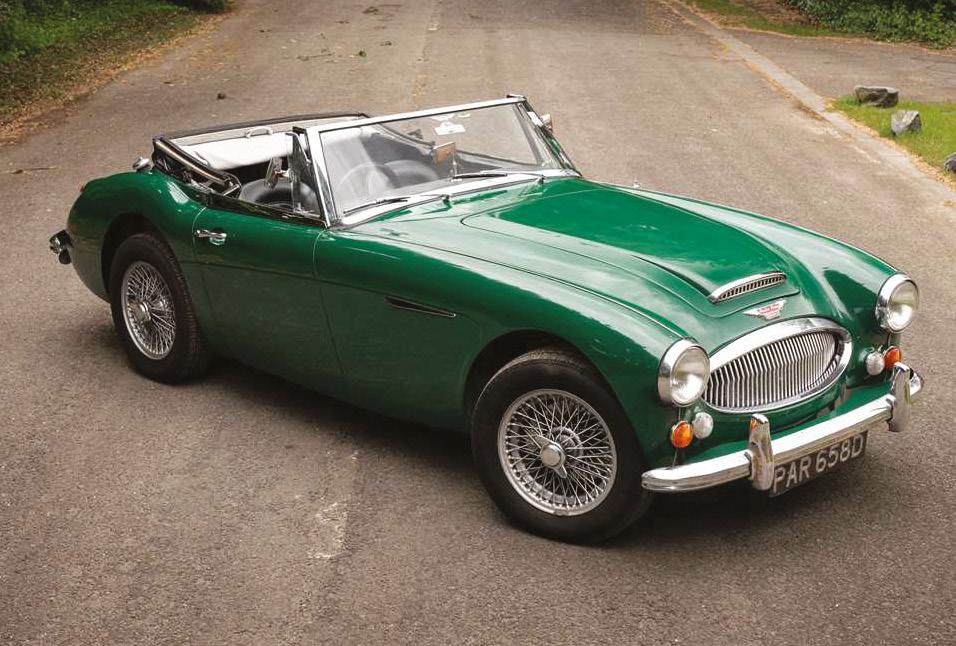
Registration Number ‘11 OYD’
Estimate: £10,000 - £14,000*
Reg No: N/A MOT: N/A
Chassis No: N/A
• Registration Number ‘11 OYD’, offered on a Retention Certificate
• Offered from the late William ‘Bill’ Lloyd’s Estate

6
1 *All hammer prices are subject to a Buyer’s Premium of 15% plus VAT
Registration Number ‘87 BL’
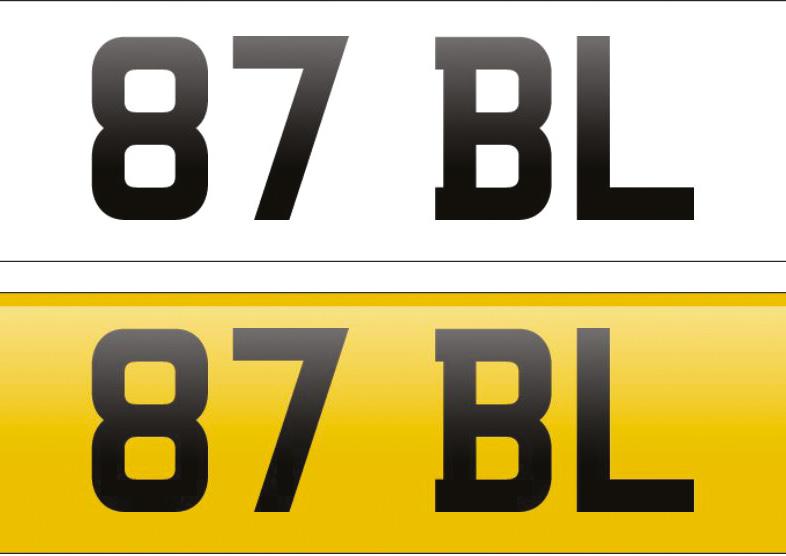
Estimate: £5,000 - £8,000*
Reg No: N/A MOT: N/A
Chassis No: N/A
• Registration Number ‘87 BL’, offered on a Retention Certificate
• Offered from the late William ‘Bill’ Lloyd’s Estate
7
2 *All hammer prices are subject to a Buyer’s Premium of 15% plus VAT
1988 Peugeot 205 CTi
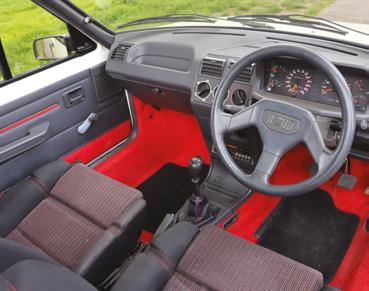

No Reserve
Reg No: F465 NLN MOT: May 2024
Chassis No: VF320DB6201512426
The little Gerrard Welter-penned 205 changed Peugeot’s fortunes, becoming an instant hit. The halo version was the GTi, while the similarly specified, Pininfarina-styled CTi Convertible is the cake-and-eat-it version, which combines sparkling performance ‘fresh air’ motoring.

Manufactured new in 1988, the 205 CTi offered was supplied new to the United Kingdom, being registered new on the 15th of June. Finished in Alpine White paintwork with complementary Black and Red interior upholstery, a Black hood, and a Black tonneau cover, the Peugeot is fitted with the 1580cc straight-four SOHC engine allied to the five-speed manual transmission. Pleasingly unmodified, ‘F465 NLN’ has covered a mere 45,700 miles from new (at the time of consignment) and, before entering into current family ownership in 2018 (equating to two keepers following the exchange of ownership from the late-vendor to his wife), the Peugeot had three former keepers, the previous being the Head of Sales at a Peugeot dealership. Only acquired by the vendor due to the previous keeper requiring funds due to a young family, ‘F465 NLN’ has resided in a small private collection and has been sparingly used in current family ownership, covering less than 1,000 miles.
Benefitting from some £3,000 worth of expenditure while in the current family ownership, work completed has included new injectors, rotor arm, TPI sensor, and temperature sensor, a replacement driveshaft, engine fettling, and a fresh battery. The 205 was MOT tested in May being issued with a no advisory ticket until May 2024. The accompanying original book pack in Peugeot wallet contains the owner’s handbook, other assorted guides, and a stamped service book that displays that the CTi was serviced by one garage between 1995 and 2008 (presumably with the second owner). The history file also contains a large number of previous MOT certificates, several invoices, a copy of a previous logbook, and a current V5C document. Offered temptingly without reserve ‘F465 NLN’ would make a perfect hot hatch and open-top summer motoring.
8 *All hammer prices are subject to a Buyer’s Premium of 12.5% plus VAT
3
1914 Ford Model T Roadster

Estimate: £13,000 - £15,000*
Reg
No: WC 1084 MOT: Exempt
Chassis No: 568601
Launched in 1908, the T’s chassis and mechanical components were made from exceptionally durable, high-grade vanadium steel. The Ford also featured a compact 2890cc, side-valve, four-cylinder engine that pioneered the use of a detachable cylinder head. Mounted in-unit with the clutch and two-speed epicyclic gearbox assembly, it developed some 23hp at a leisurely 1,600rpm and 80lbft of torque. Top speed was limited to around 45mph depending upon bodywork, whilst brakes operated on both the transmission and rear wheels. By 1914, Model Ts represented 56% of all automobiles manufactured in the USA.

A desirable ‘brass era’ example, chassis number 568601 rolled off the production line in August 1914, which interestingly was the first month of production for the 1914 models, before ending in January 1915 for the introduction of the 1915 model year. Fitted with the attractive Roadster body style, the Model T is understood to have been restored in the early 1970s to a very good standard, before being shown at events and used on hill and mountain tours during the 1970s and 1980s, including becoming a First Place award-winning vehicle at the VMCCA National Rally (Vintage Motor Car Club of America) in 1975.
Fitted with a Ruckstell rear axle (providing four speeds for Fords), a set of four Hassler (Robert H Hassler Inc.) shock absorbers, and other nice period features such as Ford embossed lamps, the Model T is finished in Red with Black wings and running boards, wooden wheels, Black interior upholstery and has a hood trimmed in Black. Imported into the United Kingdom in 2022 from Colorado, USA, chassis 568601 has since been road registered here as ‘WC 1084’. Accompanied by a dating letter from the America Automobiles Club of GB, a copy of the Colorado Certificate of Title, import correspondence, and a current V5C document. With Ford’s transition with the Model T from brass to painted radiator cars, the former (such as this example) are particularly prized by enthusiasts and collectors.

9 *All hammer prices are subject to a Buyer’s Premium of 12.5% plus VAT
4
1999 Jaguar XK8 Convertible
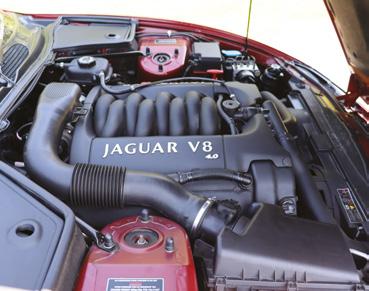
Estimate: £12,000 - £14,000*
Reg No: ENZ 4787 MOT: October 2023
Chassis No: SAJJGAFD3AH042137
Living up to expectations can be a burden. Consider the handsome Geoff Lawson-penned XK8 that followed in the wheel-tracks of such automotive icons as the XK120 and immortal E-type. Like the latter, it made its debut at the Geneva Salon - that of 1996 - and from launch was available in either Coupe or Convertible guise. Power came from a normally aspirated 4.0-litre version of the company’s DOHC V8 AJ26 engine.
Manufactured in 1999 and first registered in the UK in July that year, this XK8 is finished in Metallic Red with a Beige leather interior and Black hood, with just 5 keepers and 37,500 miles on the clock (at time of consignment)

‘ENZ 4787’ has clearly been very well looked after and presents to a high standard today. The service book contains twelve stamps, nine of which are from Jaguar main dealerships and the last service recorded was in April this year at 37,471 miles. We are informed that everything works as it should and the current MOT expires October 2023. “ENZ 4787” comes to sale complete with book pack, small history file containing old MOT certificates, some invoices and current V5c. All tools, spare wheel, roof cover, and spare key are also present. A very nice example of the ever popular Jaguar XK8 Convertible.

10 *All hammer prices are subject to a Buyer’s Premium of 12.5% plus VAT
5
1933 Austin 10 Saloon
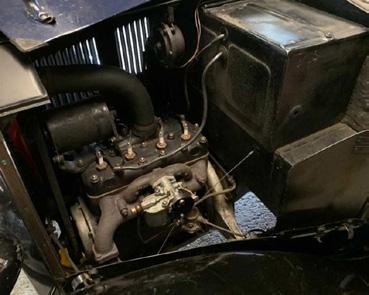
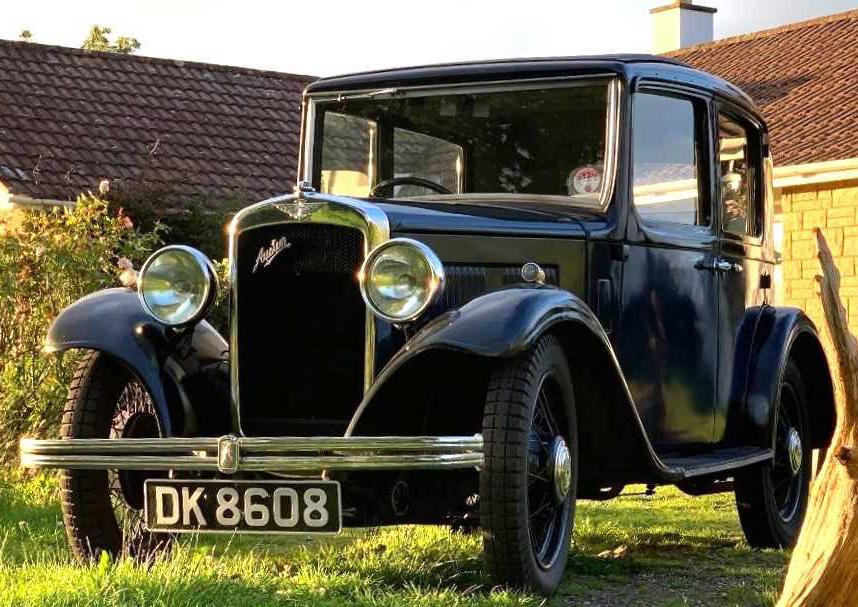
No Reserve
Reg No: DK 8608 MOT: Exempt
Chassis No: 15305
Bridging the gap between the Longbridge based manufacturer’s renowned 7hp and 12hp models, the Austin 10hp was launched in 1932. Topping the sales charts throughout the 1930s, the newcomer was based around a sturdy ladder frame chassis equipped with all-round semielliptic leaf-sprung suspension and cable-operated four-wheel drum brakes. Powered by an 1125cc side-valve four-cylinder engine allied to four-speed manual transmission, it was reputedly capable of 55mph and 35mpg. Available with a range of open and closed pressed-steel body styles (all of which located occupants between the axles) the model was subject to continual development. Visually distinguished by their chrome radiator surrounds, the first series cars remained in production from April 1932 and August 1934. Arguably better appointed than their successors and possessed of a more vintage feel, they have developed a loyal following.
Somewhat forlorn by the time it entered the current family ownership during the late 1960s, ‘DK 8608’ took the vendor’s father some sixteen years to restore. Still presentable some four decades later, the Austin is thought to pleasingly retain its original Dark Blue leather upholstery. Part of a significant private collection, the 10hp was a firm favourite being used by the vendor’s mother to pop to the shops most weekends until her passing. Recently treated to a new battery, the four-seater is said to ‘run sweetly’. Rated by the vendor as being in ‘very good overall’ condition with regards to its bodywork, paintwork, engine, gearbox, electrical equipment and interior trim, ‘DK 8608’ is only coming to market due to a loss of storage. The little Austin will be much missed!
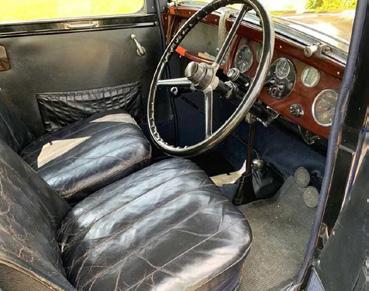
11 *All hammer prices are subject to a Buyer’s Premium of 12.5% plus VAT
6
1948 Alvis TA14
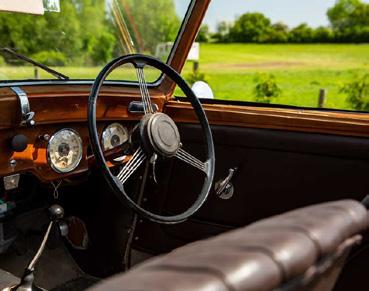
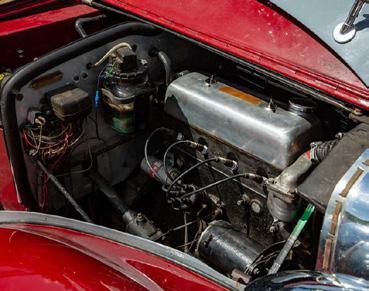
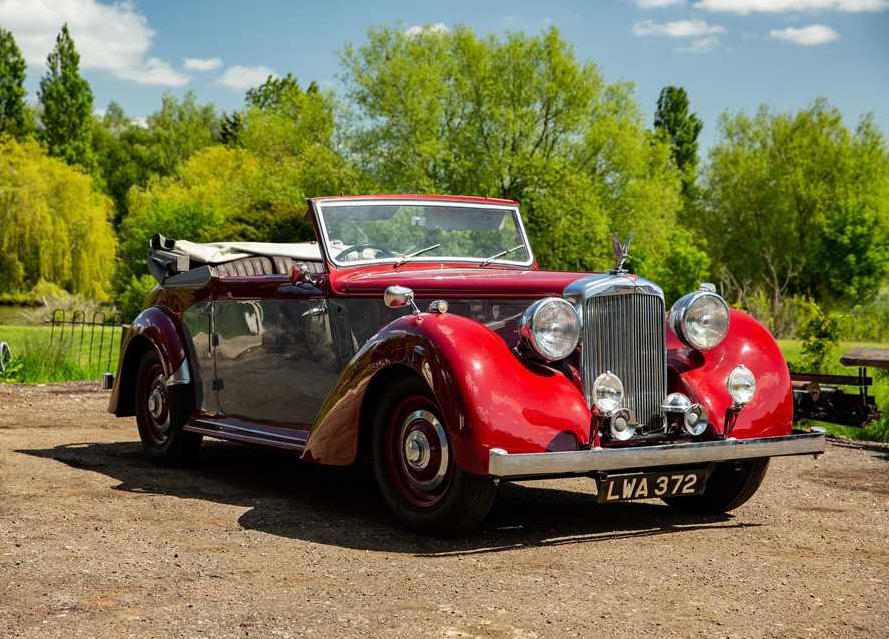
Drophead Coupe
Estimate: £14,000 - £16,000*
Reg No: LWA 372 MOT: Exempt
Chassis No: 22465
Finished in Red / Grey with a Grey interior LWA 372 carries coachwork by Carbodies and was the subject of a comprehensive restoration around 2004. A good quantity of invoices dating back to the 1980s, correspondence and photographs for works carried out are present in the accompanying history file. Purchased by the vendor from marque specialists Red Triangle in 2011, a sales invoice totalling some £27,000 and confirming recent mechanical works having been completed is also included. In 2009 the engine was thoroughly overhauled by Primrose Classic Cars of Accrington following piston seizure at a cost of almost £6,000. Whilst the car is said to have “good” bodywork, paintwork and engine, we are advised the front seats have been retrimmed but the rears have some wear and patina. An original instruction manual, Alvis TA14 50th Anniversary Collection of technical articles and a catalogue of spare parts (Issue No.3) are also included.
Entering production in 1946, the new Alvis TA14 was a successful update of the pre-WW2 12/70 (designed by George Lanchester). With a two-inch longer wheelbase and four-inch wider track as well as some additional chassis bracing, it offered an improved ride and sharper handling. Credited with 65bhp, its 1892cc OHV four-cylinder engine was mated to a four-speed manual gearbox (with synchromesh on the top three gears) which drove the rear wheels via a hypoid back axle. Reputedly capable of over 75mph and accelerating from 0-60mph in 22 seconds, the model employed Girling twin leading shoe drum brakes all round. While the majority were supplied as Mulliner-bodied four-door saloons, the TA14 could also be had with two-door drophead coupe coachwork by Carbodies or Tickford. Some 3,311 examples are said to have been produced during the four years of production.
12 *All hammer prices are subject to a Buyer’s Premium of 12.5% plus VAT
7
2005 Bentley Continental Flying Spur
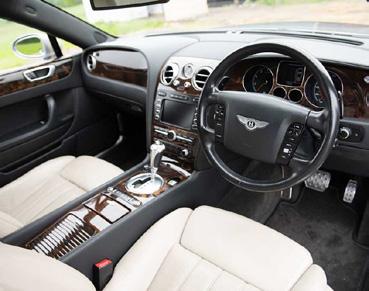

Estimate: £12,000 - £14,000*
Reg No: LA55 WKN MOT: March 2024
Chassis No: SCBBE53W86C033636
‘There is much to love about the Bentley Flying Spur: it creates a sense of occasion like few other cars at any price, and offers an endearing blend of performance, potential top speed and braking power. The interior sets it apart from the more mainstream rivals, and there can be no denying that it fulfils its remit as a big, lavish limo. It’s even fun to drive, in a brutish kind of way’ (Autocar magazine).
Introduced in 2005 to complement Bentley’s existing two-door Continental GT model, the four-door grand tourer Flying Spur used a stretched version of its sibling’s platform. Powered by the same twin-turbocharged 6.0 litre W12 engine allied to six-speed automatic transmission, the luxury sports saloon boasted 552bhp and 479lbft of torque; outputs sufficient for 0-60mph in 5.2 seconds and 194mph. Equipped with Adaptive Air Suspension, Continuous Damping Control and Tosen-based permanent four-wheel drive, the big Bentley proved surprisingly nimble.
Finished in Silver with Cream leather seats this 2005 example has covered some 67,000 miles and is offered with a current ‘no advisory’ MOT to 30 March 2024. The vendor informs us it features the four-seat configuration with split rear seat. Accompanied by a good history file with spare key it is described as having “excellent” bodywork, paintwork, engine, automatic transmission and interior and is said to have no known faults. A huge amount of car for the asking price today, these used Bentleys offer luxury and performance motoring at a level few other manufacturer’s can rival.
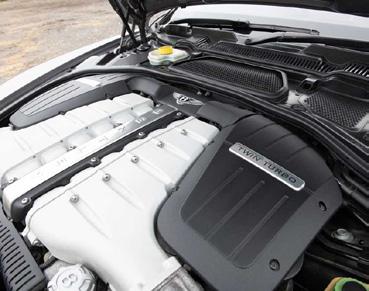
13 *All
prices are subject to a Buyer’s Premium of 12.5% plus VAT
hammer
8
1972 Triumph Stag

Recent restoration in Mimosa Yellow
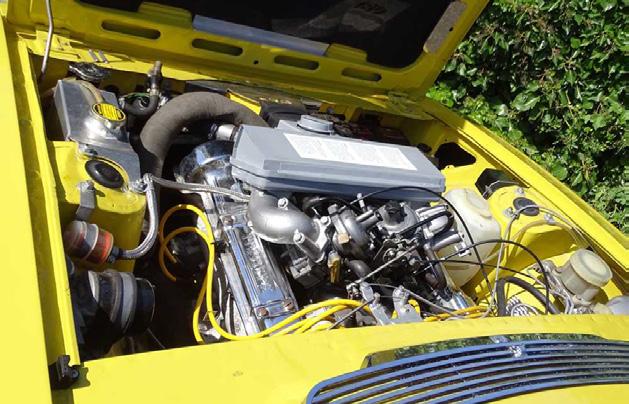
Estimate: £15,000 - £20,000*
Reg No: AUJ 743L MOT: June 2024 Chassis No: LD13095D
Introduced in June 1970, the Triumph Stag was conceived as a luxury convertible sportscar to rival the likes of the R107-series Mercedes-Benz SL. As such, it came equipped with electric windows, power-assisted rack and pinion steering, and servo-backed disc / drum brakes as standard. Based around a two-door monocoque bodyshell (stylist Giovanni Michelotti had physically shortened a pre-production Triumph 2000 saloon in order to fashion the initial prototype), the newcomer featured all-round independent suspension (McPherson strut front / semi-trailing arm rear) and a well laid-out 2+2 cabin. Neatly integrated, the substantial roll-over hoop that joined the B-pillars gained extra strength from a T-bar link to the windscreen frame. With some 145bhp and 167lbft of torque on tap from its bespoke 2997cc SOHC V8 engine, the model was reputedly capable of 120mph. Available with a choice of four-speed manual or three-speed automatic transmission, all but the earliest Stags benefited from both hard and soft-top roofs. Despite being in production for seven years, during which time 25,877 cars were made, a mere 9,500 or so are thought to have survived.
The Triumph Stag offered here was first registered on the 8th of September 1972, equipped with a manual transmission with overdrive. Not much is known of the early history of the car, but the History file contains a considerable stack of invoices going all the way back to 1978. Old MOTs dating back to 1983 seem to corroborate the current mileage of just over 93,000 miles. However, this can’t be warranted. In recent years the car was subjected to a full engine, body and chassis restoration while the engine was uprated with an upgraded coolant tank and radiator and an electric fan. Invoices for parts used are included in the history file. It is believed that the interior is still mostly original with some sympathetic restoration carried out where needed. Recently, a new battery was fitted and the engine received a tune-up along with balanced carburettors and a new choke cable by specialist Stagbay. In May of 2023 the car was fitted with new sill covers to protect the nicely intact inner sills. Rear cruise lights replace the original Stag emblems but the originals are kept with the car. All alterations were made with originality in mind and can be undone without any permanent damage. According to the vendor, the car starts, drives and handles well and the exhaust note was very pleasing during the photoshoot. Offered with a fresh MOT with no advisories, a large folder containing old and recent invoices, old MOTs and a current V5C, this bright Stag is ready for an even brighter summer.
14 *All hammer
of 12.5% plus VAT
prices are subject to a Buyer’s Premium
9
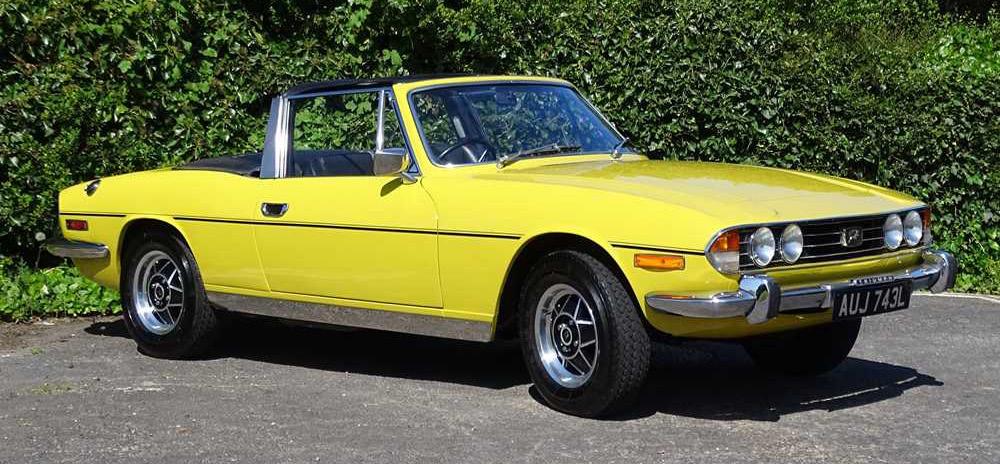

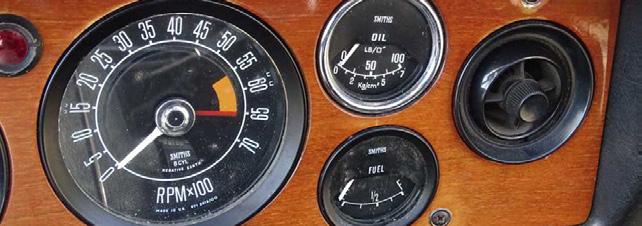
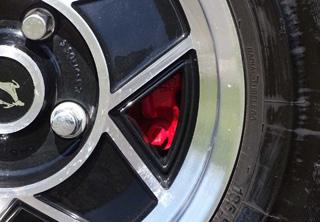
15
1998 Mercedes-Benz SL 500


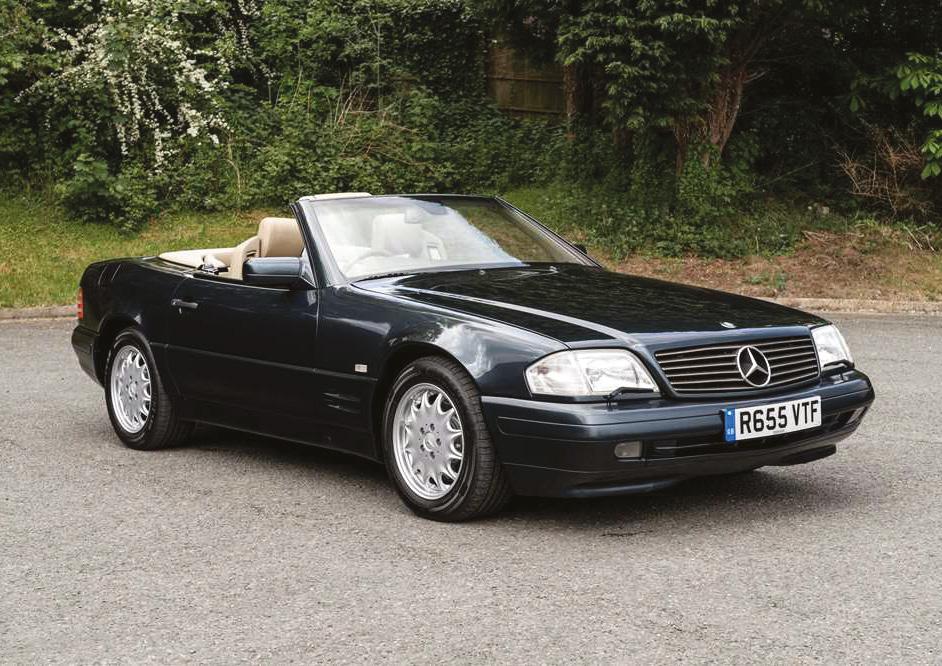
Estimate: £12,000 - £14,000*
Reg No: R655 VTF MOT: May 2024
Chassis No: WDB1290672F160990
Faster, harder-edged and more driver-orientated than its R107 predecessor, the Mercedes-Benz R129-series SL was launched at the 1989 Geneva Motor Show. Brim-full of cutting-edge technology, its impressively rigid two-door monocoque shell featured an integral rollover bar that deployed in less than a third of a second (if the car ever sensed an impending flip) and a fully automatic convertible roof. Known for its surefooted handling, the R129 utilised all-round independent suspension, ABS brakes and power-assisted steering. Propelled by a variety of sixand eight-cylinder engines all allied to automatic transmission, it was the sportscar of choice for many contemporary F1 drivers. The range’s initial flagship, the 500 SL model marked the debut of Mercedes’ fourvalve-per-cylinder, dual-overhead camshaft V8 powerplants with variable valve timing. Thus, its 4973cc V8 was credited with 326bhp and 332lbft of torque. Reputedly capable of over 150mph and 0-60mph in 6.3 seconds, it was nevertheless a paragon of refinement.
Delivered to Mercedes-Benz Greenoaks Ltd of Reading on 22nd October 1997 as a 1998 model-year car, chassis 160990 was retained by them until 4th November 1998 when its original registration number ‘R655 VTF’ was exchanged for ‘HK 11’. Finished in the unusual and striking combination of Green Black Metallic with Mushroom leather upholstery and a Black softtop, the SL500 also featured electric / memory front seats, occasional rear seats and headlamp washers / wipers. The original and continuation maintenance booklets record services at 10,471, 21,093, 31,625, 45,364, 58,316, 67,479, 73,007, 73,318, 74,165, 83,111, 89,362, 93,992, 95,240, 96,030 and 96,580 miles. Acquired by its last registered keeper in winter 2021, he had ‘R655 VTF’ treated to some £940 worth of paintwork, interior, soft-top and alloy wheel detailing. Now showing some 102,000 miles to its odometer, the Mercedes-Benz remains commensurately smart and is offered for sale with V5C Registration Document, book pack, fresh MOT certificate and numerous service invoices.
16 *All hammer prices are subject to a Buyer’s Premium of 12.5% plus VAT
10
1993 Jaguar XJ12 6 Litre
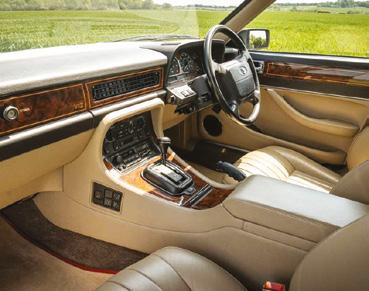


No Reserve
Reg No: L31 FRO MOT: March 2024
Chassis No: SAJJHALS3AR677939
Ford’s stewardship of Jaguar was characterised by a determination to improve the Coventry marque’s reputation for build quality. To this end it shelved existing plans for a V12-engined version of the XJ40 saloon and instead had the bodyshell re-engineered at a cost of £35 million to better accommodate the 6-litre SOHC unit. Debuting at the February 1993 Amsterdam Motor Show, the resultant XJ81 incorporated 140 new or modified panels and could be had in sporty Jaguar XJ12 or luxurious Daimler Double Six guises. Still uncannily smooth, the famous V12 was allied to an improved GM 4L80E four-speed automatic gearbox. With a quoted 313.5bhp/342lbft on tap, the four-door saloon could whisk occupants from 0-60mph in 6.8 seconds and onto 155mph. Equipped with all-round independent suspension, ABS four-wheel disc brakes and power assisted rack and pinion steering, the XJ81 had a ride / handling balance that some road testers found superior to the contemporary Mercedes-Benz S-Class and BMW 7-Series. A costly exercise, a mere 3,799 XJ81s were produced during its nineteen-month production life with just 1,243 of those being home market XJ12s.
Effectively a one owner car, ‘L31 FRO’ has only had a second keeper added to its DVLA record in order to facilitate a cherished number plate transfer. The accompanying original purchase agreement reveals that the XJ12 was supplied new via Dunham Jaguar of Luton on 4th August 1993 at a cost some £45,201.13, while the maintenance booklet records services at 6,228, 12,764, 16,517, 20,086, 24,284, 27,299, 31,388 and 33,053 miles. Converted to conventional steel springs and shock absorbers at the rear by Bob Empson & Sons of Cambridge during May 2012, the sports saloon was taken off the road some eight years later. Scarcely used since passing its most recent MOT test with ‘no advisories’ on 27th March 2023 at a warranted 33,434 miles, the Jaguar remains highly presentable except for some minor bubbling to the offside front wing. An appealing and rare proposition.
17 *All
prices are subject to a Buyer’s Premium of 12.5% plus VAT
hammer
11
2003 Volkswagen Beetle 1600 ‘Sedan Unificado’


14,000 miles from new
Estimate: £12,000 - £14,000*
Reg No: WX57 BVL MOT: March 2024
Chassis No: 3VWS1A1BX4M902599
The very first Volkswagen Beetles (Type 1) to be assembled in Mexico arrived as CKD kits (Complete Knock Down) during 1961. Demand for the ‘People’s Car’ was such that the Wolfsburg firm soon opened local factories at first Xalostoc and then Puebla with the 200,000th Mexican built Beetle rolling off the latter’s production line during 1971. The last mainstream version of the Type 1 Beetle, the Sedan Unificado arrived in mid-1998. Powered by a fuel-injected 1.6 litre engine allied to fourspeed all-synchromesh transmission, it also featured front disc brakes and cloth upholstery. A far more modern and usable proposition than its earlier siblings, the Sedan Unificado proved a popular ‘grey import’ with Beetle enthusiasts worldwide even after the very last Type 1 was completed on 30th July 2003.
A notably late example dating from the final months of production, chassis 902599 was still showing delivery mileage when imported to the UK by Beetles (UK) Ltd of Rangeworthy, South Gloucestershire some four years later. Originally finished in Luna Beige with Anthracite cloth upholstery, the Sedan Unificado passed an SVA test and was first UK registered as ‘WX57 BVL’ on 1st September 2007. Only ever registered to members of the same, London-based family since arriving on these shores, they paid £15,013 to acquire the Type 1 and a further £3,396.34 to have it professionally resprayed inside and out in Dark Grey by Bob Petersen Engineering of Devon during December 2007. Showing a warranted 22,000km (circa 13,800 miles) to its odometer, the Volkswagen remains highly presentable. Treated to minor servicing and a replacement alternator over the years, ‘WX57 BVL’ started readily and ran well during our recent photography session. ULEZ exempt, this decidedly low mileage Beetle is offered for sale with V5C Registration Document, copy bill of sale, current MOT certificate and assorted paperwork.
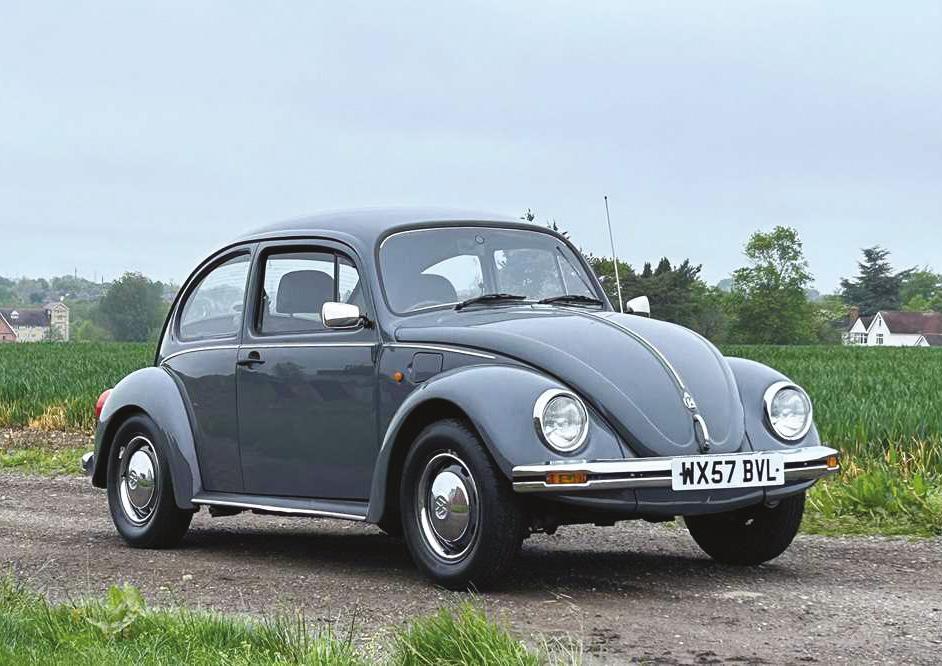
18 *All hammer prices are subject to a Buyer’s Premium of 12.5% plus VAT
12
1924 Standard V3 Kineton Tourer
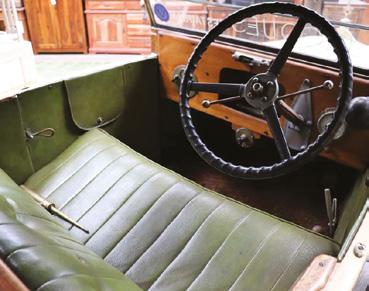


Offered on behalf of the Betel Charity
Estimate: £10,000 - £15,000*
Reg No: MF 9090 MOT: Exempt
Chassis No: V34851
A civil engineer by profession, Reginald Walter Maudslay was quick to recognise the rapidly increasing scope of the horseless carriage and founded the Standard Motor Company in Coventry during 1903. By the end of that year, three cars powered by over-square, single-cylinder engines had been produced and a labour force of twenty-five amassed. There are various explanations for the company name, from the cars being assembled from ‘standardised patterns and interchangeable parts’ to the founder proclaiming he ‘was determined to maintain the best possible standard’. Whatever, success came its way and in 1924 production reached 10,000 cars, comparable to that of the Austin Motor Company. Models were named after English towns - not just those local to the factory, such as Canley, Kenilworth and Warwick, but some much further afield, eg Teignmouth, Falmouth and Exmouth.
Manufactured in 1924, chassis number V34851 is believed to have been supplied new by Rossleigh Ltd. Motor Engineers of Newcastle-upon-Tyne costing some £235 when new. Understood to have been in the ownership of one individual from manufacture until the breakout of World War Two, it is reputed that the Standard was chauffeur-driven during this time and covered no more than forty miles in one journey. Remaining untouched post-war until 1956, the car was acquired into the possession of a Mr. J. H. Ling Esq of Wimbledon in 1964, and during the period to 1968, the Tourer was lavished with a full restoration. Subsequently a resident of the Newburn Hall Motor Museum for some three decades, ‘MF 9090’ is also known to be a previous record-holding car, having completed the Around Britain Challenge covering 2,046 miles in just 72 hours, the whole journey completed in wintertime with the roof down to reduce drag. Previously appearing in film and television productions, the V3 has also attended numerous events. More recently a static exhibit in a restaurant, and therefore requiring recommissioning, the vendor has recently donated the Standard to the Betel Charity for them to offer for sale to raise required funds.
19 *All hammer prices are subject to a Buyer’s Premium of 12.5% plus VAT
13
1964 Jaguar MkII 3.8 litre Saloon
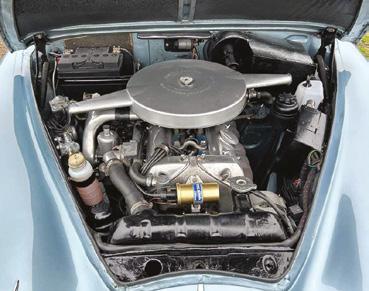
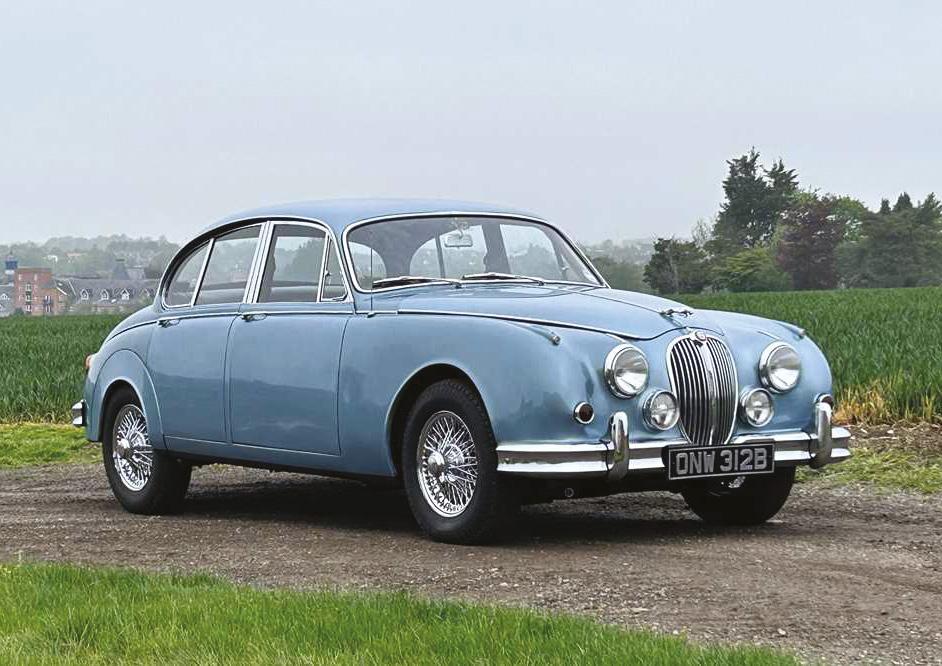
Uprated with PAS, air-con and Harvey Bailey kit etc
Estimate: £20,000 - £25,000*
Reg No: ONW 312B MOT: Exempt
Chassis No: 232636DN
For many the definitive Jaguar sports saloon, the MkII was introduced in October 1959. A peerless blend of elegance and muscularity, its sleek lines clothed an evolution of the Coventry marque’s first monocoque. Powered by derivatives of the same XK DOHC straight-six engine that had swept Jaguar to five Le Mans victories, the MkII was quick to dominate contemporary saloon car racing. Equipped with coil-and-wishbone independent front suspension, a leaf-sprung Salisbury rear axle and four-wheel disc brakes, the range-topping 3.8 boasted nearly seven times the horsepower of a Mini 850 and a 126mph top speed!
Reportedly supplied new to the car friendly climate of South Africa, chassis 232636DN was repatriated some thirty years later and treated to an extensive restoration by Chris Rawlinson of CR Classic Cars in Cudworth, Yorkshire which was not only photographically documented but also featured in the television programme ‘The Car’s The Star’. Passing its first UK MOT test on July 9th 1996 at an indicated 7,735 miles, the Jaguar was acquired by its last registered keeper during May 2007. Having treated the sports saloon to a stainless-steel exhaust and uprated Zeus brakes, he pressed it into everyday service for a year or so before deciding on a substantial upgrade programme including the fitment of air-conditioning, power assisted rack and pinion steering, electronic ignition, inertia reel seat belts and a Harvey Bailey handling kit etc. The work was carried out by marque specialist Marina Garage of Bournemouth and also encompassed thorough overhauls of the 3.8 litre XK DOHC engine and four-speed all-synchromesh gearbox. Costing some £24,000 in total, most of the improvements were completed during 2011. Sparingly used, a mere 400 or so miles have been added to the odometer over the past twelve years with the instrument now showing approximately 36,600 miles. Starting readily and running well during our recent photography session, ‘ONW 312B’ presents as an older restoration albeit one with some highly desirable ‘mod cons’. Offered for sale with V5C Registration Document, photographic restoration album and numerous bills.

20 *All hammer prices are subject to a Buyer’s Premium of 12.5% plus VAT
14
1931 Riley Nine Fabric Tourer

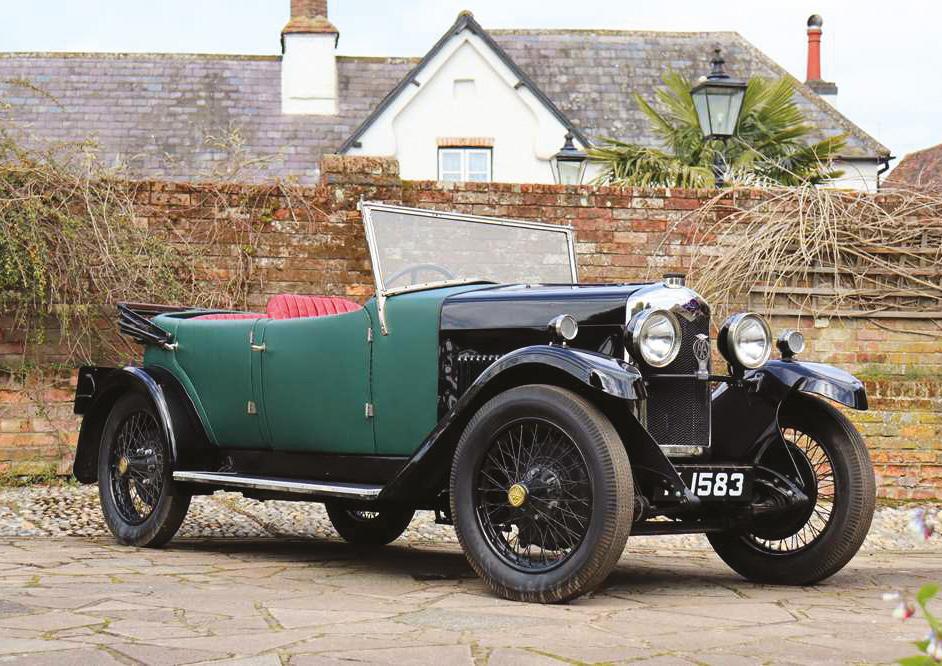
Estimate: £14,000 - £16,000*
Reg No: KJ 583 MOT: Exempt
Chassis No: 6012287
A thorough reworking of the Nine came with the MkIV, notably incorporating a new cable braking system with larger drums, and heavier in-house produced six-stud hubs and axles. For 1930, the MkIV Plus saw further development, with chassis improvements (lowered), a newly designed radiator shell, the fuel tank moved to the rear of the chassis, and the adoption of an Autovac. Chassis number 6012287 was supplied new via Barty Motors Ltd to a F. H. Ling Esq., being registered new on the 29th of April 1931, and is reputed to have been fitted with Fabric Tourer coachwork from new, with the likely coachbuilders being the Midlands Motor Body Co. A printed copy of the original buff logbook suggests that the Riley spent time in Yorkshire, Devon, Middlesex and Hertfordshire during the 1950s and 1960s, before it is understood to have been taken off the road during the 1960s.
Acquired by a friend of the vendor in 1975, said friend sold the Nine to the vendor some thirty years ago. Steadily restored over the years between the two gentlemen, the Riley has benefitted from a full ash frame and bodywork restoration with repainting and new fabric covering, full engine and gearbox overhauls, electric system restoration, interior renewal with new Red leather upholstery and new tyres, with some of the works recently completed by Riley specialists Brooklands Autocraft cover over £1,600. Invoices on file document over £8,700 worth of expenditure with the full restoration cost estimated to be in the region of £30,000. Sadly, offered now due to ill health, but very close to completion, the Riley requires final fettling, weather equipment and door cards manufacturing, with the fabric required for the door cards accompanying, as well as a hood pattern. Offered with a history file that contains a large collection of invoices and information documents on Riley Nines, ‘KJ 583’ is a tempting project that is very close to being back on the road.
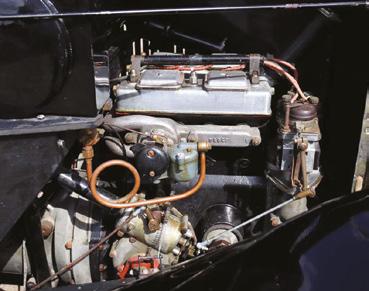
21 *All
prices are subject to a Buyer’s Premium of 12.5% plus VAT
hammer
15
1962 Heinkel Trojan 200

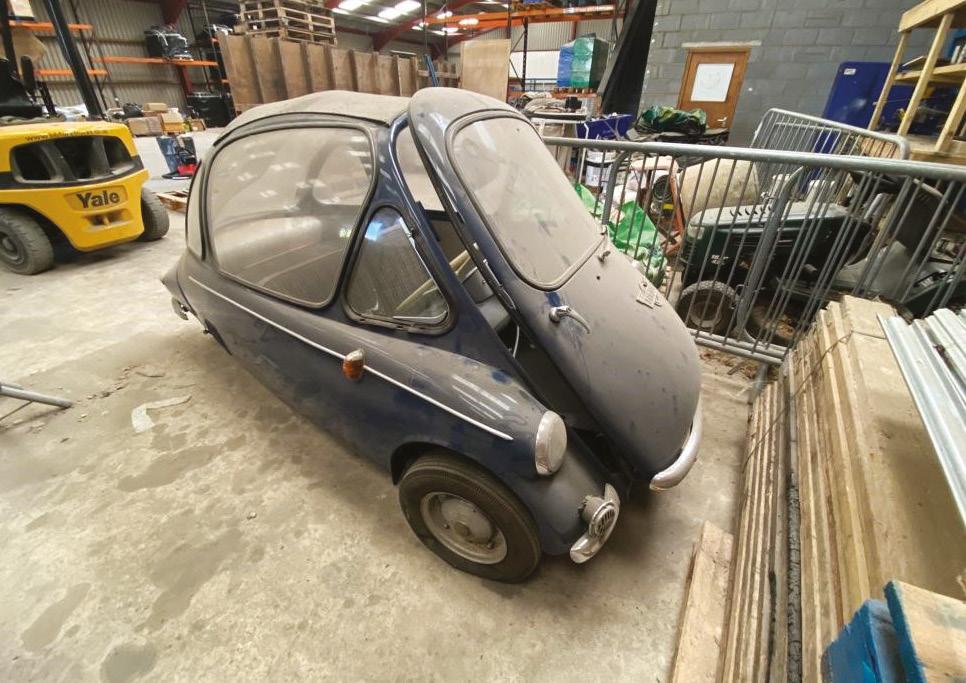
Estimate: £12,000 - £14,000*
Reg No: FSU 994 MOT: Exempt
Chassis No: SAB8546
Finished in Blue, we are advised this Heinkel is in a running and driving condition, being described as having “good” bodywork, paintwork, engine, transmission and interior. Purchased by the vendor in 2019, it has been little used whilst in his ownership and is offered with a Swansea V5C document, 40th Anniversary Heinkel Trojan Club Members’ Handbook (1979-2019), other sundry paperwork and a rare original Trojan 200 Owner’s Manual.
The Type 153 was Heinkel’s three-wheeled competitor to the BMW Isetta, Messerschmidt KR200 and other bubblecars of the austere late ‘50s/ early ‘60s. Powered by a rear-mounted single-cylinder, four-stroke engine of 204cc (later reduced to 198cc), it featured a front opening door plus a fabric sunroof that served both as a fair-weather accessory and escape hatch in the event of the door becoming jammed. European production was carried out in Germany from 1956 to 1958, and then under license in Dundalk, Ireland from 1958 to 1960, and by Trojan Cars on the UK mainland from 1960 until the cessation of the model in 1966. The latter examples were marketed as Trojan 200s and were the last vehicles to bear the Trojan name.

22 *All hammer prices are subject to a Buyer’s Premium of 12.5% plus VAT
16
1978 Mini Pick-Up 1000
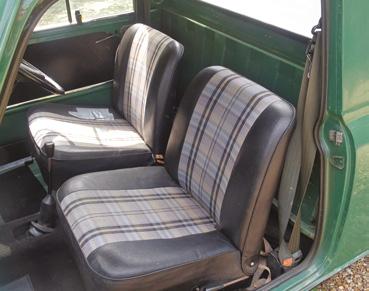
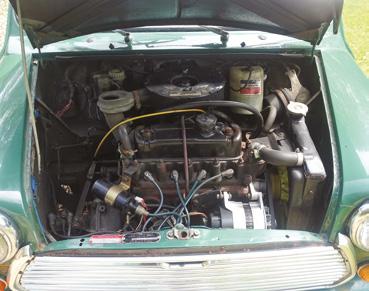
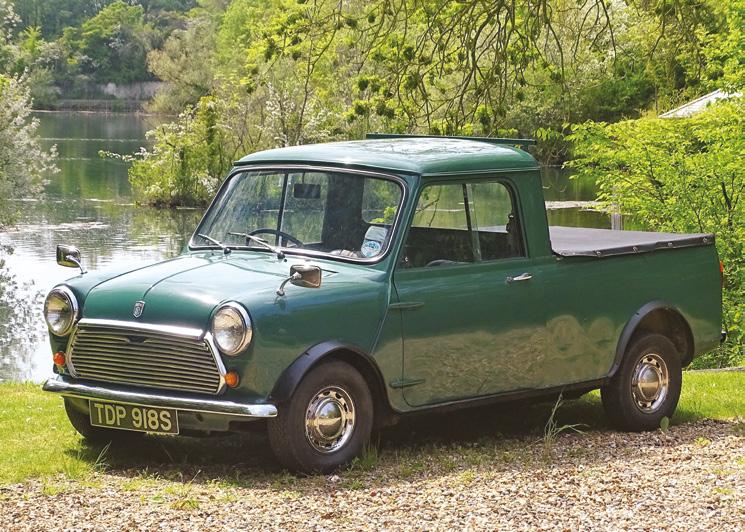
Warranted 45,500 miles from new
Estimate: £14,000 - £18,000*
Reg No: TDP 918S MOT: Exempt
Chassis No: XLU1-478562A
Introduced in January 1961, the Mini Pick-Up was based around the same stretched platform as its Panel Van sibling. Similarly exempt from sales tax as a commercial vehicle, it sported a pressed steel grille, sliding windows and external door hinges throughout its twenty-two year production life. Initially powered by an 848cc four-cylinder, it could be specified with the more powerful 998cc engine from 1967 onwards (both A-series units being mated to the same four-speed manual transmission). Benefiting from a four-inch longer wheelbase, taller rear suspension turrets and underfloor fuel tanks, the Pick-Up / Panel Van derivatives were arguably even more fun to drive than their saloon equivalents. ‘Mini’ became a standalone brand during October 1969 with parent company British Leyland dropping the compact saloon and its derivatives from the Austin and Morris ranges. A change signified by simplified badging and a new logo. The otherwise unchanged Pick-Up could still be had in 850 or 1000 guises.
Supplied new to British Leyland dealer R.J.E Platt Ltd of Marlow, it was they who gave the Pick-Up its saloon grille and wheel arch extensions (the former alteration allowing far easier access to the distributor and oil filter). The accompanying original ‘Passport to Service’ booklet indicates regular use as a runaround until the mid-1990s. Acquired by its first private keeper, the vendor, during 2003, the past twenty years have seen him add a modest 6,000 miles to the odometer which now displays a warranted 45,500 miles. Repainted from Blue to Green and uprated with electronic ignition during the current ownership, ‘TDP 918S’ started readily and ran well during our recent photography session. Due to be driven to the sale, the Pick-Up is seemingly usable ‘as is’ or could be renovated to show standard. Offered for sale with V5C Registration Document and sundry paperwork. Rarely do such low-owner, low-mileage Mini commercials come to market.
23 *All hammer prices are subject to a Buyer’s Premium of 12.5% plus VAT
17
1935 Singer Nine Le Mans ‘Longtail’
Estimate: £16,000 - £20,000*
Reg No: AWM 293 MOT: Exempt
Chassis No: 63232
Discovered in the early 1980s, Car No. 63232, had been in ‘barn find’ condition and required a total restoration. Then tied to a trailer with many boxes resting with the larger components, the c.95% complete car was eventually sent to Singer restorer, Trevor Cornelius, in 2002. Sometime in 2003 the car was extensively restored and back on the road once more.
Today, finished in a striking Bright Red paintwork, complemented by matching Red wire wheels, with grille badges, a pair of vintage-style air horns and an ‘A’ pillar-mounted spotlight add to the charm. The standard specification windscreen has been joined by a set of ‘aeroscreens’ for a period sports car look. Full weather equipment, side screens and top are also present. A copy of MASCOT, the Association of Singer Car Owners, shows the car on the owner’s club stand at the NEC Classic Motor Show in 2014.
2019, saw the ‘Long-Tail’ Singer benefitting from an overhaul of the engine, along with some upgrades, such as a counter-balanced crankshaft. Dave Hardwick Singer specialist of Lincoln provided a Special Speed Head at a cost of £1,600 and a Special Speed Camshaft at a cost of £300, plus 8 valve springs and 4x exchange reprofiled rockers.

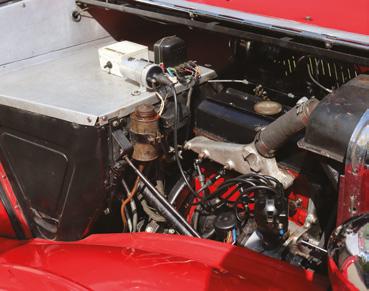
ELB Engineering of Old Sudbury carried out much of the work to overhaul the Singer’s engine in early 2019 at a cost of just over £2000.00. The short engine was stripped and cleaned and importantly checked the level of wear and tear. The block was then re-bored by 0.040”. The process involved the regrinding of the crankshaft, white-metal of the conrods and main bearings, a line bore of the block, phosphor bronze and manufacture of 4x end bushes, removal and refit of those, clearances and crankshaft end float set, assembly, lubrication, tightening up to manufacturers settings and oil pipework fitted. Subject to a previous gearbox overhaul by Singer specialist John Parker the Singer is offered with a collection of invoices and current V5C document.

24 *All hammer prices are subject to a Buyer’s Premium of 12.5% plus VAT
18
1980 Triumph TR7 Convertible


Warranted 21,000 miles from new
Estimate: £12,000 - £14,000*
Reg No: SYB 919W MOT: June 2024

Chassis No: TPADJ7AT213036
Code-named Bullet by Triumph, the TR7 was launched Stateside during September 1974. The work of in-house stylist Harris Mann, its distinctive wedge-shaped profile was conceived at a time when proposed US legislation not only threatened to outlaw convertibles but also insisted that all cars should be able to survive a 5mph impact unscathed. Last of the noble TR line, the TR7 was the first to employ a monocoque chassis and featured all-round coil-sprung suspension, rack and pinion steering and disc / drum brakes, offering a level of comfort and roadholding not yet seen in a Triumph sports car, and performance from its 2-litre engine was more than a match for the contemporary MGB, contemporary road tests claiming 0-60mph in 9.1 seconds and 110mph. Introduced in 1979, the TR7 Convertible was almost universally hailed as better looking than its coupe sibling. Surprisingly refined, it arrived too late to resuscitate the model’s fortunes and was discontinued two years later - though typical British Leyland stockpiling meant that sales continued into 1982.
Despatched from the Leyland factory in June 1980, this Canley-built example is finished in striking Pendelican White. Registered in August of the same year by the supplying dealer (Lex Mead of Exeter), this time warp example retains the original dealership decals to both the windscreen and rear screen. The white paintwork is complemented by contrasting ‘Blue Check’ upholstery which shows very little wear, commensurate with the modest mileage. The car was correctly supplied with a rare radio blanking-plate, in lieu of the radio unit, that was still a pricey optional extra in 1980. The roadster is offered with its full selection of weather gear, including hood, part tonneau and rare full tonneau which features the extra stud fittings on the door-tops and dashboard. Described by our vendor as “a very original car, in lovely condition”, ‘SYB 919W’ behaved faultlessly on our recent photography shoot. Offered with a small history file, containing a current UK V5c registration document, (just six former keepers shown), owners handbook and pouch, sales brochure and a selection of expired MOT certificates / receipts that support the low mileage.
Please note - the car currently rides on a later set of alloy wheels, however the originals are also included (correctly date-stamped etc).
25 *All hammer prices are subject to a Buyer’s Premium of 12.5% plus VAT
19
1941 Buick Super Convertible-Coupe
In current ownership the last 42 years
Estimate: £28,000 - £32,000*
Reg No: DAP 666 MOT: Exempt Chassis No: 13969260
The Buick Super Convertible-Coupe holds a significant place in Buick’s history as a remarkable example of automotive design and engineering. Produced between 1940 and 1942, and then from 1946 to 1948, the Super Convertible-Coupe was part of Buick’s larger Super Series, which encompassed a range of body styles. This elegant and stylish two-door convertible-coupe showcased Buick’s commitment to producing premium vehicles with exceptional performance and luxurious features.
Under the hood, the Buick Super Convertible-Coupe featured a powerful straight-8 engine. In its early years, the vehicle was equipped with a 248-cubic-inch Fireball straight-8 engine, which was later upgraded to a larger 320-cubic-inch displacement engine. The straight-8 engine provided ample power, smooth acceleration, and a refined driving experience. Paired with a manual or automatic transmission, the Super Convertible-Coupe offered a dynamic and enjoyable driving performance.
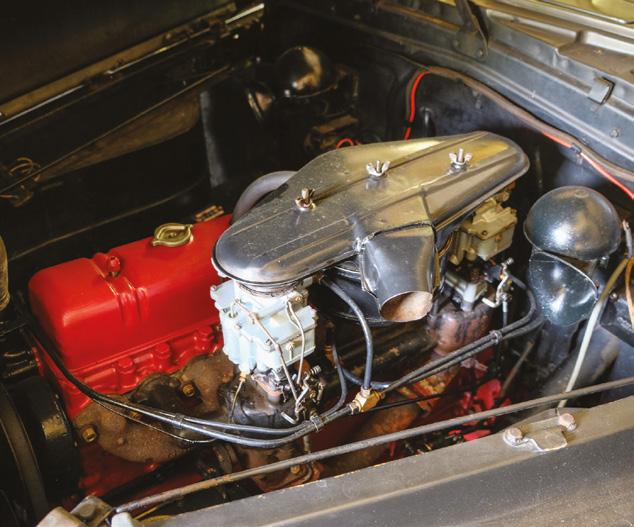
The design of the Super Convertible-Coupe embodied the sleek and aerodynamic styling cues popular during that era. The car boasted a low, wide stance, accentuated by sweeping fenders, a rounded grille, and elegant chrome accents. Its convertible top added a touch of versatility, allowing drivers to enjoy the open-air driving experience when desired. The interior of the Super Convertible-Coupe featured luxurious appointments, including comfortable seating upholstered in high-quality materials, a well-designed dashboard with clear instrumentation, and ample legroom and headroom for both the driver and passengers.
Buick prioritized safety features in the Super Convertible-Coupe, incorporating advancements that were ahead of their time. The car featured hydraulic brakes, providing improved stopping power and control. In addition, the Super Convertible-Coupe was equipped with Buick’s Dynaflash inline eight-cylinder engine, which employed advanced engineering techniques to enhance fuel efficiency and reduce vibration. These safety and performance features contributed to the Super Convertible-Coupe’s reputation as a reliable and comfortable vehicle.
This particular example is presented in the attractive shade of Silver with contrasting Red interior. First manufactured in 1941, ‘DAP 666’ was reportedly imported to the UK in 1946 by an American Lieutenant Colonel during the war.
When he returned to the US, he left the car in the UK. Little is known of the vehicle until it was purchased by the vendor in 1981 as a project requiring total restoration from a gentleman in Bristol. The car was then subject to a 9 year restoration, completing in 1989.
Since completion, ‘DAP 666’ has been thoroughly enjoyed by the vendor; attending numerous local shows and travelling as fat as London, Woodstock, Oxford and more for further shows.
In recent years, the car has been subject to a complete engine overhaul in 2020, along with regular maintenance when required. Now in current ownership for the last 42 years, the car is offered for sale reluctantly due to ill health along with a number of other vehicles from the vendor’s private collection of American cars. Included with the vehicle is the V5C
26 *All hammer prices are subject to a Buyer’s Premium of 12.5% plus VAT
20

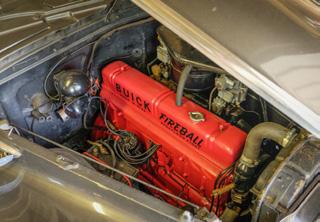
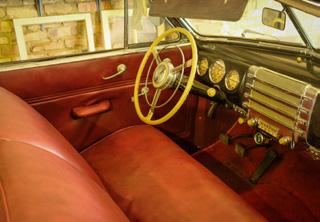
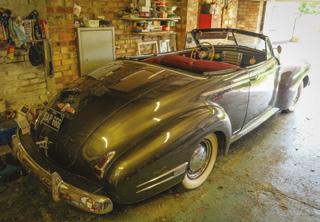

27
1966 Austin-Healey 3000 MKIII
Home market car with just two owners from new
Estimate: £45,000 - £50,000*
Reg No: PAR 658D MOT: November 2023 Chassis No: HBJ835572
A significant step in terms of ‘Big Healey’ evolution and foundation block for one of the 1960s’ most charismatic rally cars, the 3000 MkI was introduced in March 1959. Powered by an enlarged 2912cc version of BMC’s C-Series straight-six engine that developed some 124bhp and 167lbft of torque, it could be had in two-seater (BN7) or 2+2 seater (BT7) configurations. Progressively improved, the 3000 metamorphosed through MkII and MkIIa guises before the arrival of the ultimate MkIII BJ8 in October 1963. Boasting a centre console, proper convertible hood, wood veneer dashboard, redesigned exhaust system and wind-up windows, the 2+2 seater BJ8 proved a comfortable and fast grand tourer. With engine output boosted to 148bhp and 165lbft of torque thanks to a new camshaft and better valve springs etc, its reputed 124mph top speed was accessed via a four-speed manual gearbox. Last of the line, the Phase Two variant benefited from redesigned rear suspension, strengthened splined hubs and larger diameter front disc brakes.
Consigned to us from the collection of Maggi and Roger Byford, ‘PAR 658D’ shared a garage with their all-conquering works specification rally car ‘32 EXT’ for more than four decades. Highly-original and wonderfully-patinated, this late-production BJ8 model was supplied new to its first and only other custodian in April of 1966 - Ms. Judith Davies of Leavesden, later passing into the hands of the Byfords by 1978. Very well-known in Healey circles, ‘PAR 658D’ is a veteran of many European tours and features some useful and subtle modifications, including works-style overdrive switch to the gear knob, electronic ignition and 12v charging ports for sat-nav devices / mobile telephones. Following a short period of inactivity, the car was recently passed into the hands of Robsport (Shepreth) for a full inspection and recommissioning. All fluid levels were checked and nipples were greased, whilst the spark plugs and a rear wheel cylinder were also replaced at the same time.
Described by Robsport proprietor Simon Hebditch as “a car that runs and drives great, with overdrive (though a non-overdrive back axle has been utilised which is much better for touring).” He also states “All mechanicals are great - the car really is a pleasure to drive with no noises that shouldn’t be there”. Simon was particularly complimentary of the cars structure and interior, stating “the underside is excellent and not rusty” and “the trim has a nice patina and the dashboard is great, with the vinyl hood and tonneau also fitting well”.
Supplied with a small history file, including a current UK V5c registration document and a fresh MOT certificate; this offers a rare opportunity to purchase a delightful example of arguably the best and most desirable of the venerable ‘Big’ Healey models, from long term ownership and at a very sensible guide.
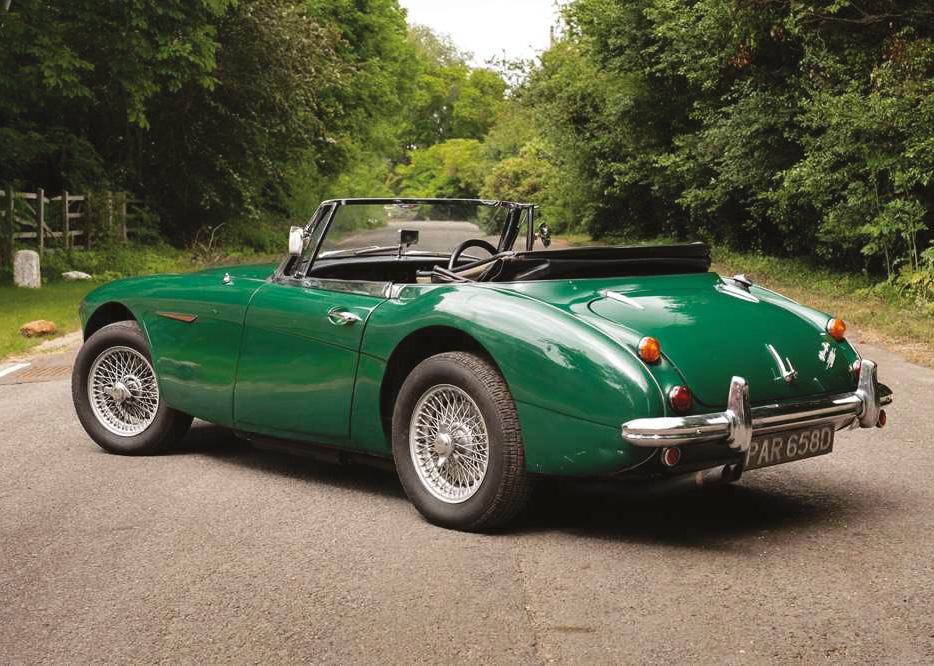
28 *All hammer prices are subject to a Buyer’s Premium of 12.5% plus VAT
21
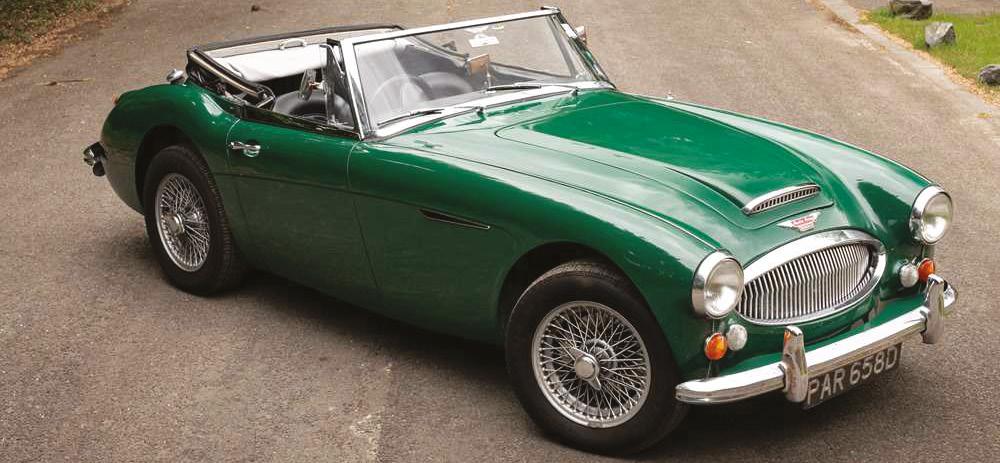



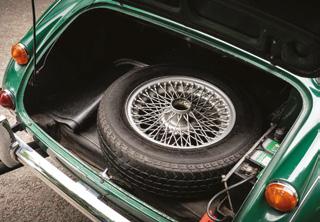
29
1982 Bentley Corniche Convertible
1 of just 77 examples manufactured
Estimate: £70,000 - £80,000*
Reg No: NXI 104 MOT: Exempt Chassis No: SCBYD0008BCH02873
The Corniche moniker was first employed in 1971 on the Coupe and Convertible versions of the Silver Shadow/Bentley T Series. In common with them, the newcomer was penned by in-house designer John Polwhele Blatchley, and the underbody and floorpan crafted by Pressed Steel Fisher. The initial assembly was carried out by Mulliner Park Ward of Willesden, London - by then a wholly-owned division of Rolls-Royce. Power was provided by the company’s venerable 6.75-litre V8 engine that was mated to Propulsion comes from the standard Rolls-Royce 6.75-litre V8 engine, which delivers its 237bhp through a GM Turbo Hydramatic 400 three-speed automatic transmission. The suspension was independent by coil springs all-round, augmented by a Citroen-originated hydraulic selflevelling system, and braking was provided by discs, with ventilated units being phased in from 1972.

In 1977 a slight styling update followed the introduction of the Silver Shadow II and Bentley T2. The chief visual clue being the change from chrome-plated steel bumpers to alloy and rubber. Although all but identical to the Rolls-Royce save for the front grille and badges, the Bentley Corniche was produced in far fewer numbers. Whereas 1,090 saloons and 3,239 convertibles left the factory bearing the Spirit of Ecstasy, only 63 and 77 respectively bore the Flying B.
A home-market, right-hand drive example, chassis number 02873 was supplied new by Jack Barclay Ltd., being delivered new on the 12th of February 1982. Finished in its original colour scheme of Georgian Silver paintwork complemented by Dark Blue leather interior upholstery, wood veneers and Dark Blue carpeting completes the interior appearance, along with a Blue hood. Riding on the original 15-inch steel wheels, with chromed Bentley “dog dish” hubcaps and embellishers are shod with thin-band white wall tyres. Supplied new to an individual residing at Baskerville Road, Earlsfield, (with properties overlooking Wandsworth Park) SW18, the Corniche is known to have spent its time with the first owner between the London area and Lausanne on the shores of Lake Geneva in Switzerland. Acquired by the vendor (the third keeper) in June 1999 from esteemed Rolls-Royce and Bentley Heritage Dealers P&A Wood of Great Dunmow in Essex, there is an accompanying purchase receipt for his acquisition.
Cherished while in the vendor’s possession, covering a mere 10,000 miles during his custodianship (to total less than 37,000 miles from new at the time of cataloguing), the Bentley has been lavished with mechanical improvement in 2017 to the cost of some
£3,300 including braking system refresh, attention to the electronics, an overhauled actuator motor and engine fettling. More recently, benefitting from c.£9,500 worth of enhancement comprising a new mohair hood and headlining, refreshment to the leather interior, and a large mechanical refinement was completed with well-renowned Rolls-Royce and Bentley specialists, Harvey Wash Ltd., with notable works including replacement gas springs, exhaust system enhancement, and other suspension attention, and carburettor overhauling.
Offered with a history file that contains the original book pack comprising the wallet, owner’s handbook, assorted booklets, and the stamped service book. The service book illustrates many services being completed by main agents and respected specialists, including Jack Barclay, (main agents) Garage Lausanne, and P&A Wood, with the most recent service completed roughly 2,000 miles previous. Further included in the documents file are numerous previous MOTs, several invoices for maintenance and parts (many from P&A Wood), a formalised “workshop report” log of work done in the current ownership, the bill of sale from P&A Wood, and a current V5C document and previous logbook copies.
These beautiful convertibles with Mulliner Park Ward coachwork have a timeless elegance and this exceptionally rare Bentley example looks superb in its original colour combination. Anyone who saw one of these with the top down when they were first introduced would have found it difficult to conceive that an amalgam of steel, glass, walnut, and leather could have been formed into something so utterly desirable. An eyecatching example with very low mileage and ownership, this is an unmissable opportunity to purchase one of the most opulent convertibles of the 1980s.
30 *All hammer prices are subject to a Buyer’s Premium of 12.5% plus VAT
22
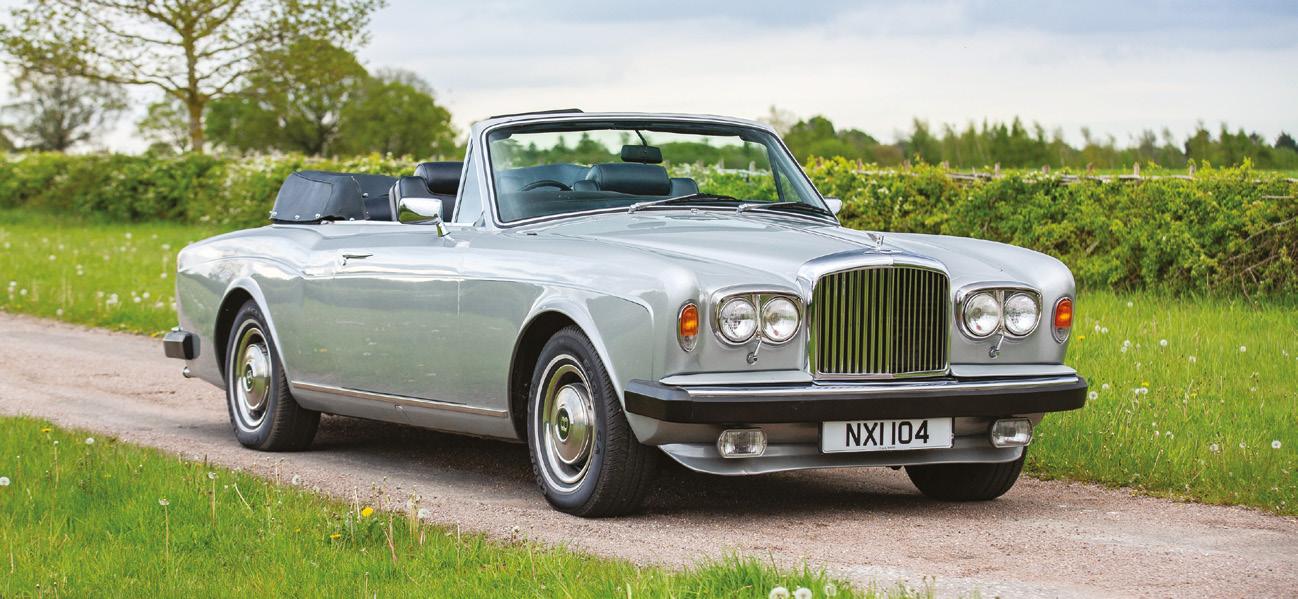


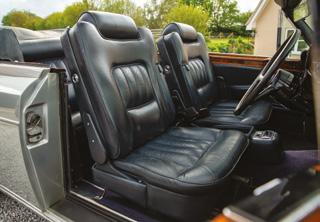

31
1950 Austin A90 Atlantic Convertible

Estimate: £30,000 - £35,000*
Reg No: LSM 233 MOT: T.B.A Chassis No: BD277484
This desirable home-market example was registered new on the 18th of November 1950 by Dumfries County Council, being supplied new to a W. J. Dunlop Ltd of Dumfries. Shortly after the A90 passed into its first private ownership in the Bridge of Allan region before the second private owner acquired the car in 1963. ‘LSM 233’ was retained by him for almost sixty years, during which, in the 1980s, the Atlantic was laid up. Acquired as a project by the vendor in early 2022, the Austin boasts matching numbers and was found to be ripe for restoration. Stripped to bare metal, the bodywork was found to be remarkably solid, only requiring some small areas of welding, with the aluminium bonnet and boot being in excellent condition. The engine was removed and the engine bay was stripped and painted, with bodywork receiving a full respray, matching the original factory Mint Turquoise colour from the inside of an original panel.
The engine was completely overhauled with the head skimmed and the chain tensioners renewed and the carburettor renovated, with all new hoses and service parts. Fitment of a new clutch followed with the braking system completely refreshed with new pads, brake pipes, wheel cylinders and other parts as required. The suspension bushes were replaced as required, and the fuel system was refreshed with the fuel tank removed and cleaned and a new fuel pump fitted before attending to the wiring loom to finish the mechanical renovation. Cosmetically, the Atlantic then received re-chromed front and rear bumpers, window frames and carpet trims, with the remainder of the chrome or stainless trim mouldings and “Flying A’s” kept in original condition. New hub caps and embellishers were provided with the wheels painted in the correct body colour, with the front lamps re-silvered to retain all the original glass “cats eye” lenses.
‘LSM 233’ was then provided with a fully retrimmed interior in Cream vinyl with Blue piping accents and a fully bespoke carpet set in Tan with Blue piping fitted too. The original radio is fitted (although not operational), and pleasingly the dashboard presents with the original Bakelite dash knobs and switches. The original steering wheel has had a bespoke leather cover fitted and the trafficators are in working order (with extra indicators added for safety). A new mohair hood trimmed in Black was fitted on the refurbished and powder-coated hood frame, and the hydraulic hood pump was overhauled with new seals. New period correct cross-ply tyres were fitted all-round and the restoration reached completion in early 2023, with the Austin due to be provided with a fresh MOT certificate in time for sale.
Featured at the NEC Practical Classic Restoration Show and winner of Best in Show at the prestigious Thoresby Hall Classic Car Show since the end of the restoration, the Austin Counties Club are only aware of 11 road-going convertibles left. Supplied with the original buff logbook and a current V5C document. A very rare sight and extremely stylish, ‘LSM 233’ is a scarce opportunity to acquire a freshly restored and show-winning example, that boasts matching numbers and was supplied new to the home market, with just three private owners from new.
32 *All hammer prices are subject to a Buyer’s Premium of 12.5% plus VAT
23



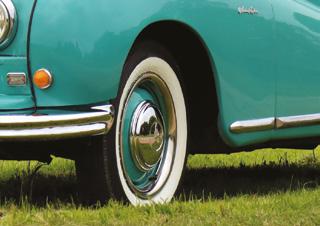
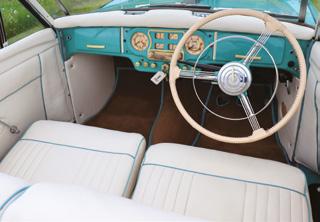
33
1990 Mitsubishi Shogun
Estimate: £12,000 - £15,000*
Reg No: G65 NYB MOT: October 2023

Chassis No: JMAL049GWKJ450642
The first-generation Mitsubishi Shogun, introduced in 1982, was a robust SUV built on a ladder-frame chassis. It offered a range of engine options, including a 2.6-litre inline-four gasoline engine with electronic fuel injection, producing around 105 horsepower (78 kW) and 143 lb-ft (194 Nm) of torque. The Shogun featured a part-time four-wheel drive system with a transfer case for engaging/disengaging the front wheels and a locking centre differential for improved traction. Its suspension included a solid front axle with coil springs and a four-link coil spring setup at the rear for enhanced off-road capability. Transmission options included a five-speed manual and an automatic gearbox, while the braking system comprised front disc brakes and rear drum brakes. The first-generation Shogun established Mitsubishi’s presence in the SUV market with its rugged construction, advanced engine technology, and capable off-road performance.
Presented in the popular Blue over Silver paintwork with recently refurbished White wheels and complementing cloth interior, ‘G65 NYB’ is a very late example offered with just 52,740 miles on the odometer and 1 former keeper. Offered for sale from a large private collection, simply to make space for more valuable vehicles and due to lack of use, this presents a great opportunity for a Shogun collector or enthusiast.
Included with the vehicle is the original book pack. Included within is Philips Cassette Stereo manual, Moss Security manuals, Owner’s handbook and Service Record which contains 8 stamps. An early V5C is included, a collection of MOT certificates dating back to 1993, a collection of invoices dating back to 2005 and a number of tax discs. The current V5C is included which displays 1 former keeper and the vehicle has an MOT valid until 7th October, 2023, with no advisories.
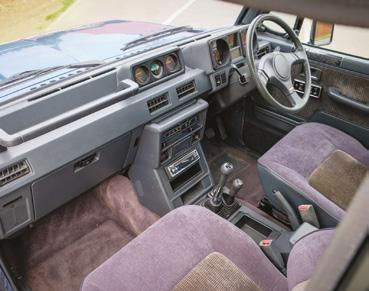

34 *All hammer prices are subject to a Buyer’s Premium of 12.5% plus VAT
24
2000 Daihatsu Fourtrak Independent

No Reserve
Reg No: W72 LAJ MOT: April 2024
Chassis No: JDA000F7800517705
The second-generation Daihatsu Fourtrak, introduced in 1993, featured notable technical advancements. It offered a range of engine options, including the 2.8-liter turbocharged diesel engine (DL52) with direct injection and an intercooler. This engine delivered around 101 hp and 192 lb-ft (260 Nm) of torque, providing excellent low-end power for off-road performance and towing. The Fourtrak boasted a robust part-time 4x4 system with manual locking front hubs, ensuring optimal traction and capability in various terrains. Its suspension system consisted of a solid front axle with coil springs and leaf springs at the rear.


Presented in an attractive shade of Dark Blue with complementing cloth interior, this particular 2000 model year car is a top of the range TDX independent model and although its relative small size, compared to its counterparts, benefits from seven seats and a 3,500kg towing capacity. With just 50,885 miles on the odometer and 2 former keepers, this presents a great opportunity for a collector looking to acquire one of these rare and interesting vehicles.
Having only covered 2,600 miles over the last ten years, last year the car was subject to nearly £1,200 in expenditure. This included spring and shock mounts being replaced, suspension arm replaced, some welding, a service, the cambelts and tensioners replaced and other minor fettling. Now offered for sale from a private collection as the owner has another example he would prefer to keep, ‘W72 LAJ’ comes accompanied with a history file containing the original book pack with a number of handbooks. The owner’s manual is present with 13 service stamps, with the car booked in for another service prior to sale. The V5C document is included which displays 2 former keepers and there are two invoices for the works completed last year.
35 *All hammer prices are subject to a Buyer’s Premium of 12.5% plus VAT
25
1970 Triumph TR6
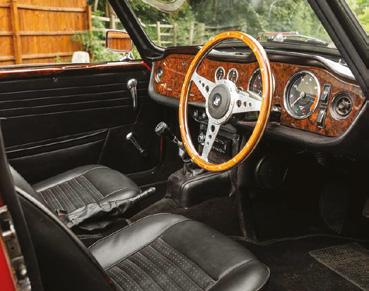
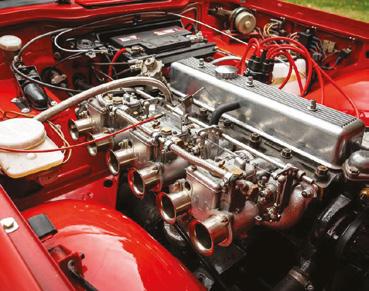
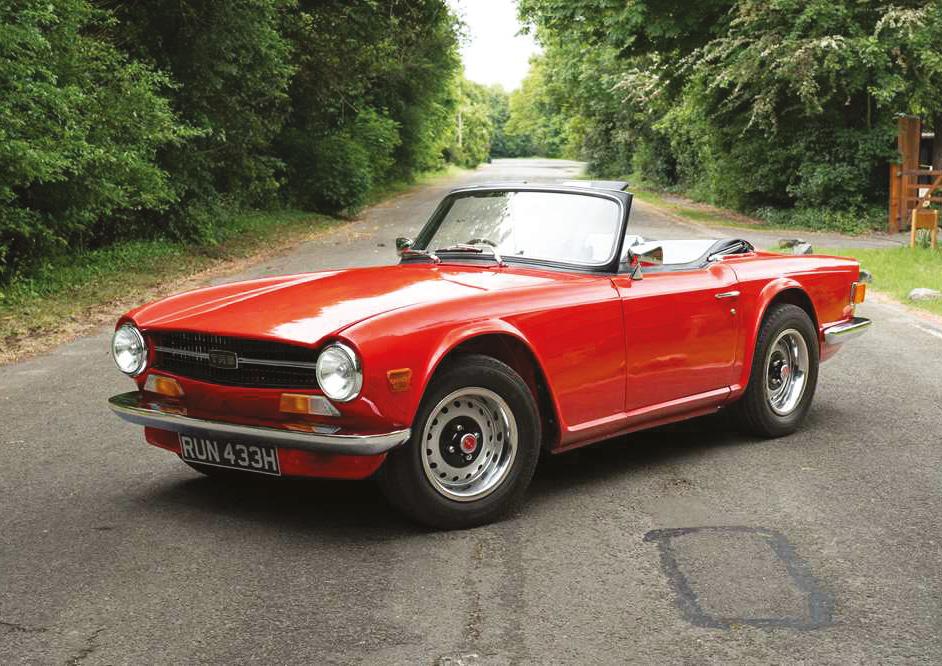
Estimate: £18,000 - £20,000*
Reg No: RUN 433H MOT: June 2024
Chassis No: CP511830
Introduced in 1968 as a replacement for the outgoing TR250/TR5 models, the Triumph TR6 proved a strong seller on both sides of the Atlantic. Crisply styled, its smooth flowing lines and Kamm tail hid a cruciformbraced chassis equipped with all-round independent suspension, disc/ drum brakes and rack-and-pinion steering. Powered by a refined 2498cc OHV straight-six engine allied to four-speed plus overdrive manual transmission, it was deceptively fast with contemporary road testers recording 0-60mph in 8.2 seconds and a 121mph top speed. Writing in 1969, Autocar magazine went as far as to comment that “Even if the Austin-Healey 3000 had not been dropped, the TR6 would have taken over as the he-man’s sports car in its own right”.
Entering its current ownership in 2018, ‘RUN 433H’ is a desirable UKsupplied CP-series model that has benefited from a huge amount of expenditure in recent years. Supporting photographs in the car’s sizeable history file show that the roadster was taken back to baremetal and resprayed in striking Signal Red just a few years ago. On-road performance and the six-cylinder soundtrack were enhanced with the fitment of triple Weber carburettors, recently set up on a rolling road by Mass Race engines (who are known to be amongst the best tuners in the industry). Said by our vendor to “drive extremely well”, the car has just passed an MOT inspection with no cause for concern and will be driven to the auction venue. Offered with a current UK V5c registration document and sizeable history file, containing restoration photographs, receipts, tax disks and expired MOT certificates.
Sensibly guided, this open-top Brit is guaranteed to provide champagne motoring this summer, for lemonade outlay!
36 *All hammer prices are subject to a Buyer’s Premium of 12.5% plus VAT
26
1936 Rover 10hp Six Light Saloon

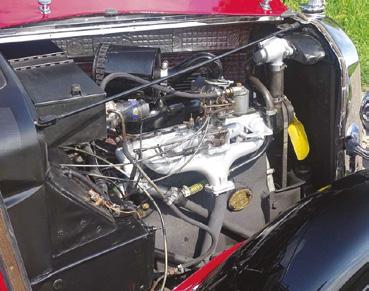
Estimate: £12,000 - £16,000*
Reg No: DHX 53 MOT: 601750
Chassis No: 601750
Introduced in autumn 1933, the new Rover 10 (retrospectively dubbed the ‘P1’) was notable as the first model to be developed by the recently arrived Wilks brothers, Spencer and Maurice, who would go on to have such a profound effect on the company. Over forty percent more expensive than the Austin 10, the newcomer signalled a determined move upmarket. Based around a sturdy, ladder-frame chassis (underslung at the rear) equipped with all-round semi-elliptic leaf-sprung suspension and four-wheel drum brakes, the Rover 10 was powered by a new 1389cc four-cylinder engine allied to four-speed transmission. A novel ‘freewheel’ device helped facilitate gear changing and improved fuel economy. Available with a choice of open and closed factory bodystyles made by the Pressed Steel company, the P1 chassis could also be clothed by outside coachbuilders. Some 9,202 examples of all types are thought to have been made but today survivors are comparatively scarce.
Thought to have begun life in Middlesex (or so its ‘DHX 53’ number plate would imply), chassis 601750 had relocated to Ilminster by the time it first came to the notice of the Rover Sports Register during the 1980s. Other paperwork on file suggests that the handsome Six-Light Saloon coachwork was removed from the chassis and refurbished late the following decade. The engine was thoroughly overhauled, the wiring renewed and the interior re-trimmed in 2000 (circa 11,000 miles ago). The vendor, who has numerous concours wins to his credit, acquired ‘DHX 53’ during 2021 and set about bringing it up to his usual standards. As well as being repainted in Maroon over Black, the Rover has had attention paid to its steering box, leaf springs and brakes. Much of the interior wood has been repolished and the brightwork smartened with the radiator slats being restored too. Coming to market due to the seller’s loss of mobility, he can still see ways to improve the 10. Although, to our eyes it already presents as a jewel of a car!

37 *All hammer prices are subject to a Buyer’s Premium of 12.5% plus VAT
27
1974 Triumph Stag
Unrestored, low-mileage UK car with just 1 former keeper
Estimate: £18,000 - £22,000*
Reg No: GGC 351N MOT: May 2024 Chassis No: LD335130
Introduced in June 1970, the Triumph Stag was conceived as a luxury convertible sportscar to rival the likes of the R107-series Mercedes-Benz SL. As such, it came equipped with electric windows, power-assisted rack and pinion steering, and servo-backed disc / drum brakes as standard. Based around a two-door monocoque bodyshell (stylist Giovanni Michelotti had physically shortened a pre-production Triumph 2000 saloon in order to fashion the initial prototype), the newcomer featured all-round independent suspension (McPherson strut front / semi-trailing arm rear) and a well laid-out 2+2 cabin. Neatly integrated, the substantial roll-over hoop that joined the B-pillars gained extra strength from a T-bar link to the windscreen frame. With some 145bhp and 167lbft of torque on tap from its bespoke 2997cc SOHC V8 engine, the model was reputedly capable of 120mph. Available with a choice of four-speed manual or three-speed automatic transmission, all but the earliest Stags benefited from both hard and soft-top roofs. Despite being in production for seven years, during which time 25,877 cars were made, a mere 9,500 or so are thought to have survived.
The remarkable Triumph Stag offered here was delivered by Cheam Motor Distributors Ltd to O & M Office Equipment on the 11th of October, 1974, for use as a company car. Finished in the very 1970s colour combination of Maple Brown with a Saddle Tan interior, this original UK-supplied car was fitted with a manual transmission with overdrive and came with a factory hardtop. For the first four years the car was serviced by Cheam Motors for its first owner, as evidenced by the service stamps in the official Passport to Service booklet, with the last one at just over 40,000 miles. In 1978 the second and, to this date, last registered keeper, who was a Stag Owners Club Coordinator, acquired the car and has looked after it meticulously ever since. With only 52,500 warranted miles on the odometer, the Stag still pleasingly retains not only the original delivery specifications but is still fully matching numbers with all the original body panels and interior trim. Over the years the original paint has been touched up in a few small places but apart from that, the car still appears to sport the original paint it left the factory with and we believe it has never been welded. It also retains its original convertible hood which is still in very good condition, mostly due to the fact that the owner always took care to unzip the rear window when folding the hood and mostly kept the hardtop fitted.
The car was kept garaged while in the second owner’s custodianship and was Waxoyled every year. According to John, of Stag Servicing, Dorking, the car has been very well looked after all its life and has just recently been fitted with a new water pump, alternator and starter motor. All the original items are also still kept with the car. In May 2023, it also received a clutch master cylinder oil service and carburettor balancing and tune-up by specialist Stagbay. Offered with a fresh MOT with no advisories, a sheaf of invoices, old MOTs, substantiating the mileage, the dealer-stamped Passport to Service booklet, the original owner’s handbook and the current V5C Registration Document, this is a car for the true Stag collector.
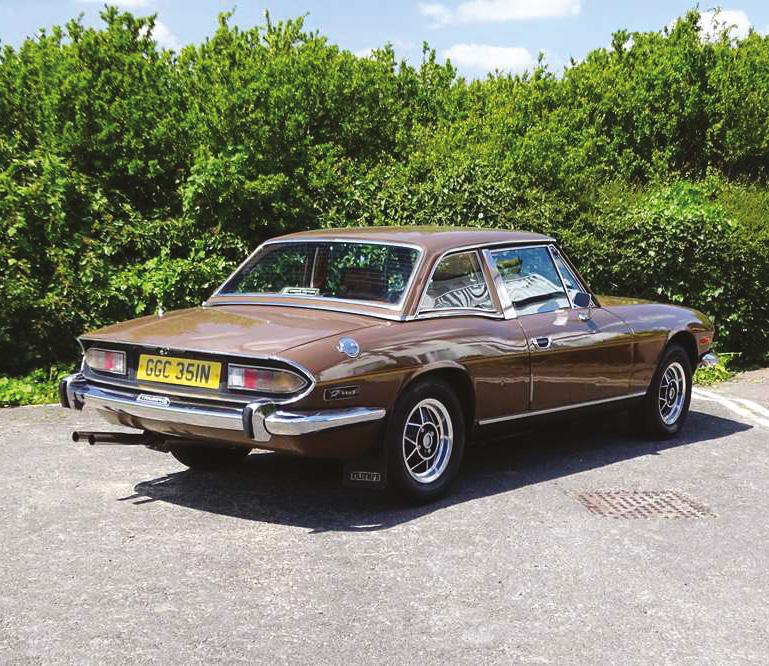
38 *All hammer prices are subject to a Buyer’s Premium of 12.5% plus VAT
28
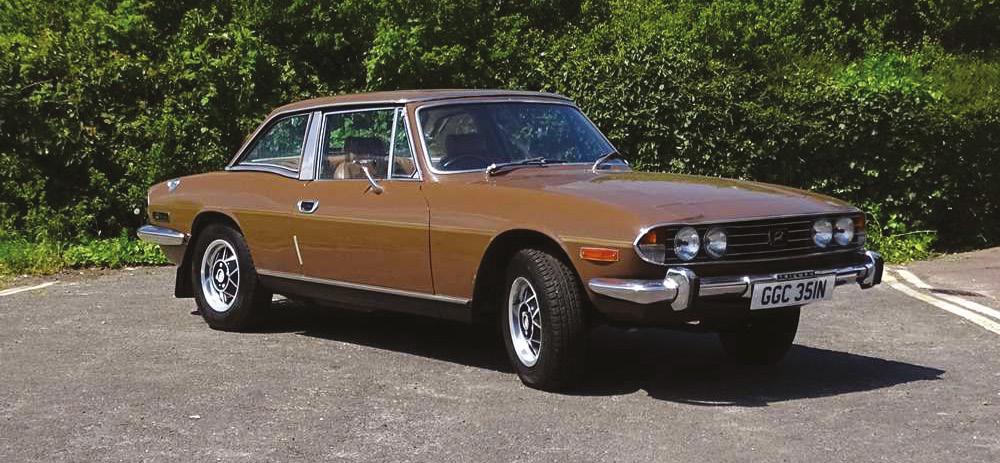
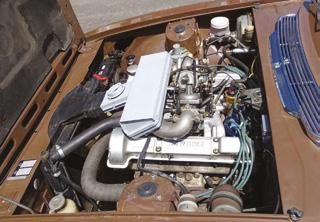

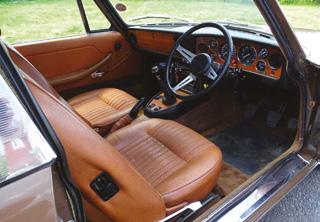

39
1981 Lancia Beta 2000 Spyder
Low mileage and ownership, ‘garage find’ example
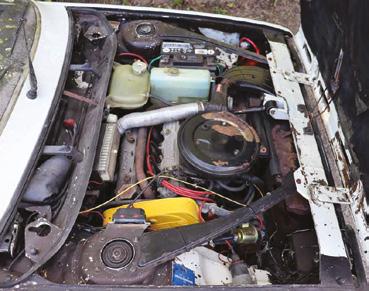
Estimate: £12,000 - £14,000*
Reg No: HHG 770W MOT: Exempt
Chassis No: 828BS1004714
Manufactured new in 1981, ‘HHG 770W’ was supplied new by and first registered as a dealer demonstrator to Parkers Lancia of Bolton. Finished in White (Bianca Corfu) with Black interior upholstery, soft-top and Targa top, the Lancia was supplied new to its first private owner in 1981. Rust protected from new with ‘Cryla Gard’ Dupont acrylic resin coating protection, the Beta appears to have been coated with Ziebart in the inner wings and wing tops when new as well. Its 56,527 miles were covered before being placed into dry storage in 1988.

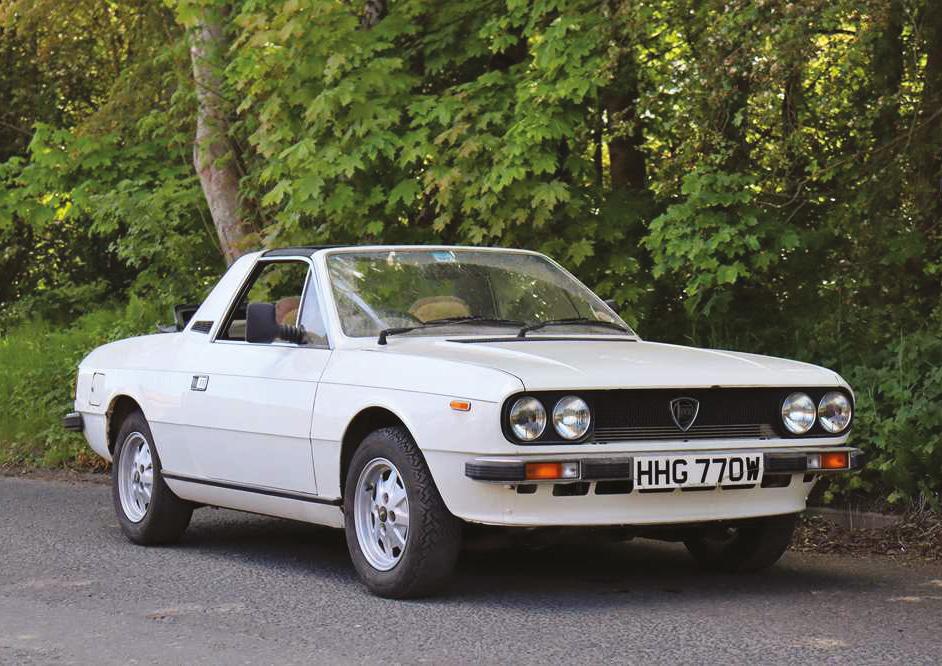
Purchased by the vendor in ‘garage find’ condition from the daughter of the first private owner in 2021, the Lancia was found to be highly original. The vendor informs that it is remarkably solid and has not been welded, likely due to the coating from new, and advised that a professional inspection revealed no welding would be required for an MOT and the car lifts square on its jacking points. Sympathetically recommissioned by the vendor, the Spyder has received a new in-line fuel pump, carburettor refresh, brake pipe renewal, and a fresh battery, with the Lancia starting readily and running and driving during our photography session, but will likely require further light recommissioning/checking through before general use. Complete with its alloy wheel centre caps, there are pleasingly no cracks present in the dashboard top.
Remarkably original, the bodywork and paintwork are believed as factory. Stowed in the boot is the tonneau cover, spare wheel and cover, jack, toolkit, owner’s handbook, and, painting a picture of its life prestorage, a roll of 1980s retro shopping bags, various road maps, air show tickets, 17p fruit pastille wrappers and other items, all telling the tale of a much-loved family car in the day. A very rare Beta Spyder, with both low ownership and mileage, this is surely an unrepeatable original example, ‘HHG 770W’ would be ideal for summer use once checked through. It’s a ‘find another’ situation!
40 *All hammer prices are subject to a Buyer’s Premium of 12.5% plus VAT
29
1975 Volkswagen Type 2 (T1) Fleetline Camper Van
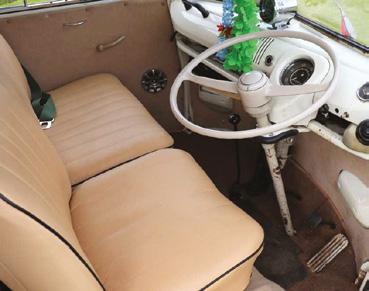
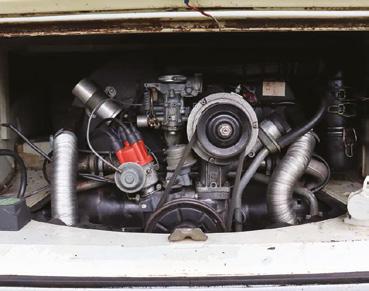
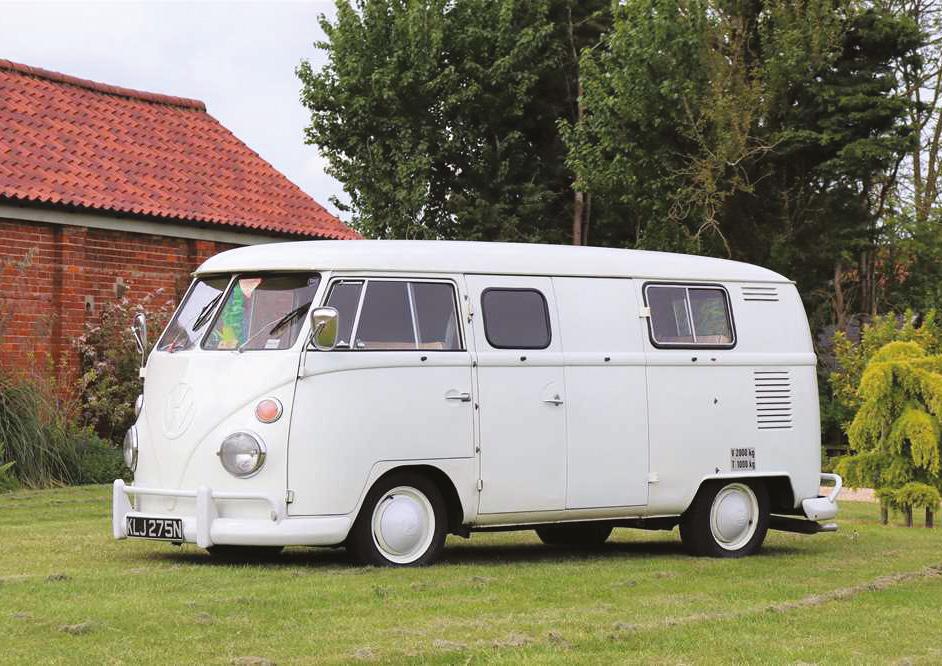
Estimate: £18,000 - £22,000*
Reg No: KLJ 275N MOT: April 2024
Chassis No: 2051000835
Manufactured in the final production year for split-screens globally, chassis number 2051000835 is understood to be a ‘Fleetline’ example and would have been supplied new to South Africa, hence the right-hand drive configuration. Fleetline’s were those split-screen vans assembled by VWSA from Volkswagen do Brasil-built kits, either CKD (completely knocked down) or SKD (semi knocked down). They were built for one year only, the 1975 model year. Fitted with 1600cc flat-four engine allied to the four-speed manual transmission, the Volkswagen is finished in White. Reputed to have resided in South Africa until 2010, the T1 was imported to the United Kingdom and road registered ‘KLJ 275N’. Purchased by the vendor in 2012, ‘KLJ 275N’ was used for music festivals and events for several years. The interior is nicely specified with a rock ‘n’ roll bed, table, fridge, stove, sink and gas bottle, stow-away table, plug sockets, both main and leisure batteries, and a very good Bluetooth stereo system with Blaupunkt speakers.
In 2021, the Type 2 was lavished with over £10,000 worth of expenditure with both Type 2 Detectives and R.A.D Bodywork. Comprehensively mechanically overhauled, the improvements included a steering box overhaul; braking and handbrake attention; dual circuit master cylinder; new front wheel cylinder pipes and shoes; gearbox re-sealing; Bilstein rear shock absorbers; CSP pushrod tubes; engine servicing and refitting; starting equipment refresh; and much more with the full Type 2 Detectives image shown in the images. Bodywork wise, the doors and door shuts were repaired as required and repainted, and some new trim pieces were supplied. Accompanied by a no advisory MOT certificate until April 2024, a few previous invoices and MOTs, and a current V5C document, the Volkswagen is also offered with an unused Classic Additions fitted car cover (costing almost £300 new).
41 *All hammer prices are subject to a Buyer’s Premium of 12.5% plus VAT
30
1993 Asquith London Taxi
The original demonstrator vehicle
Estimate: £12,000 - £15,000*
Reg No: L30 TAX MOT: May 2024
Chassis No: SA9TS1H93GB033028
In the early 1980s, Crispin Reed and Bruce West embarked on producing reproduction desks and leather sofas. However, they soon recognized the limitations of using a vintage 1928 “Austin 12” van for local deliveries due to its lack of reliability. To address this, they stripped a Ford Transit and fitted it with a unique body shape inspired by the 1929 Talbot and Model A Ford vans. The resulting vehicle, named the Asquith, proved to be both distinctive and dependable, leading them to further develop the concept.


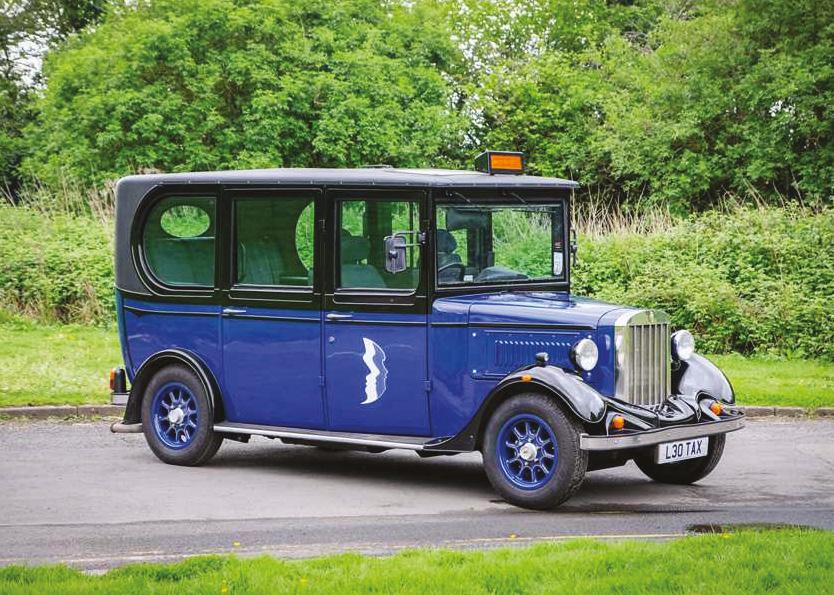
Operating from a factory in Great Yeldham, Essex, Asquith Motor Carriage Company Ltd produced hand-built replicas that blended vintage allure with modern functionality. The company employed 30 craftsmen and manufactured approximately 100 vehicles per year. Their vehicles gained popularity in the UK and were exported to various countries, with Germany and Japan as significant markets.
In 1991, Asquith Motors introduced a newly designed 1930s-style taxi cab that met the demanding standards of the London Public Carriage Office. Only a limited number of these exceptional taxis were produced, serving as bona fide taxis and providing passengers with nostalgic aesthetics and reliable transportation. Asquith Motors earned acclaim as a premier coachbuilder of these early “restomods,” showcasing their exceptional craftsmanship.
One outstanding example of an Asquith taxi is the original demonstrator vehicle built and owned by Asquith themselves. Finished in its original blue paintwork with black roof, wings, and accents, this remarkable Asquith showcases its historical significance. Equipped with refreshed air suspension and disabled access, the vehicle features notable details such as a sunroof, illuminating signs with a fare meter, a Kenwood stereo system with a CD multichanger, and a sliding privacy window. With 34,771 miles on the odometer, the vehicle comes with the Asquith booklet, a valid MOT until 09 May 2024 with no advisories, and the V5C document showing only two former keepers. It stands as a testament to Asquith’s legacy and craftsmanship.
42 *All hammer prices are subject to a Buyer’s Premium of 12.5% plus VAT
31
1958 Bentley S1 Saloon
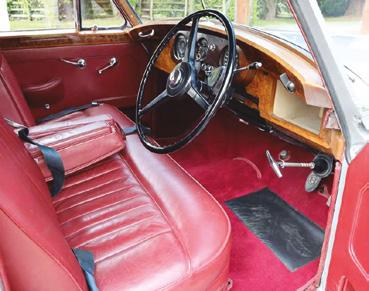

Estimate: £18,000 - £22,000*
Reg No: FHC 434 MOT: Exempt
Chassis No: B381FD
The Bentley S1 was unveiled in April 1955. A very different car from its predecessors, it was longer and wider and based on a much stiffer chassis. Though the traditional body-on-chassis construction facilitated the manufacture of special-bodied versions, most were delivered with the standard offering produced by Pressed Steel Ltd, featuring alloy doors, bonnet and boot lid.
Powered by the final iteration of the company’s venerable 4.9-litre straight six engine featuring revised cylinder-head porting, power was quoted at 178bhp. As standard, the unit drove through a four-speed automatic gearbox with steering column control. Suspension was independent at the front by wishbones and coil springs and employed a leaf-spring mounted live axle at the rear. Braking was by drums all round. A total of 3,107 examples were produced between 1955 and 1959.
Beginning life in 1958, ‘FHC’ was built for Yardley & Co, with a copy of the build card on file. In 2004 it was repatriated from the USA after residing there for many years. Finished in Silver with complementing Red leather the Bentley features power steering as well as automatic transmission. Current ownership has endured since 2009, having been purchased from ourselves that year, then repainted White.
‘FHC’ has benefitted from attention to the mechanicals and bodywork over the years. A stainless steel exhaust was fitted in 2014 and a reconditioned gearbox in 2015 at the cost of £6,900. The brakes were the subject of an overhaul in 2015. Repainted in a shade that appears similar to Aston Martin’s Silver Birch in 2017, ‘FHC’ had a number of panels replaced as part of the repaint. Additionally, in 2017 the Bentley benefitted from a set of new front carpets and new tyres all round. However, with little use in the last 5 years, ‘FHC’ is now available for a new custodian to enjoy. Offered with a collection of invoices and old MOT certificates, original Bentley handbook, tool kit and V5c document.
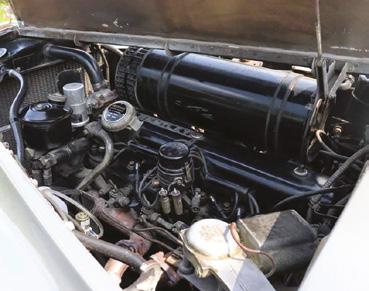
43 *All hammer prices are subject to a Buyer’s Premium of 12.5% plus VAT
32
1989 Jaguar XJ-S V12 Convertible
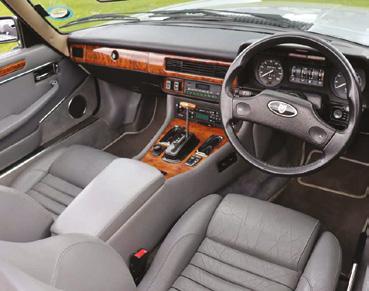

Estimate: £14,000 - £16,000*
Reg No: F898 VAJ MOT: June 2024
Chassis No: SAJJNADW3DB158908
Never envisaged as a direct replacement for the E-Type in 1975, the XJ-S was equipped with automatic transmission as standard. Although, when fed the quoted 295bhp and 318lbft of torque developed by a post-1981 H.E. (high efficiency) 5.3 litre V12 engine, this still resulted in a claimed top speed of 150mph and 0-60mph in less than eight seconds. Introduced at the 1988 Geneva Motor Show, the long-awaited full convertible version featured a reinforced floorpan, frameless doors and sophisticated electric hood (complete with heated glass rear window). Underpinned by the same all-round independent coil-sprung suspension and power-assisted rack and pinion steering as its Fixed Head Coupe siblings, the soft-top came with anti-lock brakes as standard. Priced at some £40,000, a waiting list was quick to form.
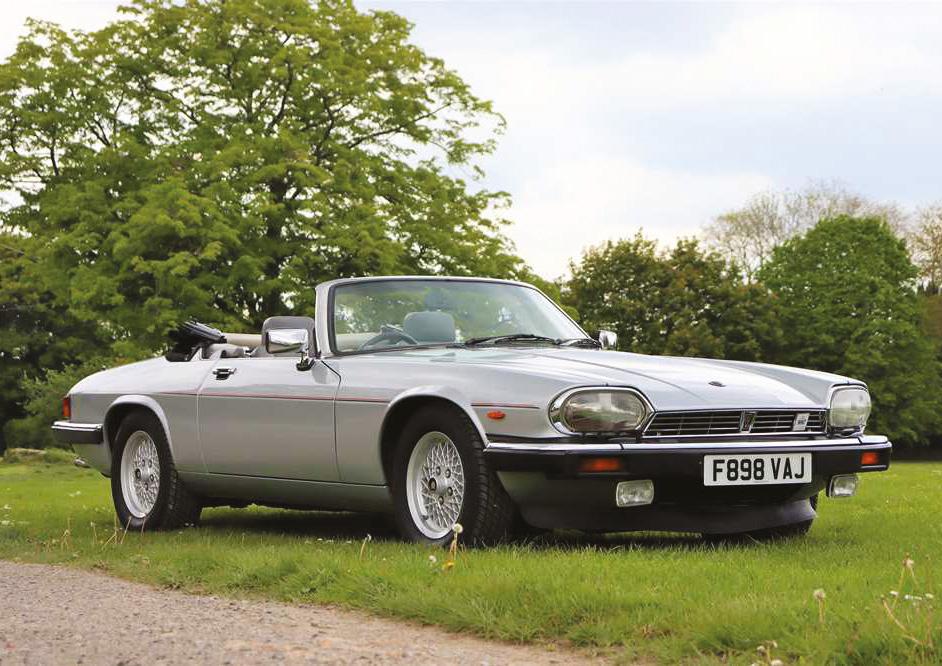
Manufactured new in 1989, the XJ-S offered was supplied new by Dutton Forshaw of Stockton to the first lady owner, being registered new on the 1st of March. Finished in Talisman Silver paintwork with a complementary Grey leather interior and a Black hood, the Jaguar is fitted with the 5343cc V12 engine allied to the three-speed automatic transmission. Covering just over 61,000 miles from new (at the time of consignment), the XJ-S has had just four former keepers. Acquired by the vendor in 2021 from a well-known dealer, ‘F898 VAJ’ is only on sale now due to a reduction in his private collection due to relocating.
Benefitting from some £2,300 worth of expenditure when entering into current ownership, the work completed has included a refreshed cooling system, overhauled differential, replacement handbrake calipers, and new rear suspension arms. The accompanying history file contains a letter from the supplying dealership to the first lady owner, correspondence between her and the factory, a large collection of previous invoices for improvements and servicing (many from the supplying dealership), numerous MOT certificates back to 1992, previous tax discs, and a current V5C document. Shod all round with Pirelli P600 tyres, ‘F898 VAJ’ is due to be offered with a fresh MOT certificate in time for sale.
44 *All hammer prices are subject to a Buyer’s Premium of 12.5% plus VAT
33
1962 Bentley S2
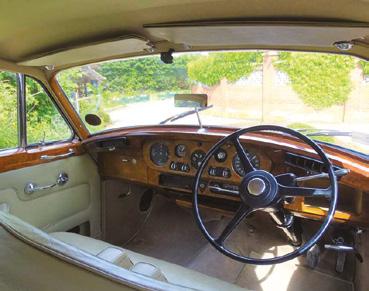
Estimate: £14,000 - £18,000*
Reg No: 293 UXN MOT: Exempt
Chassis No: B74DW

By 1955, Rolls-Royce felt increasingly less need to visually differentiate between its own models and its Bentley-badged ones. The Bentley S1 that replaced the R-Type model was therefore basically a Silver Cloud I behind the distinctive ‘Flying B’ radiator grille. The S1 was the last of the marque to employ the company’s venerable 150bhp 4.9-litre straight-six engine, whose roots could be traced back to the vintage era Rolls-Royce 20. This was mated to a four-speed automatic or optional four-speed manual transmission. The newcomer was built along traditional lines with a separate chassis and body, which facilitated the manufacture of coach-built versions. However, the vast majority were delivered with the Standard Steel one that featured alloy doors, bonnet and boot lid. The suspension was independent by coil springs at the front and featured a live axle attached to semi-elliptic leaf springs at the rear. Braking was by servo-assisted drums all around. Greatly improved performance arrived with the S2 model of 1959, when the straight-six engine was pensioned off in favour of a new 6.2-litre aluminium V8 unit. This raised the top speed to some 114mph and greatly enhanced acceleration. Power steering became standard and electrically operated windows an option.
Registered new on the 5th of October 1962, ‘293 UXN’ is finished in an attractive two-tone colour scheme of Dark Grey over Gold with a Beige leather interior which is believed to be largely original. Having benefitted from a full respray some years ago along with mechanical work to engine and transmission, this Bentley is said by the vendor to drive very well with just a slight ticking sound to the engine. With an exterior and interior which present well for the age of the car, ‘293 UXN’ comes with a history file containing, amongst others, a V5C, old MOTs and old tax discs.
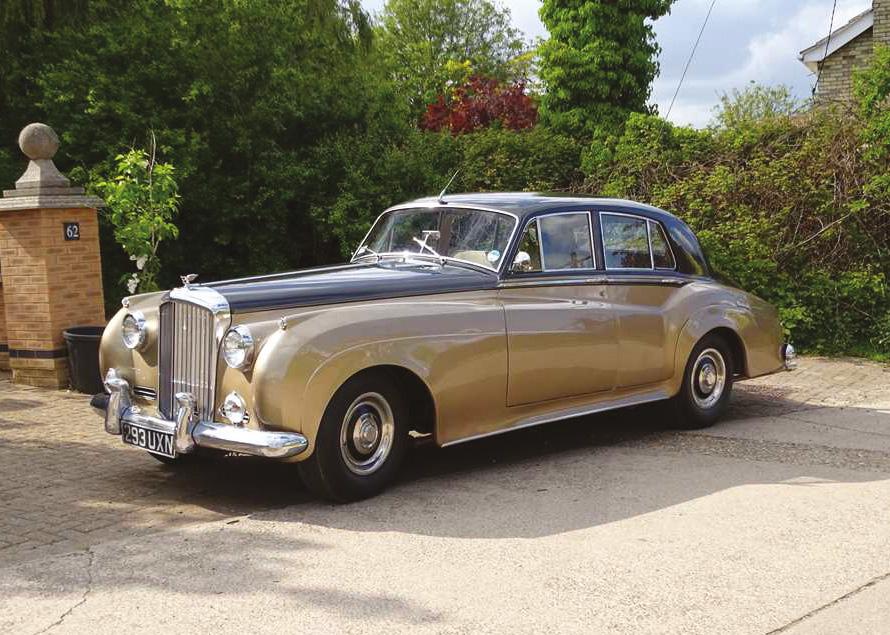
45 *All hammer prices are subject to a Buyer’s Premium of 12.5% plus VAT
34
1971 Jaguar E-Type V12 Coupe

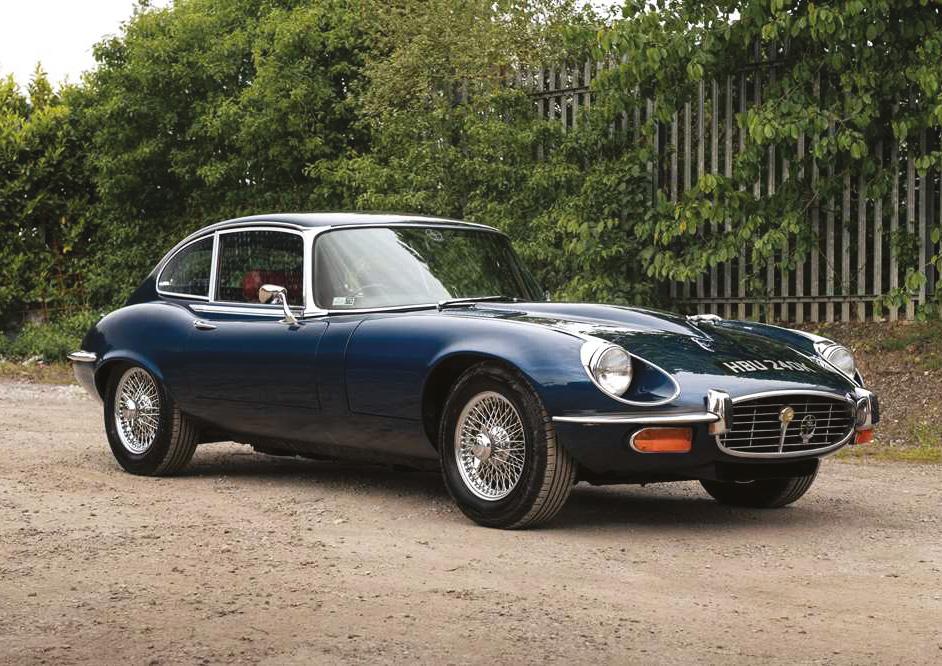
Estimate: £35,000 - £40,000*
Reg No: HBU 240K MOT: Exempt
Chassis No: 1S50247BW
1 of only 2,116 home market examples of 2+2 V12 Coupe manufactured, this particular example has matching chassis and engine numbers. First registered on 8th September 1971 as ‘1 APW’, it retained that registration number up until 1983, ‘HBU 240K’s’ odometer displays some 89,700 recorded and credible miles. Evidently restored some years before the current vendor’s acquisition (believed to have been c.2018 from restoration relevant invoices, with restoration photographs on file), the Coupe is finished in Jaguar Ecurie Ecosse Blue, the colour made iconic by the Ecurie Ecosse racing Jaguars of the 1950s. Previously White, the current paint colour complements wonderfully with the mature Red leather interior and carpeting.
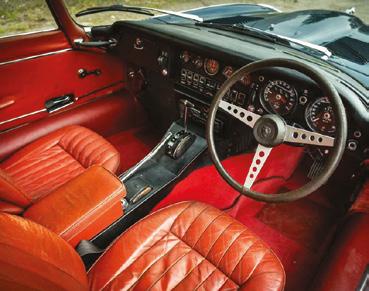
On file are a quantity of invoices for parts and work carried out. They include items from SNG Barrett; a stainless steel exhaust in 2011, an electronic fuel pump in 2012, a wire wheel and 4x splined hubs in 2013. In 2014 c.£16,000 was spent with Nottingham JagTech Limited, for an engine overhaul which included new exhaust manifolds, bearings, timing chains, cylinder liners and valve stem seals. A further 2014 JagTech invoice shows the purchase of sundry items including a head gasket set and service items such as bulbs and carpet set and a battery. There is a copy of correspondence dated September, 2014, on file from the then owner to Jagtech, commending them for their work, stating ‘fabulous job…Perfect!’. A later 2017 invoice with RH Classics of Melton Mowbray shows a £2,617.66 invoice for sundry parts which included parts related to cooling system fettling and, indeed, a new radiator. All of this work prior to the vendor’s ownership.
With an MOT certificate up to the 12th of November, 2023, there is also a collection of old MOT certificates dating back to 1989 accompanying. A copy of mid-1990s and a 1980s V5 and multiple invoices dating back to the late 1980s are also on file along with the current V5C.
46 *All hammer prices are subject to a Buyer’s Premium of 12.5% plus VAT
35
1951 Morris Z-Type Van

No Reserve
Reg No: GNR 561 MOT: Exempt
Chassis No: 52EV33056

The Morris Z-Type Van was a popular commercial vehicle introduced in the 1950s. With its classic curved lines and spacious interior, it quickly became a favourite among small business owners and delivery drivers. The van was known for its durability and reliability, making it a trusted choice for transporting goods across long distances. The van came with a 2.0-litre four-cylinder engine that produced 62 horsepower, allowing it to achieve a top speed of 60 miles per hour. The van was designed with a sturdy chassis and leaf-spring suspension for smooth handling and stability on the road, with hydraulic drum brakes assisting stopping, and a payload capacity of up to 1,200 pounds. With its practical design and reliable performance, over 51,000 are thought to have been manufactured, but survivors are few and far between, making them especially appreciated by collectors and enthusiasts alike.
Manufactured new in 1951, the early history of ‘GNR 561’ is sadly unknown until the Morris was acquired into the ownership of a Bakery in 1987, as documented in the accompanying paperwork, with the Z-Type being used as a promotional vehicle. Finished in Green and Black, the Van presents now with the current family ownership’s former livery, for a classic car and auctioneer business. Residing with said family since 1997, the Z Van was used for a short period upon purchase, before the Morris was placed into dry storage in 2001, remaining off the road since. Sympathetically recommissioned recently to be in running condition in preparation for the sale, the Z Van started readily and ran well during our recent photography session, however will require further attention before pressing into use, most notably to the brakes. Offered without reserve, ‘GNR 561’ is a charming and rare survivor of a Z-Type Van and will make a rewarding recommissioning project.

47 *All hammer prices are subject to a Buyer’s Premium of 12.5% plus VAT
36
1970 Maserati Indy
Estimate: £38,000 - £45,000*
Reg No: FBY 195H MOT: Exempt Chassis No: AM116*358
Although not officially announced until the March 1969 Geneva Salon, the Maserati Indy had appeared in prototype guise on Carrozzeria Vignale’s stand at the previous season’s Turin Salon. Named in honour of the marque’s two great Indianapolis 500 victories (1939, 1940), the newcomer was artfully styled; its crisp lines belying a four-seater interior. Notable as the first Maserati to employ unit construction, the Fastback Coupe was equipped with independent coil-and-wishbone front suspension, a well-located ‘live’ rear axle, front / rear anti-roll bars, four-wheel ventilated disc brakes and recirculating-ball steering. Initially powered by a 4136cc ‘quad-cam’ light alloy V8 allied to either five-speed manual or three-speed automatic transmission, the Indy boasted a 155mph top speed. Superseded by later 4.7 and 4.9 variants, just 440 4.2 litre examples were made.
According to a handwritten letter on file from its long-term custodian of thirty-four years, chassis AM116*358 was built during 1969 and supplied new to a professional basketball player based in Durban, South Africa; the Maserati being the only Italian Grand Tourer capable of accommodating his 7ft 2in frame. Still wearing a rear window sticker for marque specialist Viglietti Motors of Cape Town, the Indy was imported to the UK during 1988. Acquired by its registered keeper later that same year, he entrusted the four-seater to the Fullbridge Carriage Company of Maldon for a bare metal respray and colour change from Blue to Silver in 1993 (at an indicated 82,000km). Featured in the January 2001 issue of Classic & Sportscar magazine, when it was pitched against an Aston Martin V8, ‘FBY 195H’ was fitted with an aluminium bonnet and repainted again by J.S. Bodyworks (the work being completed during November 2006). Now showing some 152,000km on its odometer, the past three decades have seen the Indy benefit from attention to its power steering, suspension, brakes, carburettors, alternator, fuel system and drivetrain. The clutch was renewed in 2014, the gearbox fettled by Phil Peacock in 2016, the airconditioning compressor replaced in 2019, the timing chain / associated tensioner refurbished in 2020 and replacement stainless steel exhaust manifolds installed in 2022. Much of the fettling was carried out by the renowned, Hertfordshire-based firm McGrath Maserati whose Managing Director Andy Heywood valued ‘FBY 195H’ at £70,000 during October 2019.
Pleasingly retaining what it appears to be its original interior complete with Blue leather upholstery and the distinctive, early series ‘dual binnacle’ dashboard, the Maserati also sports a wood-rimmed steering wheel and Green-on-Black’ Veglia instruments. Starting readily upon inspection and running well during our recent photography session, the four-seater rides on correct-type, 14-inch Borrani alloys. The factory-fitted 4.2 litre V8 engine remains in situ and developed a healthy 231bhp and 247lbft of torque when rolling road tested by Atspeed Racing of Rayleigh during December 2019. A rival in period to the likes of the Ferrari 365 GTC/4 and Lamborghini Espada but considerably less expensive today, the Indy is a much-underrated model. A presentable, usable machine, ‘FBY 195H’ is offered for sale with V5C registration document and history file.
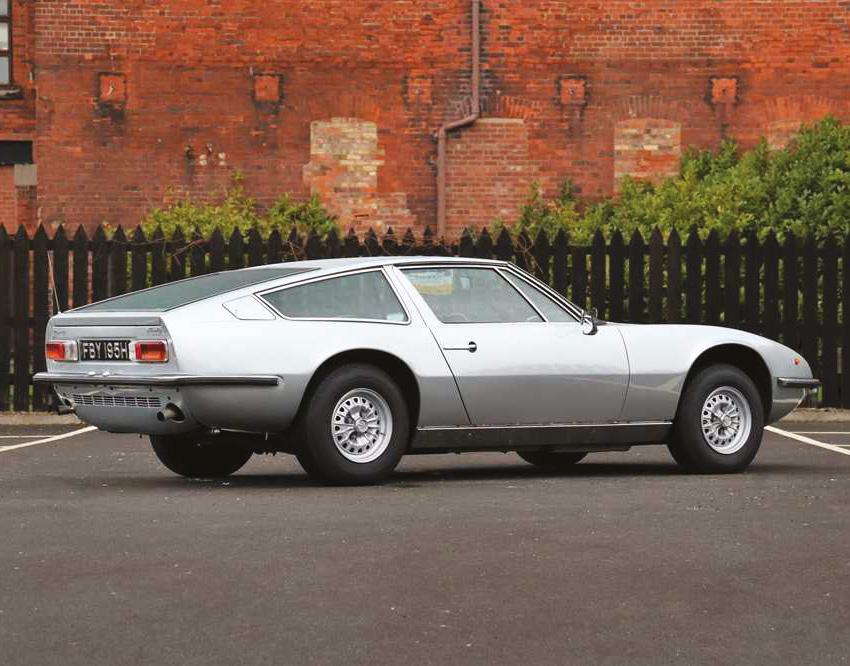
48 *All hammer prices are subject to a Buyer’s Premium of 12.5% plus VAT
37


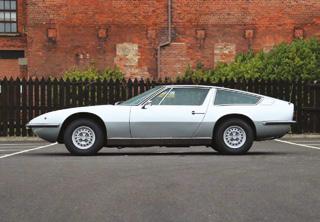


49
1930 Lagonda 2 Litre Low Chassis Speed Model Tourer
Estimate: £80,000 - £100,000*
Reg No: RF 7829 MOT: Exempt Chassis No: OH9782
We are indebted to the vendor for the following description:
RF 7829 is a fine and original example of a low-chassis 2-litre speed model Lagonda tourer. It was registered at the Lagonda factory in Staines in November 1930, and originally supercharged. The supercharger was removed in its early history, prior to John King (1928-2019) purchasing the car in 1956 (original receipt for £165.00 and letter from previous owner on file). It has remained in the King family ownership for 67 years.
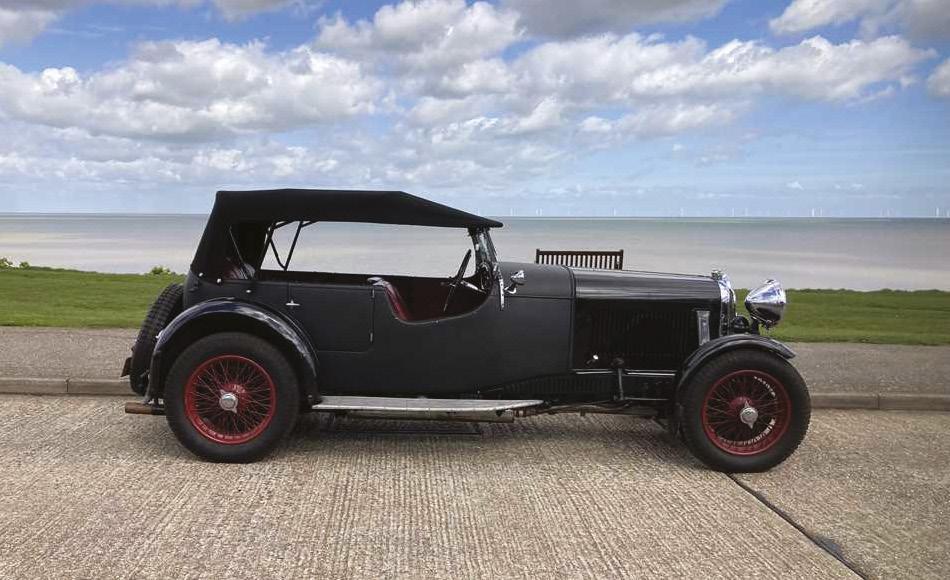
Despite purchasing RF 7829 in a well-worn condition, John and his younger brother immediately drove the car from South London to Fort William in Scotland. On the return journey, the engine failed and the car was towed to a garage in Melton Mowbray, Leicestershire. It was fitted with new chains, but a few miles further on a front mudguard broke off and flew into the hedge, and John decided on a complete renovation. Renting a garage close to his family home in South Norwood, he fully dismantled the car, employing skills acquired as a trainee mechanic after leaving school and subsequently as a telecoms engineer, and from a number of previous car and motorcycle projects. The work took 5 years and was completed in 1961, and included a re-commissioned engine, black leather-cloth on the body, crimson painted wheels and matching red upholstery. The same colours remain today.
John carried out all maintenance until prevented by poor health in the last few years of his life. One of the last major projects he undertook was to renew the external leather-cloth, which remains in immaculate condition. Since then, regular maintenance has principally been undertaken by Mike Morgan (Wilton-Morgan Engineering, Berkshire). Work in more recent years has included an engine and clutch overhaul (late 2000s), replacement hood and carpets, the addition of discreet indicators and cooling fan, and Blockley tyres. The car comes with a comprehensive collection of receipts and correspondence relating to work completed, along with instruction manuals and John’s own notes.
During the initial restoration in the late 1950s, John purchased a second 2-litre low chassis Lagonda (XV 3502) for spares. This and subsequent purchases has resulted in a collection of over 60 items which are included in the sale (and available for collection from the vendor by the successful purchaser), comprising an engine block and cylinder head, rear axle, a complete replacement set of gears, oil pump and filter, oak dashboard, steering wheel and Marles steering box. Many of the items are not currently available as new parts from the Lagonda Club.
RF 7829 – a “wonderful companion”, as described by John – has been kept in good running condition through light but regular use, including trips to VSCC events at Silverstone (entered for only one competition, at Brands Hatch), local outings from the family home in Croydon, and weddings for friends and family, including John’s own in Plymouth in 1972.
The bodywork, paintwork, interior, engine and transmission are currently rated as “very good” and the car is offered with a Swansea V5C registration document and aforementioned spares which, as stated above, will be available for collection from the vendor.
50 *All hammer prices are subject to a Buyer’s Premium of 12.5% plus VAT
38
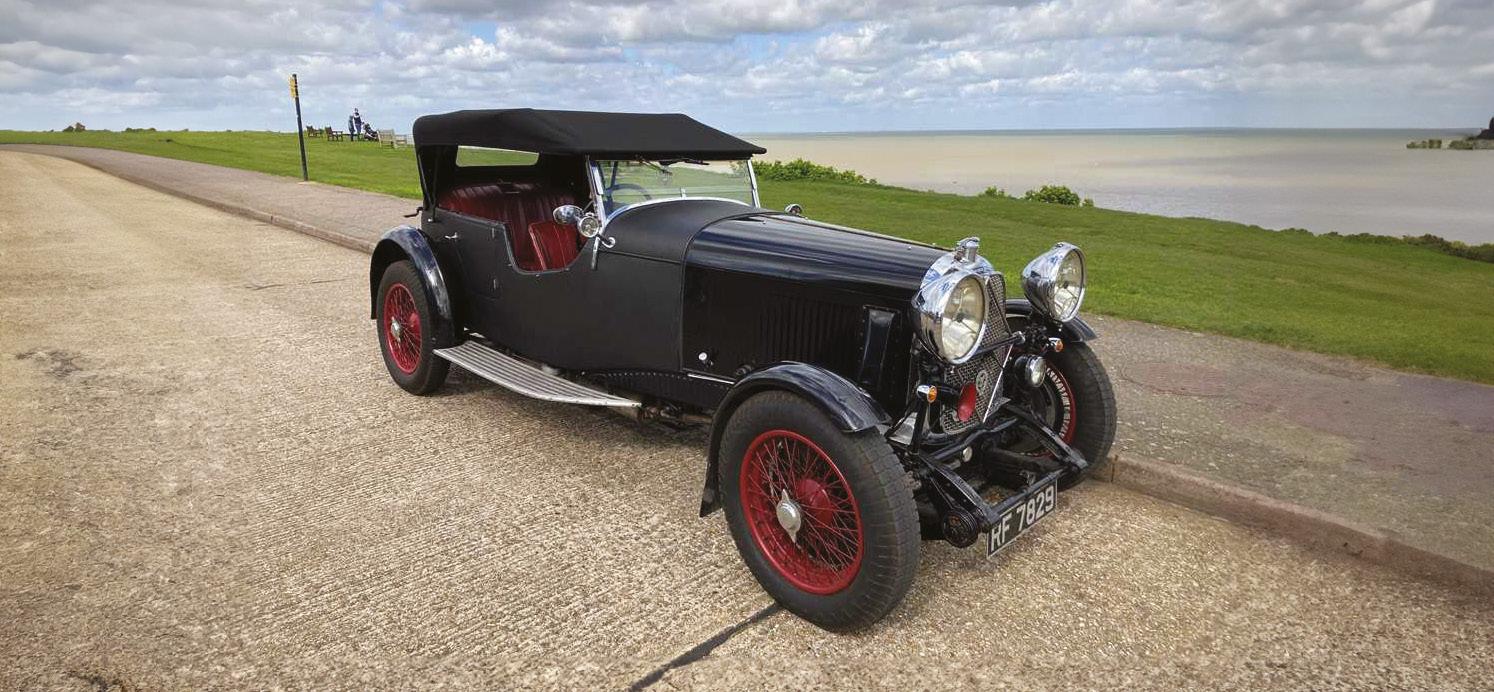



51

52
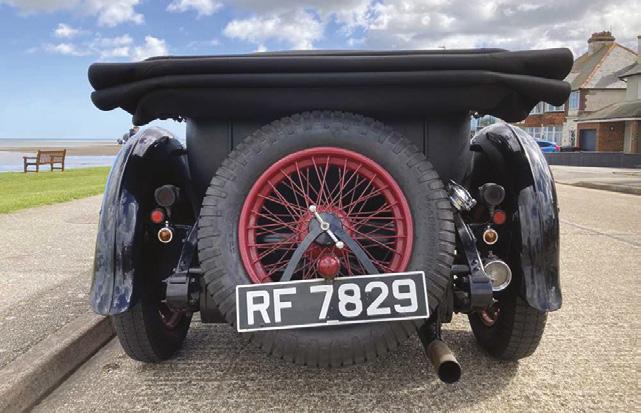
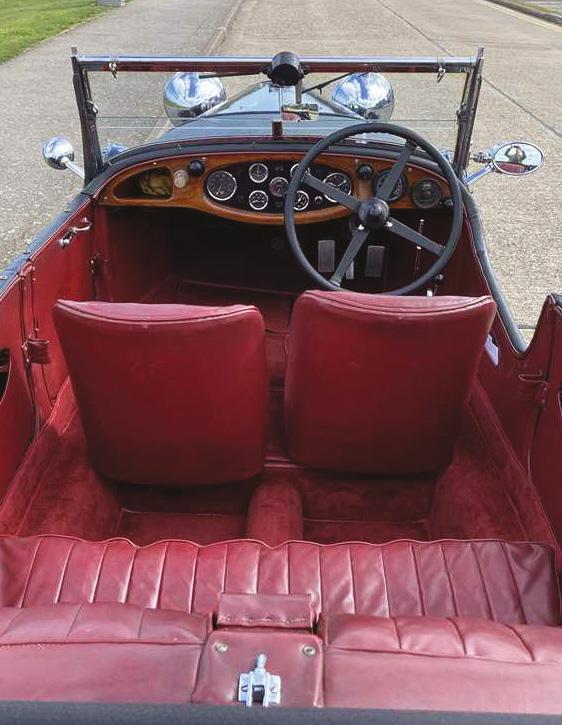

53
1939 Cadillac Series 90 V-16
Seven-Passenger Sedan
One of 18 built in this body style
Estimate: £24,000 - £28,000*
Reg No: 249 YUB MOT: Exempt Chassis No: 5290040
The Cadillac V16 made a resounding debut at the 1930 New York Auto Show, captivating audiences with its breathtaking presence. Initially, the demand for this remarkable automobile was high, but as the American economy teetered on the brink of the Great Depression, production gradually declined. Even the wealthiest buyers, as the 1930s progressed, began to frown upon such extravagant motorcars, favouring subtlety over flamboyance. Nevertheless, the V16 persevered as General Motors’ flagship model, standing proudly as a testament to Cadillac’s unparalleled engineering excellence.
In 1938, Cadillac embarked on a complete overhaul of the V16. The revamped V16 replaced Owen Nacker’s costly and exotic overhead valve design and featured a more conventional design based on the V8 and generating 185 horsepower, a slight improvement over its predecessor, while astonishingly weighing 250 pounds less. Significantly, the new design allowed for more cost-effective production, offering Cadillac the opportunity to finally make the Sixteen a profitable venture.
The influence of the streamline era became more pronounced in the 1938 Cadillac, marking a significant moment for General Motors as it bridged the gap between the traditional classic forms of the early 1930s and the fully integrated styling of the early post-war period. In 1939, only 138 vehicles were built, with just 18 remaining in the body style offered today, cementing the rarity and desirability of these automobiles.
Little is known of this particular example’s early history, but it was purchased by the current owner from a collector based in Indiana in c.2009. The car was shipped to the UK and registered on 01 September 2010, and has been kept as part of a small private collection of American cars since; having been used sparingly for events. Now offered for sale due to ill-health, the odometer displays 66,117 unwarranted, but believable miles. Accompanied with the vehicle is the V5C document which displays zero former keepers.

54 *All hammer prices are subject to a Buyer’s Premium of 12.5% plus VAT
39
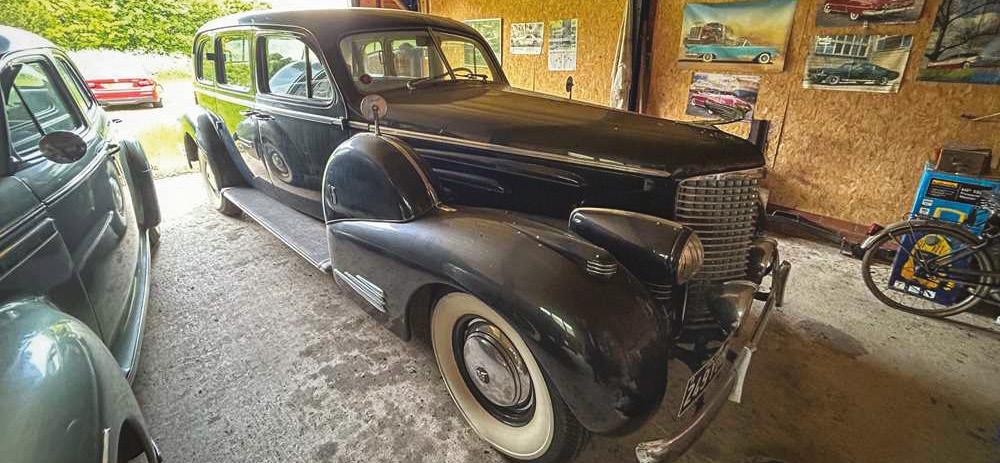

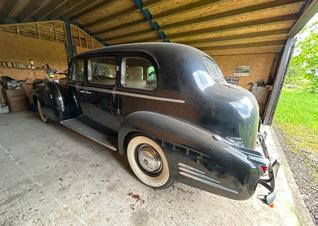


55
1963 Bristol 407


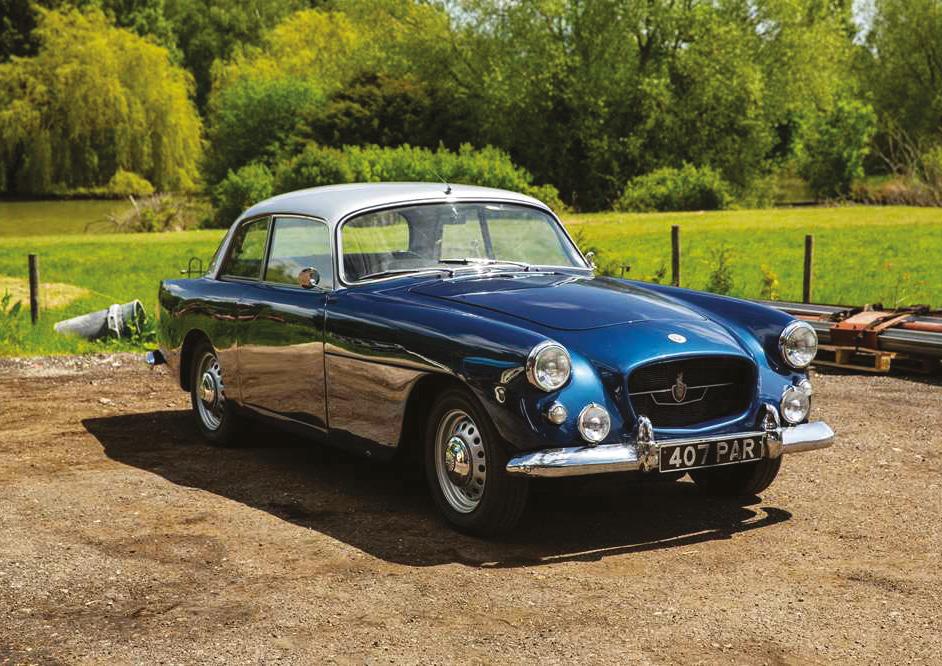
Estimate: £23,000 - £27,000*
Reg No: 407 PAR MOT: Exempt
Chassis No: 4076053
We are informed this 407 with its highly appropriate registration number was resprayed blue from its previous Red in 2001. Acquired by the vendor in 2012 it has formed part of his collection ever since. Now described as having “good” bodywork, paintwork, 5130cc V8 engine, automatic transmission and interior, the odometer displays some 94,500 miles. It is accompanied by a history file containing a quantity of invoices including a number from Bristol Cars and more recently Spencer LaneJones, numerous old MoTs dating back to 1977, a 2012 purchase invoice from Thoroughbred Cars, an Owners Club wallet with T-Key and copy Owners Instructions, two Bristol Owners Club bulletins and Swansea V5C document.
The 407 was in many ways a landmark car for the quintessentially British manufacturer Bristol. It was the first to be produced since the company’s car and aviation divisions had gone their separate ways. It was also the first to be powered by an engine other than Bristol’s own BMW-derived straight-six that, after 14 years of sterling service, now lacked the output of more contemporary units. In its place sat a Canadian-built 5130cc (313ci) Chrysler V8 which, with an output of 250bhp, endowed the 407 with literally double the power of the outgoing 406 and, in instead of the familiar four-speed manual transmission it drove through a three-speed Chrysler Torque flight automatic unit. The front suspension now featured coil rather than leaf springing and the rack and pinion steering was superseded by a Marles worm-type system. The styling, more evolution than revolution, resulted in sharper lines and flatter panels than exhibited by its predecessor. Motor magazine’s period road test of the model proved it capable of sprinting to 60mph in 9.2 seconds and accelerating on to a top speed of 125.2mph. Introduced in 1961, and during a production run of just over two years, 88 two door saloons were produced.
56 *All hammer prices are subject to a Buyer’s Premium of 12.5% plus VAT
40
1956 Bentley S1 Standard Steel Saloon

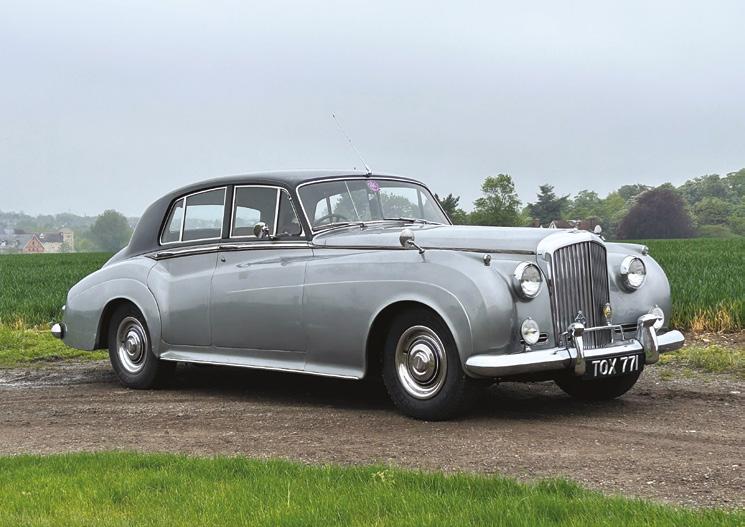
Estimate: £18,000 - £22,000*
Reg No: TOX 771 MOT: Exempt
Chassis No: B238DB
This remarkable ‘S’ Series Standard Steel Saloon still retains much of its original factory issued paperwork even down to the cardboard instruction tags which would have been affixed to various dashboard controls when new! The accompanying Bentley Motors (1931) Ltd delivery note reveals that chassis B238DB reached supplying dealer P.J. Evans Ltd of Birmingham on 5th November 1956. Finished in Black with Tan leather upholstery, the luxurious four-seater was duly issued with the local number plate ‘TOX 771’. Well known to P.J. Evans Ltd during its early life, the Bentley was sold by them to Arthur E. Cooke Esq of Pressoturn Ltd, Leamington Spa on 27th August 1962 complete with a three months’ guarantee. Mr Cooke had the car regularly serviced via P.J. Evans Ltd, Rippon Bros and Appleyard Rippon as well as commissioning Davies & Co. Ltd of Birmingham to paint the lower half Shell Grey in 1967 and partially restore the bodywork (new front wings and sills etc) some four years later. Judging by the way it has been polished through to the primer in places and touched-up in others, it appears that much of the fifty-plus year old cellulose paint has survived. Treated to a partial engine overhaul at an indicated (1)35,372 miles during March 1973, the ‘S’ Series has been registered to the same Coventry address for the past thirty-two years (presumably passing between owners in the same family). Entrusted to Graham Whitehouse Autos Ltd in October 2007 at an indicated (1)44,816 miles for some £10,000 worth of work including the fitment of a reconditioned automatic gearbox and stainless-steel exhaust plus brake system fettling, more recent maintenance has been carried out by marque specialist Balmoral UK. As well as installing electronic ignition and waxoyling the underside, the latter paid attention to the cooling and ignition assemblies. Starting readily and running well during our recent photography session, the Bentley currently shows a highly credible (1)53,000 miles to its odometer and still has its factory inspection lamp and toolkit.

57 *All hammer prices are subject to a Buyer’s Premium of 12.5% plus VAT
41
1964 Sunbeam Rapier Series IV

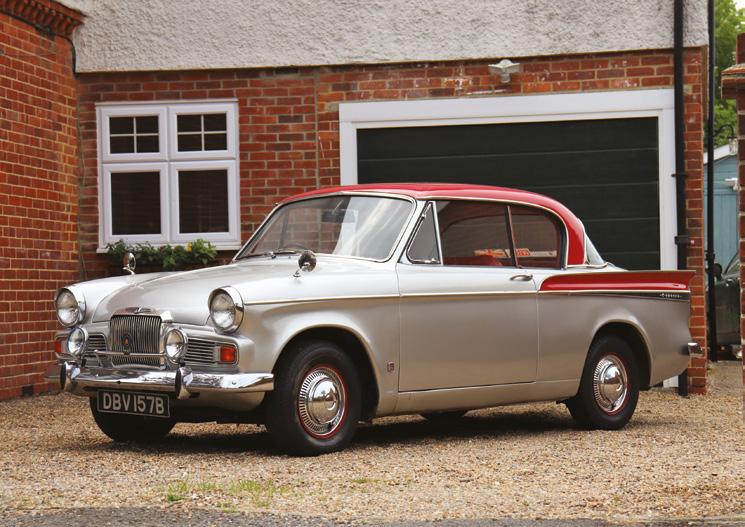
Estimate: £12,000 - £14,000*
Reg No: DBV 157B MOT: Exempt
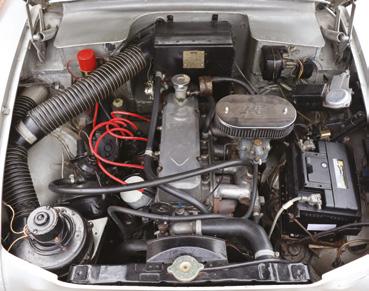
Chassis No: 3303866HH0
Arriving late in 1963, the revised Series IV Rapier was marketed as a touring saloon rather than a sports coupé (as previously) to give it a new lease of life. The most obvious difference was the change to 13inch (330 mm) road wheels in common with the rest of Rootes’ light car range. When production of the Series IV ceased in 1965, 9,700 units had been built.
Manufactured new in 1964, the Rapier offered was supplied new to the Blackburn region, being registered new on the 22nd of April that year. Fitted with the 1592cc straight-four engine allied to the four-speed manual transmission, the Sunbeam presents in the attractive colour combination of Silver with Pippin Red roof and wing fins, and a complementary Red vinyl interior upholstery and carpeting. Displaying a recorded and credible mileage of 62,503 miles, the early ownership history is unknown until the 1990s, before being in the ownership of four individuals until 2011. Subsequently purchased that year by John Simpson, a well-known name in classic car circles and formerly the Chief Mechanic for Practical Classics magazine, ‘DBV 157B’ featured in the ‘Staff Car Sagas’ section of the magazine on a number of occasions including having a replacement timing chain and head gasket, bodywork repairs and paintwork, and wheel refurbishment. Retained by him for seven years, the vendor, a friend of John’s, acquired it from him upon hearing it was going to come for sale. Further improved by the vendor, over £2,200 was lavished on the Sunbeam in 2021 with work completed comprising new suspension bushes, front wheel bearings, ball joints, track rod ends, brake lines and full service, the Rapier started readily and ran very well during our photography session. Offered with a large history file that contains a large selection of invoices documenting work undertaken, numerous previous MOT certificates, past tax discs, an original lubrication chart, workshop manual, parts list, owners’ handbook, a large picture of the Rapier and other sundry paperwork and manuals.
58 *All hammer prices are subject to a Buyer’s Premium of 12.5% plus VAT
42
1957 Austin-Healey 100/6
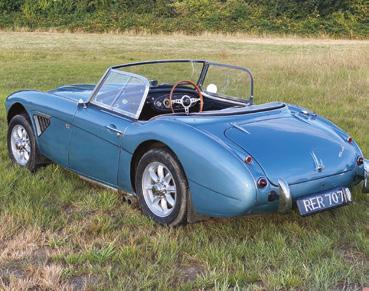
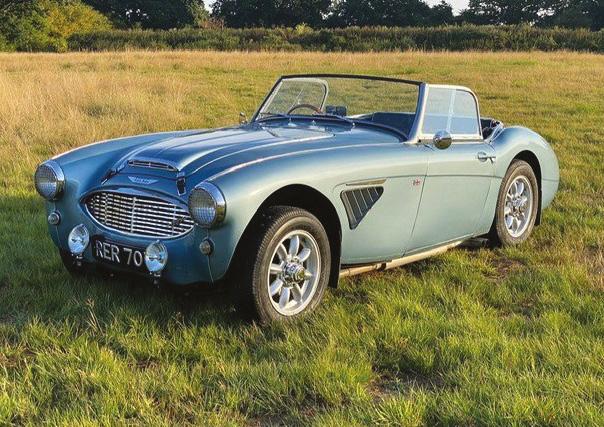
Estimate: £34,000 - £38,000*
Reg No: RER 707 MOT: Exempt
Chassis No: BN426099
This early specification BN4 is a home market RHD example finished in Blue with a Blue interior. Unfortunately, the car’s extensive history file has been mislaid but we understand it is an older restoration that incorporated some rally-style modifications and we are further advised it has been enjoyed by just two previous owners from new. Described as having “very good” bodywork with “good” paint and “excellent” engine, transmission and interior trim, the four-speed gearbox benefits from overdrive and a tonneau cover is present along with hood and side screens. Offered with Swansea V5C document this sporting Healey is worthy of close inspection.
The Healey 100/4 was assembled by Austin at Longbridge using Austin A90 Atlantic mechanicals and bodies crafted by Jensen Motors. For 1956, the wheelbase was lengthened, the bodywork facelifted and the fourcylinder engine replaced by BMC’s six-cylinder C Series unit. Called the 100/6, it was initially available in 2+2 guise (BN4), with a two-seater (BN6) version following in 1957. The last of the 100 models, the BN4 and BN6 were more refined than the preceding 100/4 with early versions producing around 102bhp, but by 1957 output of the 100-Six had risen to 117bhp (thanks to the adoption of a new twelve-port cylinder head).
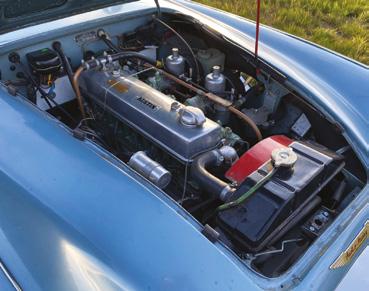
59 *All hammer prices are subject to a Buyer’s Premium of 12.5% plus VAT
43
1969 Jaguar E-Type 4.2 Fixed Head Coupe
Estimate: £50,000 - £60,000*
Reg No: YYT 107H MOT: Exempt Chassis No: 1R20593
At launch the Malcolm Sayer-penned E-Type was the fastest production car of its time – its 3.8-litre straight six engine allowing a 0-60mph acceleration time of a whisker over seven seconds and a top speed of circa 150mph. Despite this, the engine size was increased from 3.8 to 4.2-litres in October 1964 and, with the change, came a sweeter allsynchromesh gearbox, better brakes and more comfortable seats. The Series 2 models introduced in 1969 are distinguished by their lack of headlamp covers, enlarged front air intake, repositioned front indicators and taillights, wrap-around rear bumper, twinelectric fans, uprated brakes and refashioned facia and seats. Just 1,071 RHD Series 2 FHCs are thought to have been made.
According to its accompanying Jaguar Heritage Trust Certificate, chassis 1R20593 was completed on 16th December 1969 and despatched to Henlys Ltd of London some four weeks later. Originally finished in Primrose Yellow with Black upholstery, the twoseater was first registered as ‘YYT 107H’ on 10th March 1970. The V5C Registration Document on file shows just four former keepers one of whom commissioned a wellknown motorcycle Tourist Trophy engine builder to carry out an extensive cosmetic and mechanical restoration during the mid to late 1990s. The work was documented via a collection of photographs which remain with the car and resulted in it winning various awards. Thought to have covered less than 10,000 miles since its rejuvenation including a trip to the Le Mans 24-hours race, the E-Type remains highly presentable. Nicely detailed with a wood-rim steering wheel, period Radiomobile 8-track player and underbonnet HR Owen Ltd sticker (the latter might well have been the supplying dealer), ‘YYT 107H’ has recently been treated to new wire wheels all-round plus replacement wheel bearings and fresh hub seals. As impressive underneath as it is on top, the Jaguar pleasingly retains its original factory fitted engine (7R9706-9). Offered for sale with V5C Registration Document, Heritage Certificate, old MOTs, restoration photographs and sundry invoices.
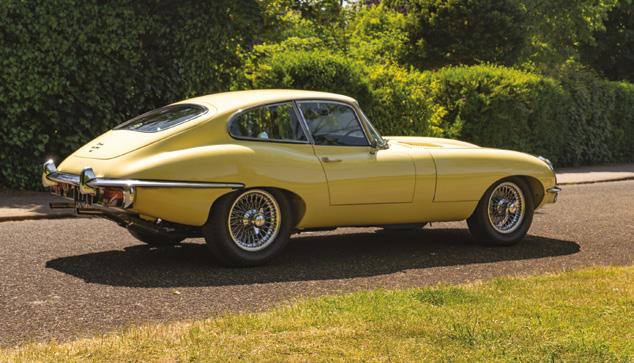
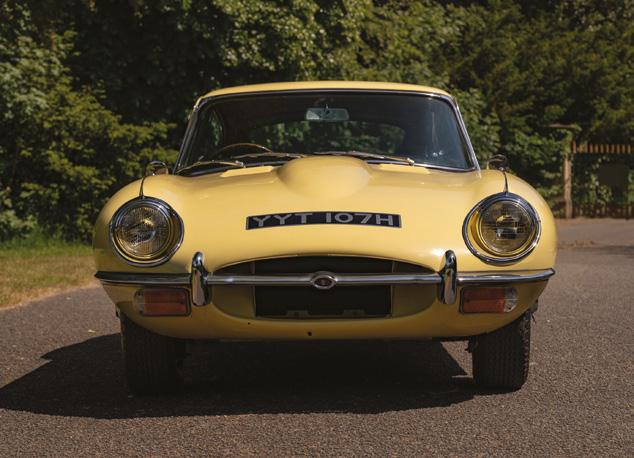
60 *All hammer prices are subject to a Buyer’s Premium of 12.5% plus VAT
44


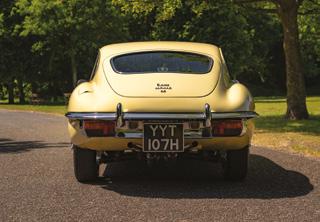
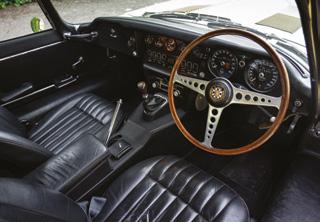
61
1963 Triumph TR4
Estimate: £20,000 - £24,000*
Reg
No: XSL 762 MOT: June 2024
Chassis No: CT23558L
Codenamed ‘Zest’, the TR4 was introduced in 1961 as a replacement for the TR3A. Though it was based on the chassis and drivetrain of its much-loved predecessor it cut a far more modern dash, thanks to an all new Michelotti-styled body. Manufactured new in 1963, chassis number CT23558L was like many British sports cars of its time in that it was supplied new to the United States of America. Repatriated from the United States in 2001 by a car dealer to have restored for himself to use and enjoy, the TR4 was subsequently provided with a comprehensive bodywork and mechanical restoration, including conversion to right-hand drive guise. Finished in Old English White paintwork, the Triumph features complimentary Black with White piped interior upholstery (with Mazda MX-5 seats fitted, although the originals are accompanying and trimmed in the same colour combination) and Black weather gear comprising hood and full-length tonneau cover. Riding on chrome wire wheels with a wire spare, this TR4 has covered less than 4,000 miles since the full restoration.
After the completion of the restoration, the Triumph was retained by the first UK keeper until 2008, when it was purchased by the vendor. In his ownership ever since, the TR4 now displays a recorded and credible mileage of just over 71,700 miles. Only offered for sale now due to the completion of the vendor’s Stag restoration, the TR4 has more recently been supplied with an oil and filter service in 2022 and a fresh battery in 2023 in preparation for sale. ‘XSL 762’ started readily and ran well during our photography session and is offered with a history file that contains a large selection of invoices, numerous previous MOT certificates, past tax discs, a selection of restoration images, and a current V5C document. Well-maintained TR4s are great, usable British classics for anyone seeking a practical and stylish sports car, with this example ready for use this summer.

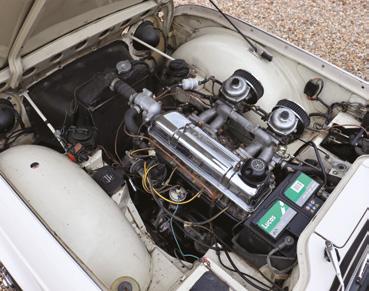
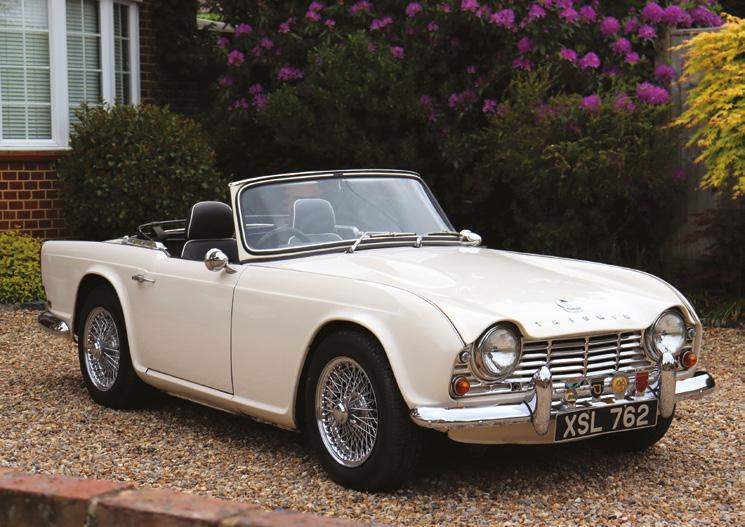
62 *All hammer prices are subject to a Buyer’s Premium of 12.5% plus VAT
45
1941 Buick Straight-8 ‘Fireball’ Special Sedan

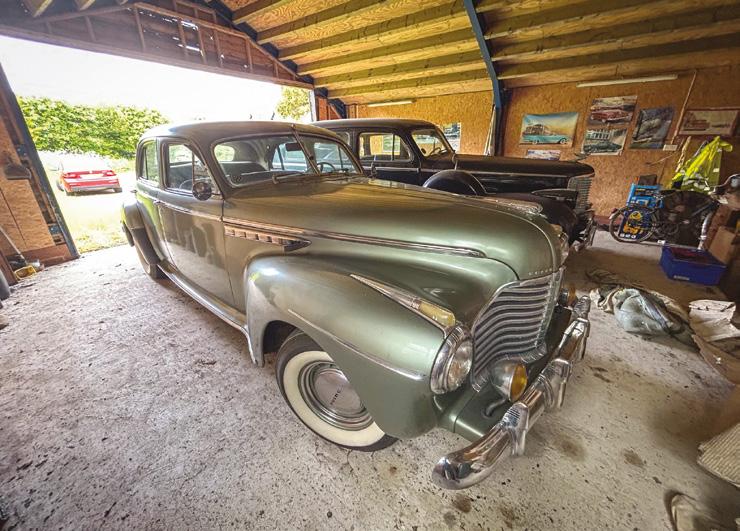
Estimate: £12,000 - £15,000*
Reg No: 101 XUG MOT: Exempt
Chassis No: 13918649
Formally the Buick Motor Division, Buick is an upscale brand of the American manufacturer General Motors. For much of its existence in the North American market, Buick has been marketed as a premium brand, selling luxury vehicles positioned above General Motor’s mainstream brands such as Chevrolet, while below the flagship luxury Cadillac division. Buick has the distinction of being the oldest active American marque of automobile, and was the company that established General Motor’s in 1908. The Buick Straight-8 engine (Fireball 8) was produced from 1931 to 1953 and sold in Buick models, replacing the Buick Straight-6 engine across the board in all models in 1931. Like many American automobile makers, Buick adopted the straight-8 engine in 1931 as a more powerful alternative to the previous engines.
This particular example was purchased by the vendor c.15 years ago from a private individual located in California. First registered in the UK in November, 2007 and presented in a lovely shade of Green with cloth interior, ‘101 XUG’ was subject to an engine overhaul in c.2017, along with a brake overhaul and replacement tyres. The car has seen little use, having been taken to a number of local shows along with over vehicles in the vendor’s private collection of American cars. Now offered for sale due to ill health, the vehicle comes accompanied with the current V5C document which displays 0 former keepers.
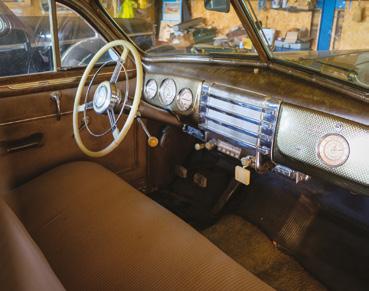
63 *All hammer prices are subject to a Buyer’s Premium of 12.5% plus VAT
46
1997 Jaguar XK8 Convertible
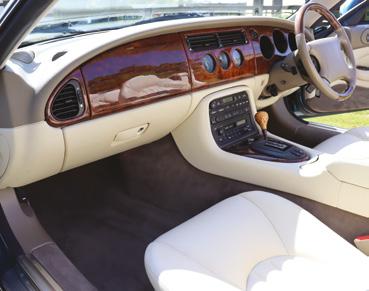


Estimate: £12,000 - £14,000*
Reg No: P760 NOO MOT: March 2024
Chassis No: SAJJGAFD3AR008781
Living up to expectations can be a burden. Consider the handsome Geoff Lawson-penned XK8 that followed in the wheel-tracks of such automotive icons as the XK120 and immortal E-type. Like the latter, it made its debut at the Geneva Salon - that of 1996 - and from launch was available in either Coupe or Convertible guise. Power came from a normally aspirated 4.0-litre version of the company’s DOHC V8 AJ26 engine.
Manufactured in 1997 and first registered in the UK on the 30th January that year, this XK8 Convertible is finished in Metallic Blue with a Beige leather interior and Black hood. Having covered only 46,204 miles at time of consignment and with just four keepers from new “P760 NOO” presents really well and appears to have been very well looked after. The accompanying service book contains nine stamps of which eight were by Jaguar main dealers, there are also invoices detailing work completed on each of the service visits. The last service according to the recent stamp in the book was carried out this year and just a few miles ago. The current MOT was only completed in March this year and shows no advisories. This impressive XK8 Convertible comes to sale with all tools, jack, spare wheel, original book pack including radio code card, two sets of keys, roof cover, service history and the V5C.
64 *All hammer prices are subject to a Buyer’s Premium of 12.5% plus VAT
47
1977 Triumph Stag
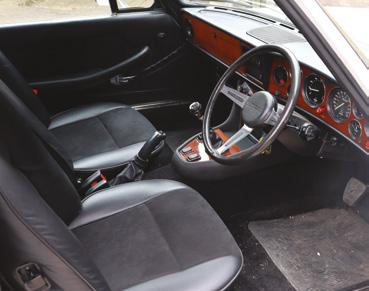
Estimate: £24,000 - £28,000*
Reg No: PSJ 986R MOT: April 2024
Chassis No: LD435810
Introduced in June 1970, the Triumph Stag was conceived as a luxury convertible sportscar to rival the likes of the R107-series Mercedes-Benz SL. As such, it came equipped with electric windows, power-assisted rack and pinion steering, and servo-backed disc / drum brakes as standard. Based around a two-door monocoque bodyshell (stylist Giovanni Michelotti had physically shortened a pre-production Triumph 2000 saloon in order to fashion the initial prototype), the newcomer featured all-round independent suspension (McPherson strut front / semi-trailing arm rear) and a well laid-out 2+2 cabin. Neatly integrated, the substantial roll-over hoop that joined the B-pillars gained extra strength from a T-bar link to the windscreen frame. With some 145bhp and 167lbft of torque on tap from its bespoke 2997cc SOHC V8 engine, the model was reputedly capable of 120mph. Available with a choice of four-speed manual or three-speed automatic transmission, all but the earliest Stags benefited from both hard and soft-top roofs. Despite being in production for seven years, during which time 25,877 cars were made, a mere 9,500 or so are thought to have survived.

With first registration on the 1st of April, 1977, today, this Stag displays just some 78,245 miles on the odometer. In recent times the Stag has also benefitted from some upgrading and restoration work. Mechanically, the car has benefitted from an overhaul of the engine with the addition of a sports manifold, a high-energy starter motor, Holly carburettor and a brake and gearbox overhaul. In addition, the car has benefitted from a coolant overflow tank, a new clutch and a new brake master cylinder. The subject of a 2-year restoration programme, the bodywork jobs were carried out on a rotisserie, as well as refurbishment of the wheels and new tyres and the hardtop. Inside, the Stag has been treated to a re-trim, with Alcantara utilised in parts, with new carpets. Offered with a collection of invoices and current V5c document.

65 *All
prices are subject to a Buyer’s Premium of 12.5% plus VAT
hammer
48
1990 Jaguar XJ-S V12 Convertible


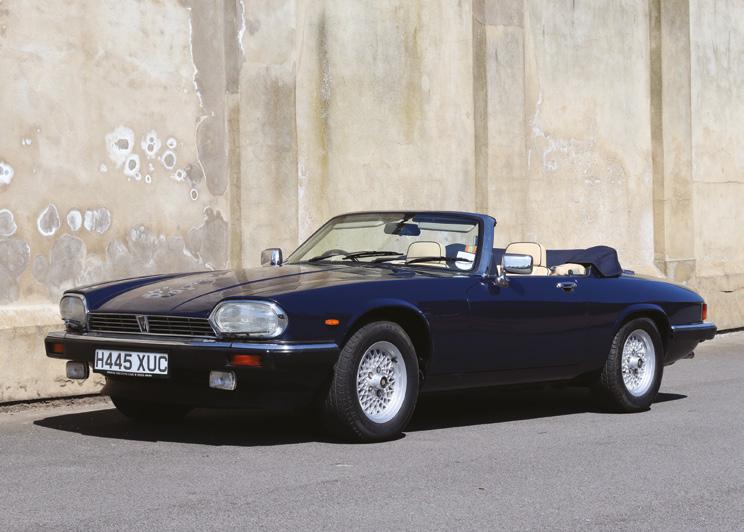
Estimate: £13,000 - £15,000*
Reg No: H445 XUC MOT: May 2024
Chassis No: SAJJNADW3DB174341
Launched in 1975, Jaguar’s XJ-S was designed to seamlessly blur borders rather than blast down back roads and so came with automatic transmission as standard. Though, when fed the quoted 295bhp and 318lbft of torque developed by a post 1981 H.E. (high efficiency) 5.3 litre V12 engine, this still resulted in a claimed top speed of 150mph and 0-60mph in less than eight seconds. Introduced at the 1988 Geneva Motor Show, the long awaited full convertible version featured a reinforced floorpan, frameless doors and sophisticated electric hood. Underpinned by the same all-round independent coil-sprung suspension and power assisted rack and pinion steering as its fixed head coupe siblings, the soft-top came with anti-lock brakes as standard. Priced at some £40,000, a waiting list was quick to form.
Finished in the handsome combination of Westminster Blue with Magnolia leather upholstery and a Black hood, ‘H445 XUC’ was dry stored for a dozen years or so up until 2022. Showing a modest 74,000 miles to its odometer, the Convertible underwent sympathetic recommissioning including an automatic gearbox overhaul before being returned to the road. Riding on correct-type lattice alloy wheels shod with Pirelli tyres, the Jaguar is accompanied by a V5C Registration Document (showing just three former keepers), handbook, jack, fresh MOT certificate and assorted paperwork.
66 *All hammer prices are subject to a Buyer’s Premium of 12.5% plus VAT
49
Lots 50 - 84
The Fast Road Sale

2003 BMW M3 Convertible

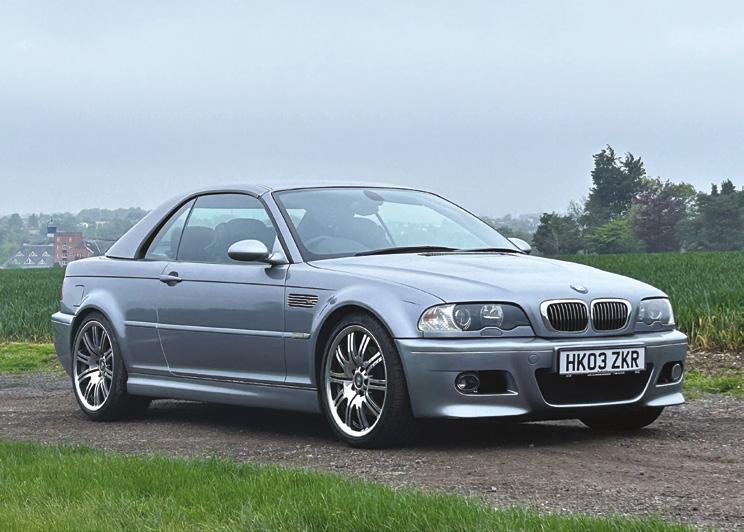
Estimate: £12,000 - £14,000*
Reg No: HK03 ZKR MOT: May 2024

Chassis No: WBSBR92090PM94181
Widely hailed as one of the best looking, best sounding and best handling BMW M3s yet made, the E46 generation debuted at the March 2000 Geneva Salon. Styled by Ulf Weidhase, the newcomer was a deft blend of aggression and subtlety. Available in Coupe or Convertible guises, the E46 M3 was powered by a 3.2 litre DOHC straight-six engine allied to Getrag six-speed manual transmission. Interestingly, the latter could be specified with either a conventional or electro-hydraulically actuated clutch. Dubbed ‘SMG-II’ when shorn of a third pedal, it proved to be the fastest shifting gearbox in the world. Credited with developing some 343bhp and 269lbft of torque, the compact four-seater was reputedly capable of 0-60mph in 5.3 seconds and 155mph (limited). As well as all-round independent suspension, four-wheel disc brakes and power steering, the nimble BMW boasted a sophisticated M Differential Lock and Traction Control. According to the M Registry, 13,052 Coupes and 7,234 Convertibles were built to RHD Euro-spec.
Finished in the striking combination of Silver Grey Metallic with a matching hardtop, Black leather upholstery and Black soft-top, this particular manual example was supplied new by Vines BMW of Guildford and first registered as ‘LK03 ZKR’ on 31st May 2003. The accompanying maintenance booklet contains eight stamps including one for the allimportant ‘Running-in Check’ at 1,280 miles, while the last ‘Inspection II’ service was carried out at 111,666 miles (circa 10,000 miles ago). Treated to new front discs / pads in November 2018, a cylinder head overhaul / VANOS system repair in March 2019, replacements steering rack / fourwheel alignment in February 2021 and new power steering pump / ABS sensor in April 2022, the past five years have seen some £4,500 spent on the M3. Starting readily upon inspection and running well, the Convertible rides on 19-inch alloy wheels and pleasingly retains its hardtop stand. The soft-top operates correctly and the ULEZ-compliant M3 presents nicely overall. Offered with V5C Registration Document, book pack and sundry paperwork.
68 *All hammer prices are subject to a Buyer’s Premium of 12.5% plus VAT
50
1973 Chevrolet Corvette Stingray Convertible

Estimate: £26,000 - £30,000*
Reg No: YND 603L MOT: Exempt Chassis No: 1Z67J3S401843
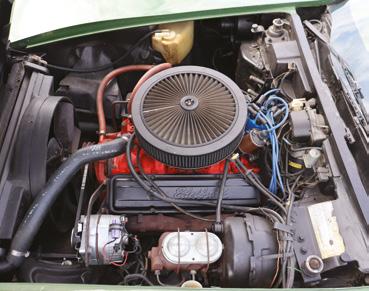
Introduced three years after Chevrolet’s wonderfully dramatic 1965 Mako Shark II show car, the so-called ‘C3’ Corvette borrowed heavily from its design exercise sibling’s ‘coke bottle’ silhouette. Underpinned by a perimeter frame chassis, the newcomer’s beautifully moulded fibreglass skin wore slimline chrome bumpers. With even the mildest of its ‘small block’ V8 engines, the C3 was a predictably strong performer. Tested by Road & Track magazine the Corvette demolished opposition such as the 911 and E-Type in a straight line and in other handling tests. The convertibles are notably rarer than the coupe variant, with only some 7.5% of all C3 Corvettes being convertibles.
This 1973 Convertible Stingray is an example of the last model year that featured a chrome bumper, having changed to only at the rear chrome following the introduction of the 5-mph front impact bumper, and is the only model year car to feature one of each. Supplied new to the United States of America, chassis number 401843 is fitted with the 350cu ‘L82’ 5.7 Litre small block V8 engine with Rochester four-barrel carburettor, allied to the desirable four-speed manual transmission. Finished in the striking colour combination of Elkhart Green Metallic paintwork, pleasingly complemented by its original Mid-Saddle leather interior upholstery, the Corvette has recently been fitted with a new hood trimmed in White.
Featuring power steering and a rear luggage rack, the Corvette is fitted with the original Rally wheels with factory trim rings and hub caps, which are shod with new tyres. Imported into the United Kingdom in 2019, ‘YND 603L’ was purchased by the vendor that same year, with the C3 since being provided with a coil over front suspension conversion and a stainless Powerflow exhaust system. The vendor informs us that the vacuum system works perfectly, and the Corvette started and ran well during our photography session. Now showing a modest and credible (1)00,824 miles on the odometer (at the time of consignment), the Corvette is offered for sale with a current V5C document.
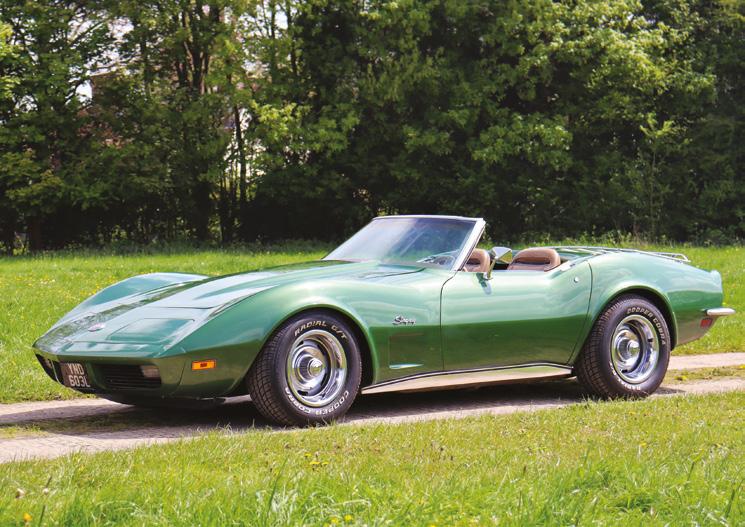
69 *All hammer prices are subject to a Buyer’s Premium of 12.5% plus VAT
51
1986 Ford Escort RS Turbo
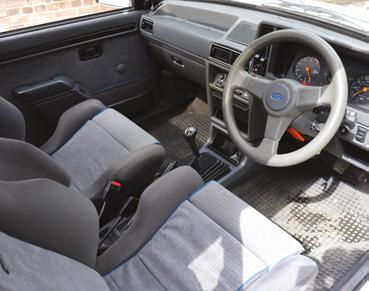

One owner and just c.37,000 miles from new

Estimate: £40,000 - £50,000*
Reg No: C262 DAH MOT: May 2024
Chassis No: WF0BXXGCABFK67631
A home-market, right-hand drive example, registration number ‘C262 DAH’ was ordered by the vendor, having been tasked by his mother with finding a White car. Browne & Sons of Loddon, Norfolk, the vendor approach them to acquire one. Not an approved RS dealership, Browne & Sons supplied the example offered in conjunction with Spruce Howlett Ford, Norwich, with two Ford Capris supplied in part exchange from the family. Finished in the iconic colour combination of Diamond White, matched to the Grey Recaro interior upholstery, the Escort has remained in the family business name its entire life and therefore showing zero former keepers.
Only used locally during the vendor’s mother’s time, and never in poor weather, the Escort is understood to have never left Norfolk since acquisition and has always been stored under cover. Giving up driving in 2005, ‘C262 DAH’ was placed into storage until it was unearthed in 2012 by the vendor following his mother’s passing. Recommissioned and MOT tested, the Ford has been used very sparingly since, covering less than 100 miles. Offered for sale now with just 37,175 miles from new (at the time of consignment), the Escort is an exceedingly original example with the vendor informing it retains all of its factory bodywork and paintwork. Pleasingly displaying plenty of other original features, such as its original stamped wings, unmolested engine bay, original dealer number plates front and rear, and dealer sticker.
Offered with a history file that contains the original Ford motorists guide, operating guide, service book (showing several stamps), assorted original sales literature, the aforementioned letter from the supplying dealers Browne & Sons to the vendor’s mother, a few previous MOTs certificates, copies of older logbooks, a couple of tax discs, a current V5C document. The Escort is supplied with a no advisory MOT certificate until May 2024 and is due to be serviced in time for sale. Highly original, low mileage, and one owner from new, this is one of those ‘find another’ and ‘not one to be missed’ offerings!
70 *All hammer prices are subject to a Buyer’s Premium of 12.5% plus VAT
52
2002 Mercedes-Benz C32 AMG Saloon
Built to the special order of six-time F1 winner Tony Brooks

Estimate: £12,000 - £14,000*
Reg No: LG02 FKR MOT: May 2024
Chassis No: WDC2030652RO35160
Launched in 2001, the Mercedes-Benz C32 AMG proved faster, rarer and subtler than the contemporary BMW M3 (E46). Comprehensively reworked by AMG, the newcomer’s 3.2 litre V6 featured a new crankshaft, conrods, pistons, lightweight camshafts and hardened valve springs. Force-fed via a twin-scroll IHI supercharger, the free-revving powerplant developed some 349bhp / 339lbft. The ride height was lowered by 30mm, the suspension stiffened and the brakes uprated, while the five-speed automatic transmission was recalibrated to shift thirty-five percent faster. Although limited to 155mph, Autocar found the super saloon capable of 0-60mph in 4.6 seconds (though, 180mph was rumoured to be possible if the relevant electrics were disabled). Just 326 C32 AMG Saloons are thought to have been supplied new to the UK.

The accompanying original invoice shows that the late Tony Brooks received a ‘special discount’ of some €9,000 when ordering chassis 035160 direct from the factory; a measure perhaps of the respect he still commanded some forty-one years after hanging up his helmet. Finished in Brilliant Silver with Anthracite leather upholstery, his special order C32 AMG boasted a sunroof, air-conditioning, Xenon headlights, heated windscreen washers, COMAND, ski bag, electric rear window blind and disabled speed limiter (making it rather more comfortable than the Mercedes Gullwing he had campaigned for Rob Walker in period). Main dealer maintained up until 82,414 miles, the last five services were carried out by marque specialist Star-Tec of Surrey with the most recent being at 118,601 (circa 1,500 miles ago). Obviously well cared for, the super saloon’s bodywork and paintwork belie its age and mileage. Lacking the flared wheelarches and more aggressive bodykits of subsequent AMGs, the C32’s electrifying performance is deliciously at odds with its understated looks. Retained by Mr Brooks until his death last year, the six-time F1 race winner remains the Mercedes-Benz’s only registered keeper. Surely one for the future given its rarity and provenance, ‘LG02 FKR’ is offered for sale with V5C Registration Document, book pack, MOT certificate, Internationaler Zulassungsschein and associated paperwork.

71 *All hammer prices are subject to a Buyer’s Premium of 12.5% plus VAT
53
2006 Porsche Cayman S
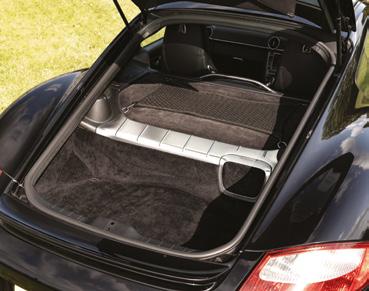
Estimate: £13,500 - £15,500*
Reg No: C8 AYM MOT: June 2024
Chassis No: WP0ZZZ98Z6U772650
Launched at the September 2005 Frankfurt Motor Show, the Cayman S was a brave move for Porsche on the basis that it delivered nigh-on 911 performance but in a more dynamically balanced / driver friendly package. Autocar magazine judged it Britain’s Best Driver’s Car of 2006 (beating a 911 Turbo into third place) and the mid-engined two-seater drew rave reviews worldwide. Possessing greater torsional rigidity than the Boxster convertible with which it shared a platform, the Fixed Head Coupe was able to utilise stiffer suspension and thus enjoyed even better handling / roadholding. Powered by a DOHC 3.4 litre ‘Flat Six’ engine allied to either six-speed manual or five-speed Tiptronic transmission, the Cayman S had some 291bhp/251lbft at its disposal and was reportedly capable of 0-60mph in 5.1 seconds and 171mph. Styling cues borrowed from Porsche’s back catalogue (356, 550 Coupe and 904 Coupe) helped with the aesthetics, while the ergonomically designed cabin was suitably driver orientated.

Finished in Basalt Black Metallic with Black leather upholstery, chassis 772650 was supplied new via the Porsche Centre Guildford on 21st February 2006. Featuring the more desirable six-speed manual gearbox, its impressive specification also encompassed DVD navigation package for Europe, air-conditioning, powerful Litronic headlights and heated seats. The accompanying maintenance booklet records services at 5.088, 16,392, 30,575, 42,675, 49,293, 58,914, 65,398 and 65,813 miles (the most recent being completed on 22nd February 2023). Previously retailed by marque specialist RPM Technik complete with a warranty, the two-seater was treated to new front coil springs, top mounts and bearings circa 10,000 miles ago and has also had its crossover coolant pipes replaced. Starting readily upon inspection, the Porsche is warranted to have covered some 66,000 miles from new. The appropriate ‘C8 AYM’ number plate is included along with the original book pack, sundry invoices and a fresh MOT certificate.

72 *All hammer prices are subject to a Buyer’s Premium of 12.5% plus VAT
54
2004 Subaru Impreza
WRX Turbo
Prodrive Performance Package
Estimate: £12,000 - £14,000*
Reg No: YT04 NEY MOT: February 2024
Chassis No: JF1GDAKD34G038636
Turbocharged versions of the 2.0 and 2.5-litre engines were offered in the WRX and WRX STI models. STI models featured a more powerful 2.0-litre turbocharged engine (c.265bhp). The Impreza (GD) model was offered new from 2003 until 2005, prior to the 2.5 litre iteration with 0-62mph in 5.9 seconds, a maximum top speed of 144 mph, the Impreza (GD) 2.0 WRX offered a 1994cc turbocharged engine with c.221bhp@5600rpm and a maximum torque of 300 Nm (221 lb.ft) at 4000 rpm from the 4 cylinder, 16 valve boxer engine with multi-point fuel injection, allied to a 5 speed gearbox and all-wheel drive. The Impreza (GD) provided handling via independent McPherson strut with coil springs. anti-roll bar front suspension and independent double wishbones and anti-roll bar rear suspension. For stopping power, the Impreza (GD) 2.0 WRX AWD braking system included vented discs at the front and vented discs at the rear.

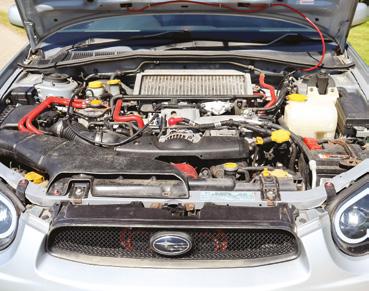
Here we have the iconic Subaru Impreza WRX Turbo (GD) ‘YT04 NEY’, which was supplied new in March of 2004 by “Bell & Coalville” and delivered to its first owner via “Prodrive” where it was treated to the legendary performance pack upgrade. The service history shows sixteen stamps in the book, the first seven of which are with the supplying Subaru dealership, the car presents well in Silver with Black leather interior and appears to have been well looked after. We are informed by our vendor that the car is believed to be as supplied, in standard specification with just the official “Prodrive Upgrade” and no further modifications. ‘YT04 NEY’ was also supplied new with the desirable and rare sunroof option. Records included in the history file show a new timing belt and water pump were fitted in 2020 at 127,946 miles and in 2022 a full service was carried out and new brake pads were fitted along with 4 new Michelin Sport tyres.

73 *All
prices are subject to a Buyer’s Premium of 12.5% plus VAT
hammer
55
2004 Bentley Continental GT

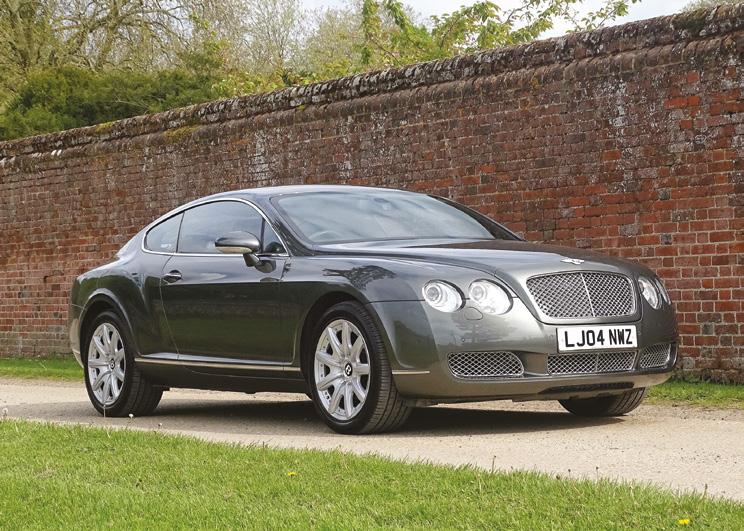
Warranted 43,500 miles from new
Estimate: £16,000 - £20,000*
Reg No: LJ04 NWZ MOT: April 2024
Chassis No: SCBCE63W44C021247
Introduced at the 2003 Geneva Salon, the Continental GT was the most technologically advanced Bentley in generations. Powered by the marque’s first all-new engine since 1959, its twin-turbocharged 5998cc W12 was allied to six-speed ZF Tiptronic transmission. With a quoted 552bhp and 479lbft of torque on tap plus Torsen-based permanent fourwheel drive, the 2+2-seater GT was reputedly capable of 0-60mph in 4.8 seconds and 198mph. A deft blend of muscularity and elegance, the two-door coupe’s lines were the work of Dirk Van Braekel. Equipped with sophisticated independent suspension and ventilated ABS disc brakes all-round, the Continental GT proved an accomplished transcontinental express. Responsible for broadening Bentley’s appeal in a way that no predecessor could match, the Continental GT’s future classic status is assured.
Finished in the handsome combination of Cypress Green Metallic with Pale Green leather upholstery, chassis 021247 was supplied new via Jack Barclay of Nine Elms, London. Purchased from P&A Wood by its last (third) registered keeper in 2012, the renowned marque specialist serviced ‘LJ04 NWZ’ at 39,910, 42,530, 42,623 and 43,019 miles (the last of these maintenance bouts cost £4,828.93 and included the fitment of four new tyres). Sparingly used thereafter, the Bentley was treated to a new battery earlier this year at 43,275 miles and passed its most recent MOT test with ‘no advisories’ on 28th April 2023. Starting readily and running well upon inspection, the Continental GT remains highly presentable (though, the nearside door mirror has discoloured). Offered for sale with V5C Registration Document, book pack, numerous P&A Wood invoices, MOT certificate valid until 27th April 2024, car cover and Bentley battery conditioner.

74 *All hammer prices are subject to a Buyer’s Premium of 12.5% plus VAT
56
2008 Lotus Europa S/SE Spec



Estimate: £24,000 - £28,000*
Reg No: FL57 GBX MOT: April 2024
Chassis No: SCCSC12157HN10916
The SE, launched in Geneva in 2008, was an upgraded model with more comfort in mind, intended to bring in more customers, The SE has the same engine as the S, however, it was modified to bring power to 225 PS and torque to 300 Nm, offering 0-60 in 4.9 seconds with a top speed of 146mph.
Upgraded from an S to an SE specification, this attractive and clean 2008 Europe S, presents as a very well-maintained example of the Europa. Finished in Storm Titanium Metallic over full Black & Grey leather Upgrades that have been added by the previous owners to bring this very special Europa up to the highly coveted SE Spec. It was in November 2008 the car returned to Lotus UK where the SE 225 enhanced engine upgrades were fitted along with the model’s cross-drilled brakes, since then Purbeck Sports Cars have continued to supply and fit the remaining SE enhancements including the correct springs and dampers, SE anti-roll bars, with Fondmetal 7800 SE Multi-spoke wheels with the interior also benefitting from the same treatment with the Luxury Touring Pack, the upgraded leather trim panels.
Having covered a mere c.22,821 miles currently. At 4,321 miles, the car’s speedo was replaced by Lotus Cars’ service department and therefore the car displays some 18,502 miles. The Europa possesses a comprehensive service history file that has been completed by Lotus main agents or a specialist. Purbeck Sports Cars carried out the latest service in 2021 at 17,000 miles, which is believed to have included a brake fluid change, spark plugs and a gearbox oil change. Additionally, the cambelt was also replaced by the same specialist 2 years prior, along with a major service including coolant and brake fluid, all in 2021.
Offered with two sets of keys, the Europa is accompanied by the original sales brochure, original ‘well-stamped’ service book and handbook. There is also a Blaupunkt instruction manual present. On file is the original letter from Lotus confirming the SE upgrades, a collection of invoices and old MOTs.
75 *All hammer prices are subject to a Buyer’s Premium of 12.5% plus VAT
57
1977 Ferrari 308 GTB ‘Vetroresina’
1 of just 154 UK-supplied examples
Estimate: £90,000 - £110,000*
Reg No: ROP 868R MOT: Exempt Chassis No: 20699
Introduced at the 1975 Paris Salon, the Ferrari 308 GTB was styled by Leonardo Fioravanti of Pininfarina whose other credits included the Dino, Daytona and Berlinetta Boxer. Based around a tubular spaceframe chassis equipped with independent doublewishbone suspension, four-wheel disc brakes and rack and pinion steering, the first 808 examples wore glass-reinforced plastic (or Vetroresina in Italian) bodywork which was some 150kg lighter than the cheaper-to-produce steel skin that supplanted it. Europeanspecification cars were fitted with a dry-sump version of Ferrari’s free-revving Tipo F106 AB 2.9-litre V8 engine, whereas those destined for America and Australia utilised a less powerful wet-sump unit (240bhp vs. 255bhp). Reputedly capable of 0-60mph in 6.7 seconds and 155mph, the Vetroresina represents the 308 GTB in its earliest and most desirable form. A real rarity, just 154 of the GRP-bodied projectiles were completed to UK RHD specification.
1 of only 154 right-hand drive dry sump UK cars ‘ROP 868R’ is a matching numbers car with 20699 chassis and engine numbers. Finished in Rosso Corsa with Nero hide, this 308 ‘Vetroresina’ displays some 38,400 credible miles on the odometer, with just 3 previous custodians on the logbook. Originally sold new to a Mr V. Pontenani in 1977, Mr Stuart Anderson acquired the car in February of 1986 before coming into the possession of Mr Andrew McGlone, who bought the car from Stuart in December 1997. It remained in storage until the vendor purchased the 308 in January of 2013. Subsequently, the car was placed into storage until 2016, at which point Foskers Limited, of Brands Hatch, was entrusted to restore and recommission the car over the prevailing 2 years, to the tune of nearly £30,000.

The work carried out by Foskers Limited in 2018, included: A full major service; Thermostat work; Fuel tank repairs; Exhaust manifold gaskets; An Oil cooler; An Oil pressure sender; Front screen trim; Hoses renewed, including coolant pipes; A/C overhauled; Brake overhaul; Replacement shock absorbers and springs; Rebushed suspension; Steering rack overhaul; Re-connollising of interior. Remaining in the care of Foskers Limited, in storage until 2021, the 308 was recommissioned at a further cost of c.£2,750.
The work carried out by Foskers Limited in 2021, included: An Annual service; Replacing brake fluid; Checking of the distributor, leads and plugs; Checking of the air box and carburettor jets; Checking and regrease of the front wheel bearings; Handbrake adjustment; Fluids.
Believed to have been fitted with ‘sprint cams’, this ‘Vetroresina’ possesses a very successful racing history, having competed in the Ferrari Maranello Challenge (roadgoing class) in the mid to late 1980s, with Stuart Anderson at the wheel. Only now awaiting a new custodian because the vendor has other cars he uses. With a collection of invoices dating back to 1981, there are invoices on file from Graypaul Motors Limited and Foskers Limited of Brands Hatch, Kent. There are also a number of old MOT certificates and the current V5C registration document.
76 *All hammer prices are subject to a Buyer’s Premium of 12.5% plus VAT
58

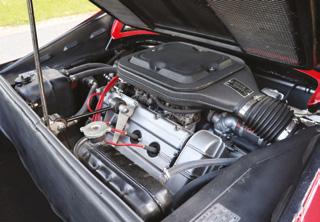
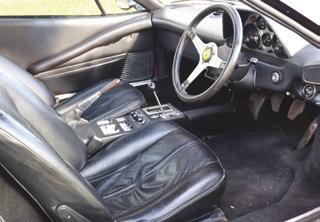
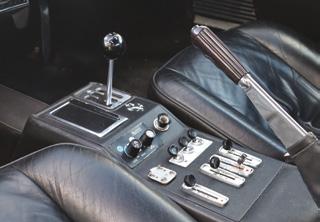
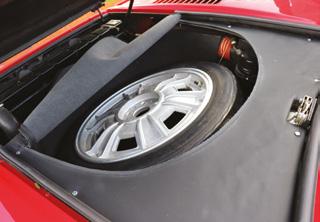
77


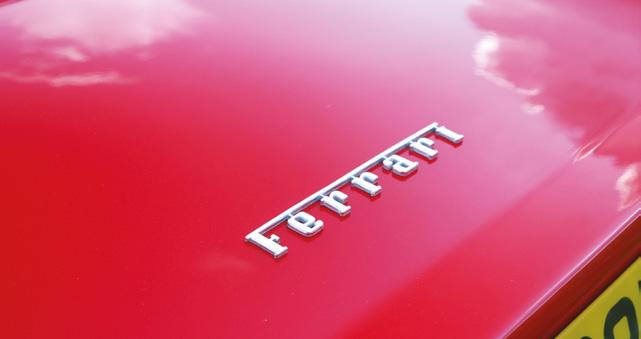
78
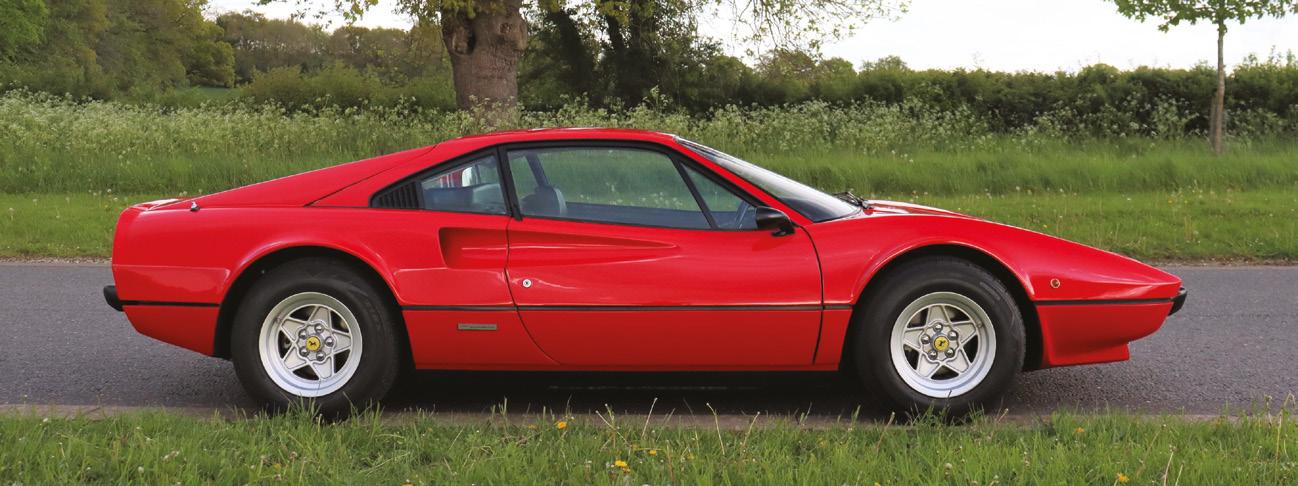

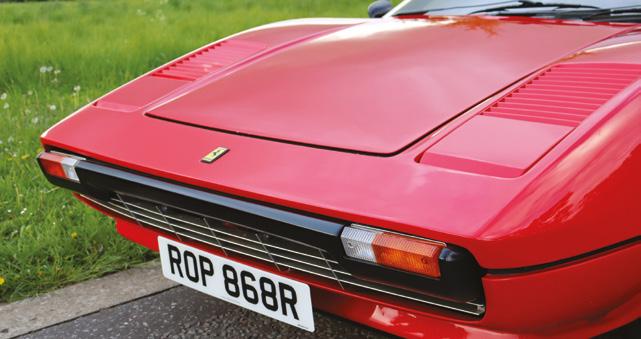
79
2006 LMP Engineering Can Am M1C
Estimate: £75,000 - £95,000*
Reg No: N/A MOT: N/A Chassis No: 1206-001
The last McLaren Group 7 / Can-Am design to utilise a spaceframe chassis rather than a monocoque one, the M1C debuted in 1967. Building on lessons learnt from the earlier M1 and M1B, the newcomer featured additional chassis bracing and improved aerodynamics including an adjustable rear wing. Fabricated from square- and round-section tubing and reinforced via sheet aluminium bulkheads bonded and riveted to it, the spaceframe was equipped with all-round independent double-wishbone suspension and four-wheel disc brakes. Capable of accommodating a variety of ‘small block’ V8 engines and transaxles (though, the proven Chevrolet / Hewland combination was the most popular choice), the M1C boasted an excellent power to weight ratio. The fibreglass bodywork incorporated numerous cooling ducts, while the main chassis tubes doubled-up as oil and coolant conduits. Despite being the best developed of the McLaren spaceframe Can-Am models, the M1C’s status as a ‘customer car’ ensured that its achievements were overshadowed by those of its predecessors. However, a limited period production run of 25 units means that demand has long outstripped supply.
Keen to prove the worth of the 3D-CAD hybrid modelling software, CAD/CAM production technologies, 3D-Tube laser cutting, 3D-machining and surface scanning techniques he had developed, Wolfgang Lange of LMP Engineering in Graefelfing, Bavaria decided to pay homage to the McLaren M1C by constructing an extremely accurate evocation. Loaned one of the original twenty-five cars for the project, he set about mimicking every aspect of its design using the (then) latest technologies. The result was the LMP Engineering Can Am M1C with the very first example – chassis 1206-001 – being the one offered here. The spaceframe chassis layout is the same (albeit with better / stronger welds on the German version) and bodywork is interchangeable. Indeed, the only major deviation we are aware of between a McLaren and LMP Engineering M1C concerns the brakes with the more modern machine using the largest discs that the hubs / wheels will permit.
Entering the current ownership in 2007, chassis 1206-001 immediately impressed with its build quality and authenticity. Reportedly ‘great fun to drive’, the M1C’s competitiveness took a palpable leap forward once Steve Hart of the renowned race preparation specialist stevehartracing.com was invited to share the helm. Between them the vendor and Hart achieved a string of impressive wins against Ford GT40 and Lola T70 opposition whilst racing in South Africa from 2016-2018 (the associated trophies and result sheets come with the car).
Powered by a 350 cu in Chevrolet V8 engine allied to a Hewland DG300 MKII transaxle (complete with five forward gears and reverse), the Can Am car is understood to develop a relatively unstressed 450bhp or so. Not fired-up since its last major refresh by Steve Hart which cost £25,000 at heavily discounted ‘co-driver rates’, chassis 126-001 would benefit from fresh rubber and a precautionary spanner check before being run in anger. Intriguingly, the seller was told that the rear bodywork clip, wing and some of the internal ducting are genuine McLaren / Elva components.
LMP Engineering morphed into Carl Coelln – Rennwagen Manufaktur during 2019 and continues to offer McLaren M1C, M6 and M8 Evocations. One of its customers, Walter Hoffmann, piloted his M1C to victory in the Jim Clark Revival race at last May’s Hockenheim Historics and has also accumulated silverware in the HistoCup and YTCC series running at Dijon, Salzburgring and Le Mans etc. The seller has not explored the possibility of obtaining a FIA Historic Technical Passport for chassis 1206-001 due to its oversize brakes but conjectures it should be possible subject to some re-engineering / modification. He informs us that in its current configuration the car is eligible for the UKbased, Bernie’s V8s race series. Offered for sale at a fraction of its build / development cost, this appealing M1C is accompanied by the aforementioned trophies, assorted paperwork and a small quantity of spares (gear ratios etc).

80 *All hammer prices are subject to a Buyer’s Premium of 12.5% plus VAT
59
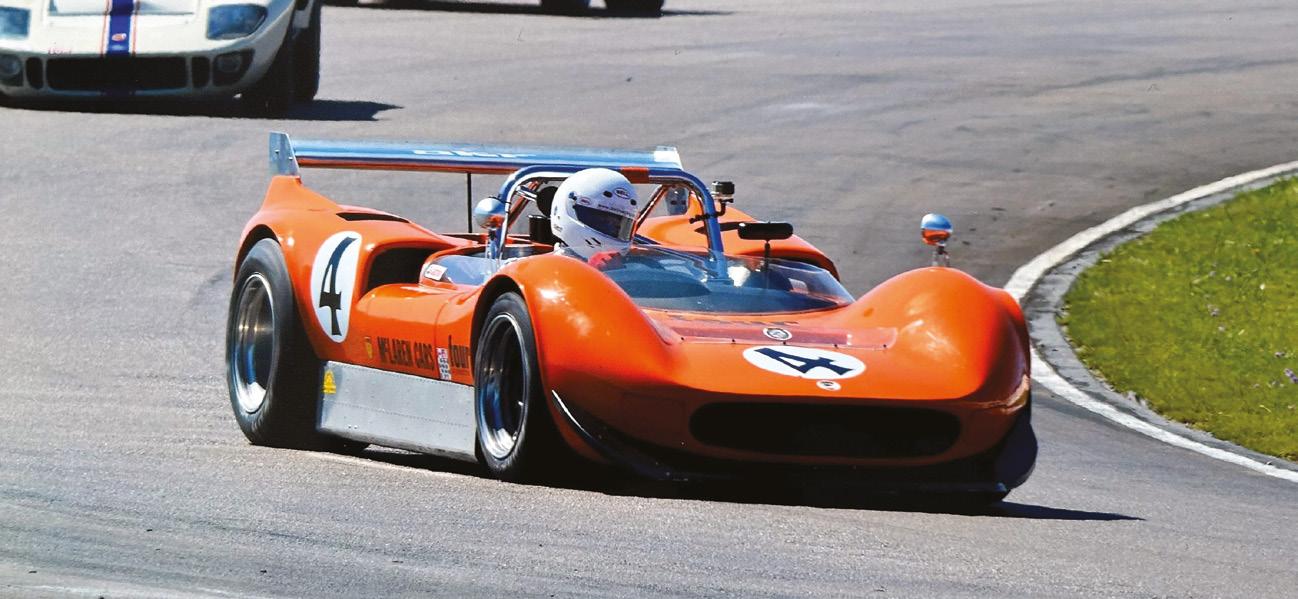
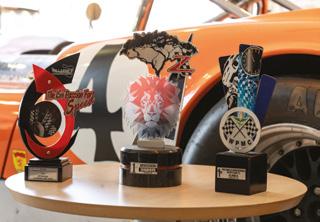



81
2008 Porsche 911 Carrera 2S Cabriolet
Warranted 44,700 miles from new
Estimate: £32,000 - £36,000*
Reg No: EX08 VKG MOT: May 2024 Chassis No: WP0ZZZ99Z8S771607
Introduced in 2004, the 997-series of Porsche’s iconic 911 allied all the technological improvements of its 996-series predecessor – a lighter / stiffer bodyshell, better suspension / brakes, four-valve cylinder heads and a superior HVAC system – to more classical styling. Available in Carrera or Carrera S guises when launched, the latter boasted a more powerful 3.8 litre engine (rated at 350bhp/295lbft), sports exhaust, Porsche Active Suspension Management (PASM) and 19-inch wheels as standard. Reputedly capable of 0-60mph in 4.6 seconds and 182mph, it soon became a driver’s favourite. Better built and better looking than a 996 and smaller and more agile than a 991 (or current 992), great examples of the 997 are becoming increasingly collectible.

Supplied new via the Porsche Centre Colchester, chassis 771607 was finished in Basalt Black Metallic with Black full leather upholstery and a Black soft-top. Riding on 19-inch Sport Design alloy wheels, its impressive specification also encompassed Tiptronic S transmission, DVD Navigation package for Europe, cruise control, air-conditioning and heated front seats. Predominantly main dealer maintained, the accompanying service book carries stamps at 8,268, 15,351, 22,924, 28,859, 36,346, 40,008 and 44,275 miles. Subject to a 111 point check when sold to S. Grayden Esq as an Approved PreOwned Porsche at 28,859 miles, ‘EX08 VKG’ was treated to a new windscreen, door window seals, full wheel alignment, major service and replacement brake discs / pads all round prior to delivery. Acquired by its last registered keeper on 23rd March 2021, the associated two-year warranty has not long expired. Passing its last MOT test on May 12th, 2023 with no advisories, this notably sharp, low mileage 997 C2S Cabriolet is worthy of close inspection. Offered for sale with V5C Registration Document, book pack, assorted invoices and Porsche presentation box.

82 *All hammer prices are subject to a Buyer’s Premium of 12.5% plus VAT
60

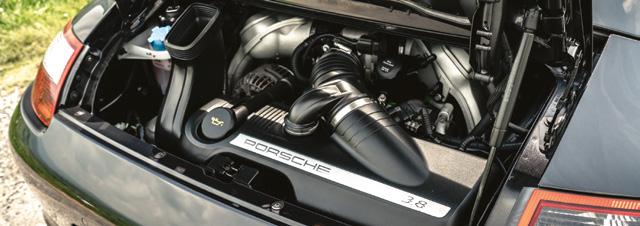


83
1985 Caterham Super Seven 1700 Super Sprint
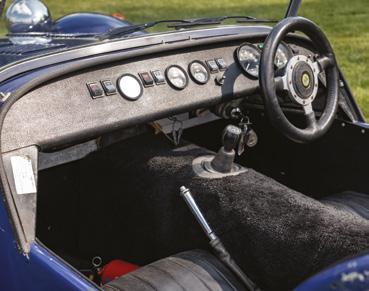

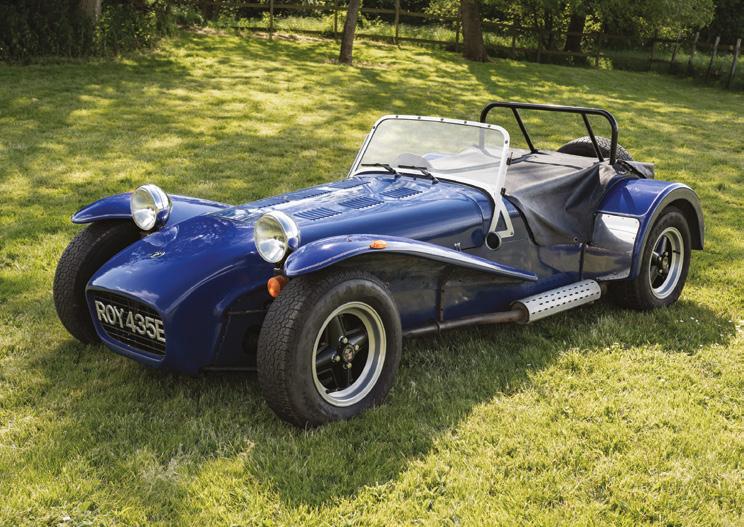
Estimate: £15,000 - £18,000*
Reg No: ROY 435E MOT: May 2024
Chassis No: KS30012R
Cliches abound when discussing Colin Chapman’s iconic Lotus Seven design but regardless of whether you consider it to be ‘a four-wheeled motorcycle’ or ‘a racing car for the road’, there is no denying that it offers one hell of a driving experience. Little wonder then that Caterham jumped at the chance to acquire the Seven’s production rights and tooling etc when Chapman decided to move Lotus upmarket in 1973. The first Caterham Sevens were nigh on indistinguishable from a Lotus Seven Series 3 and all the better for it.
The world was a very different place in the mid-1980s which goes some way towards explaining why this Super Seven was listed with the DVLA as a ‘Caterham Ford’ and given a date of first registration by them of 7th April 1967 despite being built in 1985! Of course, the fact that it looks just like a Lotus 7 Series 3 (headlights and wheels aside) doubtless helped. An accompanying invoice from Caterham Car Sales dated 4th May 1990 describes ‘ROY 435E’ as a ‘Caterham Super Seven 1700 Super Sprint’ and reveals that its last registered keeper paid £12,500 to acquire it. An old MOT certificate issued on March 19th 1990 records the mileage at 6,712, while one from four years later shows an increase to 16,105 miles. Seemingly little used over the past thirty years or so, the Caterham remains highly original. Never allowed to deteriorate to the point of needing restoration, its current odometer reading of circa 17,700 miles is believed but not warranted to represent the total covered from new. Recently recommissioned, the two-seater possesses a current MOT certificate valid until May 19th 2024. Considered by the vendor to be in ‘good’ (engine, bodywork, paintwork, electrical equipment, interior trim) or ‘very good’ (four-speed manual gearbox) overall condition, ‘ROY 435E’ has the benefit of full weather equipment. Offered for sale with V5C Registration Document, current MOT and sundry paperwork.
84 *All hammer prices are subject to a Buyer’s Premium of 12.5% plus VAT
61
1994 Chevrolet Corvette C4
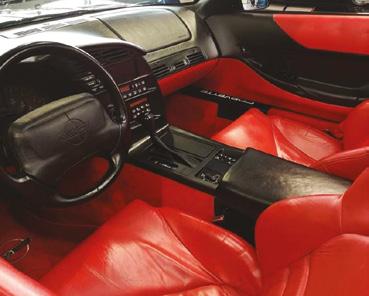

1 of just 80 factory examples for the Japanese market
Estimate: £15,000 - £18,000*
Reg No: L828 WYJ MOT: March 2024
Chassis No: 1G1YY22P5R5105918
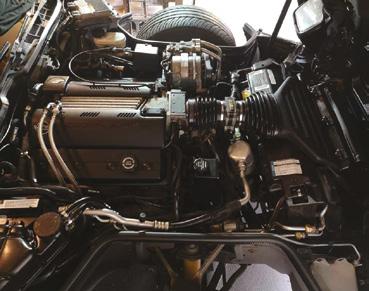
Manufactured new in 1994, the example offered is exceptionally rare being one of just 80 examples manufactured from factory direct for the Japanese market. The factory differences from American market cars included full arch extension, sidelights removed from the front and rear bumpers, rear license plate holder amendments, aerodynamic additions to the wing mirrors, fitment of side indicators, Japanese chassis sticker, and door shut stickers. Finished in Black paintwork with a Red leather interior upholstery and carpets, the ‘Vette is fitted with the 350cu inch 5.7-litre engine allied to the three-speed with overdrive automatic transmission. Imported into the United Kingdom in 2007, the Corvette has been in the ownership of the vendor since 2021 and is only offered for sale due to the purchase of a C6 Z06 Corvette and lack of storage. Offered for auction with a recorded mileage of just 64,628 miles on the odometer (at the time of consignment), ‘L828 WYJ’ was displayed at the Classic Corvette Club UK National Rally 2021 and won Best C4 Corvette with the trophy included with the sale. Accompanied by a history file that contains an original 1994 Sales Brochure, a 1994 Service Manual, a large collection of invoices, numerous previous MOT certificates, and both a current V5C document and copies of previous. The invoices on file document extensive work completed and parts supplied by Corvette specialists such Topcats Racing, EuroVettes, Eckler’s Corvette, Zip Corvettes, Claremont Corvette, and Grove Garage. Most recently benefitted from renewed ignition coil and distributor replacement in 2019 (costing over £1,500), belt and tensioner in 2021, and gearbox sensor in 2022, and has two sets of keys.
An exceedingly rare Corvette having supplied new to Japan (the carfriendly climate), the Corvette is rated by the vendor as ‘very good’ with regards to the interior, ‘very good to excellent’ in terms of paintwork, and as having ‘excellent’ bodywork, engine, electrical equipment and gearbox, this is surely a great American muscle car to acquire.
85 *All
prices are subject to a Buyer’s Premium of 12.5% plus VAT
hammer
62
1999 Jaguar XKR Coupe
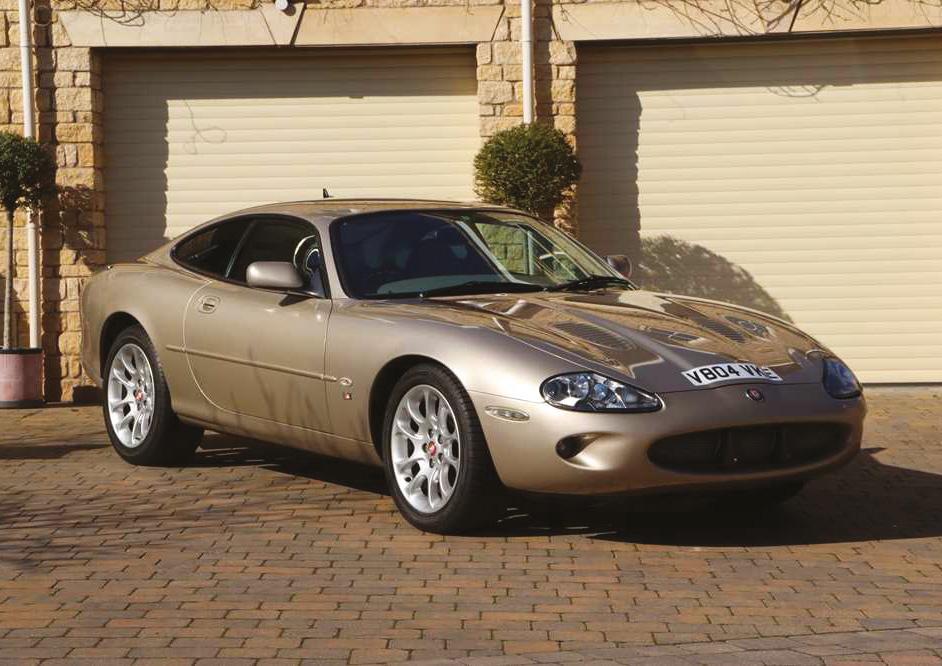
Estimate: £10,000 - £15,000*
Reg No: V804 VKE MOT: September 2023

Chassis No: SAJJGKEF3AR041488
H&H are indebted to the vendor for the following description:
The sleek-looking Jaguar XKR first broke cover at the 1996 Geneva Salon as a replacement for the ageing XJS. This 4.2 litre automatic example was imported new to Japan from the UK in 1999 by the HanYuu Auto Co Ltd, Ota, Japan (they are still JLR main dealers). Imported from the carfriendly climate of Japan in 2019, this pristine XKR has just one previous keeper in Japan and one recorded owner, the vendor, in the UK.
Finished in Topaz Metallic, the interior has complementing Cream leather with ‘wood trim’ features, heated seats, air conditioning and a Kenwood DAB radio unit. The original Jaguar FM/AM/LW radio comes with the car. Displaying just 45,791 km; equating to a very low c.28,500 miles. The binnacle dial face has been changed to a UK dial face and now reads MPH. The miles covered are still displayed electronically in kilometres on the odometer and matches MOT history where mileages have mostly been recorded in KM. The Japanese Export Certificate, supplied with the car, shows the km covered as 38,300 km (23,800 miles) at the time of export.
‘VKE’ was last serviced in 2020, at 26,755 miles, by N & S Auto Services, Independent Jaguar Specialists of Wakefield, benefiting from an oil change, water pump, new timing chains with new guides, plus the vendor has replaced rear suspension bushes, brake fluid automatic gearbox and differential oils. A totally rust-free example the paintwork and pristine wheel arches and underside bear witness to it’s salt free Japanese history and dry storage whilst in the UK. With an MOT into September of 2023, the XKR is offered with the owner’s wallet, handbook and service book, two keys a collection of invoices and the V5C.
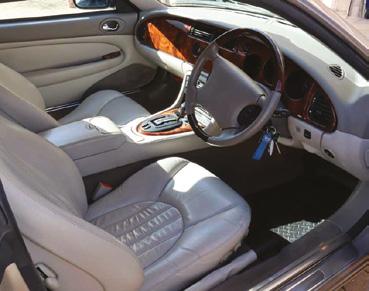
86 *All hammer prices are subject to a Buyer’s Premium of 12.5% plus VAT
63
2001 Maserati 3200 GT
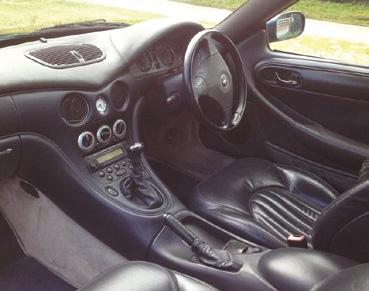

Estimate: £12,000 - £14,000*
Reg No: Y352 KBL MOT: February 2024
Chassis No: ZAMAA38D000003883
The Maserati 3200GT was styled by Italdesign whose founder and head, Giorgetto Giugiaro, previously designed, amongst others, the Ghibli, Bora and Merak and so it certainly had an impressive pedigree. Sold mainly in Europe, the 3200GT shared the twin-turbo, 3.2-litre, V8 featured in the Quattroporte IV and Shamal, now revised and tuned to 365bhp.The tail-light design consisted of LEDs arranged in the shape of a boomerang with the outer layer of the ‘boomerang’ providing the brake lights and the inner layer the directional indicators.
Manufactured in 2001, this 3200 GT was first registered in the United Kingdom on 1st of March that year and is powered by the aforementioned 3217cc V8 engine mated automatic transmission. Finished in the attractive colour scheme of Dark Blue with a Black leather interior, the GT has covered only c.70,100 miles from new. Having had just 5 former keepers and being in long term previous ownership, it has previously been maintained by the likes of McGrath Maserati and Colchester Maserati. Offered with a collection of old invoices and MOT certificates, we can see it has previously been fitted with a Tracker anti-theft device. The original book pack with handbook and the service book are also with the car plus the V5c document and is had a valid MOT certificate into February 2024.

87 *All hammer prices are subject to a Buyer’s Premium of 12.5% plus VAT
64
1979 Ferrari 400 GT
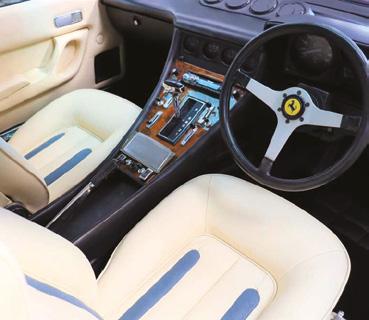
1 of only 123 UK-supplied examples
Estimate: £26,000 - £30,000*
Reg No: FJF 535V MOT: T.B.A
Chassis No: 27387
In the three-year production period, just 502 400 GTs were produced (with a mere 123 of which being supplied to the UK in right-hand-drive specification) before, in 1979, it was replaced by the fuel-injected 400i, which had identical styling, and finally, the 4943cc engined 412 then took the pedigree through until 1988. Manufactured new in 1979, the 400 GT offered is one of the United Kingdom supplied cars, being registered new here on the 11th of August 1979. Finished in Blue Monaco Metallic paintwork with Magnolia and Blue leather interior upholstery, ‘FJF 535V’ was specified from the factory with the automatic transmission. Acquired into the current private collection in 2004, the 400 covered just shy of 84,000 miles at the time of consignment and has covered less than 1,000 miles in the last thirteen years.

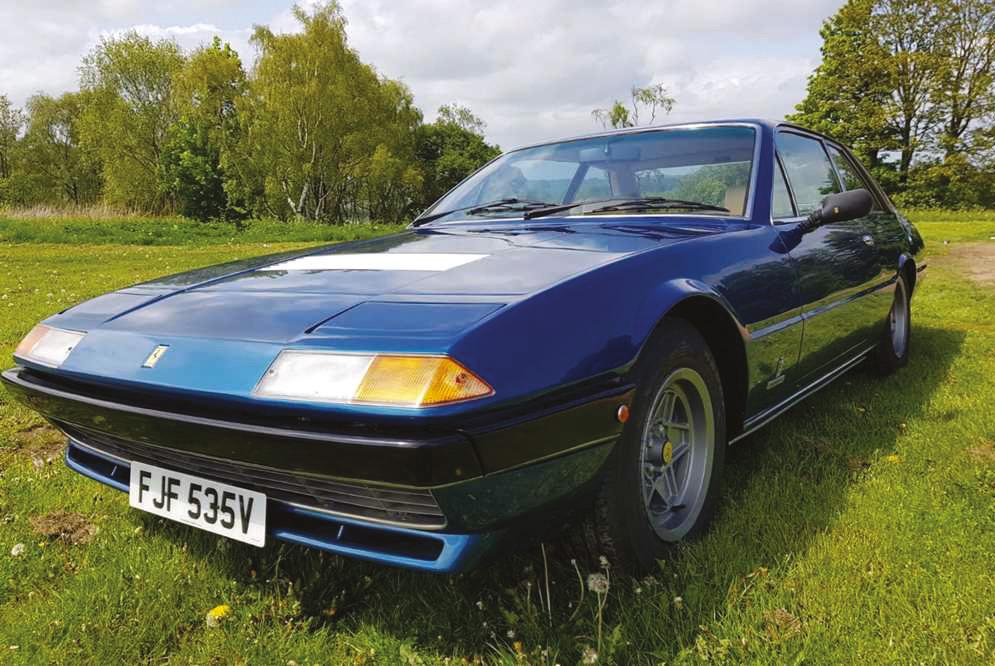
Lavished with a professional renovation over the last few years, the 400 has benefitted from a bare metal bodywork restoration and repaint; a mechanical renovation that comprised brake calipers renovated, carburettors soda blasted and overhauled, and new downpipes; a refreshed interior with the seats refurbished and the dashboard wood re-lacquered; and the alloy wheels have been fully refurbished and shod with new tyres.
Elegantly understated and seemingly great value, this Prancing Horse is due to be provided with a fresh MOT certificate in time for sale, the Ferrari is accompanied by over 100 images of the restoration work that has been completed. A very rare opportunity with only 123 UK-supplied, right-hand-drive 400 GTs produced, and with the example offered being a freshly renovated example that is rated as ‘very good’ in regard to engine, electrical equipment, gearbox, and interior trim, and ‘excellent’ regarding ‘bodywork’ and ‘paintwork’ by the vendor, it seems an appealing prospect.
88 *All hammer prices are subject to a Buyer’s Premium of 12.5% plus VAT
65
1976 Datsun 280 Z
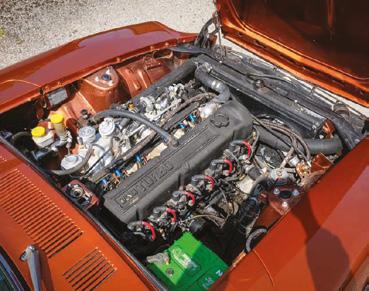
Estimate: £20,000 - £24,000*
Reg No: SSG 208P MOT: Exempt
Chassis No: HLS30294009
Renowned for its impressive performance and handling capabilities, the Datsun 280Z featured a 2.8-litre inline-six engine, known as the L28. Equipped with fuel injection, the L28 engine produced 170bhp through either a four-speed manual or an optional three-speed automatic gearbox, and independent front suspension and a rear semi-trailing arm setup resulted in responsive and agile handling. With balanced weight distribution and a low centre of gravity, the 280Z provided nimble and enjoyable driving dynamics. The presence of front disc brakes and rear drum brakes ensured reliable stopping power.
Manufactured in February 1976 for the US market, this particular 280Z is presented in a very attractive Orange Metallic, reportedly sampled from the Nissan R35 GTR. ‘SSG 208P’ was imported to the UK from Oman in 2022, where it was subject to a number of upgrades including uprated fuel injectors, coils and a Link (Atom II) ECU. An HKS induction kit and fuel rail have been installed along with a Sard fuel regulator and upgraded fuel pump. Dual electric fans are attached to a Greedy radiator and the car is fitted with an intercooler and oil catch tank. The suspension has also been uprated, as well as the exhaust system and the car benefits from a five-speed manual transmission and unusually, factory air conditioning which works well.
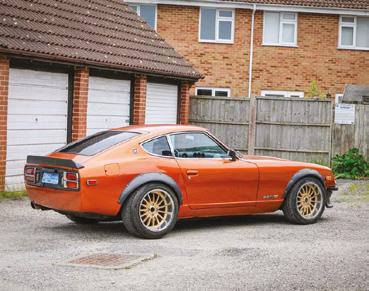
There is little paper history with the vehicle, as with many foreign imports, but a maintenance sticker on the door frame shows that the last service was carried out in Oman in January 2021 just 933km ago, at c.20,500km. Registered in the UK in March 2023, ‘SSG 208P’ displays 21,433km on the odometer and comes accompanied with the V5C document which displays ‘0’ former keepers.

89 *All hammer prices are subject to a Buyer’s Premium of 12.5% plus VAT
66
1986 Porsche 911 Carrera
3.2 Supersport
1 of just 34 RHD C16 specification examples
Estimate: £90,000 - £110,000*
Reg No: D460 DJU MOT: June 2024 Chassis No: WP0ZZZ91ZHS100586
For the increasing number of customers that coveted the Turbo’s distinctive ‘wide body’ look, but did not need its marginally superior performance, Porsche introduced the SSE package, also known as the Supersport, which could be specified for other models in the 911 range. The Supersport became a very successful model for Porsche even though this car cost over £10,000 extra compared to other models. These SSE cars were the most flexible and usable of all the Porsche models available in 1985 with the all alloy, flat-six engine, which had been fuel injected since 1971, being modified to become the 3164cc and producing an extremely torquey engine. One of the most notable advances in the development of Porsche’s long-running 911 was the introduction for 1984 of the 3.2-litre engine, which was 80% new and incorporated an effective cam chain tensioner and associated lubrication system that, at last, addressed a perennial 911 shortcoming. With 230bhp on tap, the new ‘boxer’ motor endowed the Carrera with a engaging level of performance: a 0-60mph time of 5.3 seconds and a top speed of 152mph. Although it enjoyed a 52hp advantage, the Turbo was only marginally faster, and most considered the normally aspirated Carrera easier to drive. All 3.2 litre Carreras had a redesigned engine inlet and exhaust system, along with the fitment of a service-free Digital Engine Management ignition system (DME) and high compression ratio of 10.3:1, the air-cooled 6-cylinder with Bosch L-Jetronic fuel metering which provided a significant increase in engine performance but a significant reduction in fuel consumption. The engine efficiency was thanks to the fuel cut-off when coasting. In addition to the wide body, the SSE (option code M491) included the Turbo’s spoilers; suspension; four-piston brake calipers; 16” forged alloy wheels; and low profile tyres. Despite adding considerably to the purchase price, the SSE package proved surprisingly popular, with almost 75,000 delivered worldwide between 1984 and 1989. Only 75 right-hand drive examples were delivered to the UK, with just 34 coupes, as offered here. The success of orders for the SSE led to the announcement in 1986 of Porsche to became the world’s first car manufacturer to establish a specialist department at the factory dedicated to tailoring cars to bespoke requirements.
Finished in Cassis Rot Metallic (paint code 80D), this 911 Supersport had been in current ownership since 2006 up until last year and shows just 5 former keepers on HPI. Displayed just a mere c.50,800 miles on the odometer the Supersport features some luxury features such as electric seats which are also heated, an electric sunroof and electric windows. Planting the 911 firm on the Tarmac are a set of split-rim alloy wheels fitted with Continental Sport 2 tyres just last year.
Offered with the original owner’s wallet, tool-kit, a collection of old tax discs and a large collection of old MOTs dating back to 1991 (at 36,767 miles). The vendor has described the car’s bodywork and paint, interior, engine, electrics and transmission as ‘excellent’ and ‘D460 DJU’ and is offered with a fresh MOT certificate.
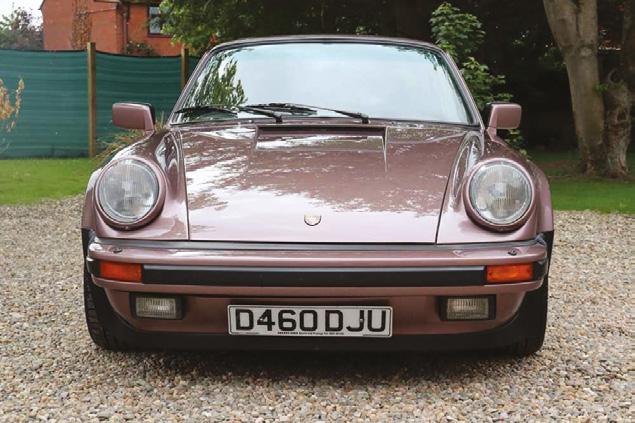
90 *All hammer prices are subject to a Buyer’s Premium of 12.5% plus VAT
67
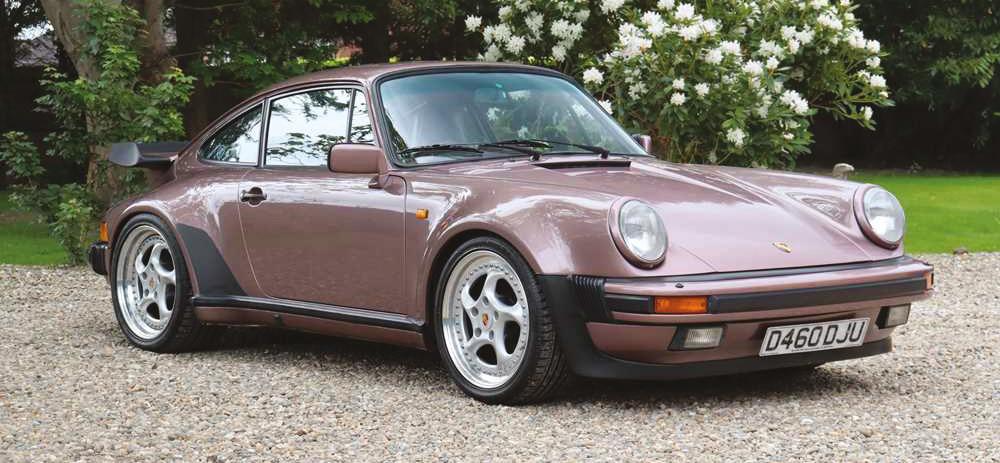
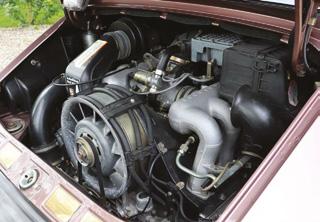



91


92

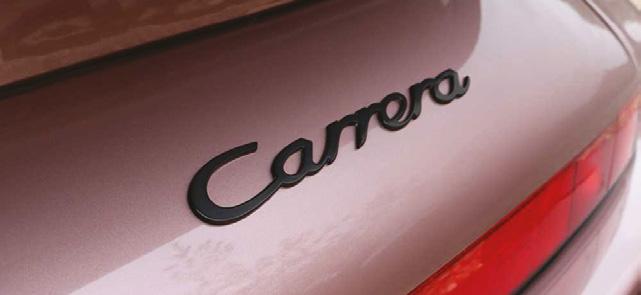
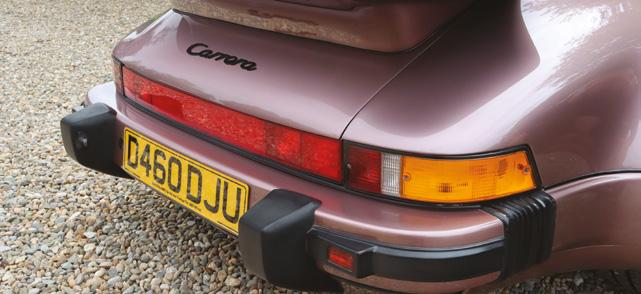
93
2004 Caterham Seven 1.6
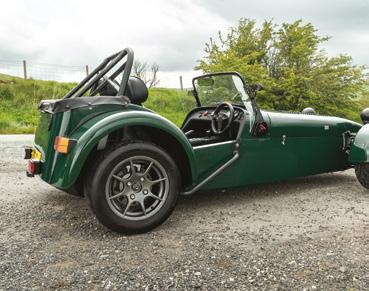

Estimate: £18,000 - £22,000*
Reg No: C7 SXC MOT: October 2023
Chassis No: SDKRDKRR630022768
Launched in 1957, the Lotus 7 was essentially a racing car for the road. Available in both fully assembled and kit forms, the two-seater was a simple but very effective design. Its elegant spaceframe chassis instantly transformed the dynamics of the most humdrum saloon car mechanical components. A giant killer in competition, the Seven was evolved through four series but as Chapman’s road car aspirations pushed upmarket so his enthusiasm for the low profit ‘kit car’ waned. However, by the time Lotus ceased production in 1971 a good number of its clients had become addicted to the little sports car. Among them was Lotus agent Caterham whose belief in the design saw them buy all the tooling, presses and dies for the Seven from Lotus in 1973. Settling upon the Series III as the best of the breed they restarted production that year and have yet to stop.
Finished in the classic combination of British Racing Green with Yellow striping and Black leather upholstery, chassis 22768 was supplied new to M. Johnson Esq of London. Rated at 120bhp, its 1.6 litre K-Series engine was allied to five-speed manual transmission. The accompanying maintenance booklet records services at 500, 4,301, 10,631, 15,782 and 22,369 miles. Since entrusted to Millwood Cotswold Caterham for a cambelt change, new starter motor plus some brake and suspension work on 6th September 2021 not to mention a further service on 31st October 2022, the two-seater’s odometer currently shows some 26,000 miles. Treated to a Z-and-F ECU Performance Tune Upgrade during 2012 which reputedly boosted its power output to 150bhp plus, the Caterham has also benefited from the installation of a FIA master switch, plumbedin fire extinguisher system, quick-release steering wheel, FIA double diagonal rollbar and competition brake pads. Riding on Avon semislick tyres, ‘C7 SXC’ is quite the adrenaline pump. Offered for sale with V5C Registration Document, book pack, assorted invoices and spare wheels / tyres.

94 *All hammer prices are subject to a
of 12.5% plus VAT
Buyer’s Premium
68
1974 Lotus Elan +2 130/5

Estimate: £15,000 - £18,000*
Reg No: NFR 688M MOT: Exempt
Chassis No: 73121897L
Progressively evolved, the ultimate +2 boasted a 130bhp, 1.6 litre ‘twincam’ engine and five-speed manual transmission. Of the 5,200 made, just 1,200 2+2-seater Elans are thought to have survived.
This UK market Lotus Elan +2 offered here, was built on 3rd January 1974 and supplied new by Hargreaves & Bailey of Blackpool to a Mrs. B.Y. Soper, being handed over to her on the 28” January 1974. Unusually, originally ordered in a single colour, Roman Purple Metallic (L21) with what we believe was an Oatmeal interior, the Lotus Certificate of Vehicle Provenance on file also confirms that the car was specified as the ultimate +2 specification with the ‘Big Valve’ engine and five-speed manual gearbox, which is still in the car, with the speedo displaying c.77,262 miles.
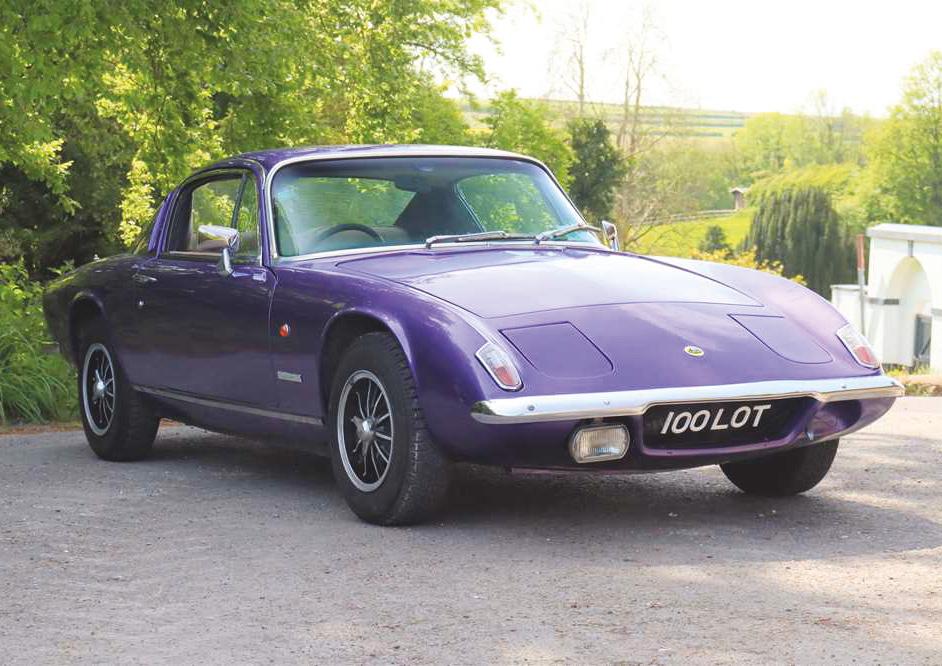
A letter from Mr Andy Graham at the Lotus Archives, dated 25th April 2016, states:
‘The VIN supplied for your Lotus Elan +2 was 73121897L which can be broken down into the build date (7312=1973, December)…...The original engine number was P/37656 which can be broken down into the model and market the engine was made for (P=Elan +2S 130 with big valves & high compression for the domestic market). The original body colour was all Roman Purple Metallic, Lotus paint code L21, while it was standard for the +2S 130 to have a Silver metal-flake roof, it is recorded your car had a body colour roof and many of the later +2S 130 models also had a body colour roof. The interior trim was not recorded; this was either black or oatmeal.’
Wearing ‘S130/5’ badges, representing the 130 engine with the 5-speed manual gearbox, the car has been in current ownership since 2017, it is believed the car has also spent some time in Italy. An older restoration the +2 is currently in need of recommissioning after a period of dry storage. Offered with a collection of invoices, this Elan +2 will require some recommissioning.
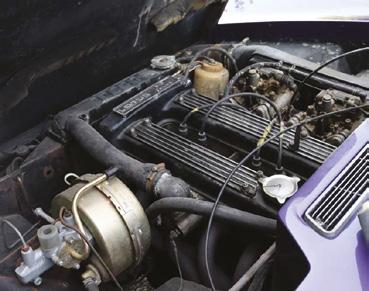
95 *All hammer prices are subject to a Buyer’s Premium of 12.5% plus VAT
69
2007 Porsche Cayman S

Special-order RS Orange paintwork

Estimate: £14,000 - £18,000*
Reg No: LA56 OYX MOT: WP0ZZZ98Z7U771899
Chassis No: August 2023
The Porsche 987 Cayman S was a two-seater sports car produced by Porsche AG from 2005 to 2012. Powered by a 3.4-litre flat-six engine, it delivered impressive performance with a maximum power output of 295 horsepower and 251 lb-ft of torque. The 987 Cayman S was available with a six-speed manual transmission or an optional five-speed Tiptronic S automatic transmission. Known for its exceptional handling, the midengine layout provided superb balance and agility on the road.
Now most 987 Caymans available are in Silvers, Greys, Blacks and Blues. Seldom does one become available in other colours and on offer today is a very rare opportunity to acquire one in a factory PTS colour. This particular Cayman S was ordered new in Paint-to-Sample 8C6 Orange, as used on the 997.1 GT3 RS. The interior, special order Cocoa leather benefited from the extended leather pack, heated seats and Porsche Communications Management system with satellite navigation. With optional 19’’ Carrera Classic wheels dressed in Michelin Pilot Sport 4S Tyres, the vehicle features the popular Tiptronic S gearbox and benefits from Cayman R exhaust tips; giving a much-improved tone over standard. The odometer currently displays 68,346 on the odometer at the time of consignment and in the hands of just 4 former keepers.
Now owned by a race engineer who looks after historic F1 cars, Historic GP cars and more, this rare example has been well looked after and is offered for sale due to the recent purchase of a Porsche Cayenne as a more comfortable everyday car. With an MOT valid until 30th August, 2023, accompanied with the vehicle are a collection of previous invoices for works undertaken. Included in these is one from January 2022 with EMC Engines Motorsport Engineers for NGK Platinum plugs and replacement coil pack. Also included with the vehicle are a small collection of previous MOTs, as well as the V5C document which displays 4 former keepers.

96 *All hammer prices are subject to a Buyer’s Premium of 12.5% plus VAT
70
1999 Jaguar XKR Convertible
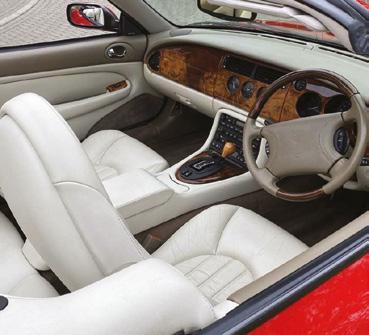
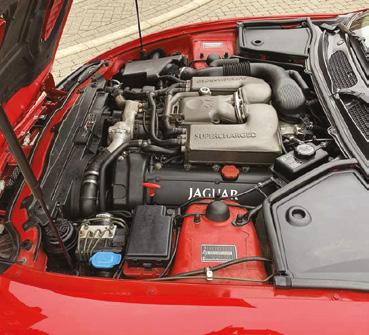
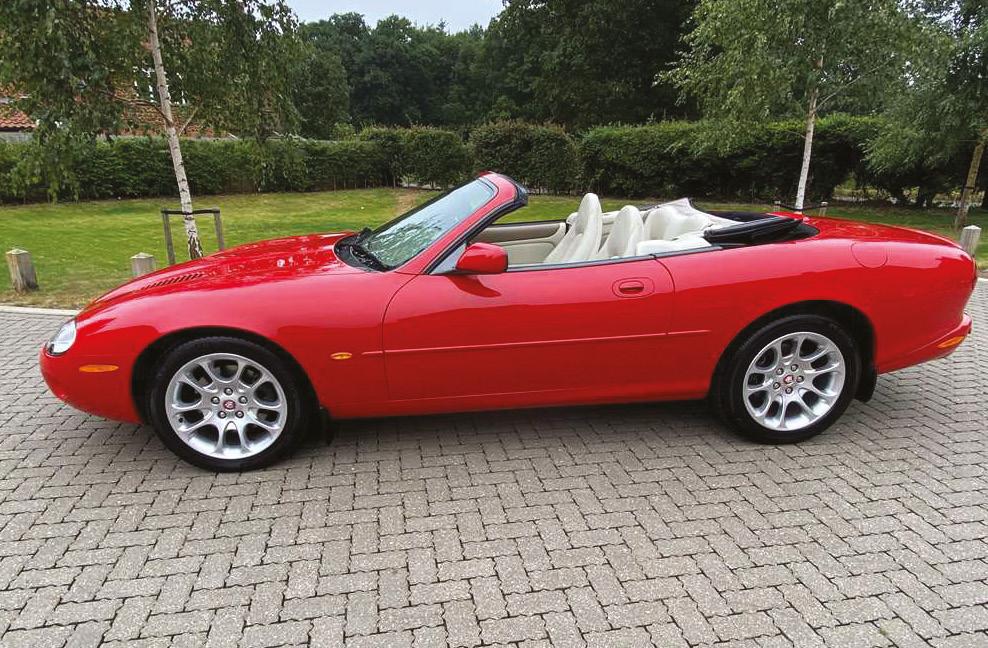
Only 24,000 miles from new
Estimate: £15,000 - £18,000*
Reg No: J4 EXR MOT: August 2023
Chassis No: SAJAC42J4YPA00759
The sleek-looking Jaguar XK8 first broke cover at the 1996 Geneva Salon as a replacement for the aging XJS. Designed in-house by Geoff Lawson, the newcomer (in common with the Aston Martin DB7) was based on a much-modified XJS platform - the changes to which included the adoption of XJ40-type independent rear suspension. The standard version of the XK8 was powered by a 290bhp normally-aspirated version of the company’s AJ26 V8 engine, and for those requiring more performance, Jaguar offered a supercharged version, the mighty XKR.
Manufactured new in 1999, the XKR offered was supplied to the United Kingdom and was first registered on the 9th of September that year. Fitted with the 3996cc Jaguar supercharged V8 engine with the fivespeed automatic transmission, ‘J4 EXR’ is finished in the eye-catching colour combination of Phoenix Red paintwork with Ivory leather interior upholstery and a Black hood. The vendor informs that he acquired the Jaguar from long-term family ownership, having been acquired into the family’s custodianship by the father, who owned a haulage company and had a collection of sports cars. The Jaguar was the only car from the collection retained by the family after his passing, being retained by a few different members of the family for a period of time. Covering just over a mere 24,100 miles from new (at the time of consignment), the XKR entered into the vendor’s ownership ten years ago.
Understood to have been garaged throughout its life, the Jaguar internal fabric cover and original safety kit are included in the sale along with the trickle charger. Recently benefitting from a new battery in 2022, the XKR is offered with documented service history, with the most recent services being completed at 23,026 and 19,510 miles. Only offered now by the vendor due to mobility issues following an accident, the XKR is described by the vendor as a lovely example and is due to be driven some 65 miles to Duxford.
97 *All hammer prices are subject to a Buyer’s Premium of 12.5% plus VAT
71
1978 Kougar Sport Jaguar
The oldest known surviving example in Europe
Estimate: £28,000 - £32,000*
Reg No: VRV 59 MOT: April 2024 Chassis No: 005/05-77RS
In the late 1970s, and Englishman named Rick Stevens set out to build a car of his own based on the legendary British sports cars of the early post-war era, such as Frazer Nash, Allard and H.R.G. These were, after all, the cars of his childhood but they were scarce, sometimes fragile, and likely more than he could afford. So, he decided to build his own version of the classic road-racer but using more modern components. Stevens paired up with the legendary engineers Dick Crosthwaite and John Gardiner (of the now iconic firm Crosthwaite & Gardiner) to design and build his dream sports car.

The 1970s was the age of the kit car, with any variety of cheap fiberglass likeness being built to sit atop a VW or some other similarly ubiquitous chassis, usually with extremely dubious results. There were dozens of manufacturers in the game offering conversions and full bodies to build any type of machine imaginable. Thankfully, Mr. Stevens opted to take a more traditional, British cottage-industry approach. With the help of his engineering consultants, he designed a tubular chassis which accepted the four-wheel independent suspension, four-wheel disc brakes and running gear from Jaguars. The Kougar, as it would become known, was immediately set apart from the sea of cheap kits thanks to its high-quality construction and sophisticated Jaguar running gear. In terms of styling, the body, cycle arches and distinctive radiator grille were inspired by the Frazer Nash Le Mans Replica of 1950, but given a more curvaceous look on the low-slung chassis. The Kougar had a cut-down cockpit with minimal weather protection and a business-like dash that featured a full array of Jaguar instrumentation. While some cars were offered in kit form, most were constructed at the works as this car was designed from the ground up for serial production and finished to a high standard. Today, they are classics in their own right, and a handful of lucky enthusiasts have been able to experience the thrill the Kougar Jaguar Sports can deliver.
Chassis number 005/05-77RS was the fifth Kougar Sports manufactured and was the first to be supplied new to the United Kingdom. Sold in ‘kit’ form and built by Peter Dalberg of Buxted Motors to feature in his showroom, it was initially registered ‘WYJ 976S’ before later being re-registered as ‘VRV 59’. The oldest known survivor to the owner’s club, the car was featured in the first Kougar Sports sales brochure. Fitted with a 4.2-litre Jaguar straight-six engine allied to four-speed manual transmission, the Jaguar donor car had covered some 54,000 miles while transferred into the Kougar in 1978.
The engine was subsequently fully overhauled and balanced in the late 1980s with a lightened flywheel and crankshaft, and another 20,000 miles covered in Kougar form since. Entering the vendors ownership in 1991, ‘VRV 59’ has had just three former keepers. Benefitting from extensive mechanical improvement recently, the Kougar’s engine was further refreshed, receiving a new oil pressure sender, plugs, points, and condenser, high-torque starter motor, overhauled carburettors, electric choke, cam-cover gaskets, water hoses, and flushing and servicing. New master and slave cylinders were fitted and the radiator re-cored. Treated also to new brake discs and pads, a full clutch kit, new Spax shock absorbers and ball joint rubbers, four new tyres and a fresh battery, the Kougar is due to be provided with a twelve MOT certificate in time for sale. Accompanied by a fitted car cover and tonneau cover, as well as a spare wheel which is stowed behind the seats, ‘VRV 59’ is supplied with a copy of ‘The History of Kougar Sports Cars’ by Amy Robbs and Paul Biggs, correspondence with the Kougar owners club, and a current V5C document.
98 *All hammer prices are subject to a Buyer’s Premium of 12.5% plus VAT
72
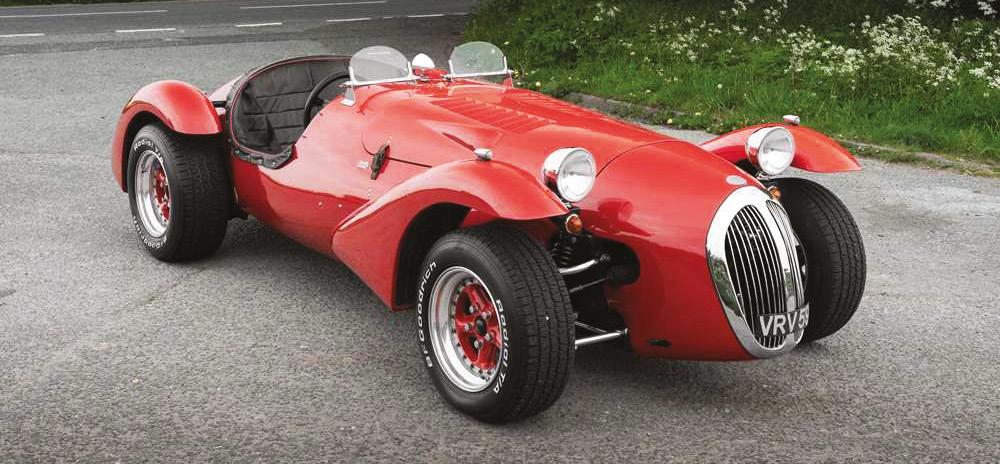
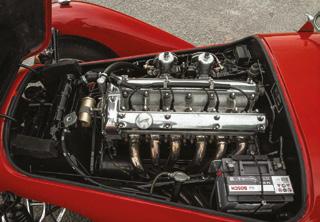

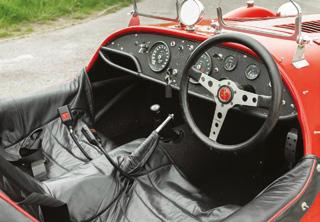
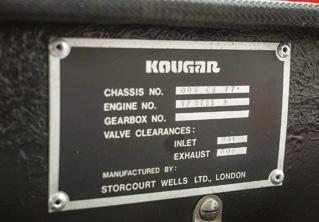
99
2001 Ford Puma S1600 ‘Works’ Rally Car
Ford Motor Company ‘Works’ rally car
Estimate: £60,000 - £80,000*
Reg No: X885 YOO MOT: None Chassis No: WF0BXXBZEB1Z29400
Super 1600 (or S1600) was a rally car formula that essentially underpinned the Junior World Rally Car Championship from 2001 – 2010. Entrants had to be two-wheel drive, powered by a naturally aspirated engine of no more than 1640cc and to have been produced in volumes exceeding 2,500 units. The most famous S1600 alumni was Sebastien Loeb who subsequently won the World Rally Championship nine times! Competing S1600 manufacturers included Citroen, Volkswagen, Renault, Suzuki, Fiat, MG and Ford. The latter based its contender on the Ford Racing Puma that was produced in conjunction with Tickford (the two firms having previously collaborated on the RS200) and which featured wider front / rear tracks, improved brakes, 17-inch alloy wheels and decidedly more muscular bodywork than the standard Puma.
Ford produced two versions of the Puma Rally Car, the S1400 which was sold to privateers and the S1600 that was (at least initially) reserved for Works drivers. The S1600 cars were modified and prepared at Boreham, the home of Ford’s Works Competition Department up until 2003. Bodyshells arriving at the former Essex airfield were fitted with full roll cages, altered to accommodate a larger radiator via a trick slam panel and given front anti-roll bar mounts. Powered by a reworked 1596cc DOHC all-alloy four-cylinder engine developing some 200bhp allied to Hewland six-speed sequential transmission, the enhanced Coupe’s impressive specification also included: a limited slip differential, adjustable suspension all-round (McPherson strut front / Ford Racing trailing arm beam rear) and uprated Alcon four-wheel disc brakes (ventilated front discs with 4-pot callipers and solid rear discs with 2-pot callipers). A 55-litre FIA ‘bag’ fuel tank was located under the rear floor, while the use of composite wheelarches and bumpers kept weight down to 880kg. Test driver duties for the S1600 development programme were undertaken by the legendary Stig Blomqvist.
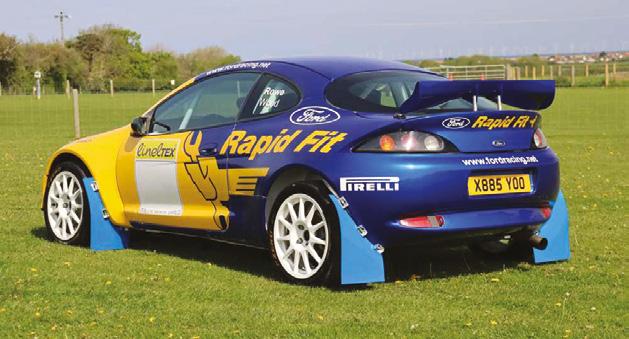
British drivers such as Kris Meeke and Guys Wilks both used the Puma during 2002, their first full season contesting the British Rally Championship, with the front-wheel drive Coupe helping to launch both men’s careers. It was, however, Francois Duval who delivered the Puma’s crowning glory with a Junior WRC win on the 2002 Monte Carlo Rally. By then Duval was signed to Malcolm Wilson’s ‘Works’ Ford team and his Puma programme was split through 2002 with a selection of outings in a Ford Focus RS WRC 02.
Presented here is a Puma S1600 Ford Motor Company ‘Works’ rally car which still sports its original registration number, ‘X885 YOO’. Following the Ford Motor Company’s initial custody, ‘X885 YOO’ then entered privateer ownership with Astra Racing in Spain before passing to a Belgian equipe. Retaining its original ‘Gold Book’ JWRC Passport, the Coupe has recently been granted a new MSA logbook which remains valid until April 5th 2033.
Active in competition since 2001, ‘X885 YOO’ has scored three victories from fifty starts namely the Rapid Fit Rally of Wirral 2001; Silverstone Rally 2001; and Formula Jim Clark Rally 2001, all achieved during its ‘Works’ career. The car’s last competitive rally activity in the UK was as a Ford Motor Company ‘Works’ entrant during May 2004 at the Bloodhound Stages, with previous drives in the Wales Rally GB, the Manx, Scottish and Pirelli rallies in 2003. Other significant participation has included the Acropolis, Catalunya and Monte Carlo Rallies. Its last competitive outing was on the 2019 Rallye de la Famenne.
The subject of a ‘bare shell’ refurbishment some five years ago, ‘X885 YOO’ has covered c.400km since its engine and gearbox were overhauled and some 150km since a rejuvenation of the original dynamic suspension. The Puma has benefitted from an oil and filter change in the last twelve months and comes complete with a data lead, homologation papers, parts list and a V5C. A rare opportunity to buy a Works built and Works campaigned Ford Rally Car from the latter days of Boreham.
100 *All hammer prices are subject to a Buyer’s Premium of 12.5% plus VAT
73



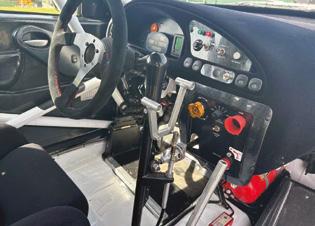
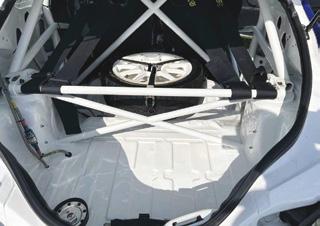
101
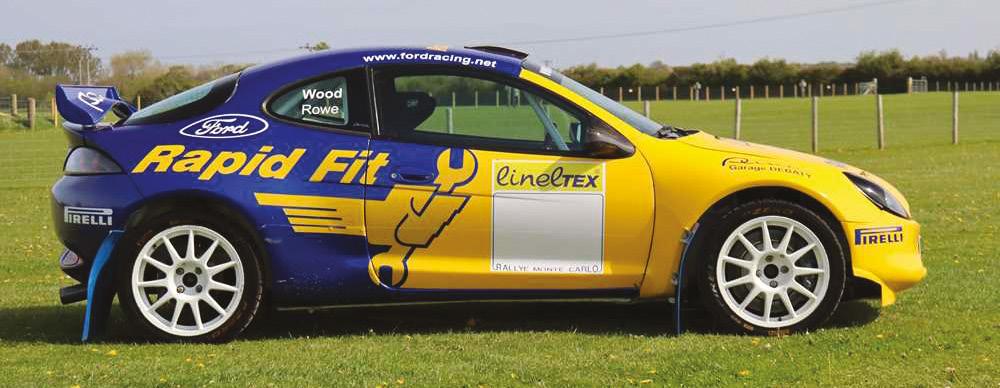

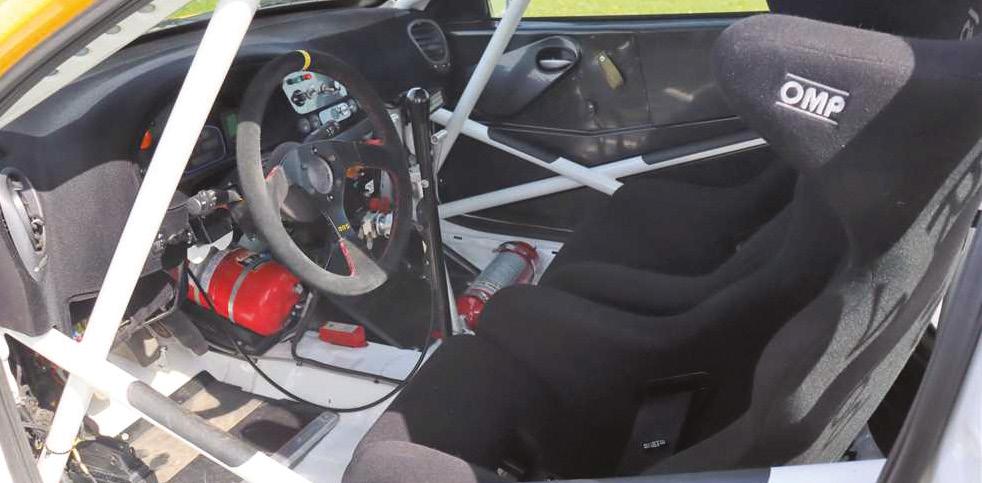
102

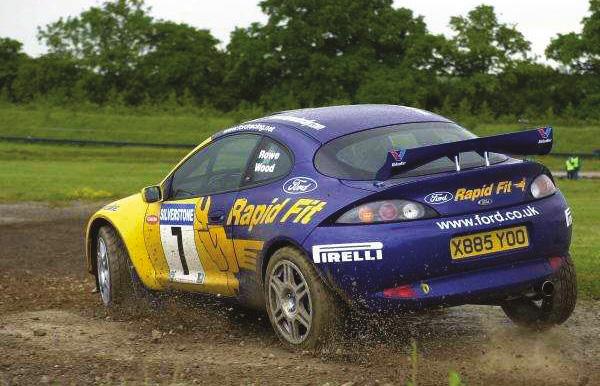

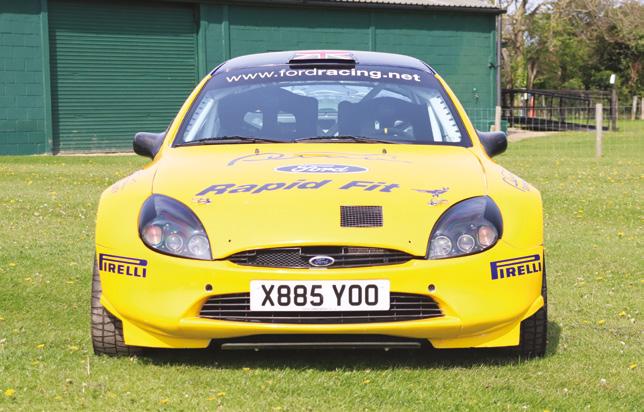
103
2006 Ferrari F430 Spider
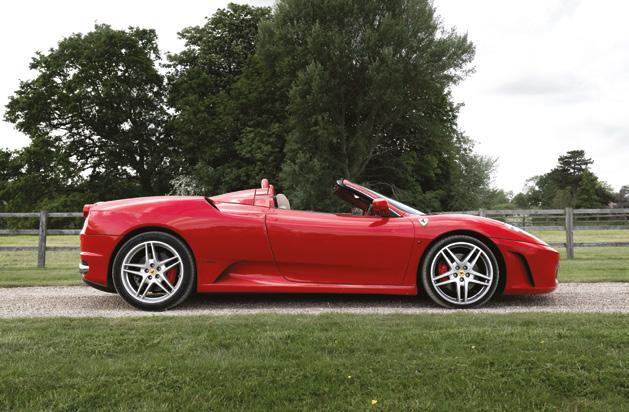
26,000 miles from new Estimate: £70,000 - £80,000*
Reg No: WDG 430 MOT: May 2024 Chassis No: ZFFEZ59C000145085
‘Here’s a milestone car. The F430 was the first no-buts Ferrari, the first Maranello product for which no excuses needed to be made. It was regarded by most critics as, if not perfect, as close to theoretical Ferrari road-car perfection as a Ferrari had ever been’ (John Simister, EVO magazine, March 12th 2013).
Unveiled at the Geneva Salon in March 2005, the F430 Spider was a modest 70kg heavier than its Berlinetta sibling. However, the structural strengthening this weight gain allowed meant that the newcomer was a dynamic match for its fixed roof stablemate under most circumstances (Richard Bremner commenting, in Autocar magazine, that he was only aware of any loss of rigidity perhaps one percent of the time). Styled by Pininfarina under the guidance of Frank Stephenson, the F430 Spider featured a reinforced windscreen and twin steel rollover hoops and could retract its fabric roof under an aluminium ‘double bubble’ tonneau cover in twenty seconds. The elliptical air intakes which dominated its nose recalled those of the Ferrari 156 ‘Sharknose’ F1 car, while its tail treatment echoed that of the marque’s revered Enzo hypercar. A flat underbody and highly effective rear diffuser generated real downforce as did the subtle but effective lip spoiler on the glazed engine cover. The F430 in both open and closed versions was the first modern Ferrari to feature an electronically controlled limited slip differential or ‘E-diff’ and a steering wheel-mounted ‘manettino’ switch. The latter enabled the driver to choose between five driving modes (altering the throttle, steering, damping and traction control settings etc in each instance). Derived from that of its F360 predecessor, the two-seater’s aluminium chassis boasted improved torsional stiffness and played host to all-round independent suspension, four-wheel vented disc brakes (complete with ABS) and power assisted rack and pinion steering. Displacing 4308cc, its ‘quad cam’, 32-valve V8 was quoted as developing 483bhp and 343lbft of torque. Allied to either manual or F1-style ‘paddle shift’ transmission (both six-speed), it enabled the F430 Spider to sprint from 0-60mph in 4.1 seconds and onto over 193mph. The engine was also an aural delight with distinct ‘key changes’ at 4,500rpm and 7,000rpm on the way to its 8,500rpm redline. Naturally, such throttle induced music was best enjoyed roof down aboard a Spider! Notable as the penultimate naturally-aspirated, V8 mid-engined Ferrari, and built in smaller numbers than its 458 successor, the F430 remains a ‘tour de force’ for any enthusiast driver.
Supplied new via JCT600 of Leeds to English Rose Hotels (Yorkshire) Ltd, chassis 145085 was initially finished in Bianco Fuji with Red interior accents (dashboard, door cards, centre console etc) and Beige leather seats. Briefly belonging to the premier league and Welsh International footballer Robbie Savage who was playing for Blackburn Rovers at the time, his choice of a F430 Spider was echoed by none other than Lionel Messi. Retained by Yorkshire businessman A. Hussain Esq from 2007 – 2017, the Ferrari was sold to its last registered keeper six years ago. The accompanying maintenance booklet reveals that the appropriately registered ‘WDG 430’ has been serviced at 1,889, 5,630, 6,637, 11,141, 13,024, 14,307, 18,009, 23,538 and 25,316 miles. The odometer currently shows a warranted 26,000 miles. Professionally repainted in a more typical shade of ‘Rosso Corsa’ at some stage, the two-seater has also had its soft-top renewed and the right-hand exhaust manifold repaired (a common F430 weakness). Offered for sale with V5C Registration Document, tool kit, air compressor, book pack and assorted invoices from Carrs Ferrari and Italia Autosport.
104 *All hammer prices are subject to a Buyer’s Premium of 12.5% plus VAT
74
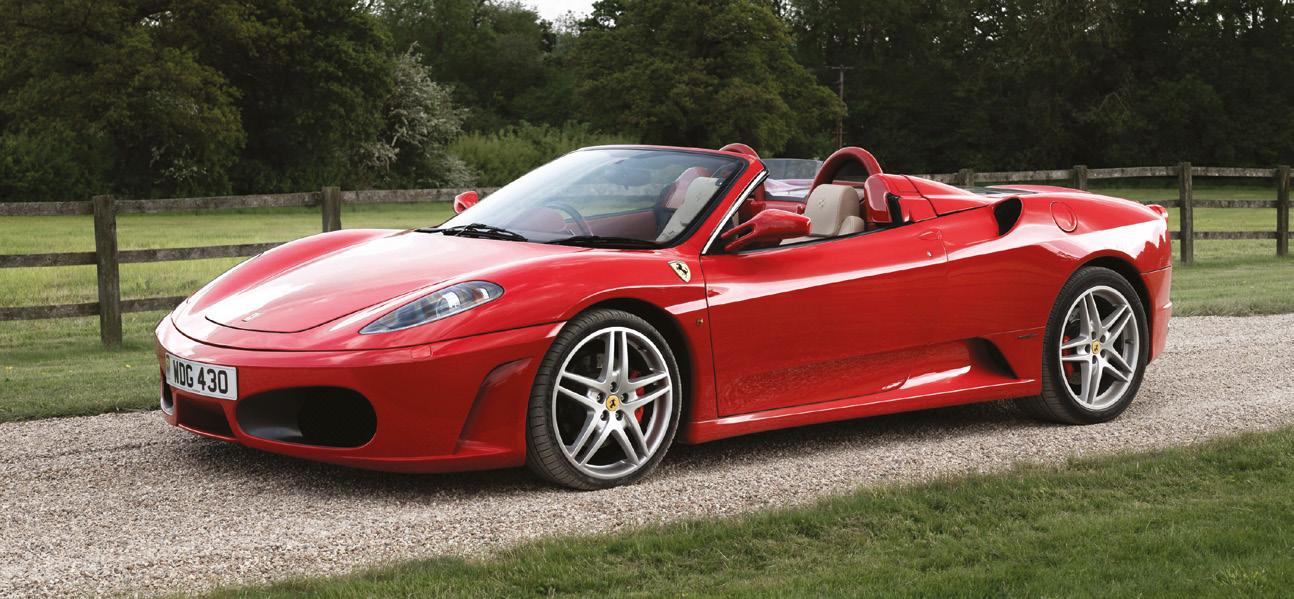



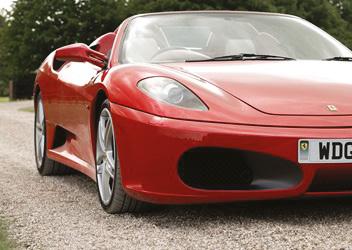
105
1999 TVR Cerbera 450

Estimate: £12,000 - £14,000*
Reg No: S322 VWB MOT: April 2024
Chassis No: SDLCB12A8WB002631
The Cerbera’s name is derived from Cerberus, the three-headed beast that was said to guard the entrance to Hades. Introduced in 1996, the model was the first Peter Wheeler-era TVR to feature the following: fixed head coachwork, 2+2-seating and in-house engines. Designed by race engineer Al Melling and inspired by contemporary Formula One practice, the new AJP8 ‘Speed Eight’ V8 initially displaced 4.2-litres but later grew to 4.5 and 4.7-litres (a 4-litre in-line ‘Speed Six’ derivative was subsequently offered too). A ferocious performer, the Cerbera 4.2 was reputedly capable of 0-60mph in 4.2 seconds and 180mph with its more powerful siblings proving faster still.
The TVR Cerbera offered here is finished in Plum Metallic paintwork with a Grey leather interior. Supplied new on the 23rd of December 1998, by TVR agents Hexham Horseless Carriages, this 450 example has servicing entries with them at 1190 miles (2/1999), 4116 miles (6/1999), 12092 miles (9/2000), 18202 miles (10/2001), 23766 miles (2/2004), 30198 miles (3/2005) and an entry stamp with an independent garage on the 36,000 miles service page. There is a file of receipts that displays some fettling of the car’s ‘brain’ with the ECU being replaced in 2015 at 37,118 miles. Powers Performance fitted the new MBE ECU along with a Dallas ECU chip with an invoice on file for some £800. Additional work around 2015 included the purchase of a Racetech Direct seat belt kit, a washer jet kit and a Pipercross performance air filter. There is also a £300 receipt on file for a TVR compatible Thatcham Cat 1 alarm system, along with sundry receipts that show the purchase of a battery, coil, horn and brake shoes among other items. More recently, a fuel filter was bought for the Cerbera in 2022. This Cerbera 450 is offered with the TVR owner’s handbook and integral service record. Currently displaying 37,200 miles and having 4 former keepers the TVR is offered with a current MOT certificate into April 2024.

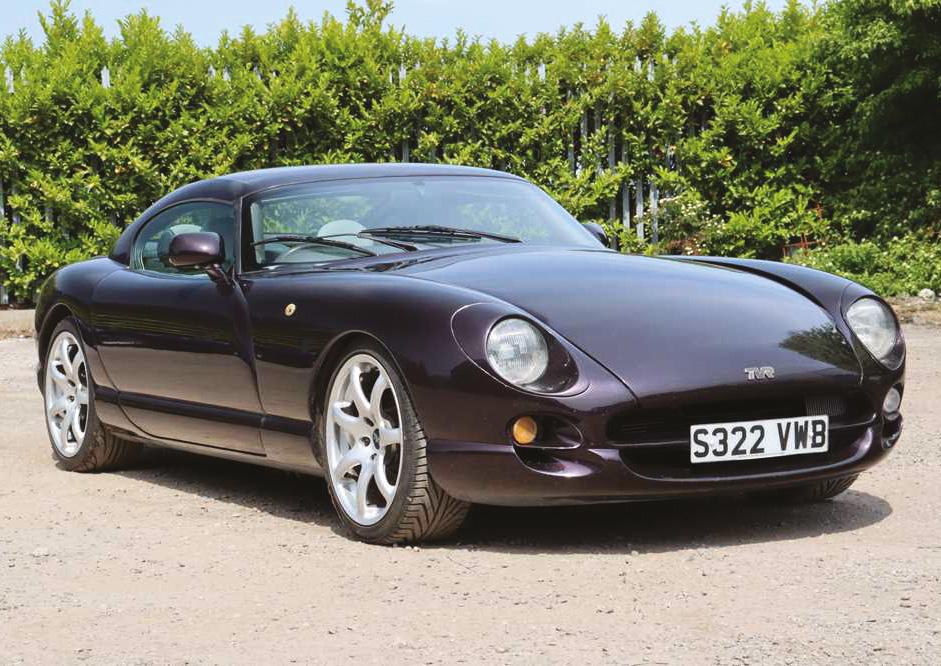
106 *All hammer prices are subject to a Buyer’s Premium of 12.5% plus VAT
75
2002 BMW Alpina B10 3.3

Estimate: £12,000 - £14,000*
Reg No: LB52 XAR
MOT: June 2024
Chassis No: WAPBA33L02YE47209
The Alpina B10 3.2, 3.3, V8 and V8S petrol-engined models were built in saloon and estate body styles based on the E39 from January 1997 to May 2004. The BMW Alpina B10 3.3 produced 276bhp @ 6,200bhp and 335Nm (247 lb ft) of torque @ 4,500rpm. Alpina only made 112 of the B10 3.3 saloon models worldwide, from a total E39 B10 production run of 472, split across six-cylinder and V8s, saloon and touring models.

Alpina really threw everything at this model. Unlike the earlier 3.2 version (which used a 528i engine as a base), for the 3.3 Alpina took the legendary S52B32 engine from the US-spec E36 M3, and then increased the stroke to up the capacity to 3.3 litres. It was then fitted with lightweight MAHLE pistons, with a ported and polished cylinder head, with a new crankshaft with torsional-vibration dampers and revised ECU software.
Believed to be 1 of 112 B10 3.3 saloon models worldwide, this example has had just 4 former keepers and covered 127,800 miles. This performance orientated ‘Beemer’ E39 offers a distinctive interior to match the distinctive powerplant, as you might expect from the Alpina division. The dashboard offers Orange on Blue dials, viewed behind the striking Red leather Alpina steering wheel and from Red heated leather seats with adjustable lumbar support, with plenty of Alpina logos to help the driver appreciate where they are.
This Alpina B10 3.3 is offered with the original owner’s wallet with handbook and service book with 15 entries plus two keys and a collection of old invoices and MOT certificates. Recently, the Alpina has recently benefitted from a new battery and a fuel pump and it is expected to have a fresh MOT at the time of the sale.
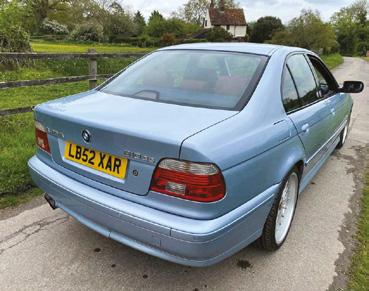
107 *All hammer prices are subject to a Buyer’s Premium of 12.5% plus VAT
76
1972 Lotus Elan Sprint


Drophead Coupe
Estimate: £30,000 - £35,000*
Reg No: SCW 631L MOT: Exempt
Chassis No: CV0275K
Brainchild of Lotus design and development engineer Ron Hickman, the Elan was introduced at the 1962 Earls Court Motor Show and promptly redefined its class in terms of ride, handling and performance. Arguably the ultimate Elan derivative, the Sprint arrived in February 1971. Characterised by its ‘Big Valve’ (126bhp / 113lbft) engine and bold colour schemes, the model was reputedly capable of 0-60mph in 6.7 seconds and 121mph. The Sprint was the final iteration of the Lotus Elan and was marketed between 1971 and 1973. Lotus always intended it to be a distinct model in its own right, rather than a ‘Series 5’, primarily for marketing purposes, however, the model was dropped by from the Lotus line-up in August of 1973, with the Sprint remaining keenly sought after by collectors and enthusiasts alike.
One of circa 856 Lotus Elan Sprint Drophead Coupes built, this example was built in April 1972 and originally supplied new to the USA and as such, is a US market car, ordered in Lotus Yellow (L07) over Cirrus White (L04) with the Talbot-Aztec Gold band. In more recent times the Sprint has been repatriated to the UK in 2014 and subsequently, it has been the subject of restoration and a repaint in 2015 at a cost of some £4,080. Thankfully, the Sprint still wears the attractive classic original shades of Lotus Yellow & Cirrus White with the Gold accent around the waistline with the typically Black vinyl interior, seats and door cards.
Additionally, in 2015 the Sprint was the subject of some work by RJ Motors of Bideford in Devon. They fitted a roll cage and overhauled the engine. The latter included replacing the water pump, main and big end bearings and polishing the crankshaft. The Sprint has also been fitted with a fast road clutch and a sports manifold. Offered with a collection of invoices from renowned Lotus specialists Paul Matty Sports Cars Limited and a Lotus Certificate of Vehicle Provenance.

108 *All hammer prices are subject to a Buyer’s Premium of 12.5% plus VAT
77
1967 Morris Mini Cooper S 1275


Estimate: £40,000 - £50,000*
Reg No: PAE 500F MOT: Exempt
Chassis No: K-A2S4/985641
Produced in the final year of the Mk1 Cooper S, the example offered was manufactured on the 8th of May, 1967. ‘PAE 500F’ was registered new in Bristol and specified from the factory with a ‘fresh air heater’ and a second fuel tank. Finished in Island Blue paintwork with an Old English White roof, with a complementary Cumulus Grey and Gold Brocade trim, a colour combination in which it is pleasingly finished to this day. The subject of a comprehensive restoration that was completed in 2013, with the original shell given an extensive refurbishment and repainting in the original colours. Mechanically, ‘PAE’ was extensively renovated with the engine and running gear overhauled. The interior has been completely refreshed, comprising new reclining front seats, the desirable long dashboard switches, and seatbelts.
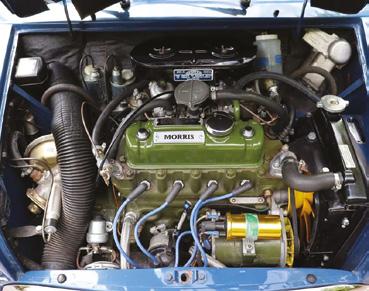
Acquired by the previous owner, shortly after restoration, the Morris was shown on the concours circuits, having success at a Garioch Vehicle Restoration Society event, winning the class and Best Car, as well as 2nd place at the Tayside Classic Car Show. Purchased by the vendor to enter his collection of Minis, Elfs, and Hornets in 2017, after searching for a 1967 Morris 1275 Cooper S, due to the famous win in the 1967 Monte Carlo Rally with Rauno Aaltonen. Boasting matching numbers, it’s been uprated with a stainless-steel exhaust system, K&N air filters, and rolling road tuning up to 84bhp, with the Morris covering under 1,300 miles since the restoration has been completed.
Both starting readily, and running and driving well to our photography session, this numbers matching, low-mileage since restoration Cooper S will make a marvellous addition to any Mini aficionado’s collection, and is sure to bring a smile to the new owner’s face whenever they get behind the wheel. Offered with a BMIHT Heritage Certificate, buff-style logbook, a CD of restoration images, a selection of previous MOTs and invoices, the concours winner’s certificate and rosette and the current V5C document.
109 *All hammer prices are subject to a Buyer’s Premium of 12.5% plus VAT
78
2007 Ferrari 612 Scaglietti
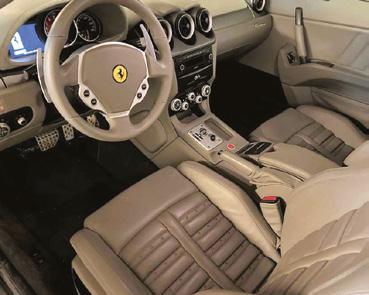

Estimate: £50,000 - £60,000*
Reg No: LM56 PXH MOT: April 2024
Chassis No: ZFFAY54B000149346
The Scaglietti 2+2 Coupe was penned by Frank Stephenson under Ken Okuyama at Pininfarina, and it is said that the design ideas, especially the strident side scallops and headlights, were a nod to the coach-built 1954 375 MM that film director Roberto Rossellini had commissioned for his wife Ingrid Bergan. The newcomer replaced the outgoing 456 but, being physically larger, was a genuine four-seat Grand Tourer. It was Ferrari’s second all-aluminium vehicle (the first being the 360 Modena) and comprised a spaceframe manufactured in concert with Alcoa, that was a combination of extrusions and castings to which the body was then welded. The same chassis formed the basis of Ferrari’s 599 GTB flagship Grand Tourer. The front mid-mounted V12 powerplant was shared with the 575 Superamerica and was not 6-litres as the name suggests but 5.7, though big enough for a healthy power output of 533bhp and equally impressive performance figures, including a 0-62mph time of 4.2 seconds and a top speed north of the magic 200mph. A total of 3,025 examples were manufactured between 2004 and 2011, all but 199 of which featured the F1A gearbox.
Offered here is a Ferrari 612 Scaglietti F1. It is understood to have been supplied new in Qatar, being supplied by Sports Motors Co. W.L.L of Doha, Qatar, on the 20th of December, 2006, with a Ferrari document on file confirming the supply of the 612. The 612 benefitted from an ‘annual service’ at HR Owen of Hatfield, in April 2023, at 14,427 miles. The service included which also included invoiced ‘parts’ such as brake fluid, oil filter and pollen filter, with a HR Owen receipt on file for the work carried out. Currently displaying 23,300 kms (c.14,500) miles the 612 Scaglietti is accompanied by the leather Ferrari owner’s wallet, handbook, service book and the tool-kit, as well as the V5C.

110 *All hammer prices are subject to a Buyer’s Premium of 12.5% plus VAT
79
2007 Mercedes-Benz CL600
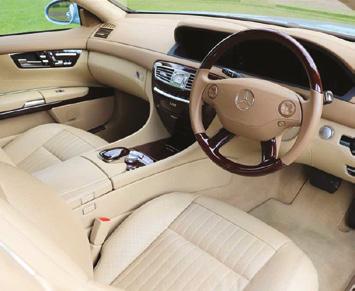
Under 21,000 miles from new
Estimate: £18,000 - £22,000*
Reg No: S600 XXX MOT: January 2024
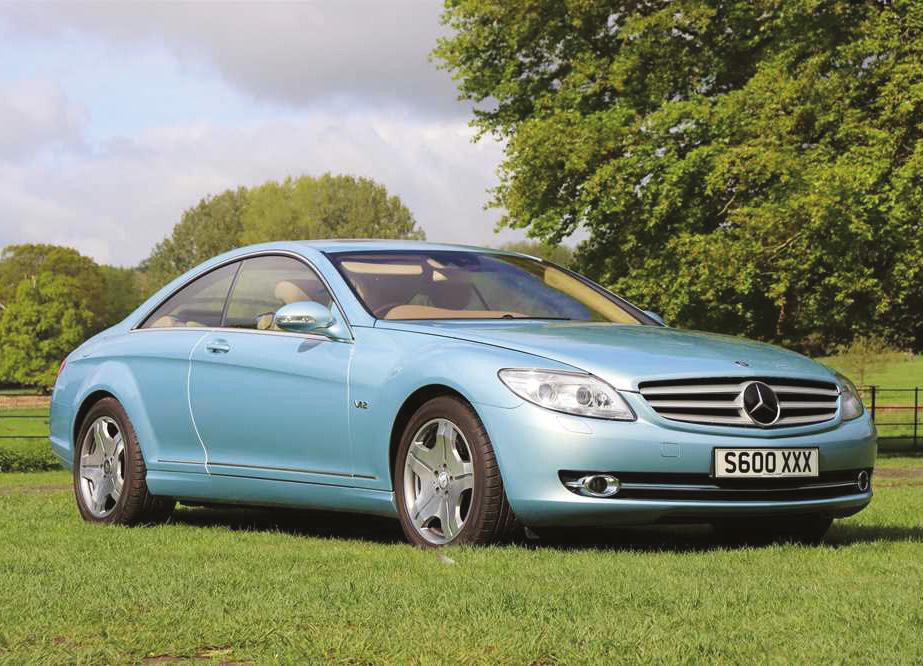
Chassis No: WDD2163762A010695
Manufactured new in 2007, chassis number 010695 was supplied new to PMG Investments Ltd of Birmingham, wearing both registration numbers ‘PMG 1’ and ‘1 HOP’ during their ownership. Acquired by the vendor in 2013 as the first (and sole) private owner, the CL 600 is finished in special order Designo Ice Blue metallic paintwork with complementary Savanna Beige Exclusive leather interior upholstery and Walnut veneer interior finishers. Well-specified from new, the Mercedes’ features include the aforementioned Distronic and NightVision, as well as a reversing camera, Designo Alcantara headlining, heater and cooled memory seats with massage function, parking sensors, soft close doors and boot, double glazed, Harman Kardon, TV, and side seat bolsters providing extra holding when cornering. Further options comprised the 18-inch five-spoke light alloy wheels, dual cup holder, high-theft protection, and universal telephone package.
A notably nice example and rated as ‘excellent’ throughout by the vendor, ‘S600 XXX’ (as now registered) has covered less than 21,000 miles from new at time of consignment. Offered with a history file that contains the original book pack comprising the owner’s handbook, assorted booklets, and the stamped service book, which illustrates service history all completed by Mercedes-Benz main agents, with thirteen stamps documented. Further included in the documents file is a large collection of invoices and previous MOTs, and a current V5C document. Said by the vendor to ‘drive beautifully with no known faults’, the CL is supplied with a trickle charger (and accompanying information book), two sets of keys, the CL 600 is shod with matching tyres, the same type as originally fitted, which have covered just c.3,100 miles. These Coupés are renowned for their opulence and ability to eat up mileage, and with the V12 engine and such low mileage and excellent condition, this example is certainly impressive.
Servicing with Mercedes-Benz Stratford-Upon-Avon was at 3,379 and 5,076 miles. Servicing with Mercedes-Benz Solihull at 7,755 miles. Servicing with Mertrux Mercedes-Benz Derby at 12,563, 14,771, 16,205, 17,042, 17,914, 18,821, 19,238, 19,661, 20,066, and 20,476 miles.
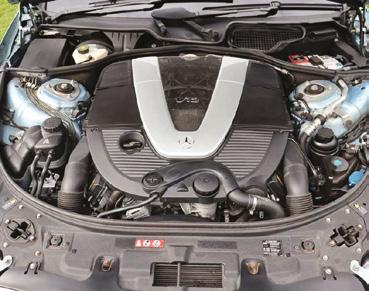
111 *All hammer prices are subject to a Buyer’s Premium of 12.5% plus VAT
80
1977 Aston Martin V8 ‘S’
Rare UK-delivered V8 ‘S’ in exceptional condition

Estimate: £70,000 - £90,000*
Reg No: 421 FLR MOT: Exempt Chassis No: V8/11734/RCAS
Retrospectively known as the ‘Series 3’, the redesigned V8 model Aston Martin was phased-into production during July 1973 and was a response to concerns over forthcoming US emission control regulations. Marking a switch from Bosch fuel-injection to quad twin-choke 42mm Weber carburation, the newcomer was visually distinguished by an enlarged air intake, an elegant, elongated bonnet ‘power-bulge’ and an altered rear window base panel. The ‘Series 3’ utilised the same steel platform chassis as its predecessor, complete with independent double-wishbone front suspension, a Watts linkage-located de Dion rear axle, power-assisted rack-and-pinion steering. The luxury GT benefitted from improved engine and transmission cooling and a revised petrol tank design, which boosted luggage space. Other improvements included a revamp of the 2+2 interior with revised seats and rearranged switchgear. Initially developing some 310bhp, its cleaner-running and less temperamental 5340cc DOHC V8 engine made for a prodigiously fast motor car. By 1977, however, even tighter emission regulations had sapped peak output to around 280bhp. Aston’s response was to install ‘Stage 1’ camshafts and an exhaust system developed for the V8 Vantage, restoring power to nearer 304bhp. Models so equipped are sometimes referred to as V8 ‘S’. Due to financial difficulties, the 967 Series 3 cars commissioned were produced in two phases: July 1973
– December 1874 and Spring 1976 – October 1978.
A copy of the original build sheet notes that chassis V8/11734/RCAS, a rare and desirable home market V8 ‘S’, was delivered to GKN Group Services on 23rd of August 1977. Finished in Kentucky Blue with a Burgundy Connolly hide interior, Burgundy carpets and Grey headlining, the specification included an automatic transmission and the very rare sliding sunroof. Whilst there is a comprehensive service record for the car since the late eighties, the early ownership history can only be traced back through the invoices to 1989 when the car was owned by a Mr Bertram of Newcastle upon Tyne. He sold the car to a Mr Thomas in Durham, with the Aston passing into the ownership of a to Mr Cameron of Wallington, Surrey some years later. The V8 was acquired by a Mr Robertson of Coulsdon in November, 1998. The previous owner, a Mr Smiles, bought ‘421 FLR’ in March 2001 from Supersport Prestige & Performance Cars and kept it until it was sold to the current vendor in 2018.
From the accompanying history file, comprising of 4 big folders, it becomes clear that the car has always been well cared for and that the owners were not afraid to invest heavily into keeping it in very good condition. The list of suppliers and servicing specialists reads like a ‘Who’s Who’ of Aston Martin Specialists, with names including Aston Martin Lagonda, Ian Mason, Aston Engineering, Puddleduck, Rikki Cann, Goodwood Green Classics, RS Williams, Stratton Motor Company and Aston Workshop. Under Mr Smiles’ custodianship, ‘421 FLR’ was subjected to a substantial renovation program, with a full bare-metal respray in Rolls-Royce Peacock Blue after all issues with inner and outer sills, outriggers, chassis and bodywork were sorted out. The interior was partly retrimmed in high-quality Red leather with a new headlining installed as well. In 2010 the engine was fully stripped and rebuilt with the automatic transmission being uprated with a ‘shift kit’ to increase performance and reliability.
At the time of consignment, the car drove exceptionally well with good engine performance and a smooth gearchange. With the interior, exterior and mechanicals being rated by the vendor as ‘very good’, and offered with a very large history file, this properly sorted and cosseted V8 ‘S’ should be at the top of the wish list of anyone considering an Aston Martin V8.
112 *All hammer prices are subject to a Buyer’s Premium of 12.5% plus VAT
81
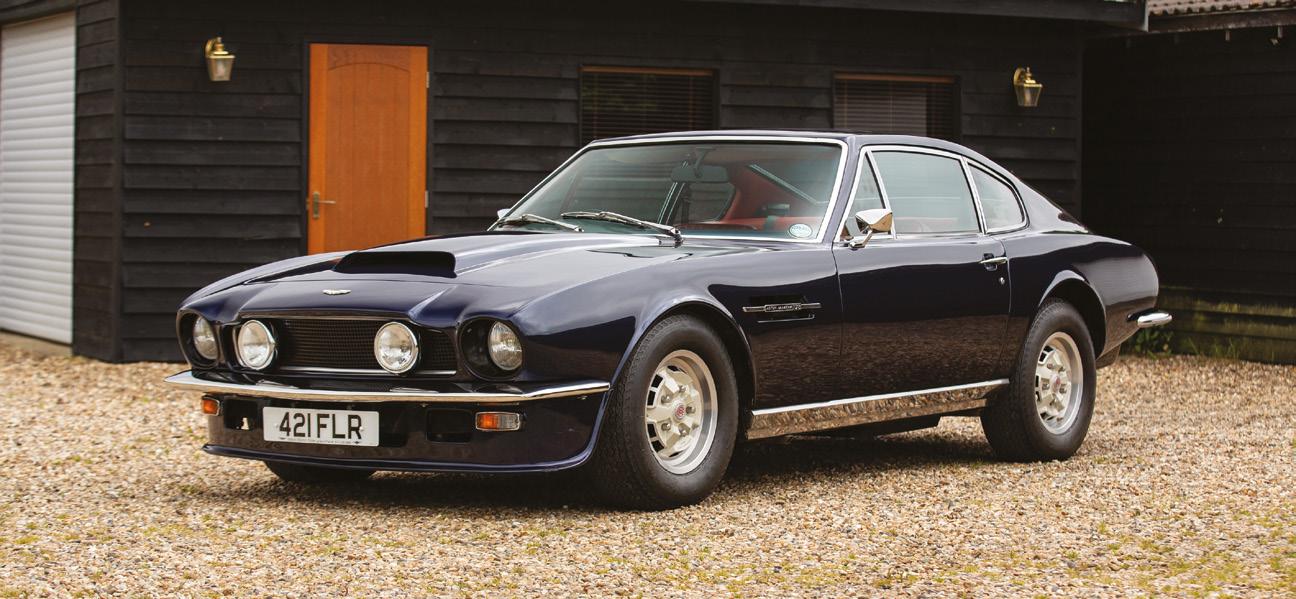
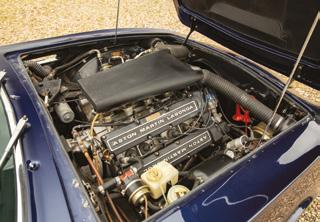
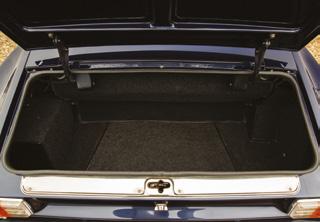


113

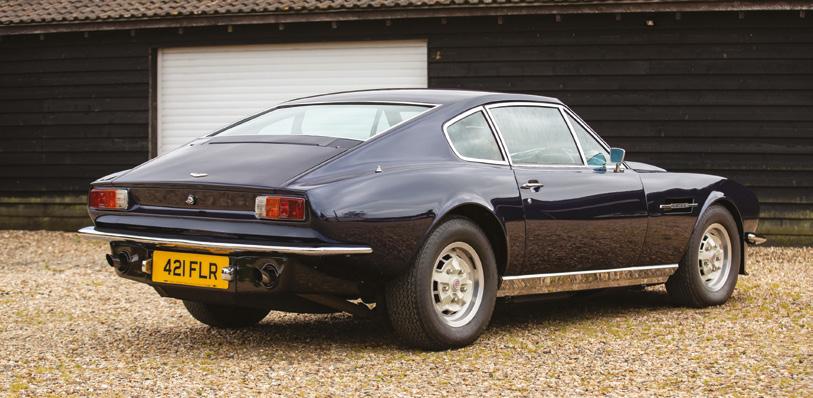

114

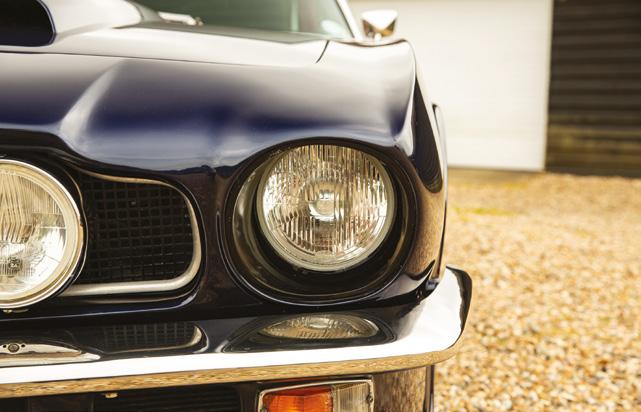
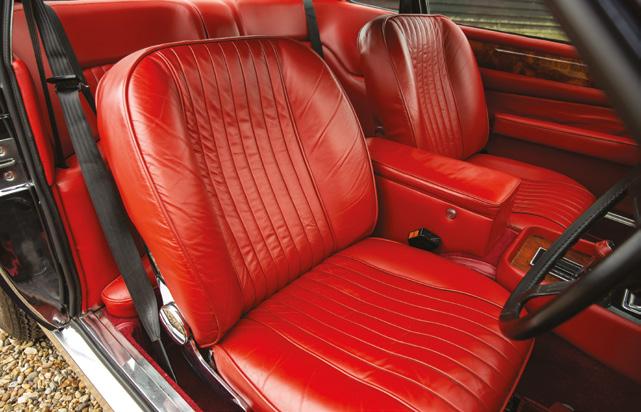
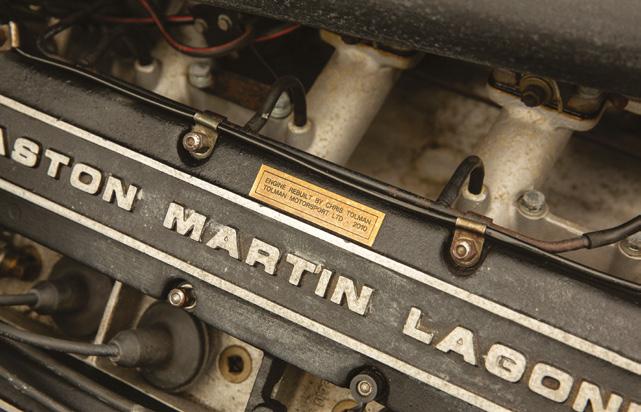
115
2005 Porsche 911 Carrera 2
Estimate: £18,000 - £22,000*
Reg No: T.B.A MOT: May 2024
Chassis No: WP0ZZZ99Z55703849
Introduced in 2004, the 997-series of Porsche’s iconic 911 represented a significant advancement over its predecessor, the 996-series. This iteration incorporated notable technological enhancements, including a lighter and stiffer bodyshell, improved suspension and brakes, upgraded four-valve cylinder heads, and an enhanced HVAC system. In terms of design, the 997-series took a more classical approach, combining timeless styling elements with modern aesthetics. At its launch, the 997 was available in Carrera or Carrera S variants. The Carrera model featured a 3.6-litre engine producing 321bhp and 273 lb-ft of torque, mated to a choice of either a six-speed manual or a five-speed Tiptronic transmission. With impressive performance figures, including a 0-60mph time of 4.8 seconds and a top speed of 178mph, the 997 Carrera offered a thrilling driving experience. Furthermore, its superior build quality, refined aesthetics, and agile nature positioned it as a desirable choice, making well-preserved examples of the 997 increasingly sought after by collectors.
In current ownership since April, 2019 by an historic race car engineer with experience running historic F1 cars, this particular 911 is presented in the attractive combination of Seal Grey with Basalt Black leather interior and boasts an impressive specification including 19’’ Porsche Design alloys, aftermarket Aero spoiler (Original included), privacy glass, Porsche Active Suspension Management (PASM), Porsche Communications Management with navigation, heated, electric seats with 3x memory settings, cruise control, dual-zone climate control, sliding sunroof, Alcantara headlining and much more.

With the odometer displaying c.94,256 miles at time of consignment and an MOT valid until 16 May 2024 with no advisories, this particular example has been looked after in current ownership by Porsche specialists EMS Ltd and ADH Porsche. Notable works include a replacement gearbox contact board with ADH in September 2019 at £665.76, replacement front shock absorbers and steering rack in July 2019 at £1,600, a replacement starter motor in June 2019 at £204 and replacement front coffin and control arms in that same month at a cost of £440.
With 8 stamps in the service book and the most recent on 29 March 2022 with EMS Ltd, this Porsche comes with an impressive history file containing a large collection of invoices and nearly every MOT since 2009. The original Porsche book pack is also included and contains a significant number of booklets, including the Inspection Certificate, various PCM booklets, driver’s manuals, quick reference guides, Porsche Assistance, Centres and repairers booklets, warranty booklets, Porsche Club GB booklets, lifetime guarantee booklets and of course the service booklets, manual and so on. 2x keys are included with the vehicle and the V5C document which displays ‘6’ former keepers.
116 *All hammer prices are subject to a Buyer’s Premium of 12.5% plus VAT
82


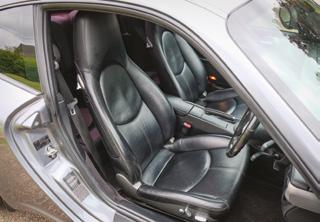


117
2017 Alfa Romeo 4C

Just 16,500 miles from new
Estimate: £45,000 - £55,000*
Reg No: NL17 UFC MOT: June 2023 Chassis No: ZAR9600000M188189
Inspired by its 8C Competizione supercar sibling, the Alfa Romeo 4C (Tipo 960) was launched at the 2013 Geneva Salon. Penned by Marco Tencone of Alfa Romeo Centro Stile Alfa Romeo, the stunning sports car featured a carbonfibre central tub, carbonfibre outer panels and aluminium subframes. Weighing just 1,118kg and powered by a turbocharged 1750cc DOHC four-cylinder engine allied to six-speed Dual Dry Clutch transmission, the 4C had some 237bhp/258lbft on tap and was reputedly capable of 0-60mph in 4.5 seconds and 160mph. Equipped with all-round independent suspension, four-wheel disc brakes and rack and pinion steering, the two-seater managed an 8min 4sec lap of the Nurburgring and could generate 1.1g laterally. Tasked with forming the model’s carbonfibre tub, Adler Plastic failed to meet their volume targets. Indeed, the 4C proved considerably more expensive and time consuming to make than Alfa Romeo had envisaged. A barely heavier Spider version arrived in 2015 but production of both variants ceased during the Covid-19 pandemic. A decidedly rare sight, just 556 are understood to have been UK supplied (with 298 of those being Coupes).
Finished in special order Competizione Red, ‘NL17 UFC’ has covered just 16,500 miles from new. Fitted with the desirable Factory Racing Pack which includes suspension and exhaust upgrades, the Alfa Romeo is reportedly accompanied by a full service history and has the added benefit of a transferable service plan that runs into September 2023. Recently treated to a new battery and four Michelin Pilot Sport tyres, the 4C is trimmed in Black with contrasting Red stitching. An undoubted modern classic and among the best looking cars of its generation, this increasingly collectible Alfa Romeo is offered for sale with a custom car cover, original cleaning kit, electric pump, owner’s wallet, handbooks, service book, 2 keys and V5C registration document.
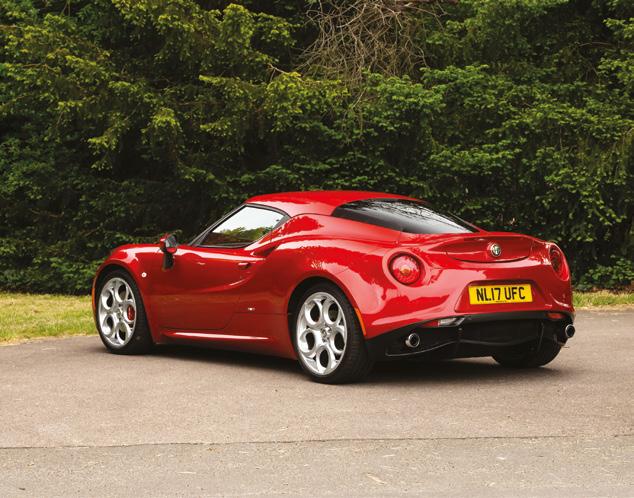
118 *All hammer prices are subject to a Buyer’s Premium of 12.5% plus VAT
83

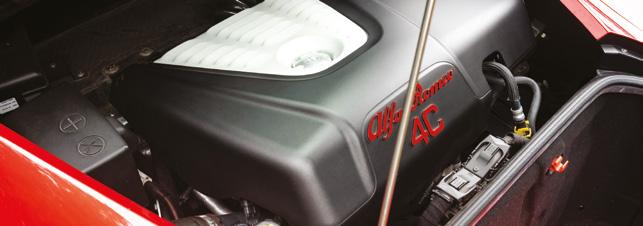


119
1979 Austin Morris Mini 1275 GT Rally car
Estimate: £18,000 - £22,000*
Reg
No: JGP 610T MOT: October 2023
Chassis No: XE2D2629583A
Offered with an MSA passport up until 2029, this is a ‘rally spec.’ 1275 GT build, which was completed in 2019 at Greetham Garage, and has seen very little use since. Originally, this Mini 1275 GT was supplied new by Mann Egerton Co. Ltd of London, to a Mr Church of London. Garage owner and rally driver, Julian Cardew took this car in part exchange in 1989 and recreated his successful Mini Clubman used in the 1970’s for road and stage rallying, before he moved on to Opel, Ford and then Peugeot. Used since his retirement on four small demonstration events.

The body has been prepared with necessary strengthening and seam welding including the front subframe. There’s a competition dash and wiring and Cibie Oscar spot lamps. It wears four new Revolution 12” wheels with Yokohama tyres and is has two spare wheels. Power is delivered from a +.040 1293cc engine, with a 45” DCOE carburettor and straight-cut Jack Knight gears, providing a sound that evokes the memory of historic Mini racers. Circa 87bhp can be found at the flywheel, the output aided by a Peter Burgess race head and rally cam, balanced crank, steel flywheel and competition clutch. Fuelling from a large capacity tank is via an electric fuel pump with gases exiting via a 3 branch competition manifold. Cooling is aided by an alloy radiator and 13 row oil cooler.
The running gear includes adjustable Spax shock absorbers, straight cut box, with an open differential and Cooper ‘S’ drive shafts. Stopping the Mini are 8.4” discs and Mintex 1144 pads, Rear brake bias valve and inboard brake lines. Prepared for forest rally and tarmac stage events, the safety specification includes a full Dural sump guard, FIA Safety Devices bolt-in roll cage with door bars and rear diagonal, in-date OMP seats and Sabelt competition harnesses, a plumbed-in fire extinguisher system (serviced 2022) and a Quick Jack. On board, there is a Brantz 2 trip meter and a Terratrip road comms system. Supplied with the MSA passport valid until 2029, the original owner’s wallet (handbook and passport to service with stamps) and a collection of invoices plus a Pearson’s maintenance manual.


120 *All hammer prices are subject to a Buyer’s Premium of 12.5% plus VAT
84
Lots 85 - 134
An Auction of Classic & Collector Cars
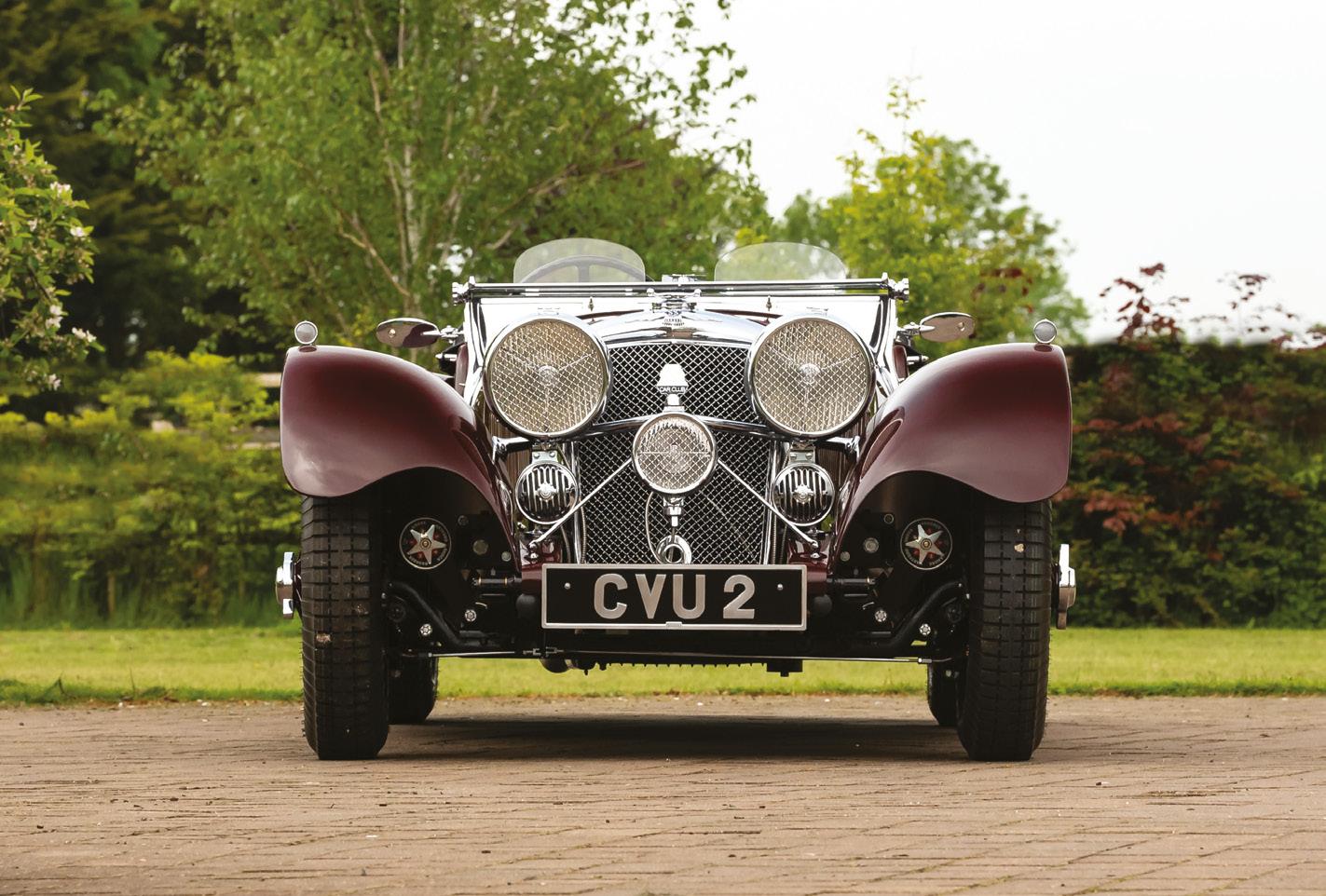
1990 Citroen 2CV6 Dolly
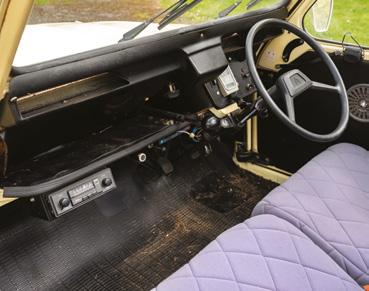
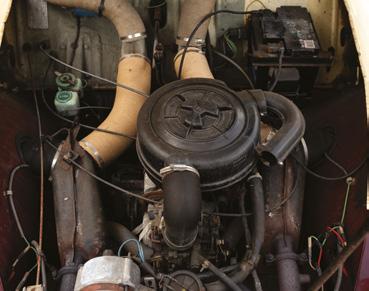 Entered from the Guinness Collection
Entered from the Guinness Collection
No Reserve
Reg No: G557 BRX MOT: T.B.A
Chassis No: VF7AZKA00KA366377
The development of Citroën’s ever-charming Deux Chevaux dates back to 1936, a couple of years after the company had been rescued by Michelin. It was intended to motorise the large numbers of French farmers with research carried out amongst France’s largely rural population that determined the following unique design brief: a low-priced, rugged ‘umbrella on four wheels’ that would enable four to drive 110lb of farm goods to market at 31mph in clogs and via muddy, unpaved roads; including transporting eggs across a ploughed field without breaking them. Production was delayed by WWII, but began in 1948, following which 3,872,583 2CVs were manufactured via 11 factories across the world (including one in Slough, England) between 1948 and 1990, by when the ageing design had been defeated by contemporary legislation.
The peak of 2CV sales in the United Kingdom would be reached in 1986, thanks to the introduction of the popular Dolly special edition, with 7,520 new 2CVs registered in Britain that year.
Manufactured new in 1990, the 2CV6 Dolly offered was supplied new via Eric White Citroen Ltd. of South Ascot, being registered new on the 30th of April that year. Finished in the popular colour combination of Maroon and Yellow, the Citroen features a Burgundy hood and cloth interior upholstery. ‘G557 BRX’ is a scarce low mileage example having covered a mere 32,775 miles from new (at the time of consignment), and the Dolly benefitted from some £1,300 worth of improvements in 2017 that comprised new seat foam and covers, a new hood and chassis and bulkhead repairs. The Citroen is offered with a history file containing the owner’s handbook, previous images of the 2CV, a large collection of previous MOT certificates back to 1993, numerous invoices for work and servicing, the original sales invoice and correspondence with the first owner, and a current V5C document. Not only a rare low mileage example of the iconic 2CV but an interesting offering being sold directly from the Guinness Collection.
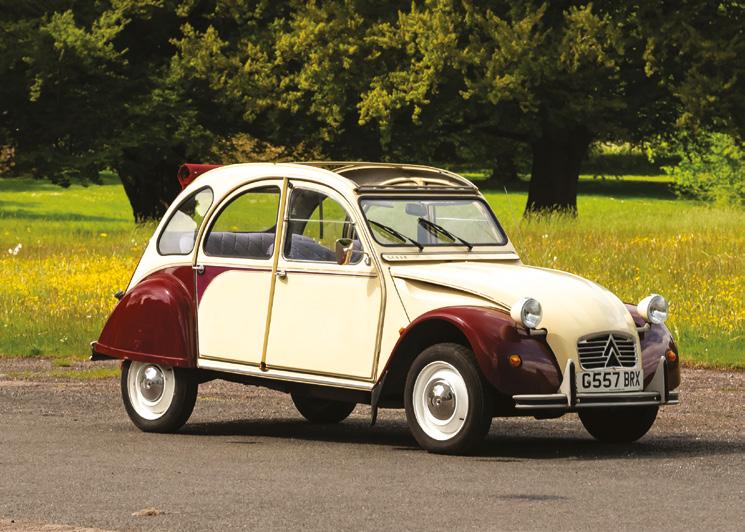
122 *All hammer prices are subject to a Buyer’s Premium of 12.5% plus VAT
85
1954 MG TF 1500
Entered from the Guinness Collection
Estimate: £16,000 - £20,000*
Reg No: SSK 743 MOT: Exempt Chassis No: HDC46/7593
‘Of all the cars we have occasion to drive, there is one above all others which, by its every characteristic, clearly defines the term sportscar’ (Road & Track magazine on the MG TF, 1954).
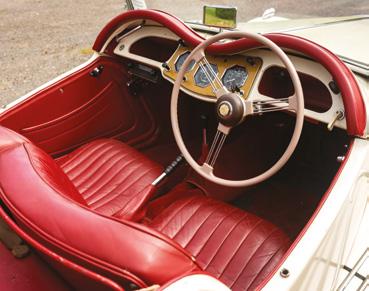
The last of the MG T-series line, the TF was introduced in October 1953. Although mechanically near identical to its TD predecessor, the provision of a raked radiator, revised wing line, and faired-in headlamps lent it an altogether sleeker and sportier air. Powered by a revised version of the well-proven, four-cylinder XPAG engine but this time using larger valves, a higher compression ratio, and twin SU 1.5in carburettors, the new model was reputedly capable of over 80mph. Equipped with both rack-andpinion steering and independent coil-and-wishbone front suspension, it helped maintain the marque’s ‘Safety Fast’ reputation. Around 6,200 TF1250s were made, followed by 3,400 examples with the 1500 engine.
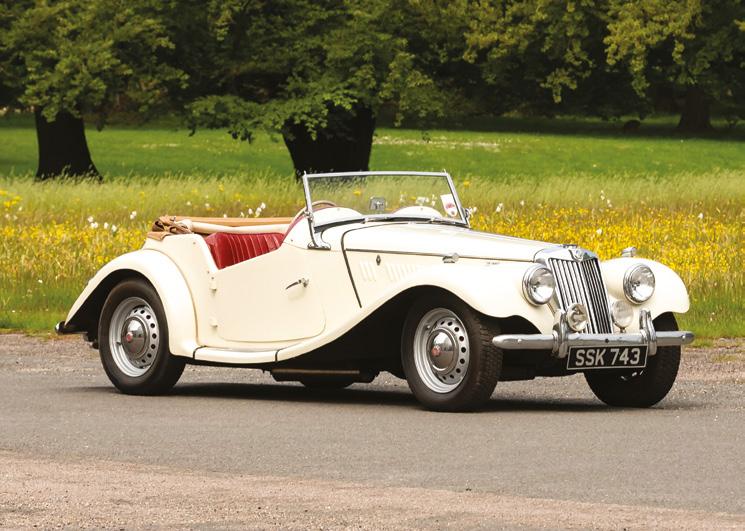
Like many T-Series MGs, ‘SSK 743’ started life as a US export, being reputedly supplied new to California. This desirable 1500 XPEG engine variant TF is known to have been residing in Thousand Oaks, California by the late 1970s before being imported from California to the United Kingdom in 1988. Subject to a comprehensive restoration and converted to right-hand drive between 1989 and 1992, the MG was finished in the appealing colour combination of Cream paintwork with a complementary Red interior upholstery and a Tan hood and full-length tonneau cover. Upon completion, chassis number HDC46/7593 was UK road registered in 1992.
Passing briefly through another UK keeper, ‘SSK 743’ was acquired into the Guinness Collection in 1997, the MG has resided in the said collection ever since and is offered from directly there today. Understood to boast matching chassis and engine numbers, the MG started readily and ran well during our photography session. Accompanied by a history file that contains a registration card from 1979, a large collection of previous MOTs dating back to the 1990s, numerous invoices (mostly from the 1990s), and a current V5C registration document.

123 *All hammer prices are subject to a Buyer’s Premium of 12.5% plus VAT
86
1948 Ford V8 Custom
Entered from the Guinness Collection
Estimate: £12,000 - £14,000*
Reg No: EU Registration MOT: Exempt
Chassis No: 98BAF141013

As automobile production resumed after World War II, offerings were generally limited to existing pre-war designs, but by 1949, the American Big Three had fresh, innovative concepts on sale. Ford was first, showing all-new 1949 models from the 8th of June 1948, with production beginning later in 1948. They were deemed as un-Ford-like as anything the public had ever seen! The ‘shoe-box’ was slab-sided and streamlined, with the company proudly announced that the New York Fashion Academy had judged the Ford the “Fashion Car of the Year.” Today, the ‘1949 Ford’ is widely and justifiably credited as a clean, crisp American design classic, and one of the most famous U.S. automobiles ever produced.
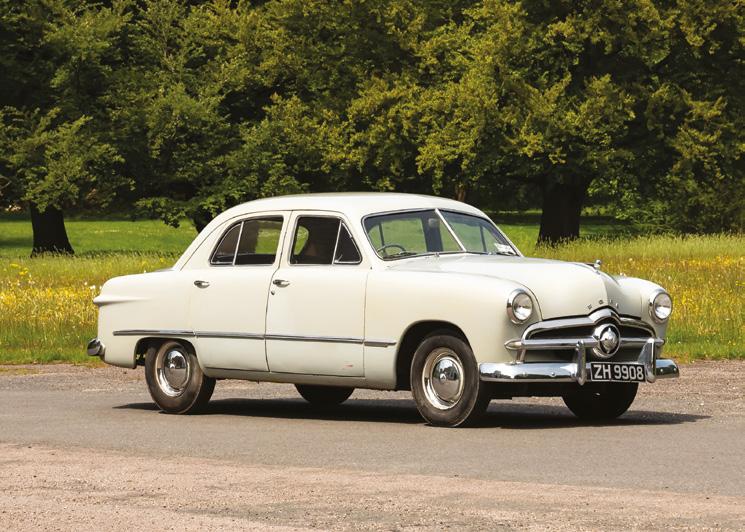
This V8 Custom was manufactured new in 1948 and supplied new in righthand drive form to Ireland, being registered new to the supplying dealer, Autocars of Ireland of Dublin, on the 20th of March 1948. Purchased new by Rupert Guinness, 2nd Earl of Iveagh, the Ford has been retained in the Guinness family ever since, registered to several different members of the family. Finished in Feather Grey with Brown interior upholstery, the Ford features a 255cu inch flathead V8 allied to a three-speed manual, column change transmission. Displayed in The Museum of Irish Transport for several years, the Ford shows a recorded mileage of 35,362 miles which is unwarranted but believed correct. Accompanied by a copy of the original buff log book, the original document is anticipated to be sent from Ireland in time for sale. The Ford is still Irish registered and has not been NOVA declared. An interesting offering being direct from the Guinness Collection and in the family’s ownership from new.
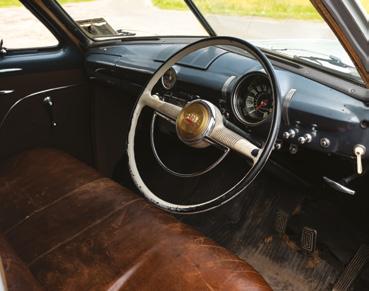
124 *All hammer prices are subject to a Buyer’s Premium of 12.5% plus VAT
87
1997 Land Rover Defender 110 Wolf ‘Remus’
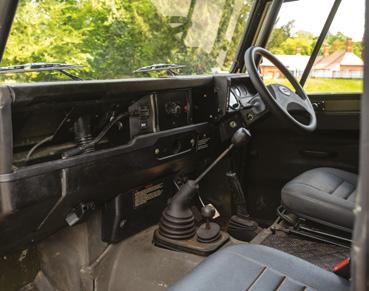
Entered from the Guinness Collection
Estimate: £12,000 - £14,000*
Reg No: P447 GPF MOT: July 2023
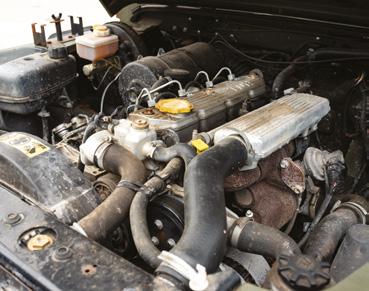
Chassis No: SALLDBA67VA112315
Manufactured new in 1997 and supplied new to the Ministry of Defence (MoD), the Wolf 110 offered was demobbed from service at the end of 2019 and was acquired by Land Rover specialists AJS Land Rovers. They provided the 110 with a comprehensive restoration to bring the Land Rover up to an excellent standard across the next eight months. Some of the renovation work completed included the chassis being shot blasted, powder coated, and painted with chassis paint, with the engine completely overhauled with new shells, oil pump timing cover and casing, cam belt, pulleys, water, vacuum, and lift pumps, new intercooler and radiator. The gearbox and transfer box had previously been overhauled by the MoD and was found to be in very good condition but a new gearbox oil cooler was provided.

Other mechanical attention was provided with the axles refreshed; the brakes refurbished with new discs and pads, and master cylinder; the fuel system renewed with a new tank, sensor, and cradle; new rear arms; new shock absorbers; new clutch, master and slave cylinder; replacement starter motor and alternator. Bodily, the bulkhead was stripped to bare metal and found to be rust-free, and repainted, with the rear Wolf tub a renovated one from a donor vehicle. Further cosmetic restoration comprised new front wings; a new grille, and a refurbished bonnet; as well as the Wolf wheels powder coated and shod with new G90 tyres (including the spare). The interior was completely refreshed with retrimmed seats, renovated dashboard, and a powder-coated Remus Wolf roll cage.
Purchased into the Guinness Family Collection shortly after the end of the renovation (2020), it has resided there since and now is offered for auction with a recorded mileage of 118,653 kilometres at the time of consignment (equating to c.73,000 miles). Accompanied by a history file that contains a large selection of invoices pertaining to the renovation, a few previous MOT certificates, and a current V5C registration document.
125 *All hammer prices are subject to a Buyer’s Premium of 12.5% plus VAT
88
1928 Rolls-Royce Phantom I Shooting Brake

Entered from the Guinness Collection
Estimate: £60,000 - £80,000*
Reg No: YV 9253 MOT: Exempt Chassis No: 95FH
“After seven years of experiment and test, the 40/50hp six-cylinder Phantom chassis emerged, and is offered to the public as the most suitable type possible for a mechanicallypropelled chassis under present-day conditions” (New Phantom launch brochure, May 1925).
By 1925, the Rolls Royce Silver Ghost had been upstaged by a younger generation of more technically advanced luxury cars. The glory days of the 1913 Alpine Trials had long passed and both F. Henry Royce and RR sales manager Claude Johnson felt the need to produce a new claimant to the title ‘best car in the world’. Just as the competition between car manufacturers was becoming increasingly fierce so that between rival coachbuilders had intensified correspondingly. With the arrival of each faster, more powerful chassis came the opportunity to construct ever more lavish, sophisticated coachwork. To ensure that their cars could be fitted with the finest bodies in the world, Rolls Royce introduced the ‘New Phantom’.
While, its tapered channel-section chassis, four-speed manual transmission, supple springing (semi-elliptic front, cantilever rear), and ingenious gearbox driven servoassisted four-wheel brakes owed much to its predecessor, the Phantom’s 7668cc engine was all new. Quoted as being an impressive thirty-three percent more powerful than the Ghost’s unit, it featured overhead valves set in a detachable cylinder head, twocylinder blocks with three cylinders each, an aluminium alloy crankcase, and a massive seven-bearing crankshaft. Bore and stroke dimensions of 108 x 139.7mm resulted in abundant torque enabling the flagship Rolls-Royce to accelerate from walking speed to approximately 80mph in top gear. Unveiled at the company’s 14/15 Conduit St, London showrooms during May 1925, the ‘New Phantom’ remained in production until 1929 by which time some 2,269 chassis had been delivered.
Chassis 95FH was delivered new to coachbuilders Windovers Ltd on the 12th of May 1928 and was clothed in Limousine coachwork as specified by the first owner Arthur H. Wrey Esq., son of Sir Henry Wrey, 10th Baronet and a relative of Lt. Colonel Charles Parke Ibbetson who served in the 11th Hussars (Prince Albert’s own cavalry regiment), which achieved distinction in the Charge of the Light Brigade. Residing at 7 Royal Crescent,
Regents Park, NW1, Arthur H. Wrey Esq., had the order diverted to his Surrey address of Romany House, The Wentworth Estate. It is unknown as to how long A. H. Wrey Esq. retain the Phantom, but the subsequent ownership history found chassis 95FH in the possession of a funeral director based in Chalfont St Peter, Buckinghamshire between 1950 and 1960.
Thereafter passing through two private owners in the 1960s and 1970s between Middlesex, Essex, and Kent, the third private keeper retained ‘YV 9253’ from 1972 until 1990 when it was purchased into the collection of the arch car enthusiast and MP, the Rt Hon Alan Clark. A passionate motoring enthusiast, Clark bought his first car, a 6½-litre Bentley, while still at Eton. He went on to deal in classic and Vintage cars, amassing an impressive collection of Bentleys while also writing columns for Thoroughbred & Classic Cars magazine in the UK and Road & Track in the USA. He later recounted his motoring exploits in a book entitled Backfire: A Passion for Cars and Motoring.
In poor condition when entering the Rt Hon Alan Clark collection, the chassis was reclothed as part of a comprehensive restoration into the Shooting Brake coachwork seen here – which was transferred from a Ghost. Completed during the 1990s, it is unclear as to whether this was before or after Mr. Clark’s custodianship, with him selling the Phantom through Sotheby’s, again in the 1990s. Another long-term private keeper ensued before the Phantom was acquired into the Guinness Family collection, in which it has resided since 2007. Used on the Elveden Estate, one of the world’s most renowned locations for shoots and having historic shooting since the 1700s, the Rolls-Royce has surely seen some interesting trips and carried some fascinating characters. The large, imposing coachwork stands over seven feet tall and being transferred from a Ghost, it is of 1920s design rather than lots of other post-war coachwork that is seen on such chassis’.
126 *All hammer prices are subject to a Buyer’s Premium of 12.5% plus VAT
89
Providing seating for twelve adults, ‘YV 9253’ can (and has) been used as a Shooting Brake, transporting its occupants in both (relative) comfort and style. Boasting matching chassis and engine numbers, the Rolls-Royce is accompanied to auction with a history file that contains the Rolls-Royce Enthusiast Club build records, a continuation ‘buff’style logbook, several previous invoices and MOT certificates, and an instruction manual. The V5C document is included, as well as previous V5 ownership logbooks. This example, with its interesting history and intriguing coachwork, marks a fabulous opportunity and would be an interesting addition to many a collection (especially if the new owner had access to a suitable estate).
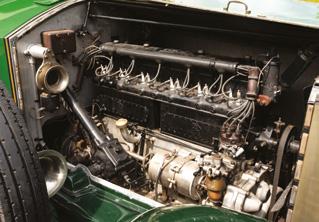
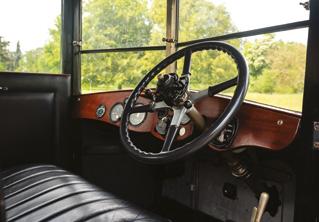

127
1936 Jaguar SS100 2.5 Litre Two-Seater Sports
Monte Carlo Rally entrant
Estimate: £380,000 - £450,000*
Reg No: CVU 2 MOT: Exempt Chassis No: 18050
It is difficult to overstate the importance of the SS100 to the Jaguar legend. Forebear to the equally glamorous XK120 and E-Type, the two-seater was primarily marketed for competition usage which goes some way to explaining its tiny production numbers; 191 2½ Litre and 118 3½ Litre cars. To put those figures into context Bugatti made 710 Type 57s, while Bentley completed 2,422 3½ Litre and 4¼ Litre chassis. Accumulating silverware at both National and International level, the triumph of the SS100 programme helped convince Sir William Lyons to press ahead with the C-Type and D-Type ones during the 1950s (which netted five Le Mans 24-hours victories between them).
The example offered here – chassis 18050 – was an integral part of the Roadster’s success story as was its first owner, Jack Harrop. The son of a Manchester industrialist, he had competed in a variety of Chrysler and MG cars before ordering one of Jaguar’s almost impossibly rakish two-seaters from his local dealership, Henlys. Harrop’s decision was doubtless influenced by Tommy Wisdom’s performance on the 1936 International Alpine Trial which saw him helm an SS100 to overall victory (winning a coveted ‘Coupes des Glaciers’ in the process). Specified in Maroon with external door handles and a 3.8:1 final drive, chassis 18050 was delivered on 8th December 1936. Road registered as ‘CVU 2’, the Roadster made its competitive debut less than two months later on the Sixteenth Monte Carlo Rally (January 26th - January 30th 1937). The event attracted no fewer than 133 entries with Harrop being among fifteen crews who elected to start from John O’Groats. A steady drive saw him finish thirtieth overall. Rewarded with the Royal Scottish Automobile Club Trophy for being the highest placed finisher to have departed from the famous Highland village, his next outing aboard ‘CVU 2’ proved even more impressive. Notable for the unseasonable amount of fog, snow, ice and heavy rain which it threw at competitors, the Sixth RAC Rally ran from March 9th – 12th 1937. Quite remarkably, the 1,000-mile course was completed by all but eight of the 192 entrants. Upsetting the apple cart somewhat, Harrop piloted chassis 18050 to overall victory beating the Worksentered SS100s of Tommy Wisdom and E.H. Jacobs into second and fourth places respectively. Performing particularly well in the driving tests, he was praised by Motor Sport magazine who reported: ‘Then Harrop came up the hill fast. Blipping his throttle, he was completely untroubled by a terrific front wheel slide while reversing and displayed wizard acceleration’.
Invited to drive for the factory thereafter, Harrop won the 1938 RAC Rally and finished 10th overall on the 1939 Monte Carlo Rally aboard other SS100s.
Although ‘CVU 2’ did not enjoy another major win, it appeared in a variety of Jaguar brochures promoting the SS100 including a listing in the 1939 SS Jaguar sales brochure for competition success. It was also featured in period publications such as ‘Speed’ magazine and later in marque historian Andrew Whyte’s book ‘SS100 Super Profile’. Relocating to Switzerland, Harrop is understood to have taken the Roadster with him. Serving as a Flight Officer with the RAF’s 612 Squadron during World War Two, the twotime RAC Rally victor and his crew took off for a coastal patrol on November 3rd 1941 but never returned. Changing hands thereafter, the Jaguar is understood to have seen further competition usage being lightly modified with cycle wings, aero screens and telescopic front shock absorbers. Venturing to America during 1958, chassis 18050 still retained its original (albeit battered) front wings and windscreen when acquired by previous keeper William Martin some years later. A true SS100 aficionado who owned five of them at one time, Martin was determined to restore the ‘old warhorse’ to its former glory. To this end, he managed to track down its original engine (number 250997) which had been preserved by two registrars of the Classic Jaguar Association’s SS Register, namely Messrs Jack Hall and Holly Hollenbeck.

128 *All hammer prices are subject to a Buyer’s Premium of 12.5% plus VAT
90

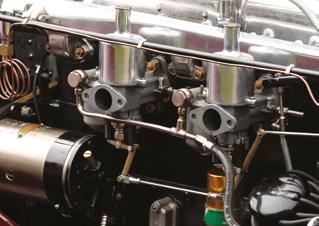

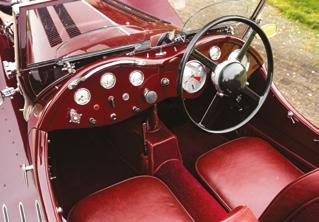

129
Martin got as far as shipping the SS100 back across The Pond and into the care of a dear friend in 1993 but the planned refurbishment never happened. Nevertheless, he insisted on flying over from California to interview the vendor about his intentions before agreeing to sell ‘CVU 2’ during 2010. True to his word, the seller spent the next ten or so years painstakingly returning the Jaguar to its rally winning specification. Major points of the restoration included the following:
• Engine thoroughly overhauled by an acknowledged specialist (the block is correctly endorsed with the ‘SS 100’ factory logo)
• Gearbox professionally rejuvenated, and a new propshaft made using the original yokes
• Chassis media-blasted and then hot zinc sprayed followed by three coats of specialist chassis paint
• All joints of the ash frame were re-glued, with areas of ash replaced where required, then strengthened with ash gussets in critical locations; frame re-skinned; new plywood floors, all as original. New front wings fabricated using the originals as a pattern
• Springs overhauled and new Silentbloc bushes fitted
• Original Luvax shock absorbers overhauled and refitted; André Hartford shock absorbers replaced
• Original brake shoes relined and all rods plated and refitted
• Total electrical rewire using Autosparks (Lucas) wiring loom
• All brightwork removed and refurbished (re-chroming undertaken by Derby Plating)
• QK596 headlights restored by Vintage Headlight Restorations
• Steering rack overhauled by Holman Engineering
• Total interior re-trim with new leather throughout by restoration specialist John Foy using original trim patterns and detailing
• New door cards, hood, tonneau cover, side screens and carpets.
• All dashboard instruments overhauled and re-calibrated by a specialist
The repaint was undertaken by a specialist coachwork sprayer in the original SS colour of Maroon. The car sits on its original rims refurbished by Turrino Wheels and shod with Blockley tyres. With the car are the restored SS 100 jack, tools, and a starting handle. During the restoration the car was inspected and verified by the late David Davenport of Davenport Cars Ltd (globally respected SS Jaguar specialists). Throughout the renovation the vendor was supported and advised by some of the world’s leading SS Jaguar authorities such as: David Davenport, Alan Crouch, Alan Gibbons, and from Australia John Clucas and Ed Nantes.
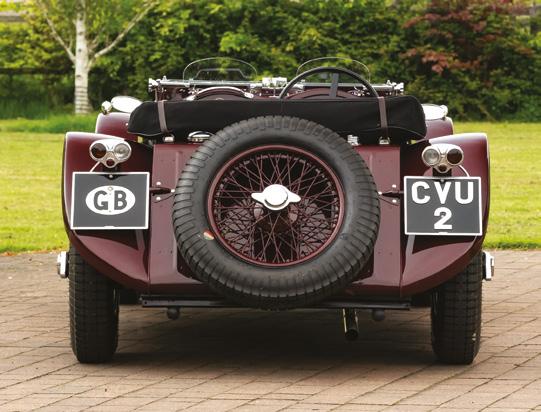
The end result is not only the nicest but also the most historic SS100 we have encountered. Surely worthy of a place in a major collection or museum, ‘CVU 2’ is testament to all that made Jaguar renowned in the first place. Worthy of close inspection and eligible for a host of prestigious events, chassis 18050 is offered for sale with a UK V5C Registration Document and compelling history file.

130

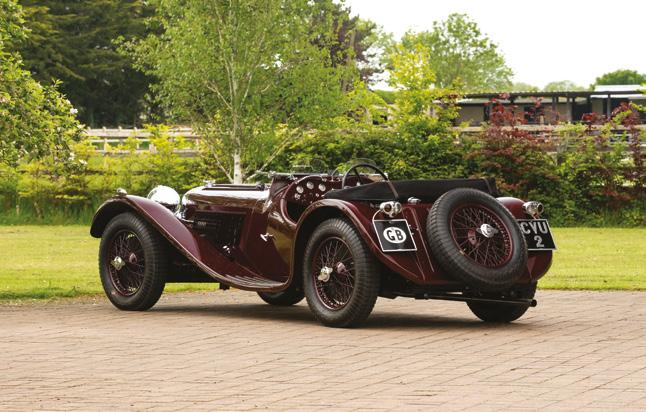


131
1967 Jaguar E-Type 4.2 2+2 Coupe

Subject of a full restoration
Estimate: £40,000 - £50,000*
Reg No: FFF 414E MOT: Exempt Chassis No: 1E50554
The 2+2 Fixed Head Coupe of the immortal E-Type (known as the XKE in America, where most examples were sold) was introduced in 1966. Nine inches longer and featuring a more vertical windscreen, it was equipped with a pair of small rear seats and a notably airy feel courtesy of its stretched wheelbase and raised roofline. It benefited from the same fully independent suspension, rack and pinion steering and disc brakes as its twoseater brethren. Powered by a 4,235cc DOHC straight six engine developing a quoted 265bhp and 283 lb ft of torque, it was the first E-type model to list automatic transmission as an option. Only in production for some three years, a mere 5,600 are thought to have been built, just 1983 of which were examples of the Series 1.5 version.
Built in November 1966 and first registered in March 1967, this Jaguar E-Type S1 4.2 2+2 Coupe was originally sold by KDM Cherrington via Henlys London to its first owner, Mr. J B Lewis. Originally adorned in Cotswold Blue with a Grey interior, this iconic vehicle has been meticulously restored to its former glory. The exterior has been expertly refinished in Sage Green, while the interior boasts a rich dark Wine-Red leather upholstery, exuding an air of sophistication. Under the bonnet, this Jaguar E-Type has undergone a comprehensive rebuild of its engine, gearbox, and differential, ensuring optimal performance and reliability. Notable enhancements include the addition of electronic ignition and a modern lightweight alternator, enhancing the car’s functionality while maintaining its classic appeal. To improve the overall driving experience, several upgrades have been implemented. The cooling system has been upgraded with a highflow aluminium radiator and electric fans, providing efficient temperature regulation. A stainless-steel exhaust system, including manifolds, has been fitted to enhance both performance and sound quality. Attention to detail extends to the suspension, which has been rebuilt and rebushed to deliver a smooth and controlled ride. The installation of larger brake calipers enhances braking performance, promoting a sense of confidence and safety on the road. For added security, a modern-day immobilizer has been installed discreetly. This exceptional Jaguar E-Type has been stored in a climate-controlled facility since its restoration was completed, ensuring its pristine condition. With its captivating blend of classic aesthetics and mechanical refinements, this 1966 Jaguar E-Type S1 4.2 2+2 stands as a testament to automotive excellence, inviting collectors and enthusiasts alike to appreciate its timeless allure.
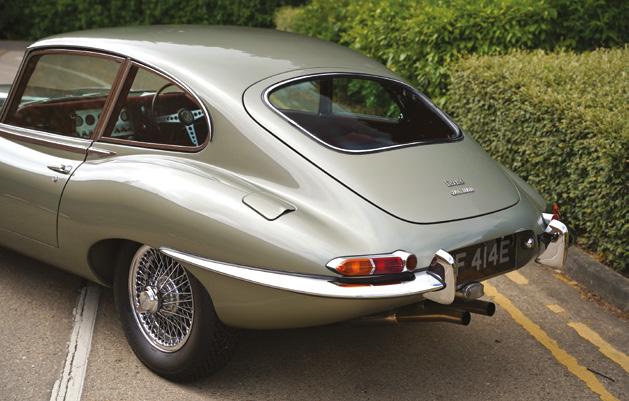
132 *All hammer prices are subject to a Buyer’s Premium of 12.5% plus VAT
91
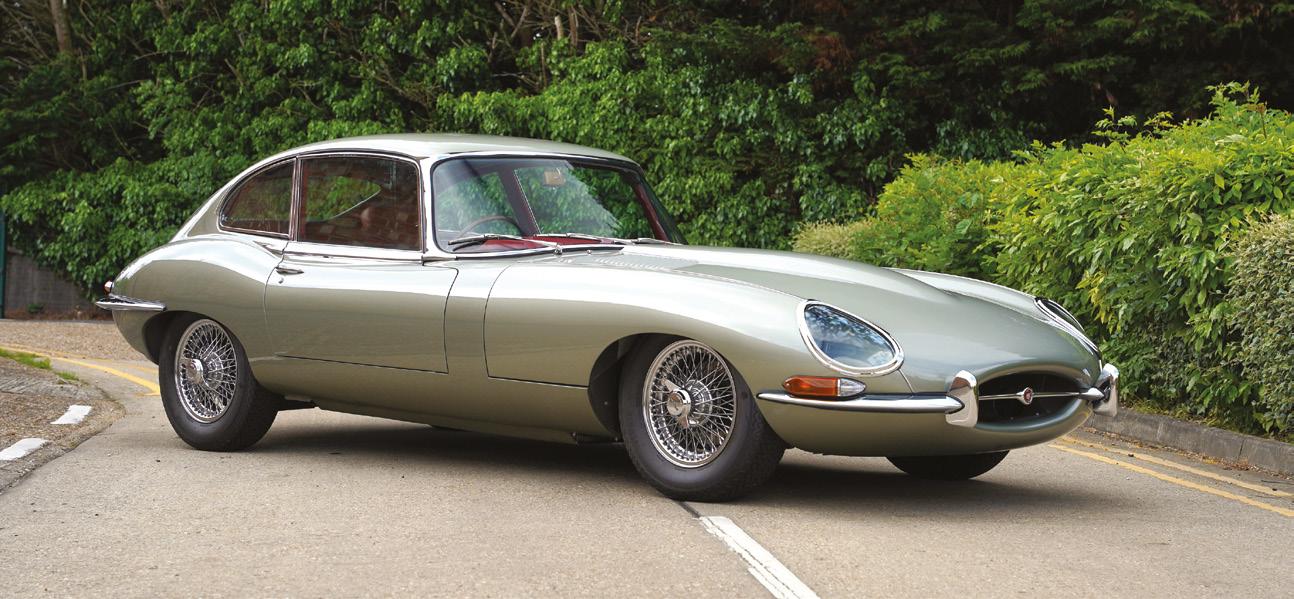

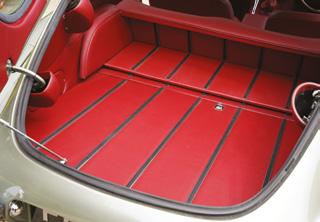
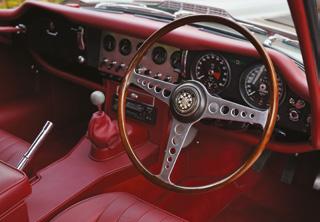
133
1932 Lagonda 3 Litre Tourer
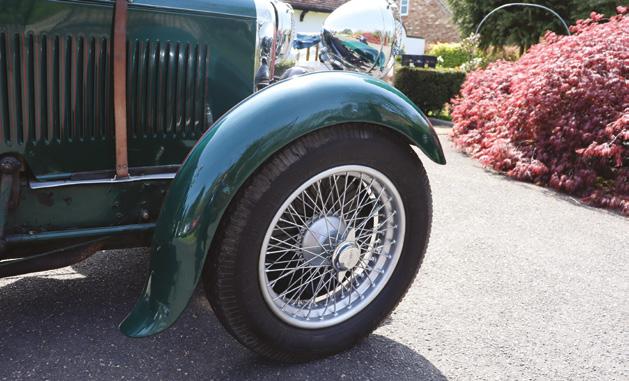
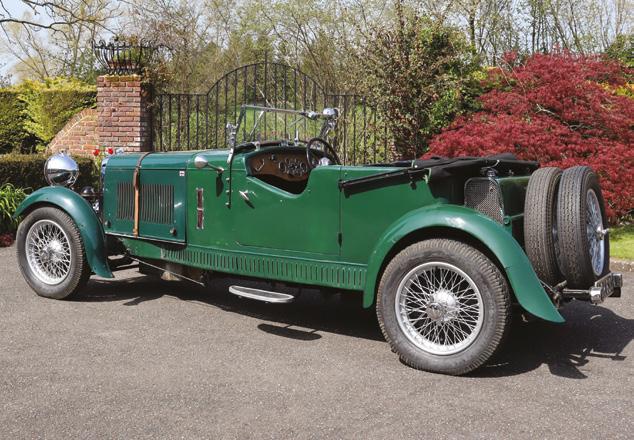
Estimate: £60,000 - £80,000*
Reg No: APH 633 MOT: Exempt Chassis No: Z10405
A derivative of the earlier 16/65, the Lagonda 3-Litre was unveiled in 1928. Progressively developed in line with its smaller 2-Litre sibling, the model made the transition from ‘High Chassis’ to ‘Low Chassis’ specification early the following decade. A somewhat conventional ladder-frame design utilising all-round semi-elliptic leaf-sprung suspension, friction shock absorbers and four-wheel drum brakes, the rakish Lagonda was nevertheless impeccably built. Powered by a 2,931cc OHV straight-six engine allied to four-speed manual transmission, the model was a true Thoroughbred (a point reinforced by Lord de Clifford’s fine performances aboard a Works 3-Litre on the 1931 Monte Carlo and 1932 RAC rallies). Eager to boost sales for the 1932 model year, Lagonda began experimenting with an innovative Maybach transmission which permitted clutchless gear changing and yielded eight forward ratios. However, the downside to such sophistication was a significant weight increase not least because of the need for a new specially reinforced `ZM’ type chassis frame. In an attempt to restore performance, the Staines manufacturer subsequently increased the 3-Litre powerplant’s bore from 72mm to 75mm increasing its capacity to 3,181cc. Although, the Maybach gearbox equipped `Selector Special’ was short-lived, the `ZM’ type chassis frame and enlarged engine remained a feature of 3-Litre production until it ceased in 1934.
Owned since 2007 by our vendor an engineer by trade, ‘APH 633’ has mainly been selfmaintained however when further expertise was required, he employed the services of an ex-Rolls Royce Mechanic and also called upon BishopGray, marque specialists, to give the car a thorough inspection and stamp of approval. in 2022 our vendor informs us that circa £15,000 was spent improving the car with work including complete upholstery & carpets, overhaul of carburettors, setting up valve clearances, refurbishing magneto and setting up the clutch mechanism. ‘APH 633’ was also treated to a new hood and tonneau cover at the same time. Upon inspection she presents as a car that has been regularly used, well maintained mechanically and thoroughly enjoyed. The exterior paintwork is distressed and aged in places with signs of repair, but this just adds to the character and charm of this lovely pre-war special. The vehicle is brought to sale with a V5 and a small history file.
134 *All hammer prices are subject to a Buyer’s Premium of 12.5% plus VAT
92
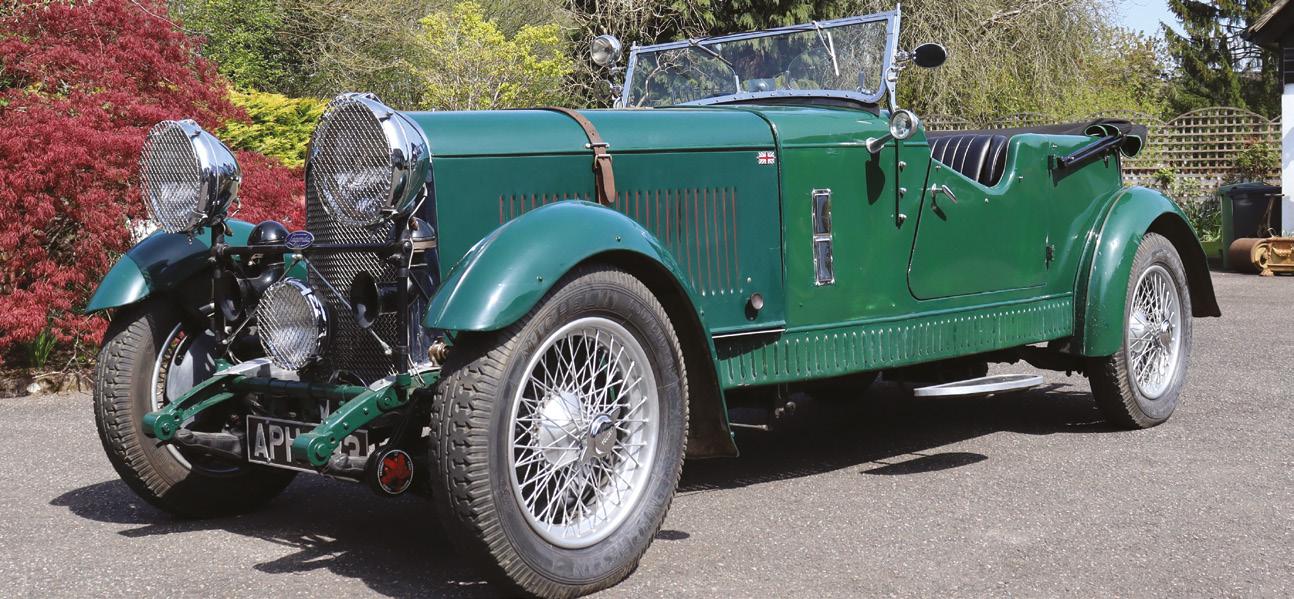

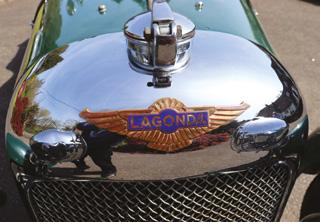
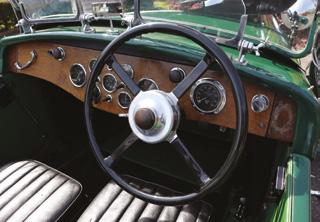
135
1924 American LaFrance Speedster
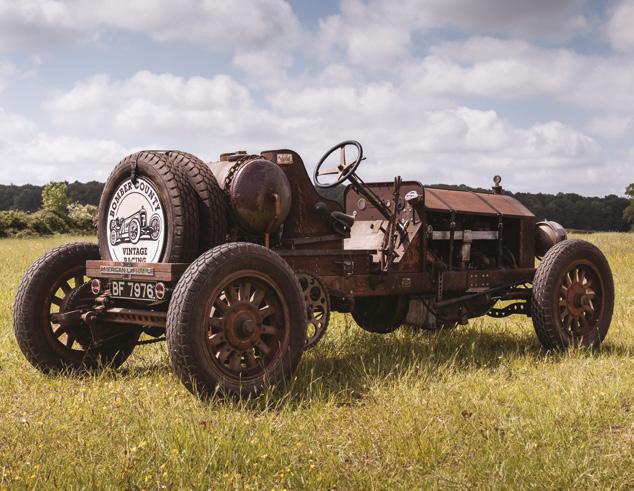
Estimate: £50,000 - £60,000*
Reg No: BF 7976 MOT: Exempt Chassis No: 5719
Forever synonymous with broken road surfaces, billowing dust clouds, drainpipe exhausts and terrifying drift angles, the ‘chain-drive era’ is for many one of the most romantic in motoring history. Indeed, it is not hard to see why some people go to such great lengths to recreate or mimic the leviathan racers of the Veteran and Edwardian ages. Designed for quite a different purpose, the chassis and running gear from American LaFrance fire appliances have long been sought after by enthusiasts who consider propshafts and the like a touch too ordinary, with huge displacement meeting chain drive in connection with wooden spoked wheels providing exhilarating excitement.
Manufactured new in Elmira, Chemung County, New York City in 1924, this now nearly 100-year-old vehicle began life as a Type 75 Fire Engine. Its post-service history is unknown until the LaFrance was discovered in a barn in Upstate New York in 2014. Subsequently shipped to the United Kingdom, chassis number 5719 was converted to a Speedster over a three-year period at great expense. This work involved significant reconfiguration, lowering the steering column, shortening the chassis by approximately 500mm, and inverting the rear springs. The brake drums were machined and new teeth were produced to fit the uprated chain gauge, with the brakes themselves also relined. The dramatic drive sprockets were fitted, with new wheel rims provided to the ALF but aged to look in-keeping (which were made at great cost and shipped from the United States). This included the spare wheel, with all six tyres being replaced in the last few years.
The vendor informs that ‘the view from the driver’s seat is almost unrivalled and offers a driving experience rarely attainable in the modern age’. The 900cu inch 14.5-litre sixcylinder T Head engine features valves on the outside of the engine in this configuration. To ensure reliability when attending a fire, the American LaFrance was built with a twin ignition system of coil and distributor, and also magneto. Both systems are currently operational. Chassis 5719 is a factory 12-volt model, which the vendor (who has owned both) informs ‘is easier to live with than 6-volt models’. A new water pump with stainless steel shaft has also been installed.
The colossal engine sends the power to the rear wheels via a three-speed manual gearbox and bronze differential. The petrol tank is now housed in a ‘chemical tank’ which was an early form of fire extinguisher that features highly decorative planished detail and cost over £2,000. Upon completion of the Speedster, it was sensibly upgraded with power steering to ease the driving experience, with the conversion from a David Brown tractor, and is fitted so as to be in keeping with the appearance of the overall vehicle. Interestingly, despite the scale of the vehicle, it can be transported on a standard car transporter trailer.
LaFrance Speedsters such as this rarely come to market, and with such visual appeal, it would surely grace any collection, or be an incredibly fun classic to use throughout the upcoming summer months.
136 *All hammer prices are subject to a Buyer’s Premium of 12.5% plus VAT
93


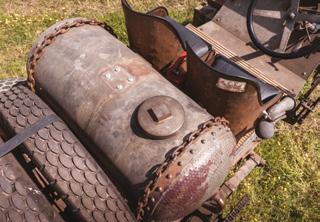


137
1989 Ford Thunderbird Super Coupe
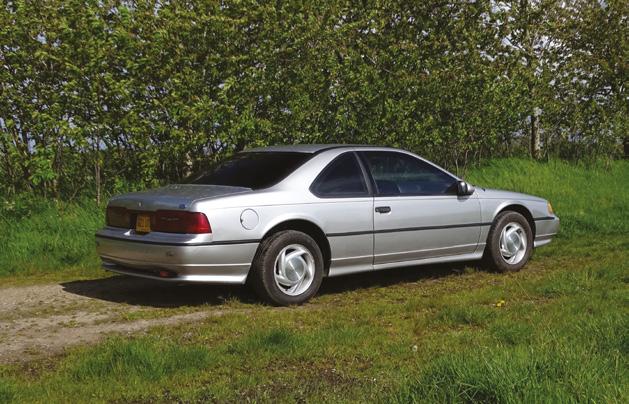
Ex-Aston Martin Lagonda Ltd. development car
Estimate: £10,000 - £15,000*
Reg No: G21 UTM MOT: June 2024 Chassis No: 1FAPP64R7KH151692
The tenth generation of the Ford Thunderbird was introduced on the 26th of December 1988 and was in production for the 1989 to 1997 model years. Alongside the Mercury Cougar it was developed on Ford’s new Mid-Size North American Project 12 (MN12) platform and featured a more aerodynamic body that, although featuring a nineinch-longer wheelbase, was slightly shorter in overall length compared to the 1988 Thunderbird. Featuring four-wheel independent suspension, with short-and-long arms (SLA) and a spring strut assembly in the front and multiple links in the rear, the car offered excellent handling and ride quality. This setup made the Thunderbird one of only a handful of American-built cars to offer a four-wheel independent suspension at the time. Due in part to its low coefficient of drag, the Thunderbird was relatively fuel efficient considering its overall size and weight. The fuel efficiency rating for the V6 powered car was noticeably better than that of Thunderbirds equipped with higher performance engines and gave the base V6-equipped Thunderbird a significant driving range. The high performance Thunderbird Super Coupe also known as Thunderbird SC was powered by a sophisticated, supercharged and intercooled version of the 3.8 L OHV V6. The Super Coupe was available with either a Mazda-derived, M5R2 5-speed manual transmission or an AOD 4-speed automatic transmission. In 1989, Motor Trend awarded the Thunderbird Super Coupe the ‘Car of the Year’ trophy, which Ford gratefully used in their advertising campaigns. Besides the more powerful engine, the Super Coupe came equipped with a range of unique features, underlining its higher performance character compared to standard Thunderbirds. Among these were larger alloy wheels with high performance tires, a Traction-Lok limited slip differential, standard anti-lock brakes, 4-wheel disc brakes, speed-sensitive variable assist steering, lower body side skirts and bumpers, fog lights, and a stiffer suspension with adjustable Tokico shock absorbers.
The Thunderbird SC offered here was built at Ford’s Lorain plant in the USA in March 1989 and delivered to Aston Martin Lagonda Ltd. on the 15th of September that same year. At the time, Aston Martin was working on the development of the V8 Vantage which would be introduced in 1992. As this car was being designed to be equipped with twin Eaton Superchargers and the latest Ford engine management control system, Aston Martin decided to purchase this Thunderbird SC to help them develop their own version of the system. Copies of correspondence with Mr Steve Waddingham, Aston Martin’s Company Historian, confirms the above and makes it quite clear that it’s very rare for a development car to survive in such good condition. Further correspondence from a local
Aston Martin Employee Facebook group shows that several (ex-) employees remember the car being used for tests. The final proof of provenance is the service booklet which has the details of Aston Martin Lagonda as the first owner and shows that the first couple of services were performed by AML themselves. Over the last few years, the car has been the subject of much expenditure on interior, exterior, engine, brakes and drivetrain. It received a full respray after having both sills replaced while the leather seats were refreshed and the headliner replaced. The brake calipers have been reconditioned with new pads fitted all round. An exchange gearbox was fitted at 107803 miles and the engine has had much care and attention lavished on it. Also, at 149,000 miles the odometer had to be replaced with a second hand one reading 67,796 miles as no new units were available. After the restoration, the car was invited by AML to attend their events and will surely be welcome to continue to do so in the future. According to the current vendor, the Thunderbird SC presents very well inside and out and drives as smoothly as it should. Offered with two sets of keys, a full-service pack with 34 stamps in the booklet (the first 2 of which are by AML) and an extensive history file with official AML correspondence and sheaves of invoices detailing all the work done, this is a rare opportunity to acquire an important piece of Aston Martin history, linked with the development of one of AML’s greatest cars ever, the V8 Vantage. A very special addition to any Aston Martin collection that will certainly get people talking!
138 *All hammer prices are subject to a Buyer’s Premium of 12.5% plus VAT
94

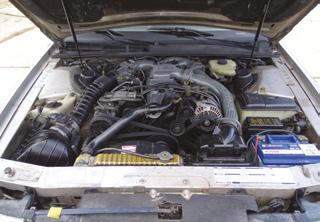

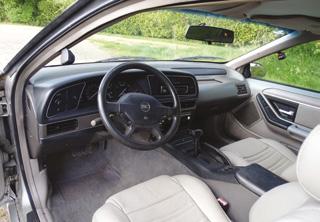
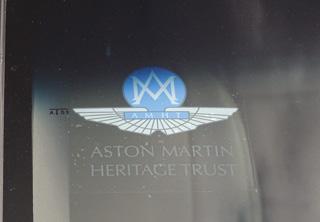
139
1972 Triumph Stag
Substantial but sympathetic renovation in 2016/2017
Estimate: £17,000 - £20,000*
Reg No: PMX 468K MOT: Exempt Chassis No: LD109750
Introduced in June 1970, the Triumph Stag was conceived as a luxury convertible sportscar to rival the likes of the R107-series Mercedes-Benz SL. As such, it came equipped with electric windows, power-assisted rack and pinion steering, and servo-backed disc / drum brakes as standard. Based around a two-door monocoque bodyshell (stylist Giovanni Michelotti had physically shortened a pre-production Triumph 2000 saloon in order to fashion the initial prototype), the newcomer featured all-round independent suspension (McPherson strut front / semi-trailing arm rear) and a well laid-out 2+2 cabin. Neatly integrated, the substantial roll-over hoop that joined the B-pillars gained extra strength from a T-bar link to the windscreen frame. With some 145bhp and 167lbft of torque on tap from its bespoke 2997cc SOHC V8 engine, the model was reputedly capable of 120mph. Available with a choice of four-speed manual or three-speed automatic transmission, all but the earliest Stags benefited from both a hard and a soft-top roof. Despite being in production for seven years, during which time 25,877 cars were made, a mere 9,500 or so are thought to have survived.
First registered on the 24th of February, 1972, this UK-market manual transmission Stag has continuously been well looked after by its custodians, as is evidenced by the accompanying big history file. Stacks of invoices dating back from recent days all the way to the early 1980s show that no expense has been spared on maintenance and restoration where needed. Still sporting its largely original and lightly renovated Champagne leather interior, ‘PMX 468K’ has now been resprayed in British Racing Green and comes with a matching factory hardtop and a recently renewed hood. The previous owner undertook a full body renovation and repaint in 2017/2018 and had chrome items refurbished or replaced where needed. The current vendor acquired the Stag in 2018 and set off on an improvement programme. He replaced the water pump and hoses, had new brake and clutch master cylinders fitted, replaced the engine mountings and had the front suspension rebuilt. The ignition was overhauled in 2019 as well. Offered with a substantial history file and a factory hardtop, this Stag is said by the vendor to be in very good condition and drives very well with a great exhaust sound and no cooling issues detected. An excellent choice for motoring excursions over the coming summer months.

140 *All hammer prices
of 12.5% plus VAT
are subject to a Buyer’s Premium
95

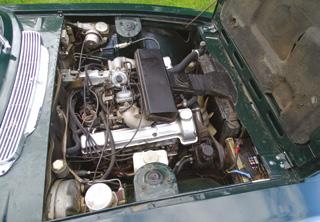
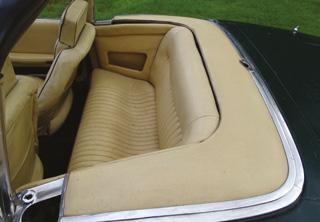
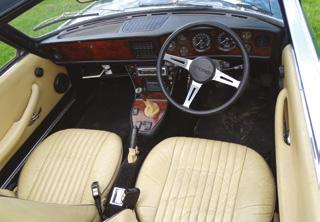

141
1964
Jaguar E-Type 4.2 Fixed Head Coupe
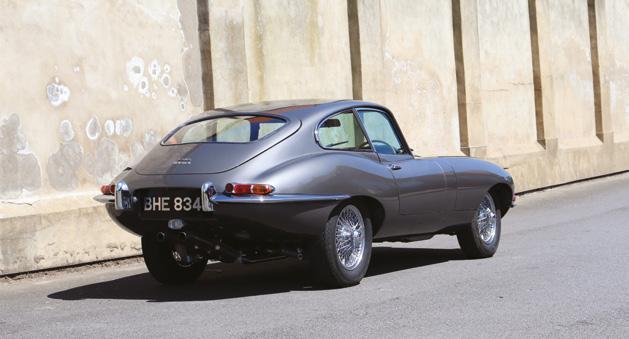
Estimate: £100,000 - £120,000*
Reg No: BHE 834B MOT: Exempt Chassis No: 1E30278
Triumphantly launched at the March 1961 Geneva Salon, Jaguar’s ‘150mph’ E-Type was the sports car that (a) put the swinging into the ‘swinging sixties’, (b) no lesser a man than Enzo Ferrari dubbed ‘the most beautiful car in the world’, and (c) transported a galaxy of stars from Brigitte Bardot to George Best, Tony Curtis to Donald Campbell and Roy Orbison to Steve McQueen. Though not designed as a racer, the E-Type was nevertheless a direct descendent of the all-conquering D-Type and thus had motorsport embedded in its DNA. Equipped with all-round independent suspension, rack and pinion steering and four-wheel disc brakes, its handling and roadholding proved more than a match for most rivals. Just one month from launch Graham Hill and Roy Salvadori drove the Equipe Endeavour E-Type (‘ECD 400’) to victory at Oulton Park and some fifty-six years later the model remains a force to be reckoned with in historic racing. Updated during August 1964, the Jaguar gained a larger 4235cc XK DOHC straight-six engine and more user-friendly manual gearbox with synchromesh on each of its four forward speeds. Thankfully, the Big Cat’s beautiful styling remained unaltered until the introduction of the so-called Series 1.5 cars during September 1967 by which time just 6,167 Series 1 4.2 Fixed Head Coupes had been made.
Notable as the final Jaguar E-Type restoration project to be embarked upon by the late Jeffrey Thomson of marque specialist King Edward Classic Cars, chassis 1E30278 was built on 30th November 1964 and despatched to Jaguar Cars, New York the following month. Repatriated some twenty-five years later, the Series 1 Fixed Head Coupe was extensively refurbished by Rushton Motor Services of Sheffield during 1990 including a conversion to right-hand drive. Subsequently put on display with The Classic Car Collection of Lanark, ‘BHE 834B’ was taken off the road in 2007 due to a water leak. Still immobile when purchased by Mr Thomson two years ago, he set about disassembling the car and stripping its bodywork to bare metal. Any corroded sections were cut out with the structure secured via a cradle to prevent distortion. Uprated with stiffened transmission tunnel and inner sill sections, the renovated sheetmetal was then carefully repainted in the period colour of Opalescent Silver Grey metallic. Numerous parts invoices on file from SNG Barratt and M&C Wilkinson attest to the thoroughness with which the steering, brakes and suspension were gone through (the latter being fitted with Gaz shock absorbers).
Rewired throughout and treated to numerous pieces of refinished brightwork, the Jaguar was re-trimmed in Red leather using a kit supplied by BAS International at a cost of £3,556.59. Sporting a replacement ‘big bore’ exhaust and riding on new wire wheels shod with fresh tyres, the E-Type has also benefited from the fitment of a correct-type and overhauled 4.2 litre XK DOHC engine (it had come back from the States with an earlier 3.8 litre unit in situ). The late Mr Thomson was justifiably proud of his restoration skills and of the fact he had passed them onto a younger generation. Scheduled to have a couple of very minor finishing touches completed by the time of sale (radio dash aperture etc), the Series 1 Fixed Head Coupe started readily and ran well during our recent photography session. Although, as ever a degree of de-bugging may be necessary after such a comprehensive rejuvenation. Available at a fraction of the cost that some bigger name Jaguar restorers would charge, ‘BHE 834B’ is worthy of close inspection. Offered for sale with V5C Registration Document, Jaguar Heritage Certificate and history file.
142 *All hammer prices are subject to a Buyer’s Premium of 12.5% plus VAT
96
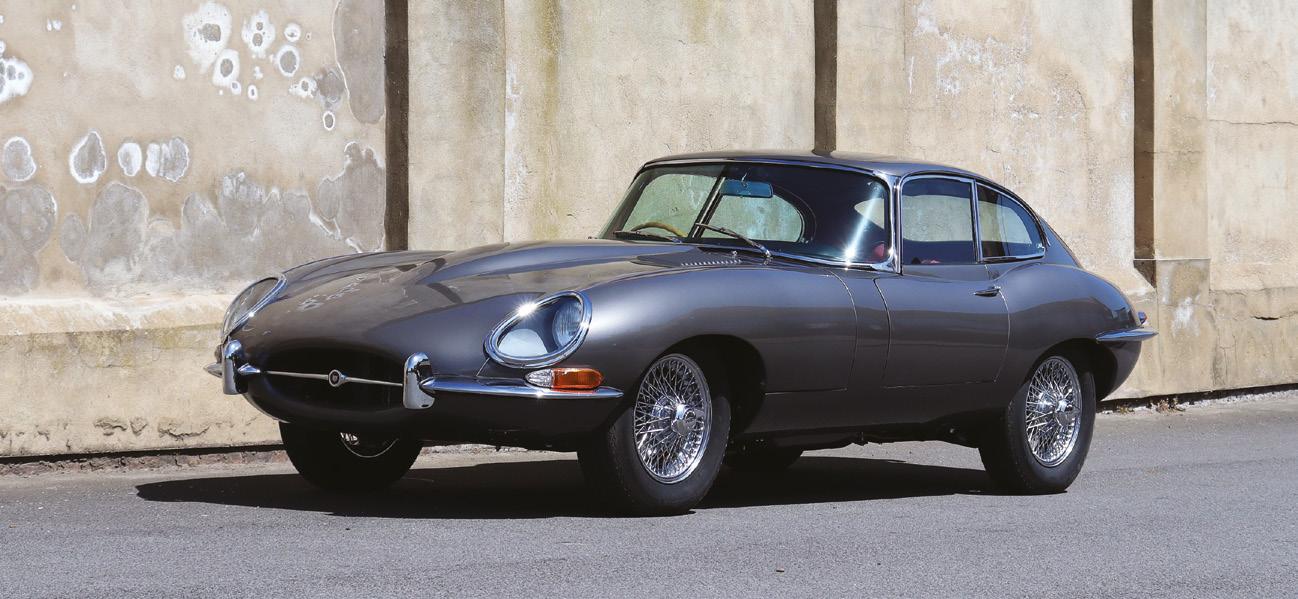

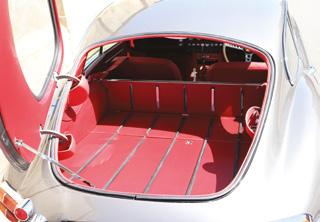
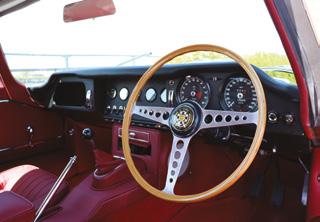
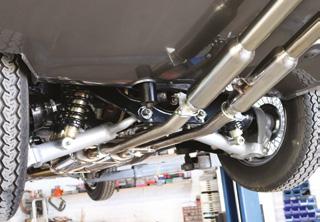
143


144
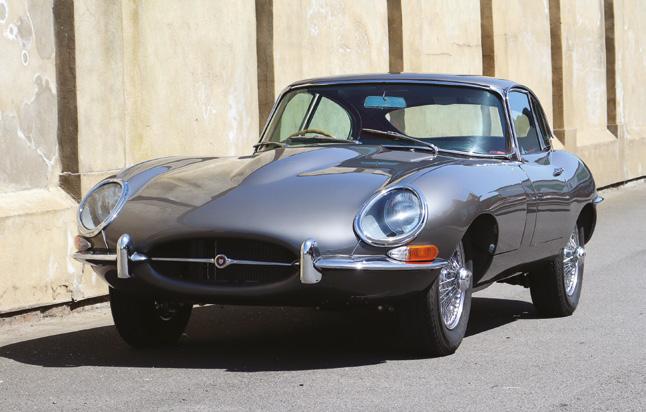

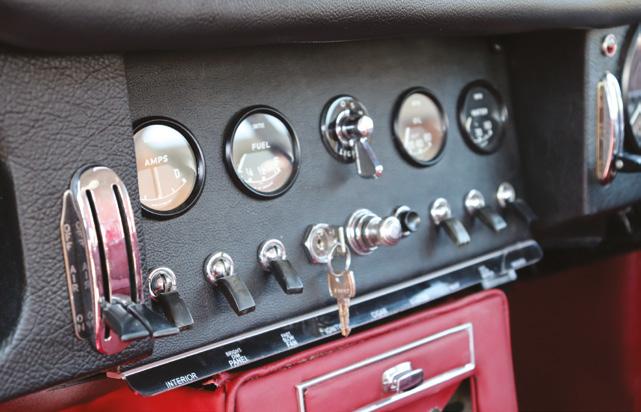
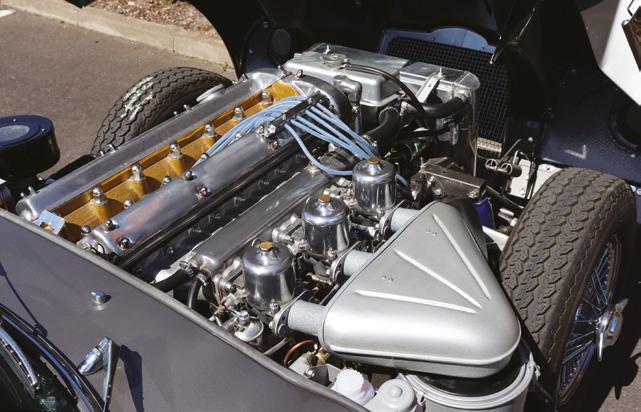
145
1956 Bentley S1 Saloon

Estimate: £30,000 - £35,000*
Reg No: OSF 666 MOT: Exempt
Chassis No: B426CK

The Bentley S1 was unveiled in April 1955. A very different car from its predecessors, it was longer and wider and based on a much stiffer chassis. Though the traditional body-on-chassis construction facilitated the manufacture of special-bodied versions, most were delivered with the standard offering produced by Pressed Steel Ltd, featuring alloy doors, bonnet and boot lid. Powered by the final iteration of the company’s venerable 4.9-litre straight six engine featuring revised cylinder-head porting, power was quoted at 178bhp. As standard, the unit drove through a four-speed automatic gearbox with steering column control. Suspension was independent at the front by wishbones and coil springs and employed a leaf-spring mounted live axle at the rear. Braking was by drums all round. A total of 3,107 examples were produced between 1955 and 1959.
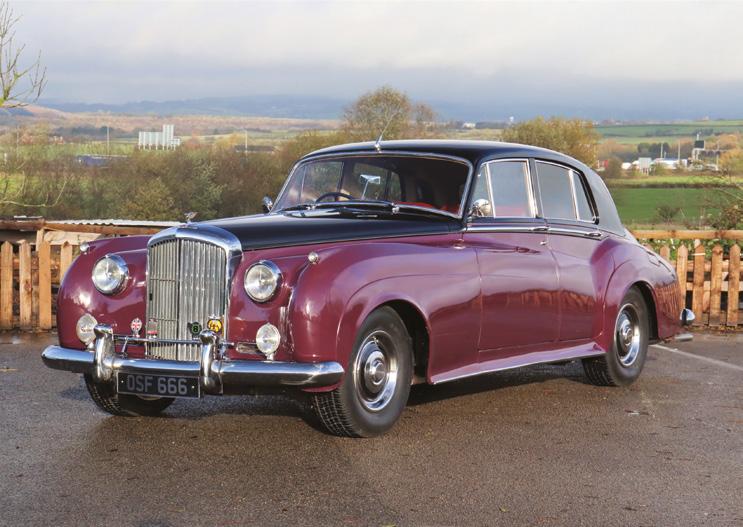
First registered in Edinburgh, Scotland, this 1956 Bentley S1 has resided in its current ownership, by a Rolls Royce and Bentley specialist, since 2014. In that period of ownership the ‘OSF 666’ has benefitted from attention to the body and the mechanicals. The S1 currently displays a mileage of 69,500 credible miles (at the time of consignment).
First to note is the bare metal bodywork restoration and repaint in Mason’s Black over a complementing shade of Plumb. As part of the restoration work, the S1 was given new boot and door seals. Inside, the contribution of the wood to the Bentley’s luxury was brought back by attention being paid to replacing the veneer, door cappings and the dashboard fascia. Mechanical fettling has been carried out in a number of areas in the current ownership, including a full service. To support the car’s longevity, the S1 also benefits from a stainless steel exhaust and stainless steel bumpers and wheel trims. Offered with a current V5C, an original handbook and a complete Bentley tool-kit accompanies this wellpresented S1.
146 *All hammer prices are subject to a Buyer’s Premium of 12.5% plus VAT
97
1937 Morris 8 Tourer
Estimate: £10,000 - £15,000*
Reg No: NXS 191 MOT: Exempt
Chassis No: S2E171009
Unveiled in 1935, the Morris Eight was better equipped than most of its competitors and boasted electric wipers, synchromesh on the upper two gearbox ratios and effective Lockheed hydraulic brakes. The range included both Two- and Four-Seat Tourers and was powered by a Morris UB series 918 cc four-cylinder side-valve engine with threebearing crankshaft and single SU carburettor with maximum power of 23.5 bhp (17.5 kW).
One of the former, `NXS 191’ has been the subject of a five-year restoration. The extensive restoration involved the supply of many parts by Ian Harris Morris Spares. Repainted in what is believed to be the original colour of Red, the Tourer also received a re-trim of the interior door cards and upholstery in complementing Red leather with matching Red carpets. New Black vinyl weather equipment was also crafted and fitted correctly, with a rear tonneau also in place. Whilst in restoration, the car has also benefited from a conversion to 12v. Mechanically, the Tourer has received an engine overhaul, including “white metalling” of bearing surfaces by Chase Engineering. Completing the restoration the owner had the lamps and the radiator grille and trim re-chromed and polished along with media blasting of the steel wheels before being fitted with new tyres. Subtle front and rear ‘motorcycle’ indicators have been fitted for usability and peace of mind on more modern roads. ‘NXS 191’ is offered with a collection of invoices and the original operations manual.
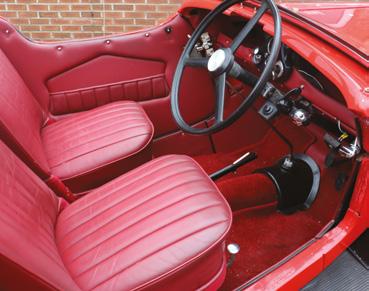
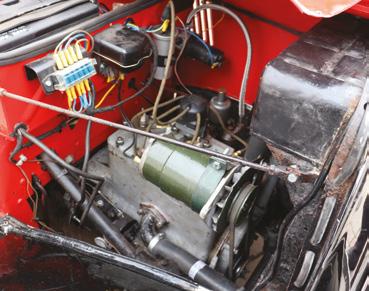

147 *All hammer prices are subject to a Buyer’s Premium of 12.5% plus VAT
98
1952 Peugeot D3A Van
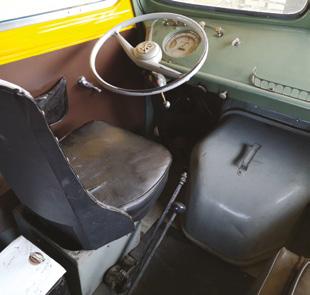
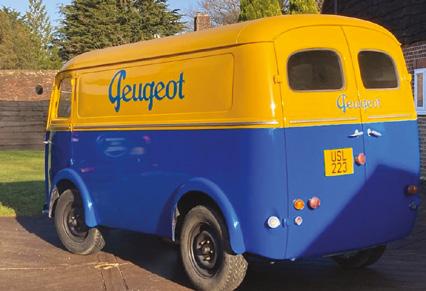

Estimate: £14,000 - £16,000*
Reg No: USL 223 MOT: Exempt
Chassis No: 1060254
Peugeot acquired the business of Chenard-Walcker in 1950 and with it the manufacturing rights to their range of front wheel drive light commercial forward control vans which, based on a wartime design, had been in production since June 1946. Chenard-Walcker’s CPV was initially powered by a two-cylinder water-cooled two-stroke displacing just 1021cc. However, the need for more power was soon met by the adoption of Peugeot’s 1133cc unit from the 202 model in 1947. Following the launch of Peugeot’s 203 range in 1950 the 1290cc engine from this model was quickly adopted and the D3 morphed into the newly designated D3A which now boasted an output of 32hp. In production for a further 15 years, little was to change in their physical appearance although larger power units were progressively fitted until production finally ceased in 1965.
The delightful and extremely rare 1290 cc example offered here is understood to have been restored around 1998 and currently displays some 46,000 km on its odometer. Finished in contrasting yellow over blue paintwork with grey interior, USL 223 was acquired by the vendor in 2008 from a Peugeot dealer in Sandbanks. Following its purchase the little van was given a thorough mechanical check over before entering his private collection where it has been regularly maintained by an exFormula 1 mechanic. Perhaps unsurprisingly, it is now described as having “excellent” bodywork, paintwork, engine, transmission and interior. Believed to be one of just four examples currently known in the UK, it is accompanied by a rare complete parts book, magazine articles and sales brochure. A charming and unusual van with bags of potential for business promotion or simply pure enjoyment!
148 *All hammer prices are subject to a Buyer’s Premium of 12.5% plus VAT
99
2003 Smart Crossblade
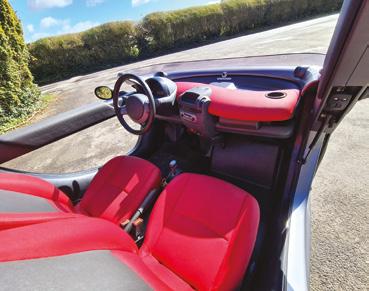
1 of only 2,000 examples manufactured
Estimate: £16,000 - £18,000*
Reg No: LK56 GSU MOT: April 2024
Chassis No: WME01MC012H092774
Promoted by Robbie Williams, the semi-automatic Smart Crossblade was originally an entirely waterproof concept car. Unveiled at the Geneva Motor Show in March 2001 as a concept vehicle, created under the mantra of “less is more”. Its small size and surprising power output moved it along in traffic, due in part to the fact that the car weighed a mere 1,600 pounds, thus making it rather nippy. Its introduction created such hysteria that Smart built a limited run of 2,000 individually numbered cars. Described as “an open leisure car uncompromisingly designed for blue skies and high spirits”, the concept had no roof, doors, or windscreen and it was more like a beach buggy. The clever packaging came from Mercedes-Benz, who designed the car for the Swiss Swatch Company and also supplied the base engines, which have been tweaked by Brabus to produce 70hp.
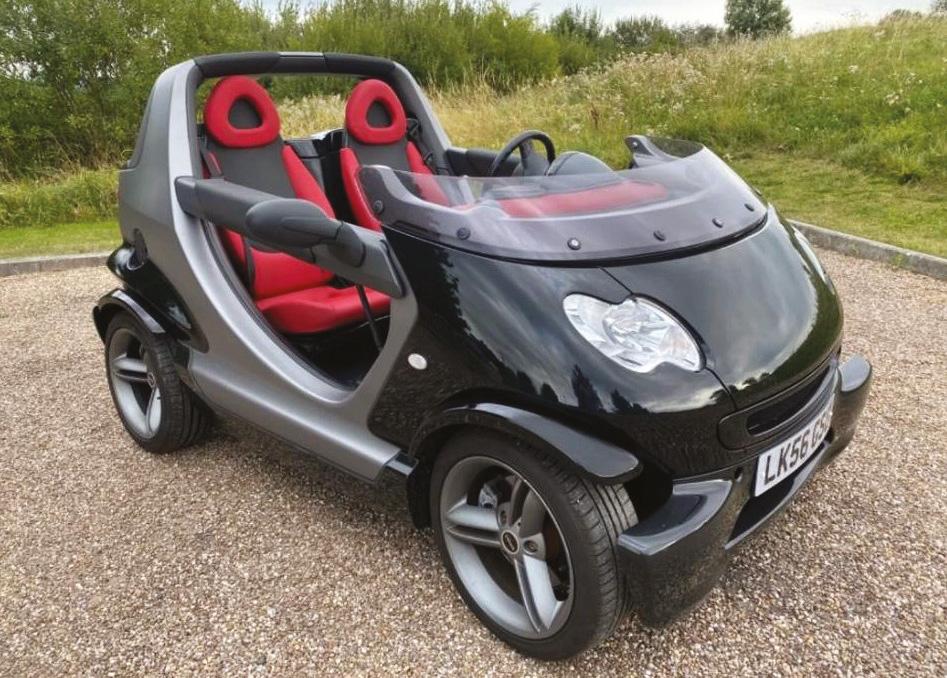
In order to be road legal in the UK, the Crossblade had to go beyond the norm to meet the stringent safety standards required, and with its reinforced steel shell, surprisingly scores higher safety points than the VW Polo. This example, a rust-free and very good condition example, originally supplied to Spain, was manufactured new in 2003. Residing in the sunnier climate until 2006, when it was imported to the United Kingdom. Having covered less than 10,000 kilometres from new, equating to c.6,200 miles, the low mileage Smart is number 1176 of the 2,000 examples manufactured.
The Brabus-tuned 599cc, three-cylinder engine in the rear is allied to a six-speed semi-automatic transmission. Typically presented in the attractive colour combination of Black with a Red interior, the futuristic, quirky design and unique limited edition, already has an international owner’s club on Facebook, and is likely to be a fast-appreciating classic. This is a rare opportunity to obtain one of just 2,000 Crossblades and would be perfect for summer’s day’s transport, fun trips to the beach, or an addition to a collection. Not one to be missed!

149 *All hammer prices are subject to a Buyer’s Premium of 12.5% plus VAT
100
2001 Bentley Arnage Red Label
Fitted with the rare factory sunroof
Estimate: £13,000 - £15,000*
Reg No: Y958 CGJ MOT: April 2024 Chassis No: SCBLC31E61CH05858
Introduced at the 1999 Frankfurt Motor Show, the Bentley Arnage Red Label boasted 835Nm of torque - more than any other production car! Powered by a revised version of the marque’s long-serving 6.75-litre V8 (albeit in turbocharged guise), allied to fourspeed automatic transmission, the newcomer was reputedly capable of 0-60mph in 5.9 seconds and 155mph. Further benefiting from a stiffer bodyshell, revised suspension and bigger brakes, the luxury sports saloon retained a tangible link to the Crewe-built Bentleys of the 1950s/60s, the last of 2,282 Red Labels was completed in 2005.
‘Y958 CJG’ was delivered to its first owner by Bentley Main Dealer Jack Barclay of Berkeley Square, London on the 1st of March 2001. Finished in a bright Silver, with a Magnolia Connolly hide interior piped in dark grey, this Arnage Red Label was ordered with the rare factory sunroof and special order walnut veneer panels to all doors. The Service Record Book details servicing by Bentley Main dealers Jack Barclay from new, followed by Harwoods of London, Jack Barclay again, Broughtons of Cheltenham and Bentley Birmingham, before Bentley Specialist Bowling-Ryan took over in 2016. After being acquired by the current vendor in 2018, ‘Y958 CJG’ was serviced by Roade Main Garage. The service invoices in the History File show that ‘Y958 CJG’ had the dreaded head gaskets replaced in 2015 as these were a known and expensive weak spot in the engine design for these cars. This Red Label is offered with two sets of keys, the complete owners pack, containing the aforementioned Service Record Book, the Owner’s Handbook and the Service Handbook, a current V5C and a comprehensive History File containing old MOTs and a sheaf of invoices detailing work done to the car. Presenting very nicely, according to the vendor, and driving well during the photoshoot with no warning lights showing, this Red Label offers a lot of car for the outlay.

150 *All hammer prices are subject to a Buyer’s Premium of 12.5% plus VAT
101
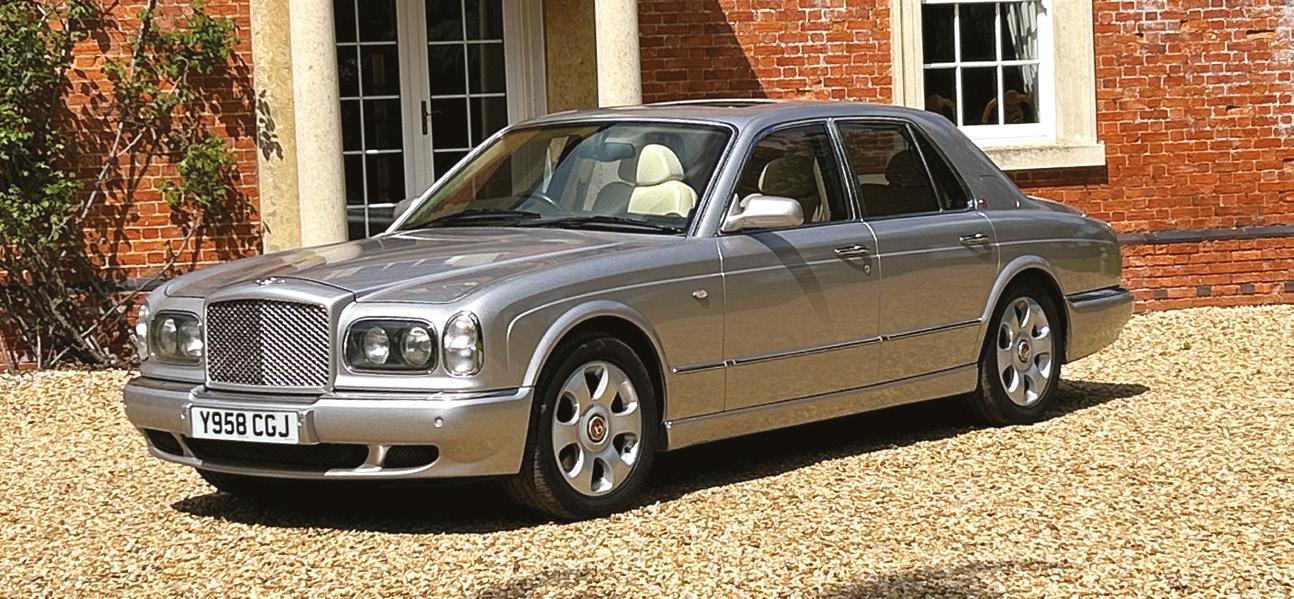
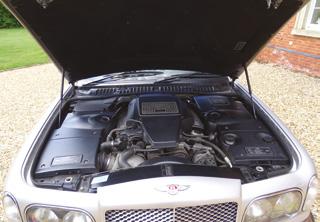

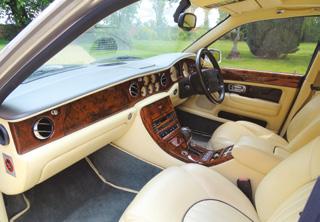
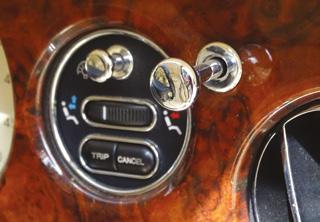
151
1976 TRAC SS100
Estimate: £45,000 - £55,000*
Reg No: UBJ 984R MOT: Exempt Chassis No: TRAC20032
Widely regarded as one of the most beautiful cars ever made, the Jaguar SS100 has been an object of desire for more than eighty years. Due to its rarity and value the model has inspired numerous imitations. Though, few - if any - have been as aesthetically accurate as the cars built by Terry Rowing of TRAC Engineering. By the late 1980s Rowing had established an enviable reputation for restoring genuine SS100s and learnt how to remanufacture components such as the solid brass chromed radiator surround, alloy louvered bonnet and folding windscreen etc. Deciding to create a Jaguar XJ6-based SS100 Evocation that combined the style and feel of the original with more modern road manners, he approached current Red Bull F1 designer Adrian Newey (a customer at the time) for permission to take precise GRP body moulds from the latter’s superb 1938 car. Unveiled in late 1990 the resultant TRAC prototype was well received by the motoring press. The production version was predominantly supplied in ‘home-build’ form at the rate of four a year until 1996 when the manufacturing rights were purchased by Roger Williams of Suffolk Sportscars.
Finished in Deep Red Metallic with Black leather upholstery, chassis TRAC20032 reportedly took its previous keeper several years to assemble. A professional engineer, he incorporated such niceties as a bespoke ignition lead holder (with engraved ‘leaping cat’ motif), Getrag five-speed manual gearbox, limited slip differential and polished cam covers for the 4.2 litre straight-six engine etc. Entering the current ownership in 2008, ‘UBJ 984R’ has been correctly re-registered with the DVLA as a ‘TRAC SS100’. Showing some 26,500 miles to its odometer which is thought to represent the total covered since completion, the two-seater started readily upon inspection. Fitted with correcttype Lucas QK596 headlights, horns and ‘owl eyes’ rear lights not to mention a bank of silver-faced ‘SS’ instruments, ‘UBJ 984R’ was featured in the Jaguar Enthusiasts’ Club magazine during August 2008. Offered for sale with V5C Registration Document and history file.
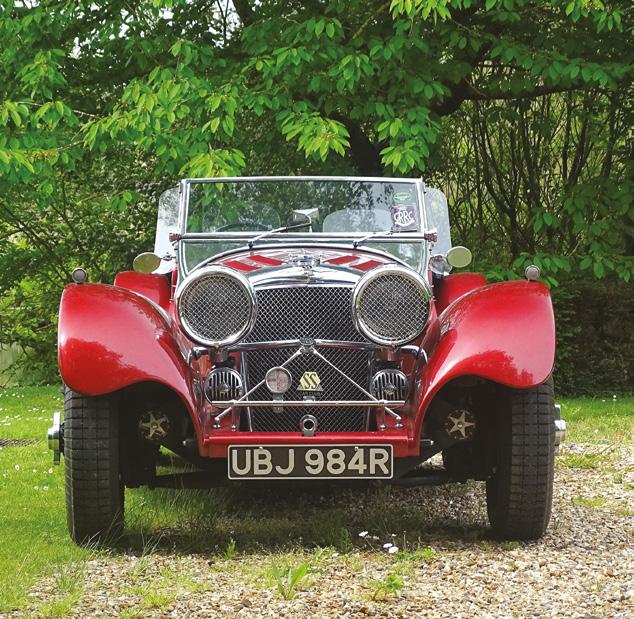
152 *All hammer prices are subject to a Buyer’s Premium of 12.5% plus VAT
102

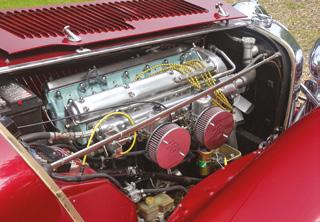
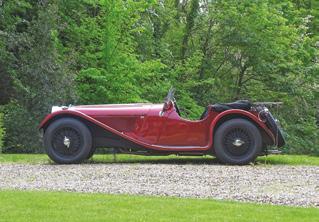

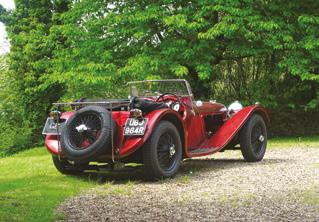
153
1925 Rolls-Royce Phantom I Three-Position Drophead Coupe
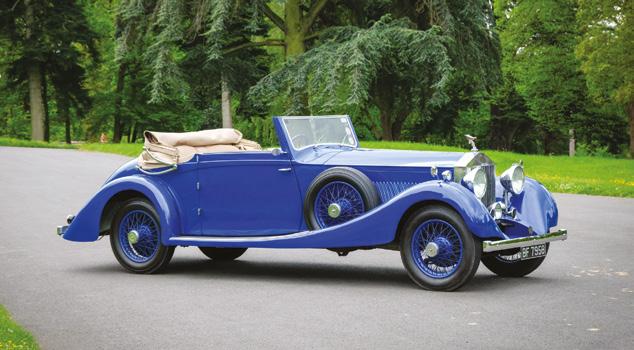
Coachwork by Southern Motors
Estimate: £60,000 - £80,000*
Reg No: BF 7958 MOT: Exempt Chassis No: 126LC
By 1925, the Rolls-Royce Silver Ghost was overshadowed by more advanced luxury cars, prompting Henry Royce and sales manager Claude Johnson to develop a new contender for the title of ‘best car in the world.’ Intense competition among car manufacturers and coachbuilders drove the demand for faster chassis and more extravagant coachwork. To ensure their cars could accommodate the finest bodies, Rolls-Royce introduced the ‘New Phantom.’
The New Phantom inherited key features from its predecessor, including a tapered channel-section chassis, four-speed manual transmission, supple springing, and innovative gearbox-driven servo-assisted four-wheel brakes. However, its 7668cc engine was entirely new and boasted a remarkable 33% increase in power compared to the Ghost’s unit. The engine featured overhead valves and remained exclusive to the UK until 1929, with 2,269 chassis delivered by that time.
This 1926 Rolls-Royce Phantom I carries a noteworthy historical background, with connections to prominent entities and individuals. Originally, it was delivered to N.V.
A.G.A.M. (Algemene Garage en Automobiel Maatschappij), the esteemed Dutch RollsRoyce importer, for display purposes at the 1926 Amsterdam Motor Show. N.V. A.G.A.M., located at No 9 Hofweg, Den Haag, held a significant position, opposite the entrance to the Dutch Houses of Parliament.
An advert from 1923 reveals that A.G.A.M. had a 40/50hp Landaulette Limousine by the Dutch coachbuilder Van Rijswijk in stock. This suggests a business relationship between the two companies at the time of 126 LC’s delivery. Van Rijswijk was known for constructing only a handful of bodies on Rolls-Royce chassis, making the presence of a Phantom I in their 1929 advert highly likely to be 126 LC with its all-weather tourer body. It is improbable that they produced two similar bodies on different chassis.
The car found its first owner in 1926, Mr. Otto Frederik Weise. Born in Rotterdam, Holland, in 1884 to German parents, Mr. Weise resided in the affluent Wassenaar area of Den Haag at Villa Meyland. Notably, Villa Meyland was later acquired by the government of India in 1953 and remains the ambassador’s residence to this day. Mr. Weise was also a coowner of Weise & Co., a prominent trading company with a sizable warehouse located at the docks in Rotterdam.
Based on historical records, it is likely that Mr. Weise retained ownership of the car until the late 1920s, as there are invoices indicating shipments of parts to Paris in his name. A black and white photograph from the late Bernard King’s archives showcases the car in a light color, featuring a royal crest on the door. Labeled as ‘1935 India,’ it suggests that the car underwent rebodying in the 1930s by the Southern Motor Company before being shipped to its new owner in India. Eventually, it found its way to South Africa in 1945, adding another chapter to its storied journey.
Little is known of the car since, but some correspondence within the history file from a previous owner, Ian G Middleton of Parkwood, Johannesburg states the car was being restored in 1995. Invoices from Fiennes Restoration would suggest the carburettor air valve unit was sent to the UK for overhaul in 2003.
Purchased by the current owner in November 2014 and imported to the UK, ‘126 LC’ has remained part of a private collection and in current ownership has been looked after by RR&B Garages Ltd, with extensive mechanical fettling and bodywork adjustments between 2016-2017. More recently, the car has been in the care of Fisher Restoration; stored and serviced as required for the vendor.
Accompanied with the vehicle is a history file containing the Rolls-Royce build records, copies of clearance and import documentation, a small collection of invoices, various communica
154 *All hammer prices are subject to a Buyer’s Premium of 12.5% plus VAT
103


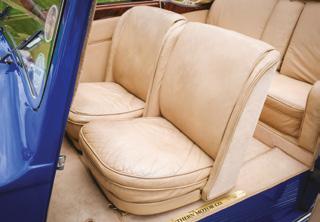


155
1957 Bentley S1 James Young Coupe
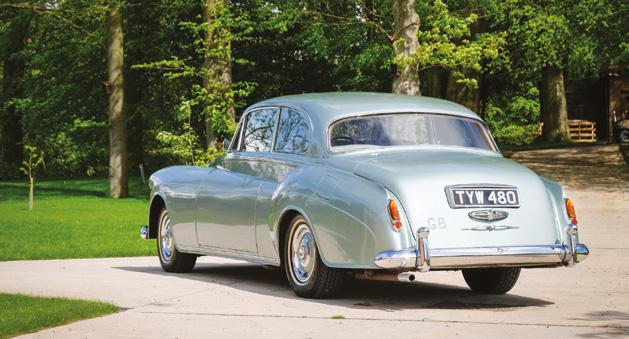
One of just three cars manufactured to design ‘B20SR’
Estimate: £65,000 - £80,000*
Reg No: TYW 480 MOT: Exempt Chassis No: L/B207CM
Originally ordered through Jack Barclay as a James Young 4-door saloon by Percy C. Henderson of Little Warley, Essex, the order for this particular example was changed at the last minute by the customer, having seen the graceful two door car under construction. Delivered in June 1957 and one of just three James Young Coupes ever manufactured, this particular example was presented in the attractive colour of Glasso Green with matching Green-Grey leather interior and featured power-assisted steering, as well as last minute additions of a sliding sunroof, pipe ashtray, rear window de-mister and a grey rubber mat on the front floor. At £6,474 and 17 shillings, this rarity came at a price, which was around 50 per cent above the ‘Standard Steel’ model, virtually the same price as the Continental model and one that would have bought four Jaguar MkVIII Saloons!
Henderson would keep the car for two years and so would Colonel A B McGhee of Wimbledon, before it would pass to Howes & Jackson until 1979 and then to America for a period until its repatriation to the UK in 1989 with a Richard John Edwards of Telford. Another two-year ownership period would span, before ‘TYW 480’ would pass to Mr John C. Brown of Letchworth. The ownership history is picked up in February 2004 with an Ian Dickson and shortly after an A V Smith that same year, who would keep the car for ten years until it was sold to the current owner through H&H Classics.
Purchased by the vendor from our Rockingham Castle sale, in June 2014, ‘TYW 480’ was shortly after subject to extensive fettling and improvement works to bring the car up to the standard required with both Castec Motor Services and Penso. This included the headlining and interior being re-trimmed in December with over 320 hours labour on the interior alone. The cost of these works totalled £17,401. Next would be a replacement sliding sunroof and carpets in January 2015 at a cost of £6,055 and a month later the plexiglass rear screen was replaced with a hand-made item at a cost of £7,525. Additional items would follow, including a replacement Radiomobile stereo, replacement steering box, the addition of electronic ignition and extensive mechanical works. Overall, ‘TYW 480’ has been subject to over £47,350 expenditure in current ownership. Now offered for sale due to lack of use, this presents an opportunity to acquire perhaps one of the rarest James Young Bentleys to be manufactured.
Included with the vehicle is a comprehensive history file spanning two ring-binders. Within these are copies of the build sheets and full build history from James Young, including costing sheets, extensive letters between the customer, James Young and Jack Barclay, plus information on various changes made during production. A photocopy of the workshop manual is included, along with pages found in research undertaken by the vendor since purchase; including print-outs of previous listings, ownership details, a catalogue from when the vehicle was purchased along with bidding card and more. Bentley Driver’s Club communications are also included, some fuel records in current ownership, further invoices dating back to 2004, with accompanying previous MOT certificates and the V5C document which displays 6 former keepers.
156 *All hammer prices are subject to a Buyer’s Premium of 12.5% plus VAT
104

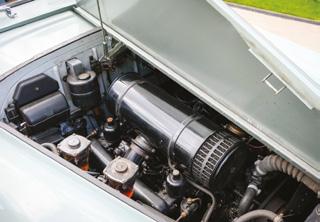
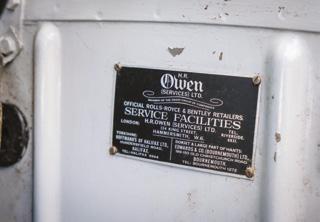
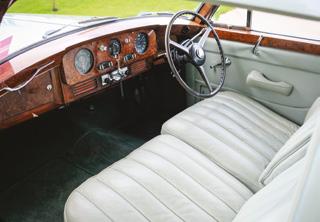

157


158
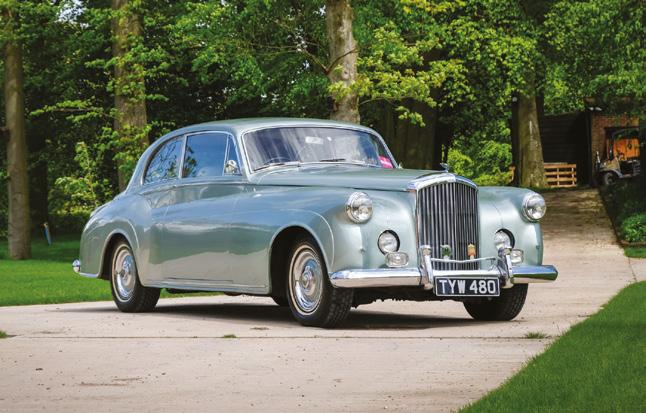


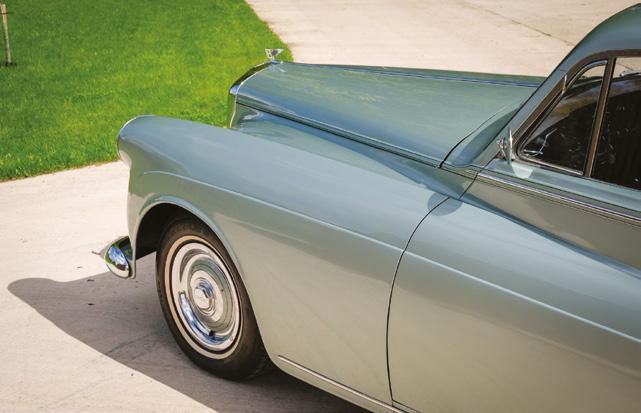
159
1999 Bentley Azure
Only 38,000 warranted miles from new Estimate: £50,000 - £60,000*
Reg No: T998 SGP MOT: April 2024 Chassis No: SCBZK15E5XCH61729
The first generation Bentley Azure Convertible was conceived while the company was still under Vickers management and produced from 1995 to 2003. Debuted at the 1995 Geneva Salon, it was based on the platform of the highly successful Continental R, and combined the glamour of the company’s early coachbuilt Drophead Coupes with modern-day technology and performance - a heady cocktail for those lucky enough to afford it. The car’s presence was immense, born of the combination of automotive elegance and sheer size - the Azure was 210 inches long. Sculptured seats ensured the optimum cosseting for up to four adults. This was the height of luxury. At the heart of the Azure, as of so many post-war Bentleys and Rolls-Royces, was the Group’s mighty 6.75-litre OHV V-8 engine complete with Garrett AirResearch turbocharger and Zytek EMS3 digital engine management. The unit drove through a General Motors-sourced four-speed automatic transmission. With some 400bhp on tap and in excess of 600lbft of torque, the 0-60mph dash could be dispensed with in around six seconds, despite the car’s generous all-up weight of 5,750 pounds. Speeds of up to 150mph were possible when allowed, doubtless without a ripple on a glass of champagne. Suspension was independent front and rear with adaptive ride control. Final assembly of the model took place at the Rolls-Royce factory in Crewe.

This stunning Azure was delivered By Jack Barclay of Berkeley Square to Rosenblatt Solicitors in London on the 15th of April 1999. Finished in Silver Pearl with a Black Connolly hide interior and black hood, the car was ordered with the optional bright matrix grille, a cellular telephone and wrap-over veneered door cappings. In October 2003, the Azure was sold to its second owner in Reading who kept the car until September 2014 at which point it was exported to Spain where the third owner lived. The fourth, and current owner, repatriated the Azure in February 2022 and is now offering it for sale as a result of a refocus of his collection. The service booklet which accompanies the car shows 13 stamps by main dealers Jack Barclay, Broughtons of Cheltenham and Harwood’s from new up to 34,978 miles in 2012. Invoices on file show that the car was entrusted to Bentley Madrid during its stay in Spain. The current vendor had the car recommissioned and serviced by Bentley Specialist Silver Lady Services Ltd and official Bentley Coachbuilder Wilcox Limousines.
Over the last year the car has received a new battery, a replacement power steering ram, new track rods and new Avon tyres. Furthermore, the rear suspension gas spheres were replaced and a new aerial and brake pads were fitted. Showing only 38,000 warranted miles, this absolutely stunning Azure is offered for sale with two sets of keys, the aforementioned stamped service booklet, and a history file containing invoices for work carried out and a current V5C.
160 *All hammer prices are subject to a Buyer’s Premium of 12.5% plus VAT
105

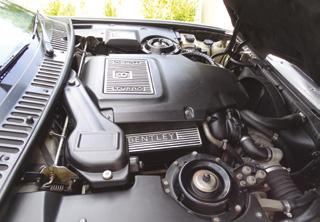

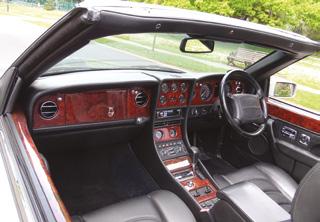
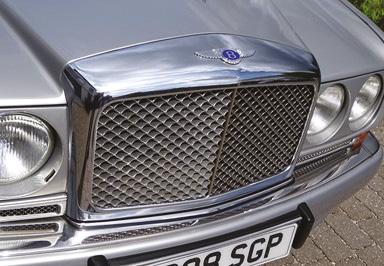
161
1930 Packard 733 Standard Eight Roadster

Delivered new to Australia
Estimate: £70,000 - £80,000*
Reg No: BF 4548 MOT: Exempt Chassis No: 291178
By the end of the 1920s, Packard had arguably become the last word in American automotive fashion. Outselling rival Cadillac by three to one, its distinctive tombstone grilles graced the drives of many a business tycoon, film star and politician. Yet behind the glitz Packards remained machines of real substance, the marque recording a whole host of US car industry firsts including: the steering wheel, H-pattern gearshift, V12 engine, thermostatic engine cooling, four-wheel brakes, hypoid rear axle, air conditioning, automatic overdrive, and torsion bar-suspension. Responsible for maintaining the Detroit firm’s preeminent position, the Seventh Series Packards were introduced on August 20th, 1929. Visually distinguished by a more voluptuous wing line which better matched the era’s prevailing Art Deco sensibility not to mention a thermostatically controlled radiator grille and subtle lighting changes, the newcomers were engineered to the same exacting standards as their predecessors.
The Standard Eight range was powered by a 385 cu in (6.3 litre) 106hp straighteight engine allied to four-speed manual transmission. Riding on supple leaf-sprung suspension and benefiting from four-wheel assisted mechanical drum brakes, the Model 740 allied authoritative performance to impressive refinement. Featuring a redesigned water pump and twin fan belts for improved cooling not to mention a more efficient Bijur chassis lubrication system that via its ‘Pull Daily’ dash control was reputed to do the work of ‘43 men with 43 oil cans’, the Standard Eight could be had with a wide variety of open and closed coachwork. Sporting a fold-flat windscreen, retractable rumble seat, golfer’s locker, high belt / low roof line, twin-blade bumpers and dual side-mounted spare wheels, the Model 733 Roadster was wonderfully rakish. Lighter and more self-indulgent than its siblings, the 2/4-seater was priced at an equally luxurious $3,190. However, even Packard could not escape the effects of The Great Depression with production totalling 28,386 cars in 1930 (some 40 percent down on previous years).
Offered here is a rare right-hand drive Packard Standard Eight with the chassis number 291178. It was originally delivered new to Australia in 1930, making it a unique and historically significant vehicle. During the Second World War, it was repurposed as a pickup truck, likely for utilitarian purposes given the circumstances of the time. However, after the war, the Packard underwent a restoration, and an original U.S-built Packard Roadster body, supplied by Kellow-Falkiner of Melbourne, was meticulously fitted back
onto the chassis. This restoration process aimed to restore the Packard to its original glory and highlight its timeless design. One notable feature of this Packard Standard Eight is the inclusion of a dickey-seat, which is complemented by a very rare fold-out rear screen. This feature adds to the uniqueness and charm of the vehicle, allowing for an intimate and nostalgic driving experience. Despite its age, this Packard Standard Eight still maintains an exceptional appearance and overall condition. While it has undergone an older restoration, the vehicle has been well-preserved and presents itself impressively well in all respects. Its exterior boasts a stunning shine, and the interior exudes a sense of luxury and comfort. The current vendor acquired this Packard Standard Eight in 2007 and has since taken great care of it, ensuring its proper maintenance and upkeep. The vehicle has been meticulously maintained to keep it in optimal mechanical order, ensuring smooth and reliable driving experiences. To summarize, this rare right-hand drive Packard Standard Eight, chassis 291178, holds a significant place in automotive history. Delivered new to Australia in 1930, it underwent various transformations, including a stint as a pickup truck during the Second World War. Restored with an original Packard Roadster body, it now boasts a unique combination of elegance, craftsmanship, and historical significance. With its rare fold-out rear screen and well-preserved condition, this Packard Standard Eight is a highly desirable collector’s item for vintage car enthusiasts.
162 *All hammer prices are subject to a Buyer’s Premium of 12.5% plus VAT
106
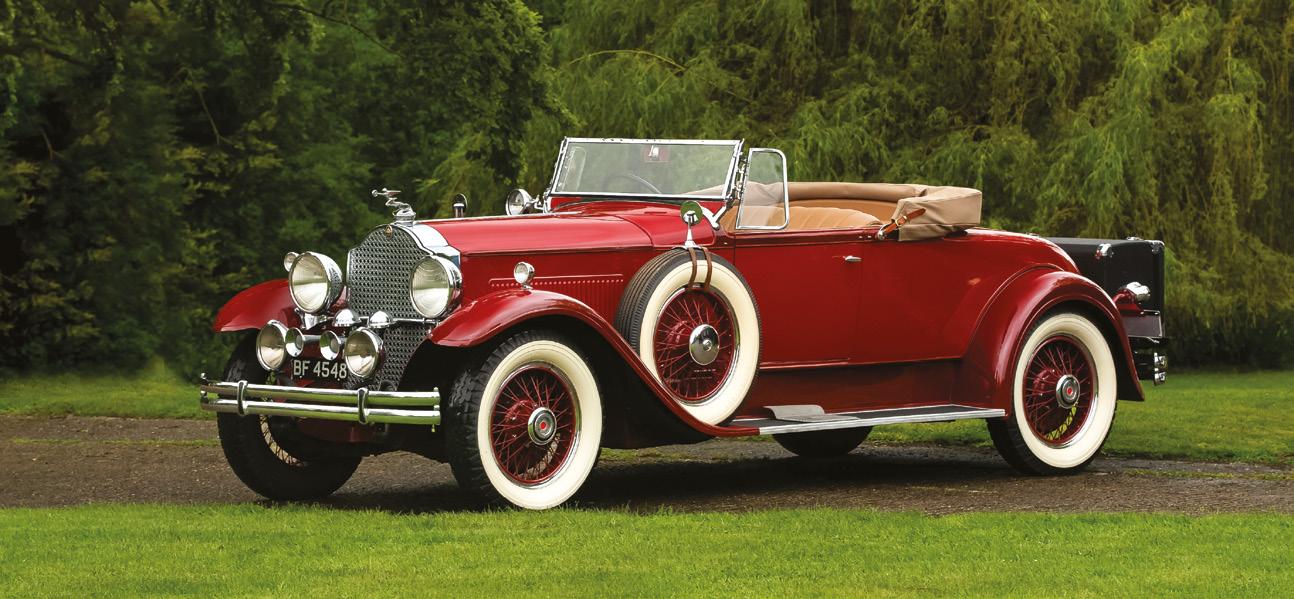

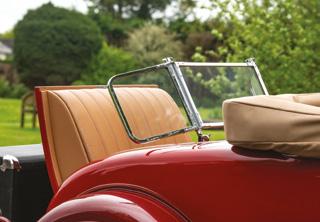

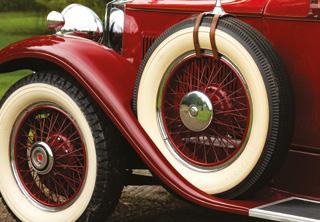
163


164
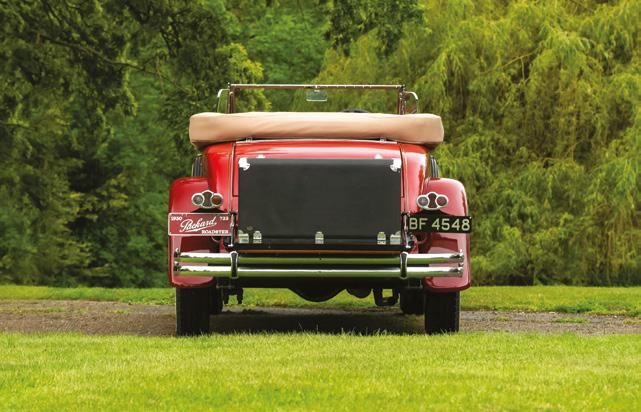
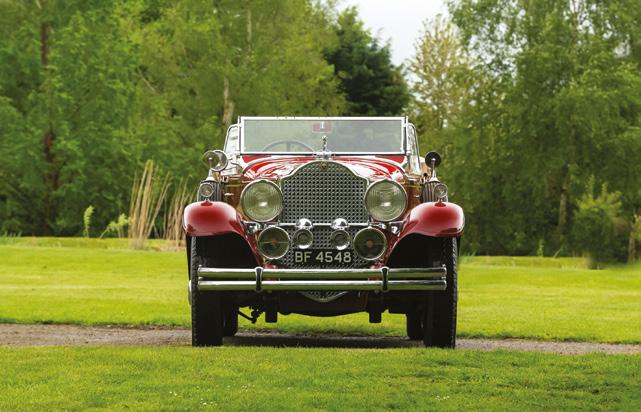

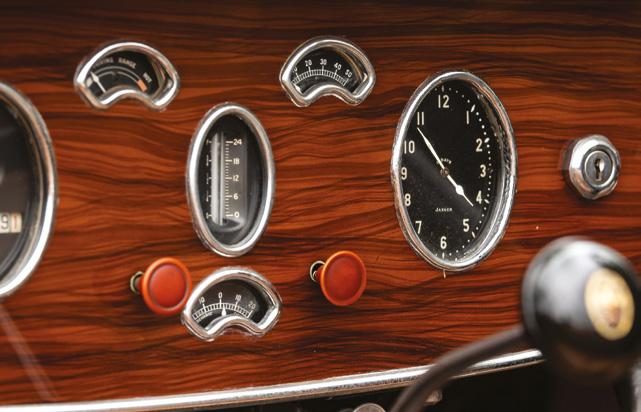
165
1988 Jaguar XJ-S 3.6-Litre Coupé
2018 Jaguar Drivers’ Club ‘Champion of Champions’ Concours winner
Estimate: £14,000 - £18,000*
Reg No: B8 NHB MOT: March 2024 Chassis No: SAJJNAEC3CA157474
Introduced in October 1983, the Jaguar XJ-S 3.6 was intended to be a sharper, more sporting foil to the range’s established, soporific 5.3-litre V12 model. To emphasise the difference, it was fitted with a five-speed manual Getrag gearbox as standard. With some 225bhp and 240lbft of torque on tap courtesy of its 3590cc DOHC 24 valve straight-six, the claimed 140mph top speed and 0-60mph time of 7.4 seconds were a near match for the V12. Yet when such performance was not called upon, it could reputedly return thirty miles per gallon, a feat beyond the V12’s capabilities. A revised, more positive feel to the power steering improved the handling still further.

Delivered new on 7th February 1989, this XJ-S was ordered in Glacier White with an Isis Blue leather interior and fitted with an automatic transmission. After passing through the hands of only a few owners, ‘B8 NHB’ was acquired by the current vendor in February 1998 with only 33,805 miles on the odometer. Having originally bought it as a daily driver, the excellent condition of the car didn’t go unnoticed to fellow Jaguar Drivers’ Club members and the vendor was soon asked to enter the car for the club concours.
Having been bitten by the bug, the vendor then set out to make the car as close to perfect as possible, with multiple concours wins as a result. The crowning glory came in 2018 when the chief executive of Jaguar Land Rover presented the Jaguar Drivers’ Club ‘Champion of Champions’ to our vendor. Since then the Jaguar, although sparingly used, has still been meticulously maintained and stored in a temperature controlled garage to preserve it in the near perfect condition it is in today. Now showing only 67,832 miles on the odometer, the car is offered with a large history file documenting over £40,000 spent on maintenance and improvements, mainly by marque specialists David Lindsay Classics, a Jaguar Daimler Heritage Trust Certificate, old MOTs, full toolkit, jack and a current V5 document. With this many accolades bestowed upon it, this could be the best XJ-S extant.
166 *All hammer prices are subject to a Buyer’s Premium of 12.5% plus VAT
107

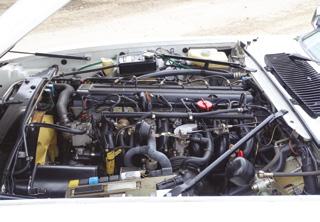
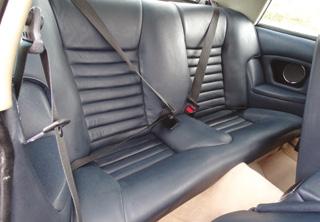

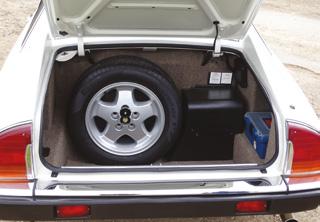
167
1960 Bentley S2 Continental H.J.
Mulliner Coupe
One-off design, built for Capt. R.G. McLeod
Estimate: £170,000 - £220,000*
Reg No: DBB 993B MOT: April 2024 Chassis No: BC106AR
The Bentley S2 Continental was introduced in July of 1959 and proudly displayed at the London Motor Show two months later. It was outwardly indistinguishable from the S1 aside a very slightly shorter radiator, and minor changes to the front flasher and sidelight assemblies, and the bumper over-riders. The key upgrade lay under the lengthy, centrally hinged bonnet, where a new all-alloy OHV V8 engine of 6,230cc sat in place of the former six-cylinder unit. It had been developed over five years and, despite the significant increase in cubic capacity, was no heavier than the cast iron unit it replaced. As usual, the manufacturer declined to quote output figures, but suffice to say that performance was markedly improved, and the newcomer could waft its cosseted occupants to 60mph in around 10.9 seconds and on to a terminal speed in excess of 110mph.
Gone was the one-shot lubrication system that had been part of every Bentley’s specification since 1933 - in its place were 21 grease nipples and extended service intervals. The interior featured a slimmer, altogether smaller steering wheel, a 120mph speedometer and air louvres below the windscreen. The extraordinary standard of exterior finish, for which the model was renowned, remained completely unaltered, however, with each body receiving up to 14 coats of paint, plus a high degree of hand finishing. The Continental version sported a slightly higher rear axle ratio, wider tyres and front brakes with four shoes per drum, in deference to the higher speeds at which these models were normally driven. H.J. Mulliner and Park Ward together constructed some 346 S2 Continental bodies, while James Young, Hooper, Graber and Franay accounted for a further 30 or so. The S2 gave way to the quad-headlamp S3 model in October, 1962.
The iconic fastback styling that H.J. Mulliner had wrought for the R-Type and S-Type Continentals was looking a little dated by 1959. Nevertheless, the Chiswick-based concern remained the coachbuilder of choice for the S2 Continental and their two-door Sports Saloon (design number 7514) has long since been acknowledged as a classic; Martin Bennett referring to it as ‘outstandingly beautiful’ and ‘arguably the best looking of all Bentley Continentals’ in his book ‘Bentley Continental, Corniche & Azure’. Punctuated by a ‘Flying B’ - topped radiator grille, subtle swage line detailing and notably airy glasshouse (incorporating wraparound front / rear windscreens), the singularly elegant silhouette that H.J. Mulliner bestowed upon its newcomer also fulfilled customers’ requests for increased luggage space.
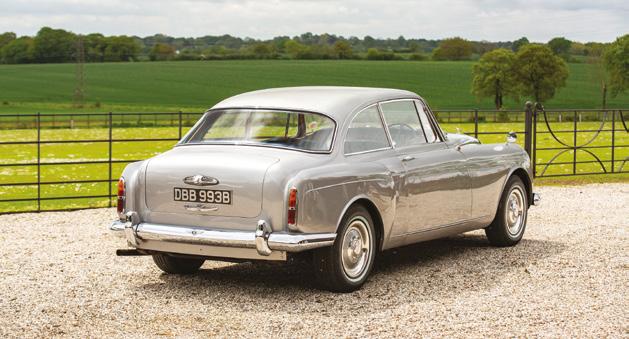
Predictably exclusive and expensive, just 71 right-hand drive Bentley S2 Continental chassis were bodied to design number 7514.
The car offered here today, chassis BC106AR, was delivered in June 1960 by London dealer Jack Barclay to Capt. R.G. McLeod. Built as a one-off based on the popular design number 7514, Capt. McLeod specified that his new Bentley, the sixth in a line of seven to be ordered from Bentley Motors over the space of three decades, should have minimal overhangs at the rear, which required a full redesign of the boot and rear wings. As H.J. Mulliner was operating at full capacity at the time, FLM Panelcraft Ltd was contracted to carry out the design changes after which the car was delivered to a happy customer.
Both Capt. McLeod and his extraordinary cars are well-known within BDC and RREC circles and this is the first time in well over four decades that this car has been offered for public sale.
168 *All hammer prices are subject to a Buyer’s Premium of 12.5% plus VAT
108




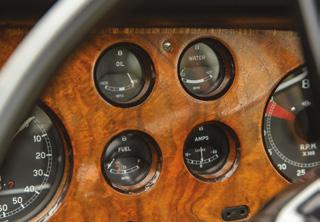
169


170
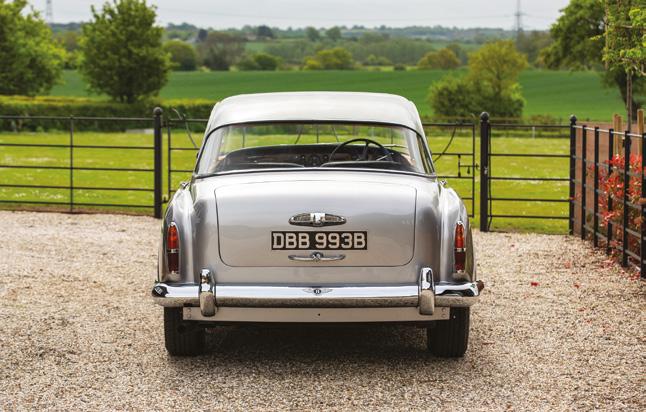

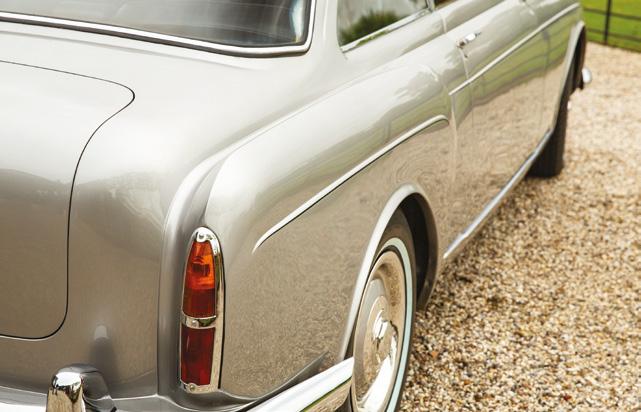
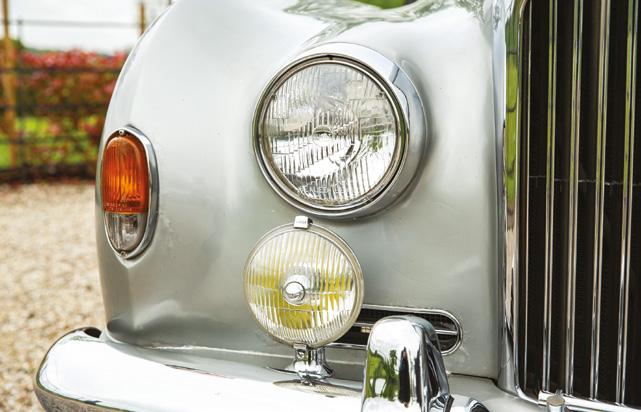
171
1977 Jaguar XJ-C 4.2

Estimate: £22,000 - £26,000*
Reg No: NFC 312S MOT: May 2024
Chassis No: 2J3392BW
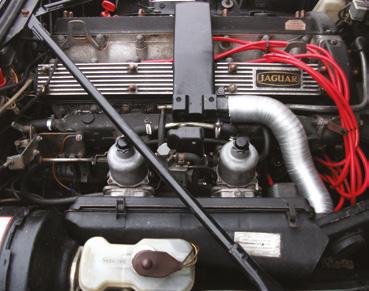
This rare and attractive Jaguar XJ Coupe was first registered in November 1977, with just c.51,500 miles currently recorded on the odometer, which seems credible. A collection of old MOT paperwork goes some way to supporting the mileage. The car was then stored by his son for over 20 years before finally coming out to be restored and refurbished in 2019. Finished in Black with Black leather, this example has had considerable money and time spent on it over the last four years.

The car presents very well, physically, with no signs of corrosion visible in either the main bodywork or underneath. There had been a significant spend in 2020, with over 100 hours of work by BRC restorations in Canterbury, that included new floorpans and outer sills, with a photographic record of the work. The original vinyl roof is in very good condition and the car wears recently re-chromed front and rear bumpers. Mechanically, the XJC drives very well and has completed around 500 trouble-free miles this year. Electronic ignition has been fitted to improve timing reliability and an extensive service has recently been carried out, including new fuel pumps. Inside, all the fixtures and fittings are present and correct and the seats have been recently retrimmed in the finest leather and a new stunning burr walnut fascia has been fitted to the dashboard, along with a period Bluetooth DAB radio. In the boot you will find the original Jaguar tool kit and jack and there is even the original Jaguar owner’s audio cassette still present.
Another testament to the condition, is the original service book and handbook all enclosed in the Leyland portfolio. The service book itself features ten dealer stamps prior to 1991. A rare and appreciating Jaguar XJC, included in the paperwork are old MOT certificates from 1981 to 1995 that support the mileage and the photographic record of the restoration work.
172 *All hammer prices are subject to a Buyer’s Premium of 12.5% plus VAT
109
1930 Marquette 36S Sports Coupe
Estimate: £12,000 - £15,000*
Reg No: 251 XUT MOT: Exempt
Chassis No: 39934
The Marquette 36S Sports Coupe emerged as an ambitious venture by Buick, in response to a declining market share and the need for a companion car to bolster sales. Introduced in 1929 as a 1930 model, the Marquette aimed to capture the low-price six-cylinder market with its distinctive design and advanced features. Built on a 114-inch wheelbase chassis, the Marquette offered six body styles, including a two-door Sedan, Coupe, Sport Roadster, Phaeton, and Sedan, as well as a twodoor Sport Coupe with a rumble seat. Equipped with a semi-elliptic leafspring suspension, mechanical four-wheel brakes, and a three-speed manual transmission, the Marquette showcased Buick’s commitment to engineering excellence. Powering the Marquette was a 212.8-cubic-inch L-head straight-six engine, producing 67.5 horsepower and 144.5 lb-ft of torque. Despite its promising performance and unique design elements like the forward-raked windshield and herringbone grille, the Marquette faced challenging competition in the market and the impact of the stock market crash of 1929. With a production run of 30,570 cars (including export models), the Marquette was eventually discontinued, marking the end of its short-lived but noteworthy presence in the automotive industry.
In current ownership for the last 15 years, this particular Marquette was purchased by the vendor from a private individual in California. Although nothing is known of the car’s early history, the story, as it goes, is that he had bought it from a gentleman who had won the car in a game of Poker! Still in remarkably original condition and showing a lovely Patina, the car was shipped to the UK and first registered on 01 June 2009.
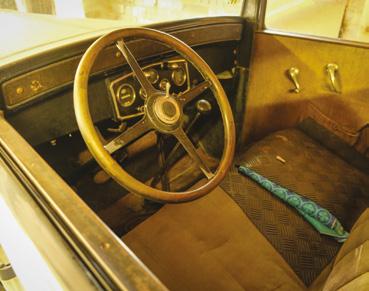
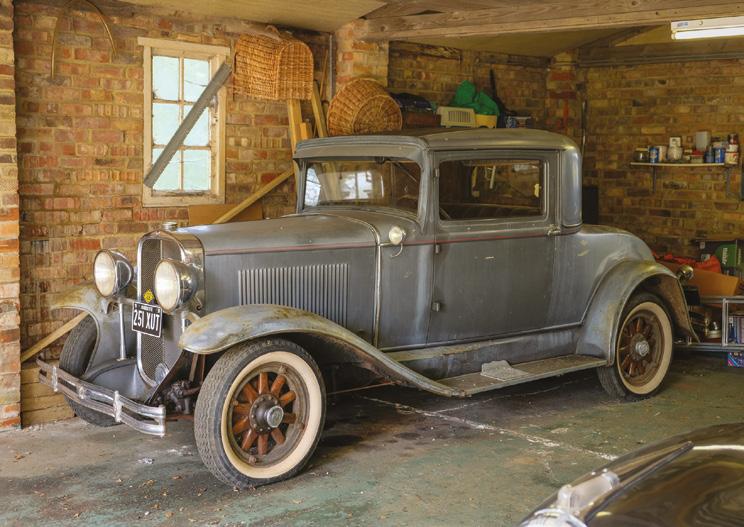
In current ownership, ‘251 XUT’ has been used sparingly as part of a small collection of American cars. The car has been taken to local shows and garage stored. Included with the vehicle is the V5C document which displays zero previous keepers.

173 *All hammer prices are subject to a Buyer’s Premium of 12.5% plus VAT
110
1915 Lancia Theta Hydraplane Runabout

Highly regarded Lancia model and first supplied to New York
Estimate: £120,000 - £140,000*
Reg No: DS 6634 MOT: Exempt Chassis No: 2645
A talented automotive engineer, Vincenzo Lancia founded an automotive company in his own name in November of 1906. Previously he had been FIAT’s chief test driver but in 1907 he was ready to launch the first car under the Lancia name with an ethos of original design, defiance of convention that would be forever associated with the name.
Lancia introduced the 35hp Theta in 1913. Powered by a 4,940cc four-cylinder sidevalve engine producing 70bhp, an output good enough for a top speed of some 75mph, Vincenzo Lancia specified a typically innovative built-in electrical system for the Theta that included an electric starter, previously not seen in Europe. Built in two different wheelbase lengths (3,100mm and 3,378mm), the Theta chassis was capable of carrying different coachwork styles and was, therefore, a relative success big hit in the USA. With the last chassis delivered in 1919, by which time almost 1,700 had been made, some 25 are believed to survive, with many having lost their original coachwork over the years. This Theta appears to retain that original American-built Hydraplane Runabout coachwork and is in a very good condition.
Originally supplied in New York by American Lancia agents, Thomas Evarts Adams Inc., this Theta later found its way into the collection of Bill Harrah. Arriving at Liverpool, UK, in 1981, the car still retains its original engine, gearbox, axles, etc. still with its original numbered bonnet, with brass lighting equipment by Rushmore. All the brass, the wheels, convertible top and the floors present as original with original details such as the brass edging. Whilst in the USA the running boards had been removed in the USA but have since been reinstated. In production from late 1913 to 1918, chassis number 2645 was produced in 1915 when chassis from 2280 to 2730 inclusive were assembled. It is engine number 301. A letter from the Lancia Motor Club, dated 1982 (copy on file), confirmed it as a 1915 chassis and described by the Lancia Motor Club as ‘remarkably original’ in 1982.
Used and maintained in the custodianship of John Blake until July 1986, the Theta then passed into the hands of Malcolm Elder, who also used the car before executing a restoration in the 1990s. The chassis and running gear has been extensively restored along with the engine, which has benefitted from new connecting rods, valves, pistons, white metal bearings, and overhauled water and oil pumps, with photographic records on file.
Engine overhaul notes from the history file:
Crankcase line bored, new bronzes for main and big end bearings made and fitted, New connecting rods, nuts and bolts, Re-metal all bottom end, Crank ground, phased (not just reground, phased to ensure all the - crankcase pins are in the right place, thus ensuring all faults are corrected) and balanced with flywheel, Block bored and honed (had to correct the centres thus ensuring all bores in the right place and perpendicular). Valve seats re-cut, Also benefitting from the following new items; pistons fitted (and balanced), valve guides made - SG IRON, valves manufactured to high specification - S and G Valve Manufacturers, valve springs, little end bearings, oil pump fitted with modifications to improve pin lubrication (centre of gears drilled to improve internal pin lubrication), the oil pump is a known weakness in this model. Additionally benefitting from: Pressure relief valve overhauled, Air compressor overhauled, New 3165S shaft for water pump made, Twin mechanical seals fitted front and back to water pump, New standpipes made for priming cups x 4, Oil seals fitted to magneto drive, Magneto rebuilt.
174 *All hammer prices are subject to a Buyer’s Premium of 12.5% plus VAT
111
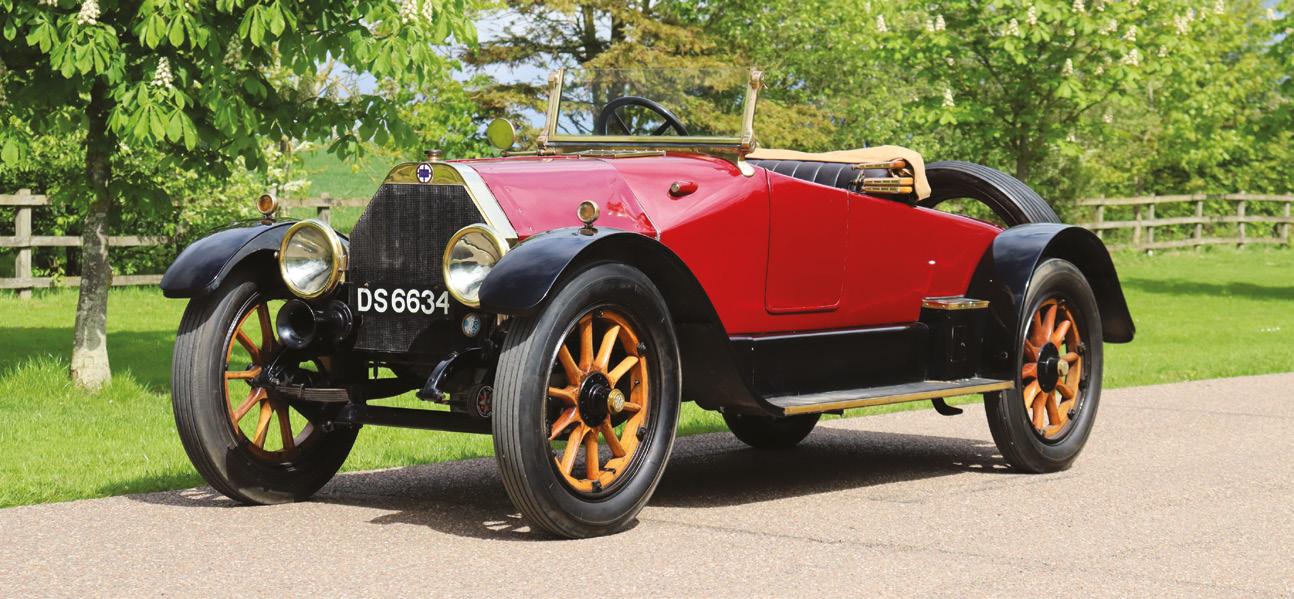

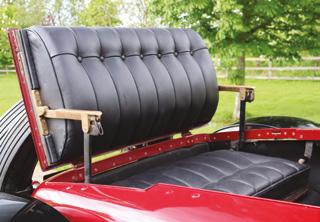


175
Additionally, the radiator has benefitted from a re-core. Still retaining the original electric starter, the electrics have been converted to 12v from the original 6v system and incorporates a modern 12v fuel pump and traffic indicators. The body was restored and repainted by Vintage & Classic Paintshop using Tekaloid paint in 2009, with “the body primed 3 times in total”. A letter on file, from February of 2009, documents the ‘work carried out’. “The undersides of the wings were painted with a high-quality Black stone chip protector. The seams of the wings were sealed.” Inside, the Black leather upholstery is new, with all the original instruments, including the speedometer, being subjected to an overhaul.
An American ‘Brass Era’ eligible motor car, examples of this marque have previously completed the famous Peking-Paris event in 2007 and 2010, with many thousands of miles covered, indeed, the Theta has been used on various VCC rallies. The Theta is offered accompanied by a history file containing technical drawings and diagrams, a copy of the workshop manual, a copy of some relevant articles - such as a document on engine overheating, import paperwork from 1981, notes on the engine overhaul, a facsimile of the original handbook, a collection of old MOTs and the current UK V5C registration document.

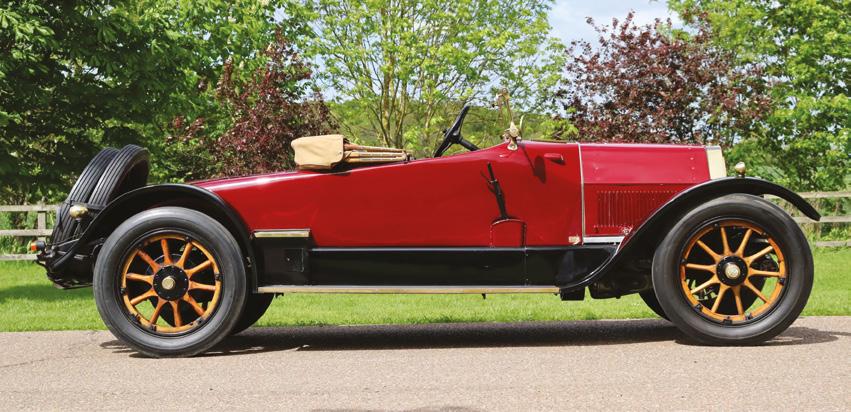
176



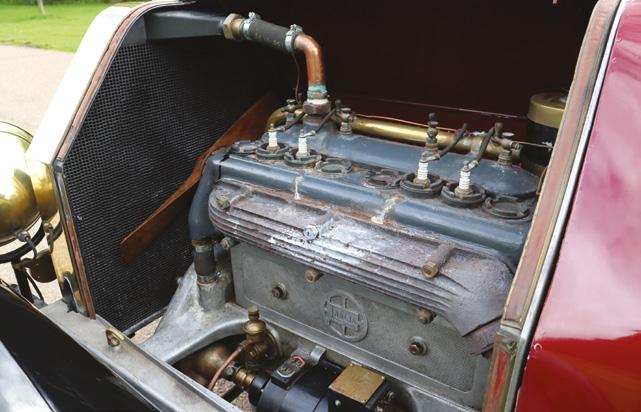
177
1939 Hupmobile Senior Six Series E Sedan

Estimate: £10,000 - £12,000*
Reg No: Unregistered MOT: Exempt
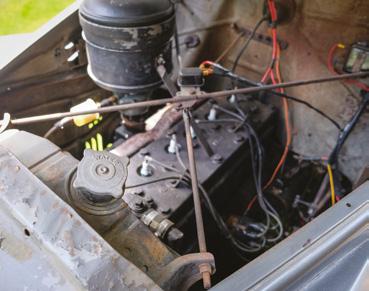
Chassis No: E72049
The 1930s was a decade of huge change in automotive design, more so than any that have followed. Cars went from upright, spindly, 1920s carriages to appearing full-bodied and streamlined, in the period style. One of the most underrated, yet distinctive, American automakers of this decade was the venerable Hupp Motor Car Corporation, and its final fullblooded Hupmobiles of 1938 and 1939 presented a brave and attractive face to the world.
The Great Depression had seriously depressed Hupp sales, and economic troubles, allied with the company’s internal leadership struggles, forced a stop in Hupmobile production in January 1936. In early 1937, a new Hupmobile was on the drawing boards, with 1938 models announced that summer; they represented a more conservative take on the brand’s recent avant-garde style. Another economic downturn that coincided with the restart of production in late 1937 proved terrible timing, and the 1938 and 1939 “Senior” Hupmobiles--six-passenger, four-door sedans with six- and eight-cylinder engines and 122- and 125-inch wheelbases, of which fewer than 4,000 were built--would represent the automaker’s last in-house-designed offerings.
One of the more recent acquisitions in the collection, this particular example was acquired by the vendor in 2016 from a private individual located in California. The car had reportedly resided in a museum for the better part of 40 years prior to its purchase. Registered in the UK in December, 2017, ‘XVV 560’ would shortly after its arrival be subject to a brake overhaul and go on to be used for a small number of local events along with the other vehicles in a small collection of American cars. Due to ill-health, the vehicle is now reluctantly offered for sale and is accompanied with the current V5C document which displays zero previous keepers.

178 *All hammer prices are subject to a Buyer’s Premium of 12.5% plus VAT
112
1971 Jaguar E-Type 4.2 Roadster

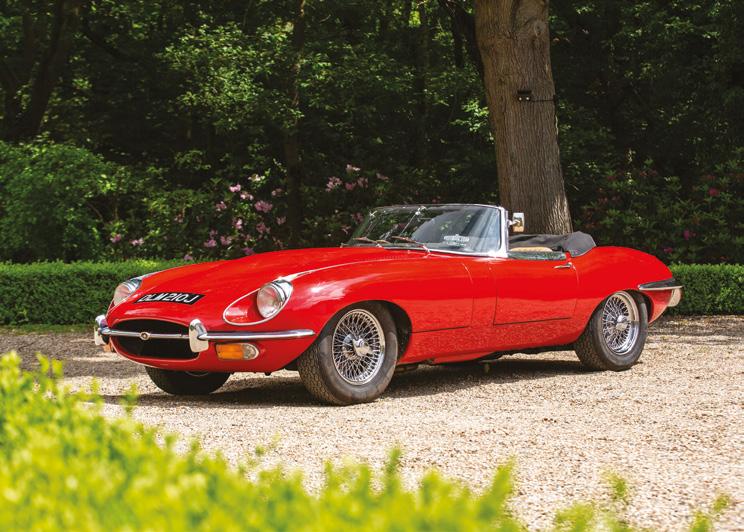
Estimate: £50,000 - £60,000*
Reg No: DLM 210J MOT: Exempt
Chassis No: C197GLC
At launch the new Jaguar was the fastest production car of its timeits 3.8-litre engine allowing a 0-60mph acceleration time of around seven seconds and a top speed of c.150mph. Despite this, the engine size was increased from 3.8 to 4.2-litres in October 1964 and, with the change, came a sweeter all-synchromesh gearbox, better brakes and more comfortable seats. The Series 2 models introduced in 1969 are distinguished by their lack of headlamp covers, enlarged front air intake, repositioned front indicators and taillights, wrap-around rear bumper, twin-electric fans, and refashioned facia and seats.

This eye-catching Series 2 E-Type features glossy Red bodywork matched to a Black hood and contrasting Cream leather interior. We understand its second owner was Mr Dennis Meighan of London, a former London antique firearms dealer who retained the Jaguar until it was purchased by the previous vendor in 2006. A spell in storage apparently accounts for the low recorded mileage of 47,500, just 3,700 of which have been accrued since an engine overhaul by VSE of Powys, Wales in 2007. In 2013 £12,572.45 was invested with marque specialists Wat Jag of Great Longstone, Derbyshire, which funded: a rear axle overhaul; the installation of four-pot brake calipers and vented discs, and Gaz dampers; and tuning of the triple SU carburettors. Welcome upgrades to the original specification include a five-speed gearbox conversion and Series 1-style stainless steel exhaust system.
In current ownership since 2017 `DLM 210J’ is offered complete with a large collection of invoices dating back to 1973, a reproduction handbook and workshop manual, and a number of old MOT certificates.
179 *All
prices are subject to a Buyer’s Premium of 12.5% plus VAT
hammer
113
2000 Mercedes-Benz C240 Sport

No Reserve
Reg No: W542 RLB MOT: December 2023
Chassis No: WDB2020262F894953
Mercedes-Benz W202 was the internal designation for its compact saloon manufactured and marketed by Mercedes-Benz from 1993–2000, as the first generation of the C-Class. Replacing the 190 series/W201 in June 1993, the C-Class sedan was Mercedes’ entry-level model until 1997, when the company launched the A-Class. Production reached 1,847,382 over model years 1994–2000. The C240’s displacement was enlarged from 2.4 L to 2.6 L in the last four years of production, but output remained at 168hp. Four distinctive trim levels were offered, Classic, Elegance, Esprit, and Sport. The Sport featured lowered and uprated suspension, alloy wheels, sport seats, a carbon effect dash, leather rimmed steering wheel, and a sunroof, being aimed at the more sporting driver.
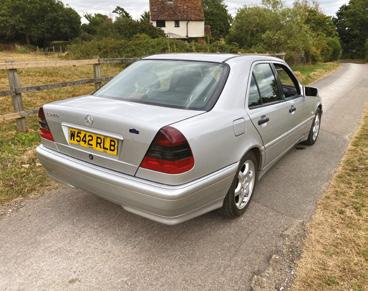
Supplied new by Mercedes-Benz of Hertford and displaying just 27,500 miles from new, this example of a late iteration of the W202 C240, has just 4 former keepers recorded. Finished in Brilliant Silver Metallic paint with 6 spoke alloy wheels, it is being offered with a print-out of the service history and possesses an MOT into December of 2023 and a current V5C Registration Document.
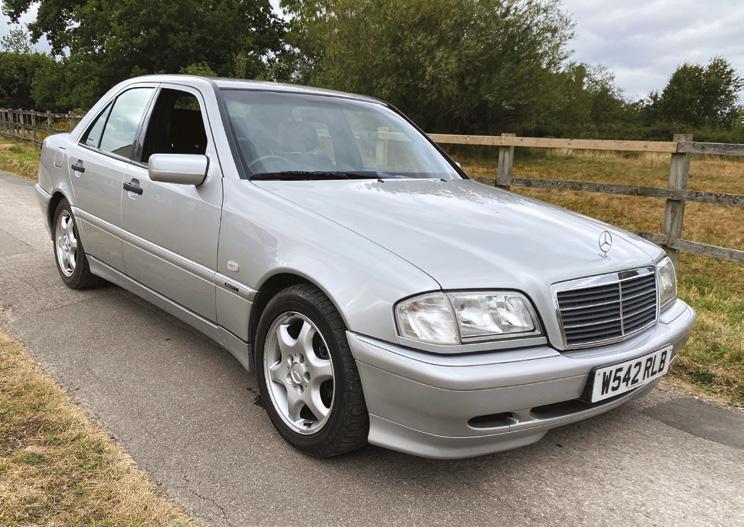
180 *All hammer prices are subject to a Buyer’s Premium of 12.5% plus VAT
114
1969 Chevrolet El Camino


Estimate: £14,000 - £18,000*
Reg No: CHJ 437G MOT: Exempt
Chassis No: 136809Z317534
The Chevrolet El Camino is a Coupé Utility vehicle, effectively a blending of a Pickup truck and a Saloon body, that was produced by Chevrolet between 1959–60 and 1964–1987. Introduced in response to the success of the Ford Ranchero, its first attempt, based on the Biscayne’s B-body, lasted only two years. Production resumed for the 1964–1977 model years, based on the Chevelle platform, and continued for the 1978–1987 model years based on the GM G-body platform. Although based on corresponding General Motors car lines, the vehicle is classified in the United States as a Pickup. Chevrolet introduced a longer El Camino in 1968, based on the Chevelle station wagon/four-door sedan, it also shared Chevelle Malibu exterior and interior trims. A three-speed manual was standard with all engines, and a four-speed or automatic was optional.
First registered in the UK in April 2010 and declared manufactured in April of 1969, this El Camino Pickup is powered by a small block V8 engine, documented as a 5200cc engine. The vendor describes the engine as having performance modifications which include racing cylinder heads from Summit - mated to a transmission from a ‘350’. Other features include power brakes and power steering. The El Camino has also been the subject of customisation of the exterior. The American Racing ‘Torq Thrust’ – style alloy wheels really promote the ‘street custom’ style of this Chevy. A custom paint job in a Bright Green Metallic paint with Black racing stripes evokes the stripes offered on Chevrolet’s ‘muscle car’, the Chevelle SS model of 1969, all in-keeping with other modifications on this late ‘60s custom El Camino, from the ‘golden age’ of the American car. Offered with a V5C.
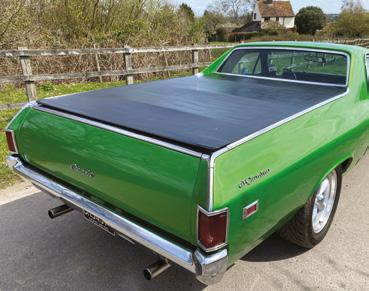
181 *All hammer prices are subject to a Buyer’s Premium of 12.5% plus VAT
115
1955 Aston Martin DB2/4 Mk1

Estimate: £70,000 - £90,000*
Reg No: VWE 150 MOT: Exempt Chassis No: LML/1039
“The Aston Martin DB2/4 is a sports car with a very definite appeal. It has full saloon car comfort, coupled with performance and roadholding of a very high order” (Autocar Magazine)
Introduced at the October 1953 London Motor Show, the DB2/4 represented a new breed of longer-legged, more accommodating Aston Martin. Some seven inches longer and a little taller than its predecessor, the fitting of a smaller seventeen gallon fuel tank (still good for circa 300 miles) plus some minor platform changes liberated enough room for two small seats to be positioned above the back axle. Visually distinguished by a one-piece windscreen and rear hatchback, the new model boasted such niceties as a telescopic steering column and adjustable backrests. Panelled in lightweight aluminium over an advanced tubular frame chassis, its independent front suspension featured a sophisticated trailing link, coil-sprung set-up tempered by an anti-roll bar, while at the rear a Panhard rod assisted radius arms in keeping the coil-sprung beam axle firmly tied down. Initially powered by a 2580cc version of the famous Willie Watson / W.O. Bentley designed DOHC straight-six engine, the adoption of a larger 83mm bore size saw capacity rise to 2922cc in mid 1954. Thanks to its increased size, the 2.9 litre unit was credited with developing some 140bhp and 178lbft of torque - outputs sufficient for a quoted 120mph top speed. Overshadowed by its racing DB3 / DB3S siblings, the model still enjoyed a successful competition career winning the team prize on the 1955 Monte Carlo Rally (interestingly, the factory also fielded a pair of DB2/4s for the Mille Miglia). Of the 565 MKIs made, just 448 are thought to have been two-door saloons.
According to its accompanying copy build record, chassis LML.1039 was supplied new via Charles Sidney Ltd of Westgate, Bradford to Geoffrey S.C. Shindler Esq of Sheffield on October 1st 1955. Finished in Moonbeam Grey and benefiting from the larger 2.9 litre engine, the 2+2-seater was issued with the local number plate ‘VWE 150’. Belonging to F. Smith Esq of Sale Moor, nr Manchester by the early 1980s, he is understood to have used the Aston Martin for family holidays in North Wales before selling it to J.R. Eite Esq. of Lostock. The latter had the DB2/4 mechanically fettled (including fitting a new crankshaft) by Mike Entwistle of Entune Garage and resprayed by Fred Beresford & Son of Bolton, whilst its next keeper, Graham Wilkins Esq, undertook some light competition work. As well as completing the 1987 Beaujolais Run, he twice contested the Aston Martin Owners’ Club’s Wiscombe hillclimb. Treated to a new steering box by Feltham Aston Martin specialist Four Ashes Garage in 1988, the following decade saw the 2+2-seater benefit from a new cylinder block. Mr Wilkins also sourced new liners, pistons and valves etc and began to overhaul the
engine only to decide that he ought to entrust it to a professional. Hence, an invoice on file from marque specialist A.J. Barnard Engineering issued during 1997 which details the unit being stripped and fitted with new bearings, gaskets and timing chains plus the grinding, polishing and balancing of the crankshaft etc. The engine rejuvenation was completed at an indicated 67,610 miles (circa 6,000 miles ago).
Entering the current family ownership in July 1998, the Aston Martin has been sparingly used over the past twenty-five years. The subject of a cylinder head overhaul shortly after acquisition, the DB2/4 was re-trimmed in Grey leather by G & G Sergent of Horsford, Norwich during 1999. Repainted in its original Moonbeam Grey hue, the 2+2-seater has been exhibited at various shows including ‘Classic & Sports Cars by the Lake’ and the Hevingham Hall Country Fair. Entrusted to Connaught Cars for maintenance in recent years, they carried out a full service (engine, gearbox and rear axle oil changes etc) as well as curing a steering box leak and installing a thermostat in April 2015. Further improvements were made during March 2021 in terms of replacing the front drum brakes (the original cracked Alfin drums come with the car), reconditioning the distributor, replacing the battery, changing the engine oil, greasing all the chassis points, rejuvenating the carburettors and installing new Pirelli Cinturato tyres all round. Starting readily upon inspection, ‘VWE 150’ is said to rev freely and have a notably sweet gearchange. The engine number stamped into the timing cover ‘VB6J/629’ matches the one quoted on the chassis plate and copy build record. Interestingly, Four Ashes Garage state Aston Martin considered the cylinder block to be an exchangeable service item and cite this as the reason that the engine number was carried by the timing cover rather than the block. Presenting as an older restoration but in seemingly ‘good overall’ condition, this handsome DB2/4 is potentially eligible for a host of prestigious events such as the Mille Miglia Storica. Offered for sale with V5C Registration Document, copy factory build record, various old MOTs dating back to 1984 (at an indicated 63,844 miles) and numerous invoices from Connaught Cars, Aston Service Dorset, Entune Garage and Four Ashes Garage etc.
182 *All hammer prices are subject to a Buyer’s Premium of 12.5% plus VAT
116
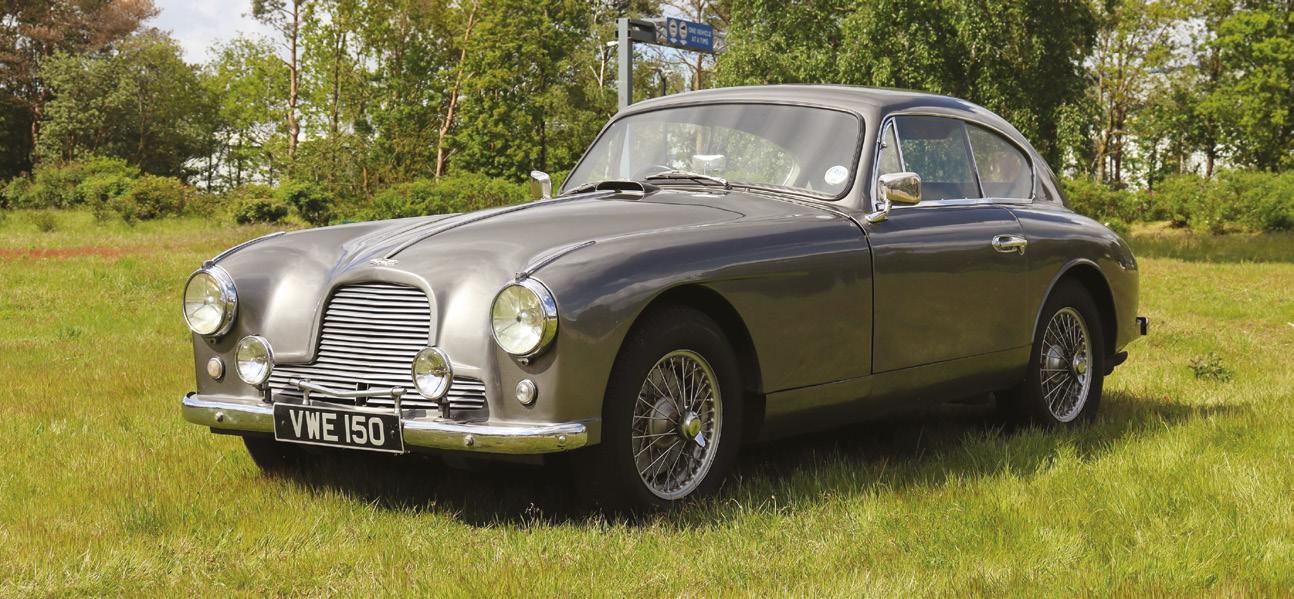

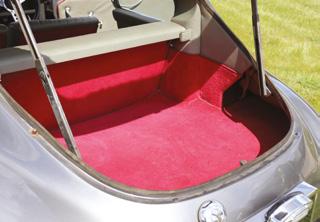

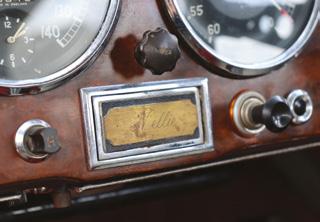
183


184

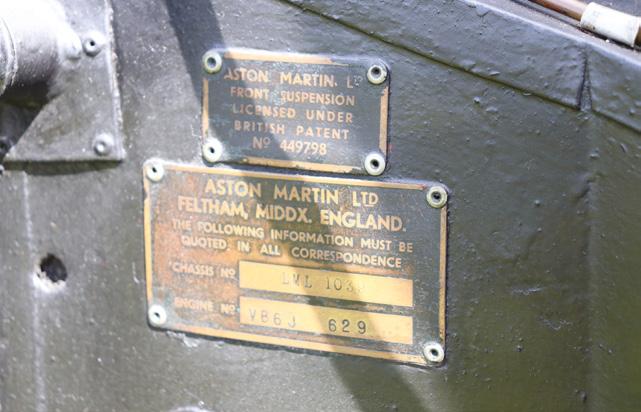

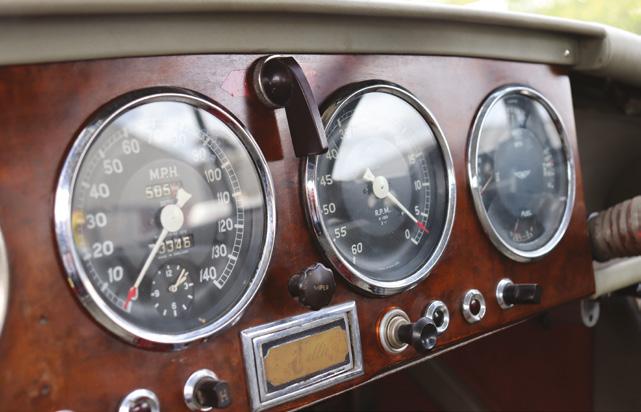
185
1970 Jaguar E-Type 4.2 Roadster

Estimate: £50,000 - £60,000*
Reg No: ABW 88H MOT: T.B.A Chassis No: 1R1508
Triumphantly unveiled at the 1961 Geneva Motor Show, the Jaguar E-Type created a furore thanks to its supercar performance, stunning looks and modest price tag. Early racing success at the hands of Graham Hill and Roy Salvadori amongst others helped cement the newcomer’s reputation. Built as a monocoque with an engine cradling front sub-frame, the E-type’s combination of all-around independent suspension and disc brakes allied to rack-and-pinion steering resulted in excellent roadholding and handling capabilities. The indomitable straight-six XK twin-cam engine supplied abundant power. If the design had an Achilles’ heel then it was the recalcitrant Moss gearbox. However, Jaguar was quick to correct this shortcoming with a four-speeder of its own design just part of a continual programme of E-Type development that saw the model metamorphose through three Series. Introduced in August 1968, the Series II cars were distinguishable by their revised bumper and light arrangements. Less noticeable was the increased size of the front air intake that in conjunction with dual cooling fans made the Series II better behaved in hot weather and heavy traffic. With its 4235cc engine developing a quoted 265bhp and 283lbft of torque, it was reputedly capable of nearly 150mph and 0-60mph in 7.5 seconds. Available in open two-seater, fixed-head two-seater and fixedhead 2+2-seater guises, the American market accounted for the vast majority of Series II production. Indeed, just 776 of the 8,627 open two-seaters made were to right-hand drive specification.
One of just 776 Series II Roadsters made to right-hand drive specification, chassis 1R1508 was first registered with the Nottingham number plate ‘TAU 465H’ on February 2nd 1970. Resident in Northern Ireland thereafter, the Jaguar was treated to a thorough engine and gearbox overhaul by Oldham & Crowther of Peterborough at an indicated 70,644 miles before being bought by the television and radio star Noel Edmonds as a present for his first wife Gillian during 1978. Checked over by J.R. Etheridge Ltd who looked after Mr Edmonds’ Ford GT40 at the time, the E-Type bore the distinctive number plate ‘CIA 7’. Belonging to Mr C Metcalfe of Milton Keynes by 1984, the two-seater then passed to Paul Conway who kept it for over twenty years. Small Bills Garage of Chiswick carried out a full mechanical and body inspection on the car at an indicated 86,171 miles in September 1986 concluding that: ‘Apart from the corroded sills this vehicle is a fine example of a sixteen-year-old motor car’.
Minor bodywork restoration and a full respray in its original Red followed during 1990 but, unusually for a home market car, the Series II Roadster has never been allowed to deteriorate to the point of needing total renovation. Thus, it retains its original chassis plate, carburettor position tags and jack bag etc not to mention its factory-fitted engine. Having owned several E-Types in the past and as a veteran of various Concours restorations, the vendor purchased chassis 1R1508 from marque specialist Lanes Cars for £90,000 in 2018 with a view to returning it to showroom condition once more. However, another project intervened and he now feels that someone else should take custodianship. Retrimmed at some stage, the Jaguar remains presentable and could certainly be enjoyed ‘as is’ especially given that the seller has not long spent £1,927.20 with Aldon Automotive of Brierley Hill having the radiator flushed, one cooling fan motor renewed, new coolant hoses fitted, the triple SU carburettors overhauled and electronic ignition added. Starting readily upon inspection and running well during our photography session, ‘ABW 88H’ is more authentic than many of the E-Types we encounter. Understood to have covered some 102,000 miles from new, this rare and appealing Series II Roadster is offered for sale with a green logbook (showing Mrs Edmonds’ ownership), old MOTs dating back to 1978 at 76,835 miles, numerous bills, factory hardtop and fitted indoor car cover.
186 *All hammer prices are subject to a Buyer’s Premium of 12.5% plus VAT
117


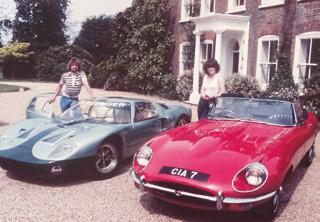


187
1940 MG VA Tickford

0Estimate: £40,000 - £50,000*
Reg No: JPF 421 MOT: April 2024 Chassis No: VA2137
Manufactured by Morris Garages (MG) in collaboration with renowned coachbuilder Salmons & Sons, the MG VA Tickford was introduced in 1937 as a luxurious touring car. The MG VA Tickford featured independent front suspension and semi-elliptical leaf springs at the rear, ensuring a smooth and stable ride. Propelled by a 1.5-liter OHV inlinefour engine, producing approximately 54 horsepower, the vehicle delivered respectable performance for its era. However, the true allure of the MG VA Tickford lay in its exquisite craftsmanship. Salmons & Sons crafted the car’s body with meticulous attention to detail. The result was a design characterized by graceful lines, subtle curves, and a distinctively styled grille. Inside the cabin, occupants were greeted with a refined interior adorned with high-quality materials and tasteful finishes.
The Tickford Drophead Coupe offered today, Chassis VA2137, left Abingdon as a rolling chassis in December 1938, destined for Salmons & Sons (Tickford) works at Newport Pagnell. Subsequent to the completion of the Tickford coachwork, the MG was registered in Surrey as ‘JPF 421’ in March 1940. There is little known of the car’s early history other than a continuation buff logbook showing it was in the ownership of an Arthur Frasher Birch-Jones in 1963 and a Joseph Nuttall in 1966; both based in Windermere. ‘JPF 421’ would later go on to be discovered on the continent requiring full restoration in the year 2000.
Shortly after its discovery and purchase by the previous owner, this VA underwent an extensive restoration with the majority of work by Hallmark Restoration Ltd. The bodywork and paint was undertaken by I&M Autobody Repairs to an excellent standard and the parts supplied by Tickford body specialists SVW Spares. ‘JPF 421’ benefited from a mildly tuned engine; featuring an overbore to 1708cc, a new camshaft and oil pump and high compression cylinder head. The resulting increase in power of c.25% was driven through a high ratio rear axle, and the car also featured a stainless steel exhaust. Completed in 2007, this lovely Tickford attended the MG Car Club 57th Silverstone International Meeting and Concours on 24th June that year. ‘JPF 421’ was awarded ‘First in Class’ and the ‘Car of the Day’ trophy for ‘Best MG Overall’.
Since its completion, the car saw occasional use and resided in a dehumidified garage until the late previous owner’s passing. It was then sold via Robin Lawton to the current owner in 2021. Since its purchase, ‘JPF 421’ has been subject to over £14,000 expenditure; largely with The Pitstop Ltd.
Notable works include in July-November 2022 the engine being removed, stripped and white-metaled. The valve seats and stems re-finished, engine rebuilt, the engine bay meticulously cleaned including ‘every single nut and bolt wire brushed’ and more. In February 2023 the brake shoes were re-assembled, some leaks rectified, points greased and the vehicle serviced and in March 2023 the manifold repaired and ultra-sonic cleaned, the fuel system flushed, carburettors overhauled and set up and further servicing.
Now offered for sale for health reasons, ‘JPF 421’ comes accompanied with a comprehensive history file containing a continuation buff log book, original instruction manual, MG VA brochure, chassis maintenance chart, a large collection of invoices for the restoration work and works undertaken since. As well as this, a copy of the official show guide for the 2007 NEC Classic Car Show in which the vehicle features on the Meguiars stand and is mentioned, an MG Car Club membership pack with magazine and further documentation. The V5C document is also included which displays 2 former keepers and the vehicle comes with an MOT valid until 25th April 2024 with no advisories.
188 *All hammer prices are subject to a Buyer’s Premium of 12.5% plus VAT
118
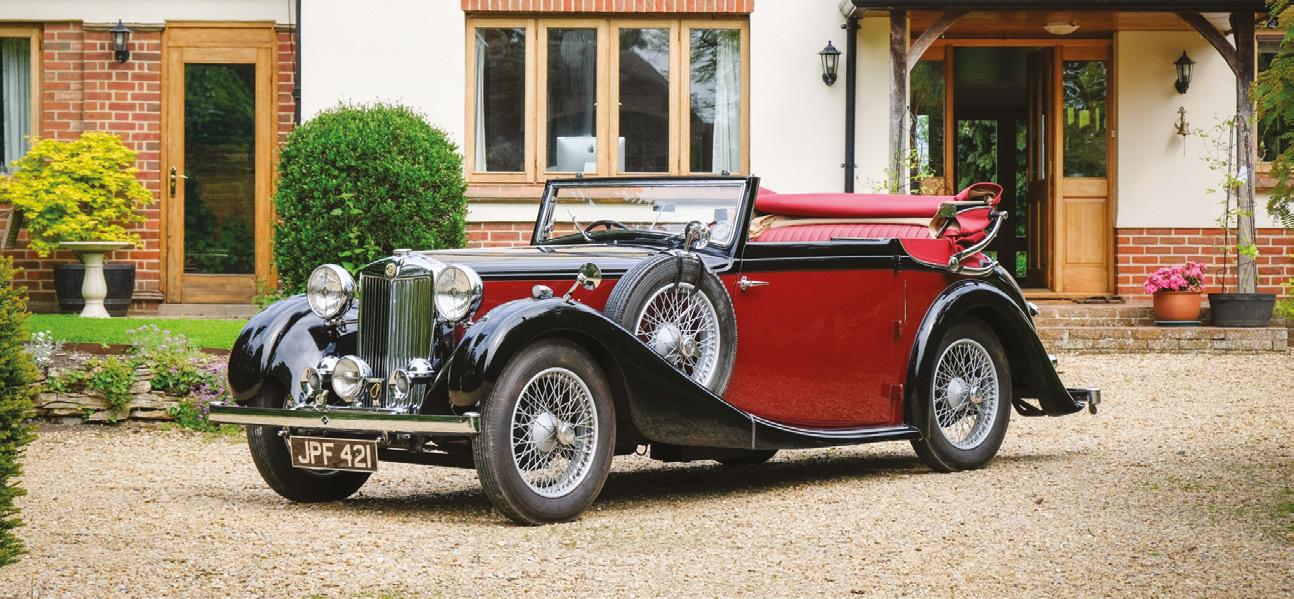
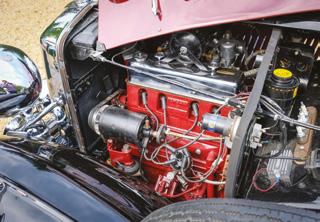
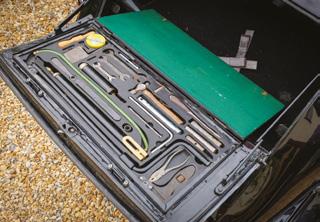
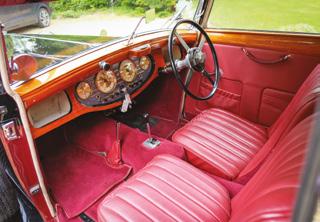
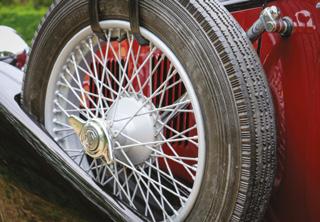
189
1938 Lagonda V12 Sports Saloon
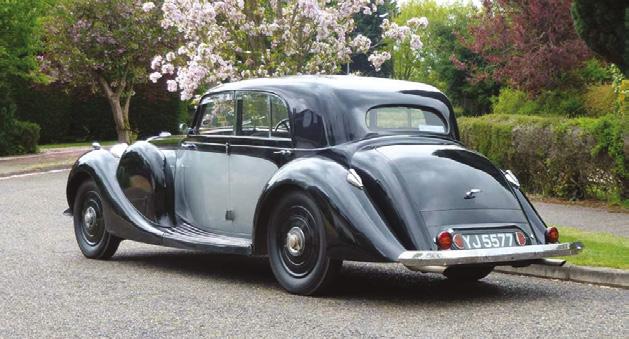
Estimate: £50,000 - £70,000*
Reg No: YJ 5577 MOT: Exempt Chassis No: 14011
Debuting in prototype guise at the October 1936 Olympia Motor Show (but not officially launched for another year), the Lagonda V12 was engineered by a crack team of exRolls-Royce employees including W.O. Bentley, Stuart Tresillian and Charles Sewell. A ‘clean sheet’ design that aimed to marry limousine refinement to sportscar performance, it was based around a substantial cruciform-braced box-section chassis. Boasting sophisticated unequal-length wishbone independent front suspension actuated via unusually long torsion bars and special shackle pins that helped obviate side thrust on its semi-elliptic rear leaf-springs, the newcomer also incorporated a Marles steering box, Salisbury hypoid rear axle and Lockheed hydraulic drum brakes. Singularly advanced, the model’s aero-engine inspired 60-degree V12 featured overhead camshafts (one per bank), twin SU carburettors, a combined duplex-chain / gear-driven timing system and Lanchester-type vibration damper. Displacing 4480cc (bore 75mm x stroke 84.5 mm) the unit was quoted as developing 180hp @ 5,500rpm. Available in 10’4”, 11’0” and 11’6” wheelbase lengths, the Lagonda flagship was among the fastest cars of its generation. Though, the provision of a centre-change four-speed manual gearbox (with synchromesh on the top three ratios) and conventional pedal layout made it surprisingly easy to drive.
Beguiled by in-house stylist Frank Feeley’s marvellous creations which seemed to capture the very spirit of the age, most customers opted for factory coachwork. Indeed, such was the flamboyance of Feeley’s designs - which looked as if they could have sprung from the drawing boards of Jacques Saoutchik or Figoni & Falaschi - that most external coachbuilders produced bodies with altogether more conservative lines. Some eightyfive years on and the market has shown a marked preference for factory coachwork.
Of the 190 Lagonda V12s produced between 1938 and 1940, a mere 100 are thought to have survived to the present day (though, comparatively few of those still retain their original coachwork).
Among the earliest Lagonda V12 cars extant, chassis 14011 was originally configured as a Drophead Coupe and supplied new via Burton & Tweedy to H.J.H. Scott Esq of the textile manufacturer James Scott & Sons in Dundee. Issued with the local numberplate ‘YJ 5577’ on 4th February 1938, the short wheelbase machine was involved in a road traffic accident the following year that saw it returned to the factory and rebodied as a Sports Saloon. Retained by the Scott family until the late 1940s by which time it had covered a mere 40,000 miles, the Lagonda spent time in France before being imported to Switzerland during the early 1970s. Purchased by the renowned classic car dealer Lukas Huni through a Christie’s auction in 1999, the V12 has been in the current family ownership for the past twenty-three years.
Exercised on a number of Lagonda Club events, the Sports Saloon was driven to Le Mans and back during 2005 to help celebrate the 70th Anniversary of the Staines manufacturer’s epic victory at the famous La Sarthe circuit. Unfortunately, it suffered piston failure on the way home. Subsequently entrusted to marque specialist David Wall of Wroxham for a thorough engine overhaul which was only completed during 2012, ‘YJ 5577’ received attention to its brakes and suspension plus four new tyres that same year. Looked after by Classic & Vintage Vehicle Engineering of Mildenhall since 2014, they have been responsible for rewiring the V12, fitting new front shock absorbers, fettling the cooling system, partially renovating the wooden body support frame and overhauling the brakes. The most recent invoice on file was issued in 2021 for £2,460.09 and included new spark plugs and points etc.
Kept garaged as part of a marque collection, the Sports Saloon’s last long run was to the Lagonda Club’s September 2018 AGM during which it reportedly achieved ‘a very comfortable 70mph at just over 2000rpm’. Painted Black over Silver decades ago, the V12 appears to pleasingly retain much of its original Brown leather upholstery. There is certainly scope for cosmetic improvement but given the significant sums invested and the car’s status as one of the earliest known survivors, it is hoped that ‘YJ 5577’ will not be separated from its (second) factory coachwork. Offered for sale with UK V5C Registration Document, reproduction LG6 / V12 brochure, ‘Lagonda Twelve Cylinder Running Instructions’ and assorted bills.
190 *All hammer prices are subject to a Buyer’s Premium of 12.5% plus VAT
119

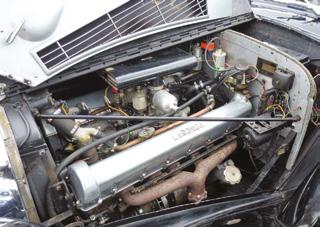
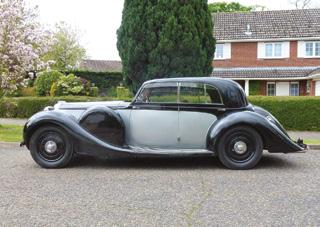
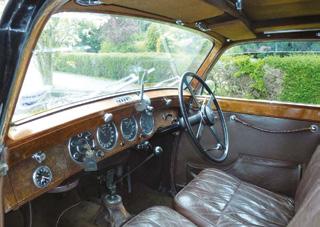

191
1923 Rolls-Royce 20hp Coupe with dickey seat
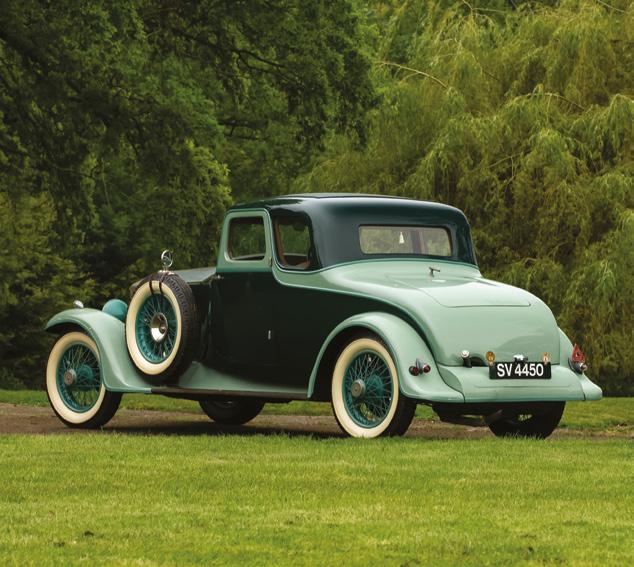
Delivered new to New Zealand
Estimate: £30,000 - £40,000*
Reg No: SV 4450 MOT: Exempt Chassis No: 79A8
Unveiled in 1922, the 20hp was a second string to the Rolls-Royce bow – a shorter, more economical sibling to the Silver Ghost which broadened the marque’s reach to span both the very rich and seriously wealthy. Instantly distinguished by its horizontal radiator shutters, the newcomer was constructed around a ladder-frame chassis of 129 inch wheelbase. Power came from a 3,127cc straight-six, OHV monobloc engine mated to a three-speed manual gearbox. Suspension was by semi-elliptic leaf springs all-round. Braking was initially on the rear wheels alone, while steering was by worm and nut. Progressively updated to feature a four-speed gearbox and servo-assisted allwheel braking, the ‘baby’ Rolls remained in production until 1929, by when some 2,885 examples had vacated the company’s Derby factory. Lighter and more responsive than the Silver Ghost, the 20hp was capable of exceeding 60mph.
Chassis 79A8 was originally delivered to New Zealand, featuring Johnson & Smith tourer coachwork, as documented in John Fasal’s comprehensive reference work, ‘The RollsRoyce Twenty.’ It remained in the hands of its second owner in New Zealand until the 1950s when it was then exported to the United States. For nearly 31 years, it was stored in a dry environment. At some point during its storied history, this elegant vehicle received a striking two-seat Coupé-with-dickey coachwork, adding to its aesthetic appeal. Following its storage period, a comprehensive restoration was undertaken in America, amounting to approximately $40,000. Notably, the car was owned by the esteemed enthusiast and collector, G Wales. Presented in a distinctive livery, the current exterior showcases three shades of Green, accentuated by a polished alloy bonnet. The car features a unique apron enclosing the chassis irons to the front, twin side-mounts, Marchal headlamps, and a running board-mounted tool box, creating an overall captivating effect. Inside, the interior is adorned with button-back Tan leather upholstery, complemented by a matching dickey in fabric and Dark Green carpets. Thoughtful storage compartments are neatly fitted behind the seat. Noteworthy additional features include an inset fabric panel on the roof, a fire extinguisher installed inside, an oil can situated beneath the bonnet, an assortment of tools, and a small metal ornamental bee adorning the bonnet. The current vendor acquired this Rolls-Royce Twenty in 2012 and since then, it has been sparingly used and well cared for. The car comes with a copy of the chassis cards, a large file of invoices and a photographic record of the restoration.
192 *All hammer prices are subject to a Buyer’s Premium of 12.5% plus VAT
120
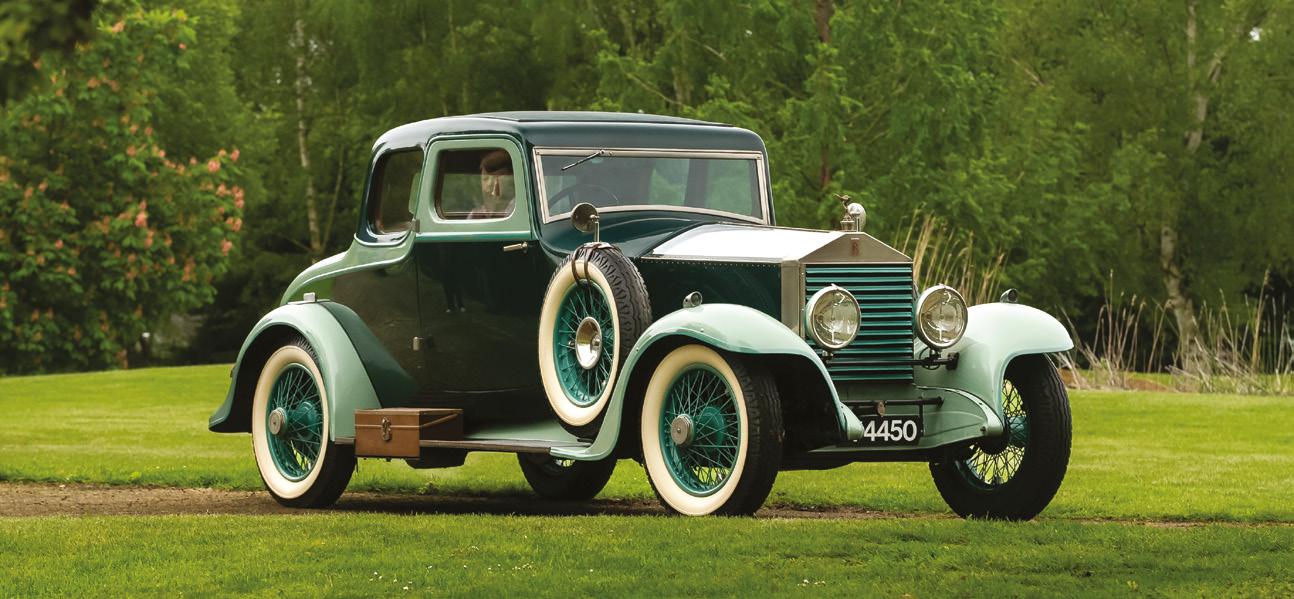
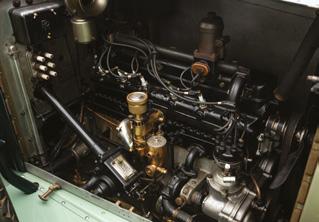


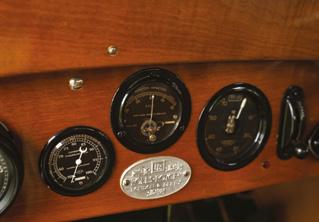
193
1936 Alvis Speed 20 SD Vanden Plas
‘Sunshine Coupe’
Thought to be 1 of just 2 survivors (12 produced)
Estimate: £80,000 - £90,000*
Reg No: CXM 95 MOT: July 2023 Chassis No: 13026
A mercurial character who became renowned within the London motor trade for sourcing the very best pre-owned exotica, Charles Follett would travel anywhere in the UK for the right car building-up an enviable client base in the process. A member of the Brooklands set, his ‘black book’ comprised society’s elite from racing drivers to celebrities via members of the aristocracy. Given sufficient funding to buy showrooms in the heart of Mayfair, he became the Alvis concessionaire for London and the Home Counties during 1931. Seriously impressed at the Coventry firm’s engineering integrity but dismayed at the staidness of its offerings, Follett set about turning the marque into a Lagonda, Sunbeam, Invicta and (later) Bentley rival. Decades before Jaguar came up with its famous ‘Grace . . . Space . . . Pace’ slogan, he was adamant that all three were intrinsic to making a car appeal to wealthy buyers.
Introduced in late 1931, the Alvis Speed 20 SA was the first model which Follett could really sink his teeth into. Based around a low-slung, double-dropped chassis frame, powered by a lusty 2511cc OHV straight-six engine and boasting 90mph performance, it proved an ideal canvas for the coachbuilder’s art. Conscious that Vanden Plas’ order book had thinned considerably due to Rolls-Royce’s acquisition of Bentley and the subsequent hiatus in the latter’s production, he approached the London company with a bold proposal. Follett would order a minimum of 100 bodies from them if they would (a) cut the average cost from £600 to £195 per chassis and (b) devise a range of suitably rakish designs over which he would have sign off. Vanden Plas capitulated and came up with a notably stylish Saloon, Tourer and Drophead Coupe which The Autocar hailed as ‘very attractive special bodies’.

Often at loggerheads with Alvis’ supremo T.G. John and his chief engineer G.T. SmithClarke over the ‘unnecessary’ expense of a la mode coachwork, Follett once denied the pair access to their own boardroom while he laid out the £895 required to buy a Speed 20 in one pound and ten shilling notes just so they would better appreciate that looks and amenities were as important as driving dynamics when such sums were involved. Embracing the ‘Race on Sunday, Sell on Monday’ ethos, Follett campaigned a series of Alvis cars at Brooklands. Evolving from SA to SB guise in September 1933, the Speed 20 gained a four-speed all-synchromesh gearbox, independent front suspension and adjustable rear dampers.
While, stylistically the model was enhanced via a forward sweeping scuttle / bonnet join line, 19-inch wire wheels and larger Lucas P100 headlights. Again, tasked by Follett with clothing the Speed 20SB to best effect, Vanden Plas produced a variety of open and enclosed bodies the best looking of which was undoubtedly a two-door saloon cum fixed head coupe known as the ‘Flatback’. 1935 saw the introduction of the SC, which had the engine enlarged to 2,762cc and featured twin electric fuel pumps. The complex steering gear was modified and the front damping was improved. At the rear the chassis was stiffened by having side members above and below the axle. The final iteration, the SD, differed only from the SC by being fitted with a larger fuel tank and slightly wider bodywork.
A close-coupled, Four Light design with notably slim A-, B- and C-Pillars, the ‘Flatback’ also sported a distinctive swage line that accentuated its airy glasshouse and ‘letter box’ rear window. A spectacular exemplar of the ‘airline’ styling trend which captivated the automotive industry on both sides of the Atlantic during the mid-1930s, the Speed 20 SB ‘Flatback’ evolved through SC and SD guises. With its Art Deco door handles, the four-seater sported extravagantly peaked, full-flowing wings as well as a louvred scuttle and external fuel filler neck. Long prized by collectors for being among the most elegant pre-WW2 Saloons, only twelve of the 149 Speed 20 SDs made were bodied as 2-Door Saloons by Vanden Plas and it is thought that only a two have survived to the present day.
194 *All hammer prices are subject to a Buyer’s Premium of 12.5% plus VAT
121
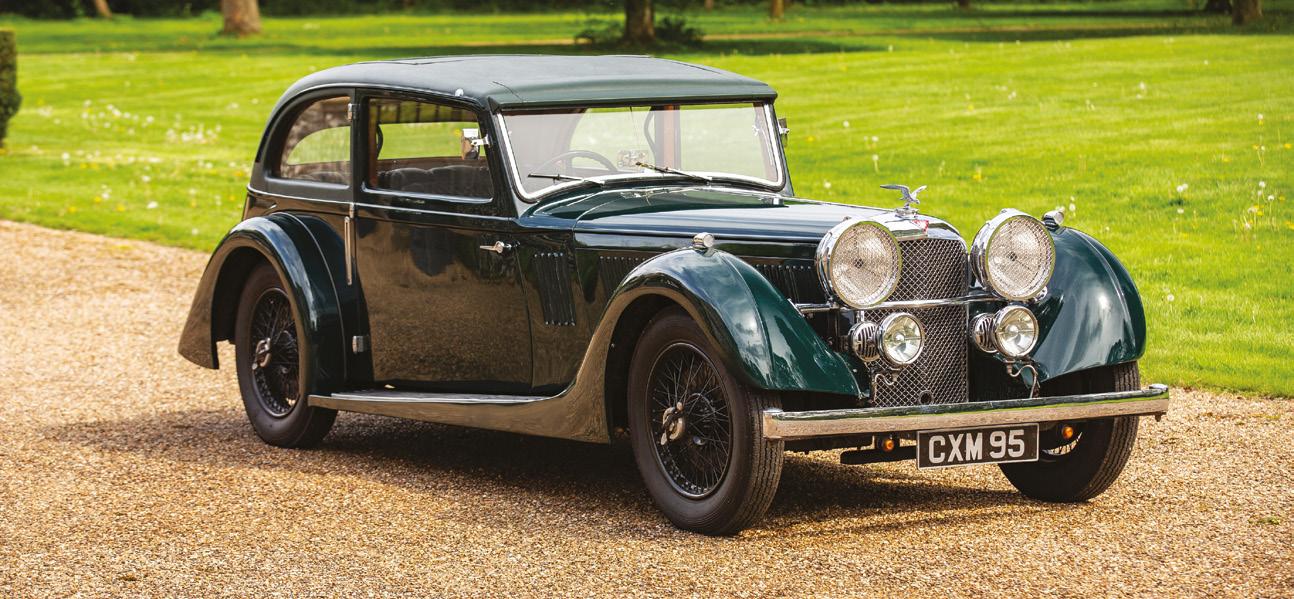

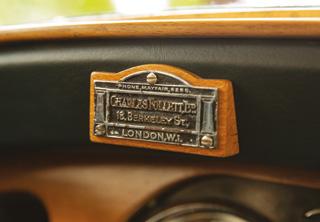


195
The car offered here today is the Alvis Speed 20 Vanden Plas ‘Sunshine’ Coupe, chassis number 13026, a truly exceptional and rare vehicle that has captured the attention of automotive enthusiasts worldwide. Registered as CXM 95 from its inception, this extraordinary coupe was delivered by Charles Follett to its first owner, Mrs. Ida Bond of London, on May 5th, 1936, marking the beginning of its fascinating journey. This remarkable car holds a place in history with a collection of correspondence between one of its previous owners and Mrs. Bond’s son, providing valuable insights into the early days of the vehicle. In the early 1990s, the Alvis underwent a meticulous and comprehensive restoration, bringing it back to its original splendor. Since then, it has been very well-maintained, ensuring its continued beauty and performance. Having been in the possession of its current owner since January 2014, this Alvis Speed 20 Vanden Plas ‘Sunshine’ Coupe is a testament to its rarity. Out of the limited production run of only 12 vehicles, this model stands as one of just two remaining, making it an exceedingly sought-after collector’s item. The car’s captivating exterior presentation is a testament to its restoration, showcasing a flawless and timeless design. Its elegant silhouette is a nod to the golden age of motoring, while the interior exudes luxury and comfort.
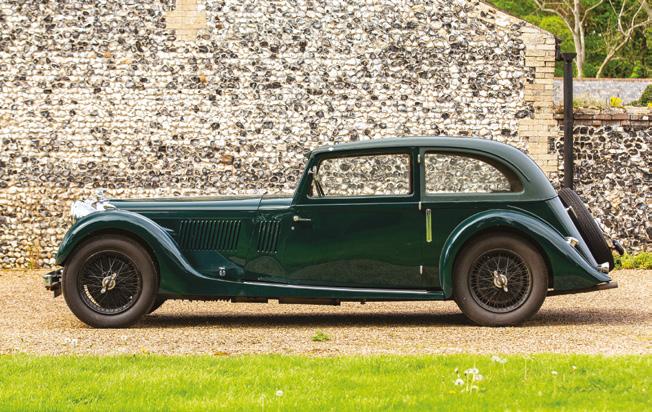
Behind the wheel, drivers will find an unparalleled driving experience, as the Alvis Speed 20 combines superb handling and a remarkable engine note that is sure to delight enthusiasts. This ‘Sunshine’ Coupe represents a rare opportunity to own an automotive masterpiece with a unique history. Its nicely mellowed restoration and outstanding driving performance make it an object of desire for discerning collectors and enthusiasts alike. With its combination of rarity, elegance, and timeless appeal, this remarkable vehicle captures the essence of a bygone era and invites admiration from all who encounter it.
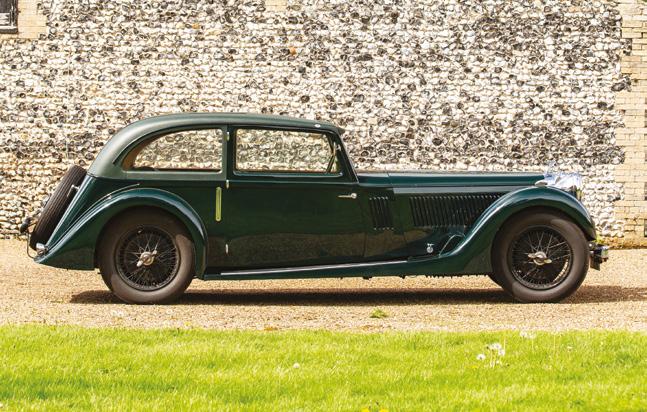
196
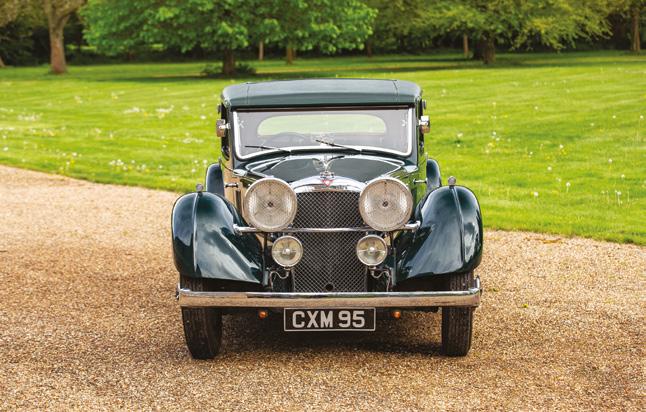
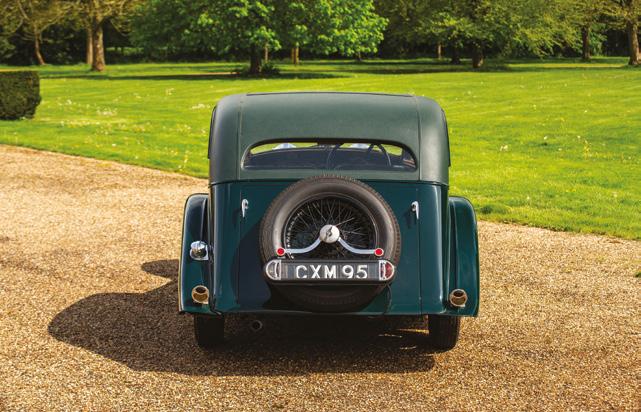

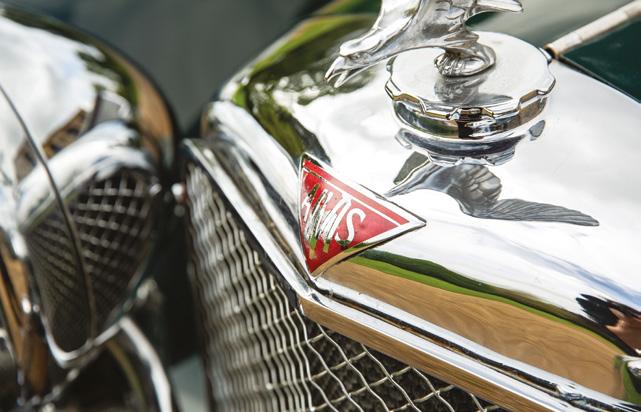
197
1970 Jaguar E-Type Roadster
Estimate: £60,000 - £70,000*
Reg No: ANM 185H MOT: July 2023 Chassis No: P1R12716
Triumphantly unveiled at the 1961 Geneva Motor Show, the Jaguar E-Type created a furore thanks to its supercar performance, stunning looks and modest price tag. Early racing success at the hands of Graham Hill and Roy Salvadori amongst others helped cement the newcomer’s reputation. Built as a monocoque with an engine cradling front sub-frame, the E-type’s combination of all-round independent suspension and disc brakes allied to rack-and-pinion steering resulted in excellent roadholding and handling capabilities. The indomitable straight-six XK twin-cam engine supplied abundant power. If the design had an Achilles’ heel then it was the recalcitrant Moss gearbox. However, Jaguar was quick to correct this shortcoming with a four-speeder of its own design just part of a continual programme of E-Type development that saw the model metamorphose through three Series. Introduced in August 1968, the Series II cars were distinguishable by their revised bumper and light arrangements. Less noticeable was the increased size of the front air intake that in conjunction with dual cooling fans made the Series II better behaved in hot weather and heavy traffic. With its 4235cc engine developing a quoted 265bhp and 283lbft of torque, it was reputedly capable of nearly 150mph and 0-60mph in 7.5 seconds. Available in open two-seater, fixed-head two-seater and fixedhead 2+2-seater guises, the American market accounted for the vast majority of Series II production.
One of the aforementioned American market cars, chassis ‘P1R 12716’ was manufactured on 9 February 1970 and dispatched to British Leyland, New York, USA. Presented in Sable with Beige interior and a black hood, the car remained in the US for 20 years until its import to the UK in 1990, where it was registered as ‘ANM 185H’. An older restoration with history picked up in c.2007, the car is now presented in the attractive combination of Dark Blue with contrasting Red leather interior and has since been subject to significant expenditure by its two previous owners. In previous ownership, ‘ANM 185H’ was looked after by The Jaguar Workshop, with notable works in 2010 including a replacement clutch, replacement mohair hood and more at a cost of over £4,000. In 2011, both floor pans and sills were replaced, the fuel and brake lines replaced, the interior reupholstered, the waterpump replaced and more at a cost of over £8,900 and In July 2013, the car was also subject to a complete rear suspension overhaul with Auto Systems Service.
In current ownership since December 2015, ‘ANM 185H’ was quickly subject to an electric Kenlowe fan being fitted in October the following year. The car has been well looked after almost exclusively by E-Type specialists EAB Classics Cars. The vehicle has been serviced and MOT’d yearly, with notable recent works in current ownership including a differential overhaul along with a service in July 2022 at a cost of £3,292.80. Now showing 92,110 miles on the odometer at the time of consignment, the car is offered for sale due to personal circumstances. Accompanied is a large history file containing the Jaguar Heritage Certificate, a large Routine Maintenance & Lubricants document and the Operating, Maintenance and Service Handbook. As well as this, a large collection of previous MOTs and invoices, with a small written page with a rough history stating total expenditure June 2007 – July 2013 at £23,264.10. The V5C document is also included which displays 7 former keepers and the car has an MOT valid until 26 July 2023.
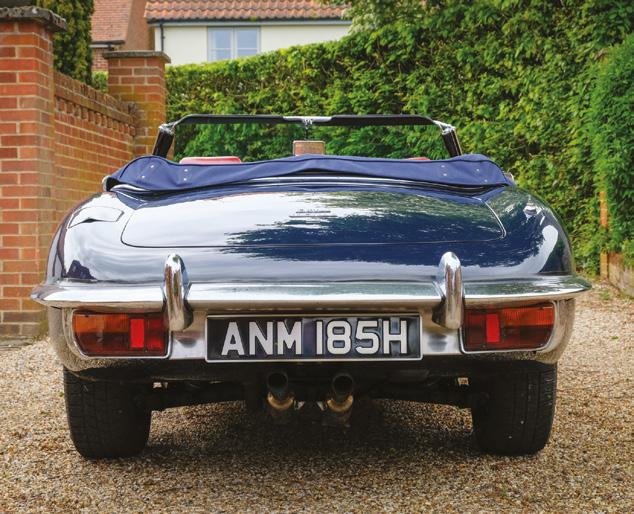
198 *All hammer prices are subject to a Buyer’s Premium of 12.5% plus VAT
122
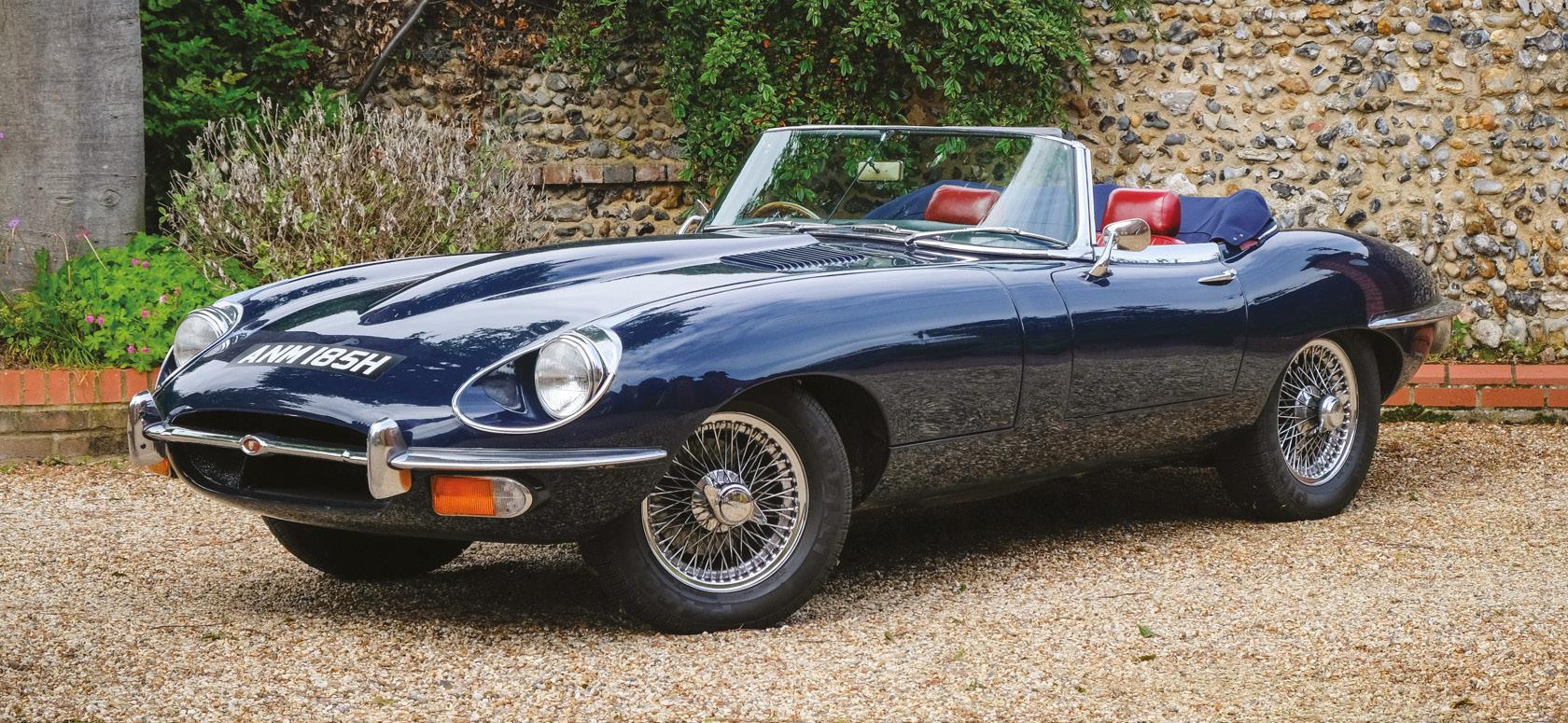

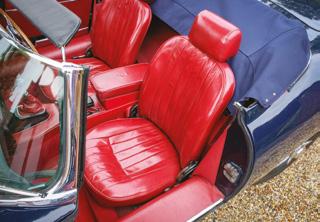
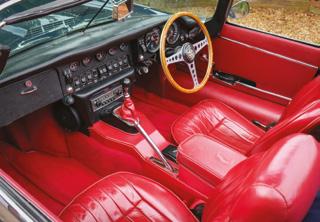
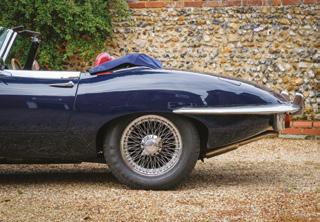
199
1989 Mercedes-Benz 560 SL
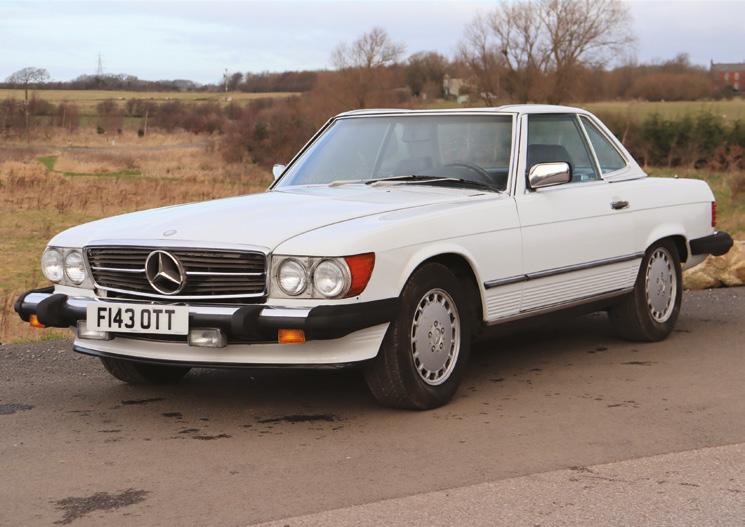
Estimate: £14,000 - £16,000*
Reg No: F143 OTT MOT: July 2023
Chassis No: WDBBA48D1KA092316
The third generation SL (R107) was launched in 1971, initially with just a 3.5-litre engine (350SL) mated to a four-speed automatic transmission. The car featured a two-door monocoque bodyshell with independent suspension and disc brakes all-round. Over its phenomenal 18-year reign, the R107 range was powered by eight different engines - two sizes of straight-six and six versions of Mercedes-Benz’s silky smooth V8. For 1986, Mercedes-Benz produced its most powerful SL of the decade in the form of the V8 powered 560 SL. The car was the heaviest of the 1971-1989 R107 SLs that Mercedes-Benz produced, but the new 5.5 litre, V8 engine with 227bhp did a fine job of mitigating that fact. The top speed was much improved and the car was quicker from a standstill to 60mph by about four full seconds. The V8-powered 560SL was manufactured from 1986 to 1989 and only offered in the US, Japanese and Australian markets.
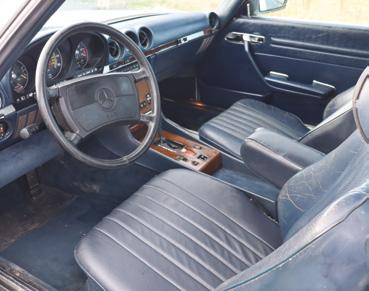
Finished in Arctic White, complemented by a Royal Blue interior ‘F143 OTT’ displays just 67,400 miles, has automatic transmission and is offered with both hard and soft tops. With an interior featuring a driver’s airbag, centre armrest and a rear luggage area, the boot area also offers space for touring luggage and is also carpeted. The boot lid features the US Federal specification high-level third brake light and a fog light has been added for UK regulations. The original owner’s wallet with handbooks and service book, plus V5C, are included in the sale and the SL possesses a current MOT certificate into July 2023.
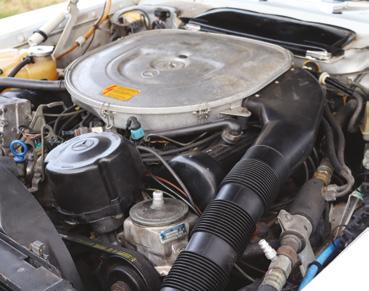
200 *All hammer prices are subject to a Buyer’s Premium of 12.5% plus VAT
123
1985 Rolls-Royce Silver Spirit


Estimate: £13,000 - £15,000*
Reg No: B603 MPH MOT: May 2024

Chassis No: SCAZS0007FCH12699
A square-cut, broad-shouldered design, the Rolls-Royce Silver Spirit was styled in-house by Austrian-born Fritz Feller. Although derived from that of the preceding Silver Shadow, the newcomer’s floorpan offered considerable improvements in both ride and handling thanks to its novel Girling automatic ride height control and gas shock absorbers. By combining copious amounts of sound deadening with the finest quality upholstery, Crewe’s engineers kept intrusion from the 6.75 litre V8 engine and automatic transmission to a muted hush (unless the model’s reputed 120mph potential was explored). Driver inputs were minimised with power-assisted steering and disc brakes. Only in production between 1980 and 1989, just 8,129 Rolls-Royce Silver Spirit Saloons are thought to have been made.
With just c.40,805 miles, and just 2 former keepers since 1985, this wellpresented example was supplied new by H A Fox & Co. of Guildford, in March of 1985. Wearing Royal Blue with Magnolia Hide and trim with Dark Blue hide piping, Dark Blue carpet and Cream Marvelon headlining there is an original bill of sale stating £50,305.00 in 1985. The vendor has described the car as ‘Excellent in all areas’ and a ‘beautiful example’ and describes further how ‘well’ it drives. ‘B603 MPH’ has also just had pre delivery check with a Rolls Royce specialist and they commented on how nice it was underneath and mechanically.
In recent times the Silver Spirit has benefitted from a professional detail and valet and there are 13 Rolls Royce main dealer service stamps (up to 1999) and 8 independent specialist service stamps (up to 2021). A mass of paperwork and old MOTs accompany the car, supporting the mileage, along with the original book pack, tool kit and all associated paperwork, which is comprehensive in nature.
201 *All hammer prices are subject to a Buyer’s Premium of 12.5% plus VAT
124
c.1954 Lea-Francis ‘Tojeiro’
No Reserve
Reg No: 5170 ND MOT: Exempt Chassis No: See Text
What a golden age the 1950s were for fans of sporting machinery. Besides the mainstream models from MG, Triumph, Austin-Healey, et al, there were a plethora of companies offering stylish bodies with which to upcycle a humble Austin Seven or Ford Eight. While, those with deeper pockets were served by a whole cottage industry of up-and-coming racing car constructors. It was an exciting time peppered with names that would enter into motoring folklore: Lotus and Cooper, Costin and Lola, and plenty more. Back-street cars that could give the big boys a run for their money.
Although mainly remembered for the AC Ace, John Tojeiro was a prolific designer whose lightweight frames were famed for their strength and balance. Best known as a chassis engineer, he produced a long line of successful racing cars, most famously in conjunction with the Ecurie Ecosse team. Indeed, the Ecurie Ecosse Tojeiro EE was one of the first sports racers to utilise a mid-engine layout to enhance handling and traction. With the history of the Ace and Carroll Shelby developing it into the AC Cobra, marrying a thunderous American V8 engine with the lightweight British chassis, John Tojeiro’s legacy in the motor industry is unquestionable.
Following email correspondence and telephone conversations with Graham Gauld, the author of ‘Toj, John Tojeiro and His Cars’, we believe that ‘5170 ND’ might be a ‘lost’ Tojeiro, namely chassis TAD 6/54. Commissioned by Ernest Bailey for road use and based around a semi-spaceframe chassis, TAD 6/54 wore Gray & Rich bodywork styled after John Tojeiro-supplied sketches. The initial powerplant was a 2.5-litre Lea-Francis unit but it is understood that Bailey later went racing with a Jaguar 3.4-litre engine. The car was tested at Goodwood by none other than Cliff Davis (whose exploits aboard ‘LOY 500’ did so much to convince the AC board of John Tojeiro’s merits), before competing in sand racing events in the United Kingdom, and then subsequently being sold to Italy.
The car on offer here - which we suspect began life as chassis TAD 6/54 - was eventually road registered as ‘5170 ND’ on 11th September 1961. The accompanying buff-logbook lists the make and model as Lea-Francis Tojiero (sic) and quotes a chassis number of ‘AB 8861’. The same letter and number sequence appearing on a plate affixed to the structure. The latter’s origins are unknown but may or may not have something to do with A.B. ‘Barrie’ Price’s purchase of the Lea-Francis name around that time. The engine with which the car was road registered (and the one it retains today) is a Lea-Francis 1.8-litre unit.
Designed by Harry Rose, the four-cylinder powerplant features twin, high-set camshafts and was also to be found in Connaught’s A-Type single-seaters and L-Type sports racers. The example aboard ‘5170 ND’ is conjectured to have once run on methanol. Again, it is supposition, but the two-seater is thought to have been first bodied in alloy. However, at some stage fibreglass front and rear clips have been fitted (possibly due to a racing accident). The central tub is aluminium and deemed original.

Joining the vendor’s late father’s impressive West Country-based collection during the mid-1980s, ‘5170 ND’ has lain dormant as a ‘one day’ project for the past four decades. Albeit the seller has made various enquiries about its potential past. Early photographs on file show the two-seater testing or competing at Lydden Hill Race Circuit, and on airfield tracks (possibly Blackbushe or Mildenhall). Interestingly, Mr Gauld has confirmed that TAD 6/54 ran on wire wheels of a similar type to those sported by ‘5170 ND’. The previous owner’s son has also been in touch to say that the car remained active in competion up until the late 1970s. In addition to the aforementioned buff logbook, the ‘Lea-Francis Tojiero’ comes with a 1970s-issued MOT and an oldy-type V5 Registration Document. A very interesting potential entry into the 1950s drum brake race series and temptingly offered without reserve.
With thanks to Graham Gauld for his assistance in the research.
202 *All hammer prices are subject to a Buyer’s Premium of 12.5% plus VAT
125
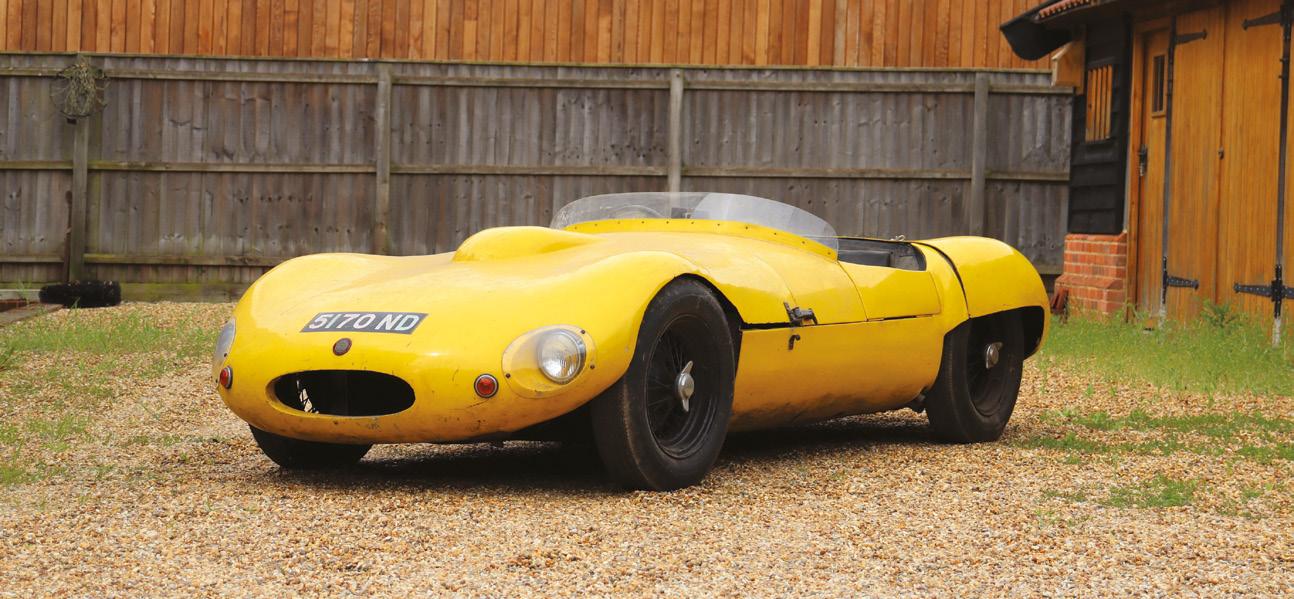


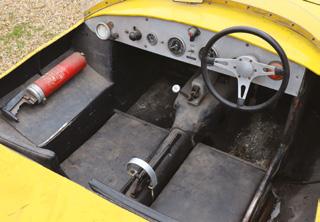
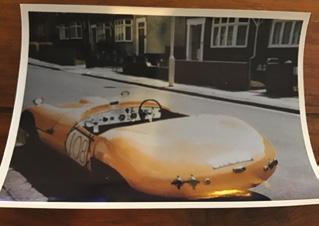
203
1934 Alvis Silver Eagle Special
Known as the ‘’Ashby Eagle’’

Estimate: £40,000 - £50,000*
Reg No: US 6102 MOT: Exempt Chassis No: 11429
Introduced in 1935, the Alvis Silver Eagle SG 16.95 shared a number of design features with the marque’s legendary Speed 20 model. Based - like its illustrious sibling - around a double-dropped ladder-frame chassis equipped with all-round semi-elliptic leaf-sprung suspension and fourteen-inch cable-operated drum brakes, it was powered by a smaller capacity version (2362cc vs. 2511cc) of the same triple SU carburettor fed OHV straightsix engine. Employing a shorter wheelbase than its sportier forebear, the Silver Eagle SG had the further advantage of an all synchromesh four-speed manual gearbox. Available with a choice of open or closed coachwork by the likes of Cross & Ellis and Holbrook, the Silver Eagle SG was a strong yet refined performer in the best traditions of the Coventry manufacturer.
The “Ashby Eagle,” an extraordinary Alvis special, carries a rich and factual history that adds to its allure. Originally delivered to J.H. Galt Ltd of Glasgow on April 28th, 1934, it began its life as a Sports Saloon by Cross & Ellis. However, in the 1980s, it underwent a significant transformation under the ownership of Mr. Ashby, when it was rebuilt and rebodied as a Special by Comptons of Welshpool. As the “Ashby Eagle,” this remarkable vehicle garnered recognition and became well-known within the automotive community. It was fitted with a notable “Crested Eagle” triple carburettor engine, which added to its performance and distinction on the road. In the 2000s, the engine underwent a full rebuild, with meticulous attention to detail carried out by Alvis specialist Red Triangle. The accompanying collection of invoices from this reputable source stands as a testament to the thoroughness of the restoration, ensuring the vehicle’s optimal performance and reliability. The “Ashby Eagle” comes with a large and comprehensive history file, containing historical notes from previous owners. This valuable documentation provides insight into the car’s journey through time, enhancing its historical significance and appeal to enthusiasts and collectors. With its fascinating backstory and notable transformation, the “Ashby Eagle” holds a prominent place within the Alvis Owners’ Club.

204 *All hammer prices are subject to a Buyer’s Premium of 12.5% plus VAT
126

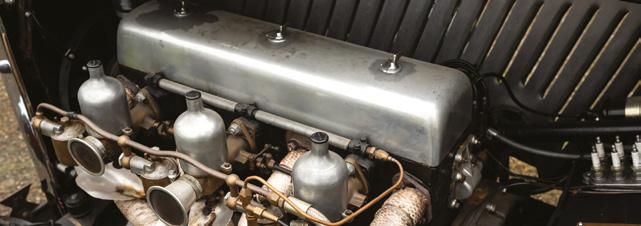

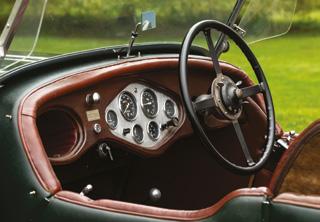
205
1954 Bentley R-Type
Subject of c.£60,000 in refurbishments since 2015.
Estimate: £23,000 - £28,000*
Reg No: EGC 748B MOT: Exempt Chassis No: B140YD
An obvious evolution of its MkVI predecessor, the Bentley R-Type was introduced at the 1952 Earls Court Motor Show. Subtly reworked from the previous model by inhouse stylist John Blatchley, it boasted a notably larger boot and reprofiled rear wings. Switching from riveted to welded frame construction at chassis B349TO, the newcomer featured independent coil-and-wishbone front suspension, a leaf-sprung ‘live’ rear axle and servo-assisted four-wheel drum brakes (hydraulic front / rod rear). Powered by a ‘big bore’ 4566cc straight-six inlet-over-exhaust engine allied to either four-speed manual or automatic transmission, the R-Type was a surprisingly strong performer, able to reach more than 100mph. Praised by the contemporary motoring press for its high-speed handling and well-appointed interior, the model remained in production until 1955 by which time some 2,017 Standard Steel Saloons are thought to have been made with many features the same as the R-Type continental.
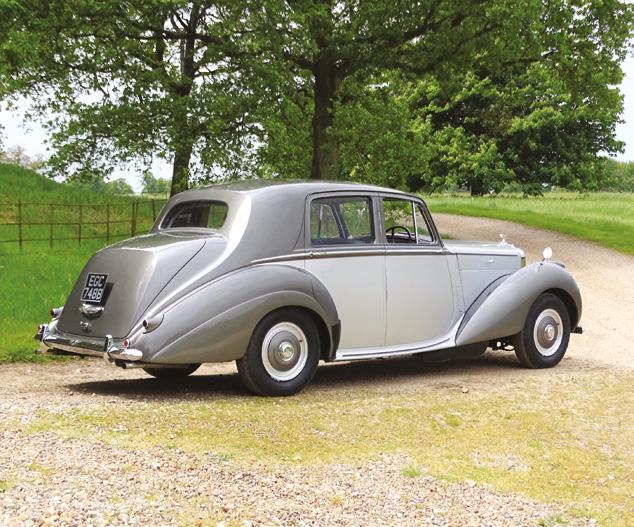
Chassis number B140ZY passed its final inspection at the Bentley factory in Crewe in August 1954, being supplied new to its first owner, Major E.H. Spalding through Main Dealer Bennetts Ltd. on the 8th of September that year. Specified from new with an automatic gearbox and trafficators, and being finished in Shell Grey over Tudor Grey with a Light Blue Connolly hide interior upholstery piped in Blue, complemented by Grey Wilton carpets and a Grey cloth headlining, unfortunately little further is known of the Bentley’s early history. Subsequently known to have been owned in the early 1980s by a Bentley Drivers Club member who based in Bermuda, the car was then sold in November 1999 to a British owner who resided in Mulhouse, France. It appears that sometime around 2015 he sold the car to a member of his family in Canada who then spent close to £60,000 with Rolls-Royce & Bentley Specialists The Beaconsfield Workshop over the next few years to carry out a comprehensive cosmetical and mechanical renovation, incorporating body refurbishment and repaint, suspension, brakes, cooling system and ignition system overhauls, interior wood veneers refurbishment and rejuvenating the leather interior together with replacing the interior headlining.
With a recorded mileage of c.49,700 miles, the Bentley is offered with the original tool kit and under-bonnet torch, copies of the build records, a collection of invoices detailing the extensive works completed in the last decade and a current V5C document. Rated by the vendor as ‘very good’ in regard to engine, gearbox, and electrical equipment, with the interior trim, bodywork, and paintwork all equally rated as ‘very good’, the R-Type has recently been serviced by Bentley Specialists the Beaconsfield Workshop and drove exactly like a proper R-Type should during the photoshoot.
206 *All hammer prices are subject to a Buyer’s Premium of 12.5% plus VAT
127
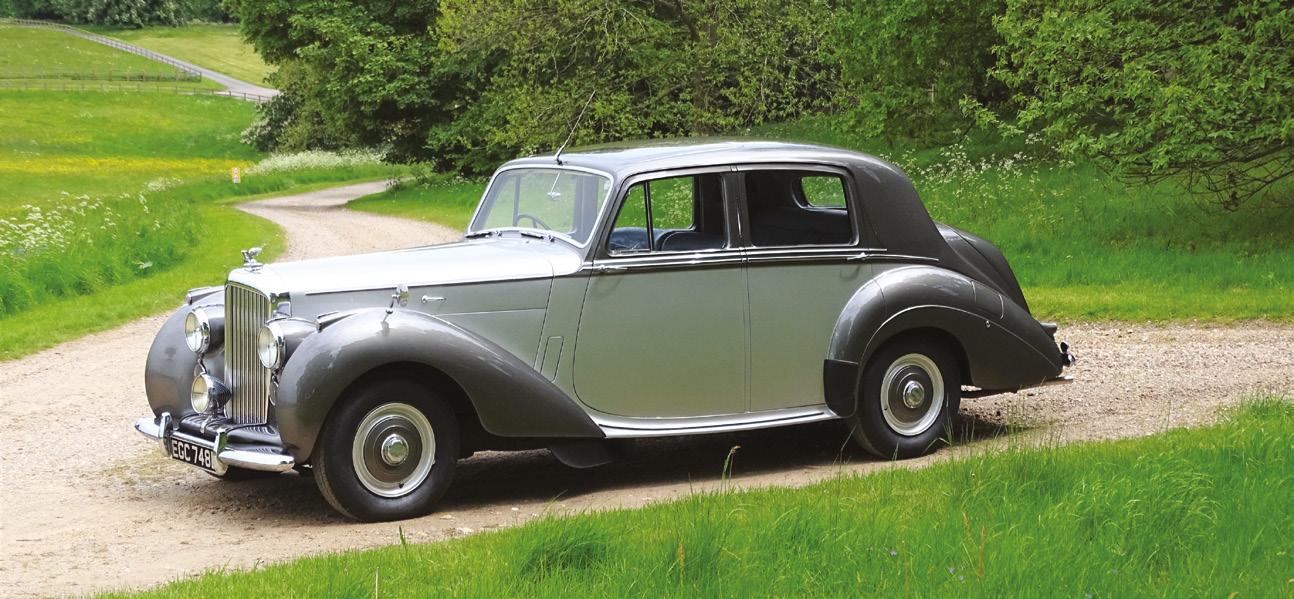

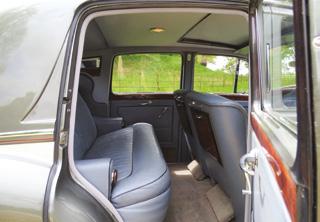

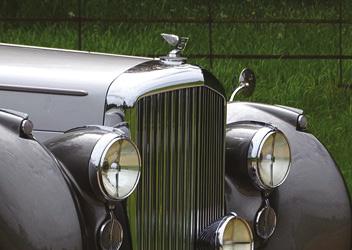
207
1970 Jaguar E-Type 4.2 Litre Roadster

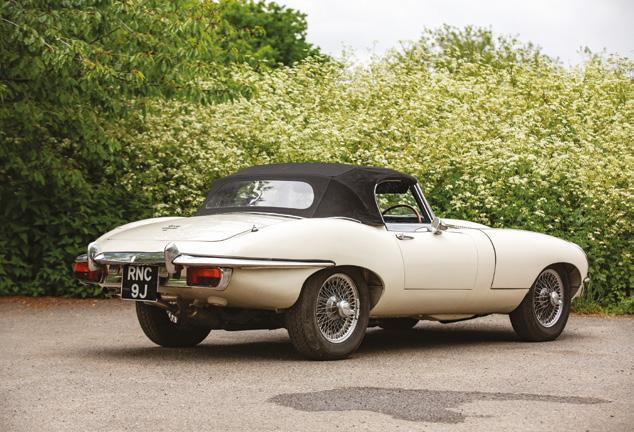
Subject of an older restoration
Estimate: £60,000 - £70,000*
Reg No: RNC 9J MOT: Exempt Chassis No: 1R1659
Triumphantly unveiled at the 1961 Geneva Motor Show, the Jaguar E-Type created a furore thanks to its supercar performance, stunning looks and modest price tag. Early racing success at the hands of Graham Hill and Roy Salvadori amongst others helped cement the newcomer’s reputation. Built as a monocoque with an engine-cradling front sub-frame, the E-type’s combination of all-round independent suspension and disc brakes allied to rack-and-pinion steering resulted in excellent roadholding and handling capabilities. The indomitable straight-six XK twin-cam engine supplied abundant power. If the design had an Achilles’ heel then it was the recalcitrant Moss gearbox. However, Jaguar was quick to correct this shortcoming with a four-speeder of its own design just part of a continual programme of E-Type development that saw the model metamorphose through three Series. Introduced in August 1968, the Series II cars were distinguishable by their revised bumper and light arrangements. Less noticeable was the increased size of the front air intake that in conjunction with dual cooling fans made the Series II better behaved in hot weather and heavy traffic. With its 4235cc engine developing a quoted 265bhp and 283lbft of torque, it was reputedly capable of nearly 150mph and 0-60mph in 7.5 seconds. Available in open two-seater, fixed-head two-seater and fixedhead 2+2-seater guises, the American market accounted for the vast majority of Series II production.
According to its accompanying Jaguar Daimler Heritage Trust certificate, chassis 1R1659 was originally finished in Cream with a Red leather upholstery and a Black hood; the same combination it pleasingly sports today. Completed on 22nd April 1970, ‘RNC 9J’ was sent to Jaguar dealer Parkers on the 5th May and delivered to its first owner in March 1971. Having had only a few owners in its life, the decision was made to embark on an extensive restoration in 2015. This included, but was not limited to, a full body-off bare-metal repaint with replacement panels being sourced where needed, together with a full engine, gearbox and suspension overhaul, which is evidenced in the History File. Furthermore, in recent years the car has been regularly looked after by marque specialists. Retaining its original and nicely mellowed Red leather interior, and an odometer showing 17,000 unwarranted miles, ‘RNC 9J’ has much to recommend it. Reportedly as sound underneath as it is on top, this tempting E-Type Roadster, said by the vendor to sound and drive as well as it looks, is offered for sale with a V5C Registration Document together with a large history file containing invoices and photographic records of the full restoration in 2015/2016, a JDHT Certificate, assorted invoices and MOT certificates dating back to 2015.
208 *All hammer prices are subject to a Buyer’s Premium of 12.5% plus VAT
128
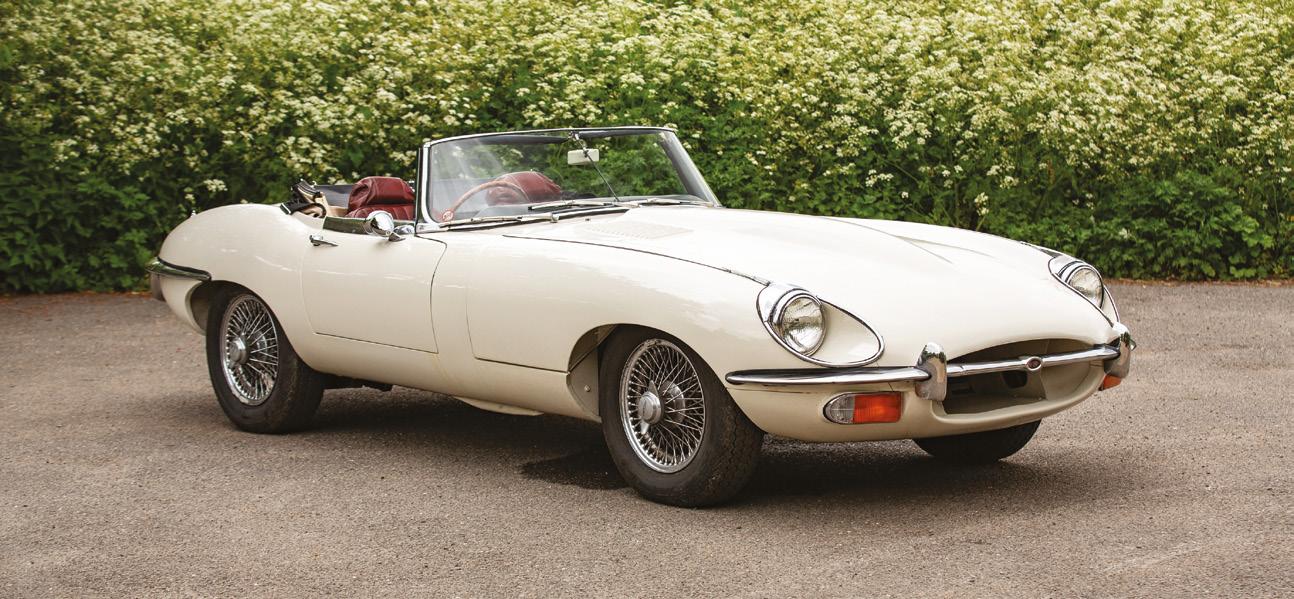
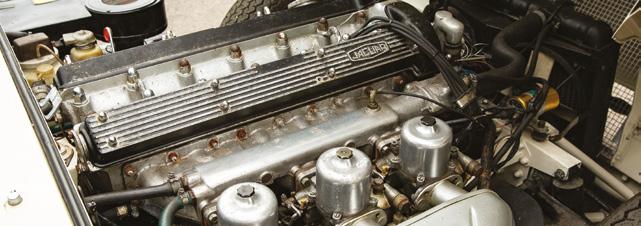
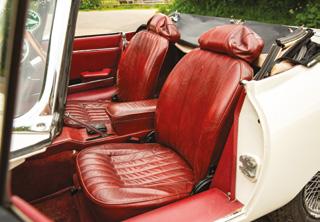

209


210
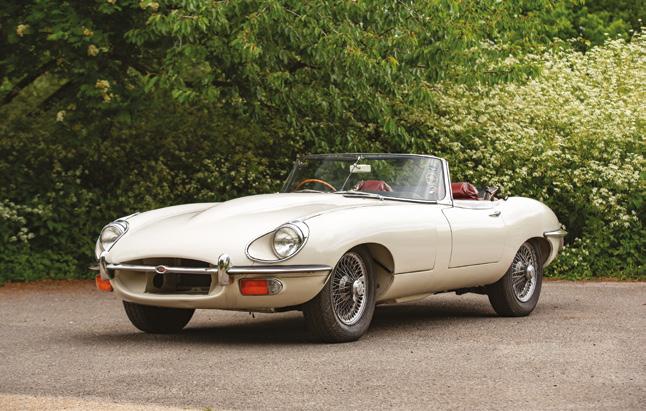
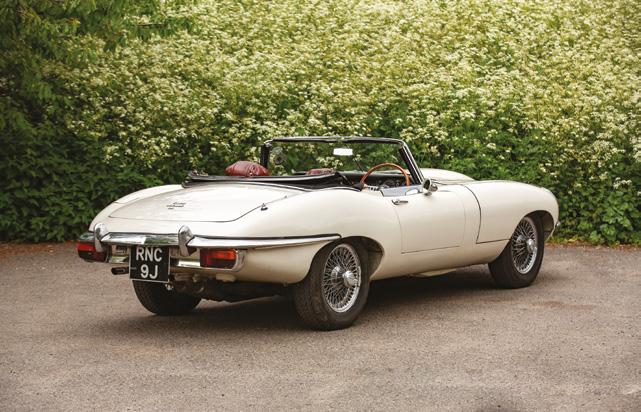
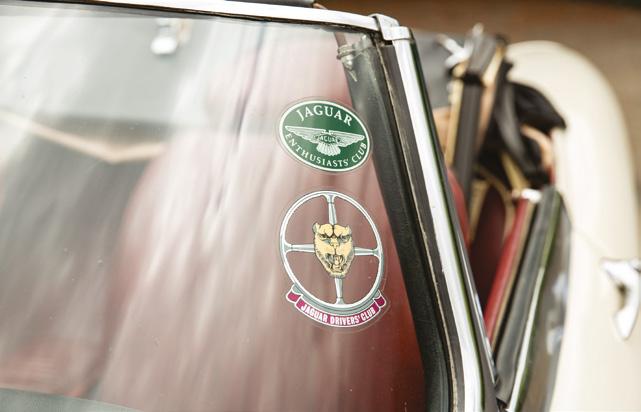
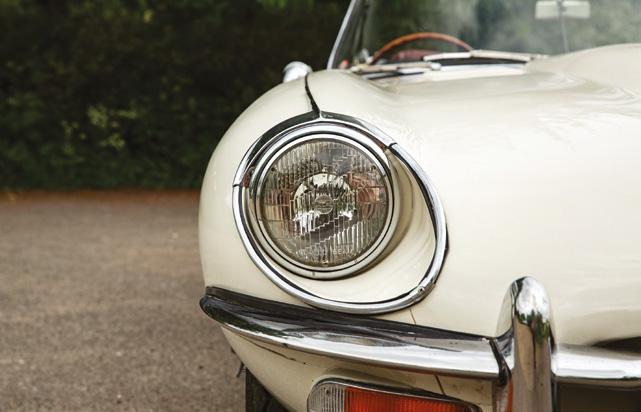
211
1933 Lagonda M45 Tourer

Estimate: £100,000 - £120,000*
Reg No: JSK 535 MOT: Exempt Chassis No: Z10512
Introduced at the 1933 Olympia Motor Show, the M45 remains for many the ultimate sporting Lagonda. Derived from that of its 3-Litre ZM series predecessor, the newcomer’s chassis was very much Vintage in flavour featuring a 10ft 9in wheelbase, all-round semielliptic leaf-sprung suspension and four-wheel drum brakes. Doubtless influenced by the Monte Carlo Rally win and Brooklands triumphs that Invicta had achieved since fitting the proprietary Meadows 6ESC 4453cc OHV straight-six engine to its products, Lagonda chose to install the same powerplant and associated Meadows T8 four-speed gearbox aboard the M45. The result was among the fastest cars that money could buy with closed examples able to exceed 90mph and open ones, given the right conditions, punching past 100mph. Contemporary reports in Autocar and Motorsport magazines praised the Lagonda’s ‘brilliant acceleration and sheer performance’ as well as its ‘high power-toweight ratio’ and ‘easy running in a way that can be achieved to the fullest extent only by a big-engined machine working well inside its limits’. The Staines manufacturer had amply demonstrated this latter point during pre-production testing when a prototype took fourteen hours less to cover the 1,500 miles between Dieppe to Brindisi than an express train! Arthur Fox and Bob Nicholl whose specially prepared Roesch Talbot 105 cars had done so well in international races and rallies were quick to spot the potential in the new Lagonda. A trio of shorter wheelbase, skimpily bodied and tuned M45 racers took the Team Prize at the 1934 Ards TT with one of their number claiming outright victory at the following year’s Le Mans 24 hours against Alfa Romeo 8C 2300 opposition (the Fox & Nicholl Team Cars’ specification inspired that of the M45 Rapide). Understandably popular not just with sporting motorists but also racing drivers and celebrities, some 410 Lagonda M45s (and 53 Rapides) were made from 1933–1935.
According to information kindly supplied by the Hon Registrar and Vice Chairman of the Lagonda Club, Arnold Davey Esq., chassis Z10512 was supplied new via Warwick Wright Ltd to G. Potter Esq of The Guards Club, Brook St, London on December 1st 1933. Bodied as a Close Coupled Saloon (also known as a Honeymoon Coupe) and road registered as ‘AXA 129’, the M45 returned to the Staines service department for maintenance up until 1951 by which time it had passed through the hands of Mr Archibald of Hanover Terrace, Regents Park, Basil Heathcote Lepine-Williams Esq. of Coventry and Percy W. Parr Esq. of Benthall House, Broseley, Shropshire.
Interestingly, work carried out by the factory included replacing the car’s original engine with a LG6 unit (both were derived from the Meadows OHV 4½ litre straight-six but the later powerplant was considerably more powerful due to its revised cylinder head design and twin magneto ignition etc).
Known to the Lagonda Club since 1956 when A.J. Boxton Esq. of Highcliffe, Hants acquired it, the M45 was converted into a Drophead Coupe shortly thereafter. Subsequently belonging to A.G. Sparrow Esq of Henley-on-Thames and W.R. Alexander Esq. of Sheffield, the latter is understood to have campaigned it with the Vintage Sports Car Club during the 1960s and 1970s complete with a skimpy two-seater body and the number plate ‘UV 5’. Bought by David Taylor Esq. of Birkenhead during 1986, he commissioned the renowned marque specialist Peter Whenman of Vintage Coachworks to fabricate and install the current body. Faithfully modelled on the factory’s T8 Tourer design, the full flowing wings, cutaway doors, fold flat windscreen and sloping tail make it look every inch a 1930s sports car. Passing to J.R. White Esq of Kidderminster in 1993, the Lagonda was fettled by Fisher Restoration, the Shropshire Car & Engineering Co, Mike Fisher Restoration Ltd, Brewster Mudie Ltd and Vintage Sports Cars of Lymington. As well as routine servicing, the four-seater was uprated with an Alvis 4.3 Litre allsynchromesh gearbox (an accepted modification) not to mention receiving attention to its clutch, water pump, magnetos, Andre Hartford shock absorbers, fuel pumps and track rods ends etc.
212 *All hammer prices are subject to a Buyer’s Premium of 12.5% plus VAT
129
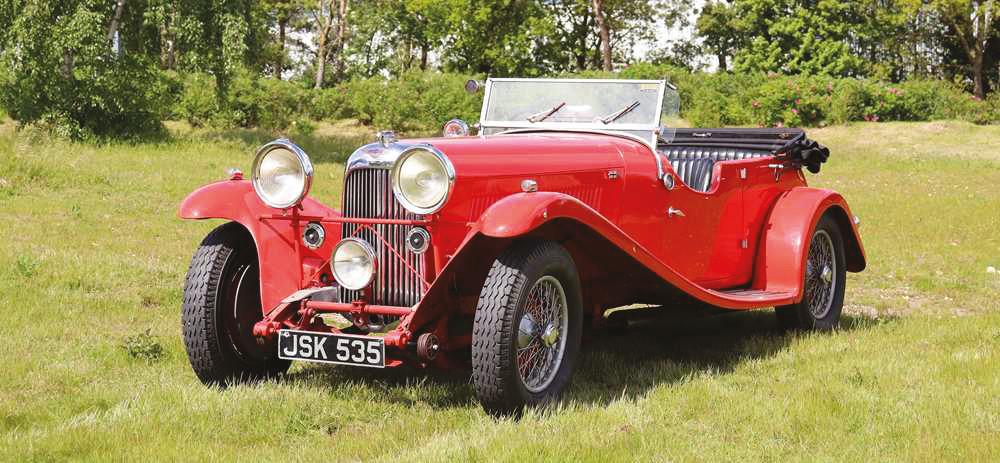

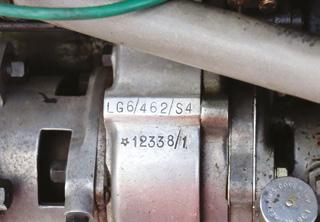

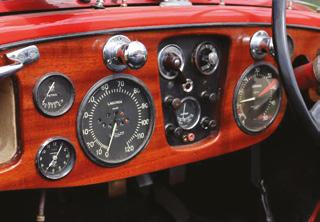
213
Mr White successfully applied for a VSCC ‘buff form’ and drove the M45 up Shelsey Walsh on several occasions during the 1990s but never circuit raced it. Inherited by his son, the Lagonda was treated to an external bare metal repaint in 2014 at a cost of some £16,479.60. Entering the current family ownership the following year via Beaulieu Garage for the princely sum of £162,500, the four-seater has been kept garaged as part of a small collection. Re-registered as ‘JSK 535’ since the 1970s, the Lagonda started readily and ran well during our recent photography session. The paintwork is notably smart, while the Black leather upholstery, which is thought to date back to the mid-1980s, now has a gentle patina to it. With its more potent ‘Sanction IV’ engine, sought after Alvis all-synchromesh gearbox and nicely wrought Peter Whenman coachwork, this handsome M45 has much to recommend it. Looked after in recent years by Connaught Cars, ‘JSK 535’ is accompanied by a V5C Registration Document and history file (encompassing copy factory records and numerous invoices etc).
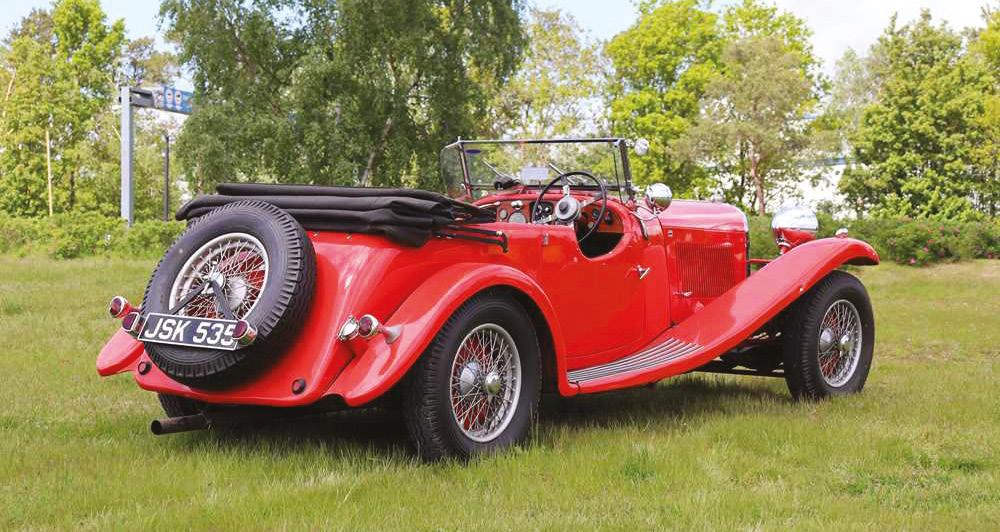
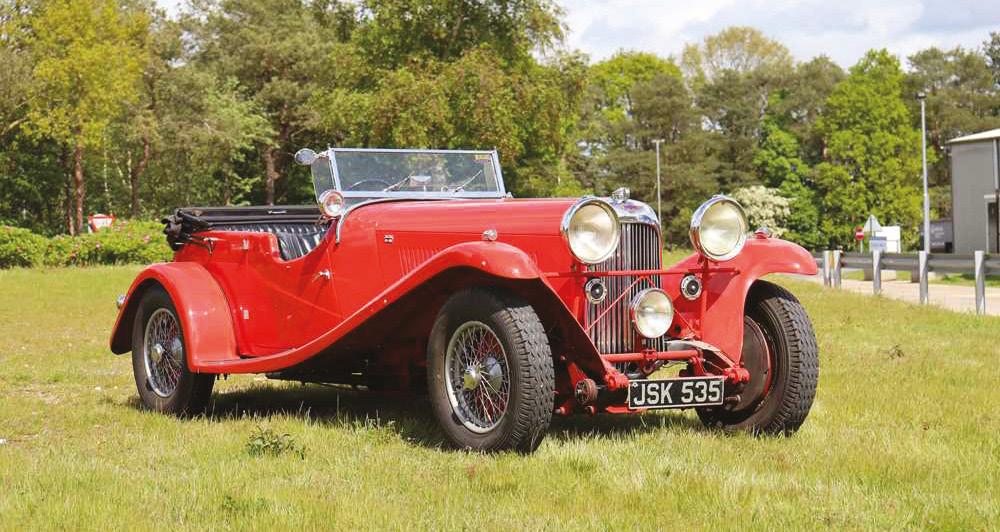
214
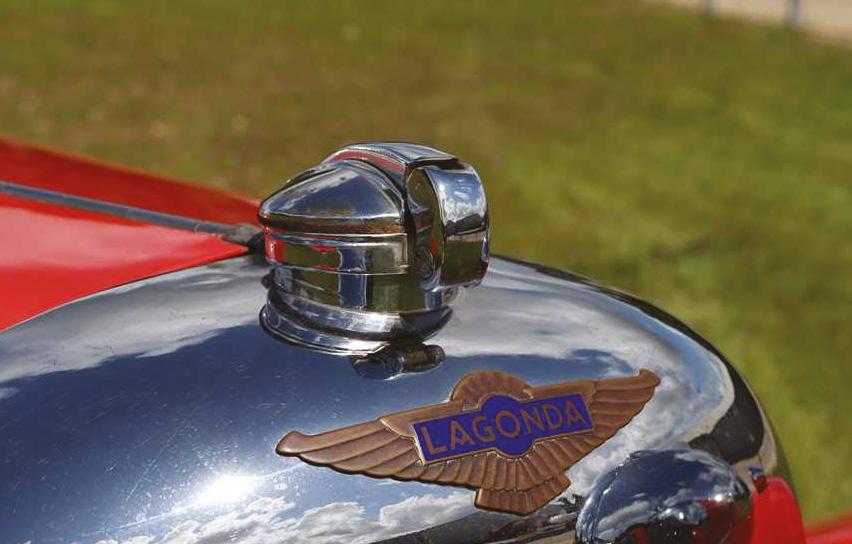


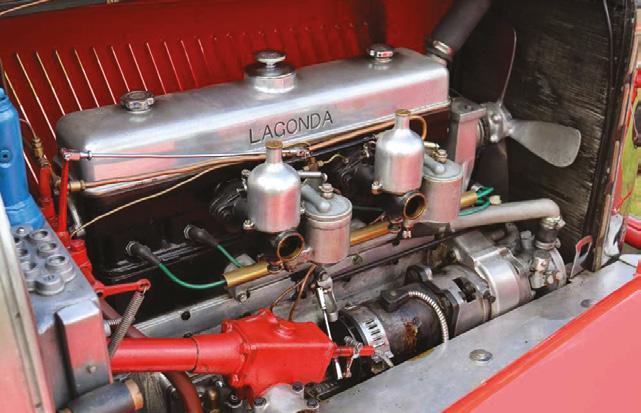
215
1950 Bentley MKVI Sports Saloon

Coachwork by Freestone & Webb
Estimate: £28,000 - £32,000*
Reg No: MGO 628 MOT: Exempt Chassis No: B297FU
Bodied as an elegant four-door Sports Saloon by Freestone & Webb, chassis B297FU began life in London (or so its `MGO 628’ number plate would imply). According to a copy of the Chassis Specification Works Instruction held on file it was dispatched on 4 February 1950 with the customer recorded as ‘RR Stock’ and first registered on 28th of April that year. Not much is known of its early history, although a 1988 dated letter in the history file from Jack Barclay Ltd to a previous owner advises they first sold the car in 1955 at 36,000 miles, again in 1956 at 45,000 miles, once again in 1958 at 60,000 miles and finally in 1962 at 69,000 miles. At the time, the owner noted the 1988 mileage as being c.90,000. A Green continuation RF60 log book records further Sussex-based owners in the mid-1960s and by the 1980s correspondence shows the car was owned by a Mr Rinsey Mills of Bideford, Devon. By 2004 the car was residing in Alvaston, Derby and a number of invoices are present in the history file covering this period. In 2014 ‘MGO 628’ was acquired by the vendor from our Spring auction held at Duxford and has formed a part of his private collection ever since.
Finished in Black over Silver with Blue-piped Grey leather upholstery, the car comes with a quantity of paperwork including various correspondence, invoices dating back to 1988, assorted expired MOT certificates from 2007 onwards, RF60 continuation logbook, Jack Barclay car specification sheet, workshop copy manual covering general information, rear axle, cooling and fuel systems, electrical system, steering, gearbox, prop shaft, brakes & front suspension, together with an original handbook.
Introduced in 1946, the MkVI was Bentley’s first post-war model. Aimed at the emerging ‘owner-driver’ luxury car market, the newcomer was closely based on the 1939 MkV (of which only fifteen were produced). Built around a massive cruciform-braced chassis with independent front suspension and a leaf-sprung ‘live’ rear axle, it was fitted with a freshly developed 4257cc OISE (overhead inlet side exhaust valve) straight-six engine mated to a four-speed manual gearbox. Capable of over 100mph when clad in the factory’s understated ‘standard steel saloon’ coachwork, the MkVI quickly developed a reputation for being a refined yet responsive drive. However, despite the excellence of the ‘basic’ car, there remained a core of marque enthusiasts who found its styling too anonymous and more attractive coachbuilt examples in both Saloon, Coupe and Drophead Coupe form were specified from such notable names such as HJ Mulliner, Vanden Plas, Park Ward, Freestone & Webb etc.
Freestone & Webb, who were chosen to clothe the sports saloon offered today, had been founded in 1923 by V E Freestone & A J Webb. From premises in Willesden, North London they crafted some notable designs on Bentley and Rolls-Royce chassis amongst numerous other marques and pioneered both ‘Top Hat’ and ‘Razor Edge’ styling before Mr Webb’s death in 1955 saw a gradual demise of the company and its acquisition by the Swain Group. It was subsequently sold on to Harold Radford in 1963 but the days of the artisan coachbuilder were already drawing to a close.
216 *All hammer prices are subject to a Buyer’s Premium of 12.5% plus VAT
130
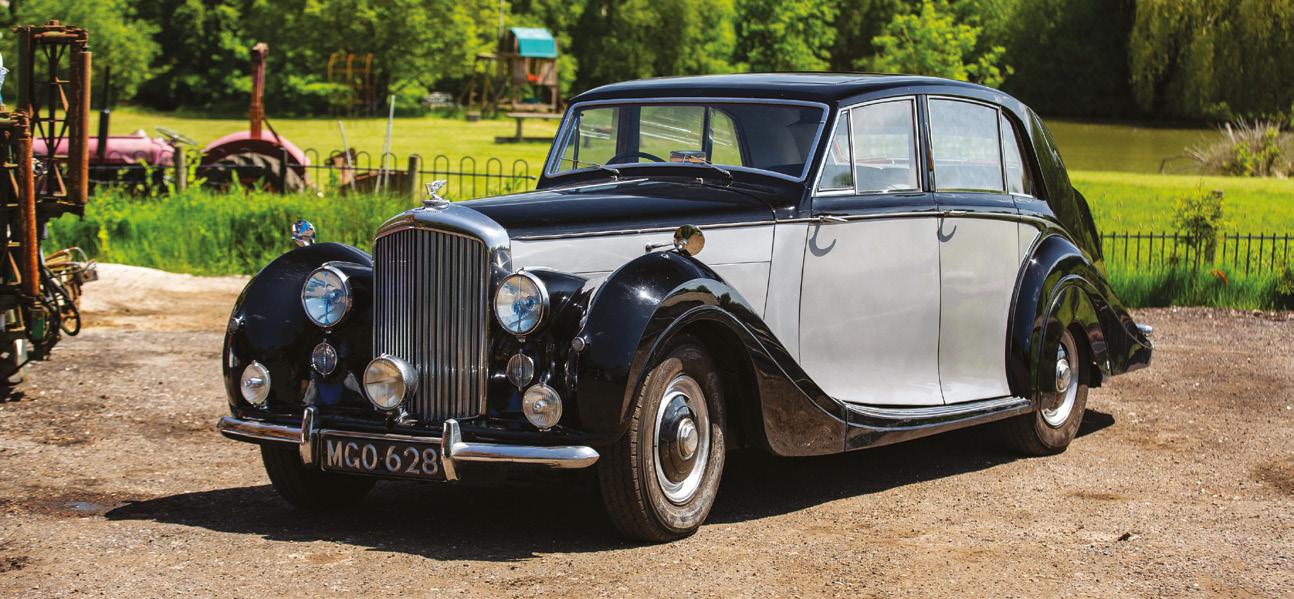

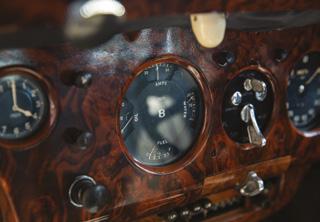


217
1971 Daimler 4.2 Sovereign
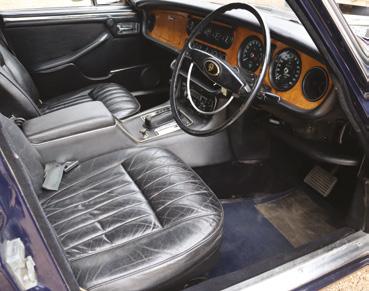
Estimate: £14,000 - £18,000*
Reg No: PJE 232J MOT: March 2024
Chassis No: 1U3547BW
Jaguar launched its XJ model range in September 1968 and it was the last Saloon able to boast the input of the company’s founder, Sir William Lyons. The XJ was the marque’s flagship, the Daimler Sovereign derivative was introduced in October 1969 as a replacement for the Sovereign 420. Externally virtually identical to its Jaguar sibling, apart from its fluted radiator grille and Daimler badging, the new Sovereign was initially offered with the choice of either a 2.8 or 4.2-litre version of the ubiquitous XK DOHC engine.
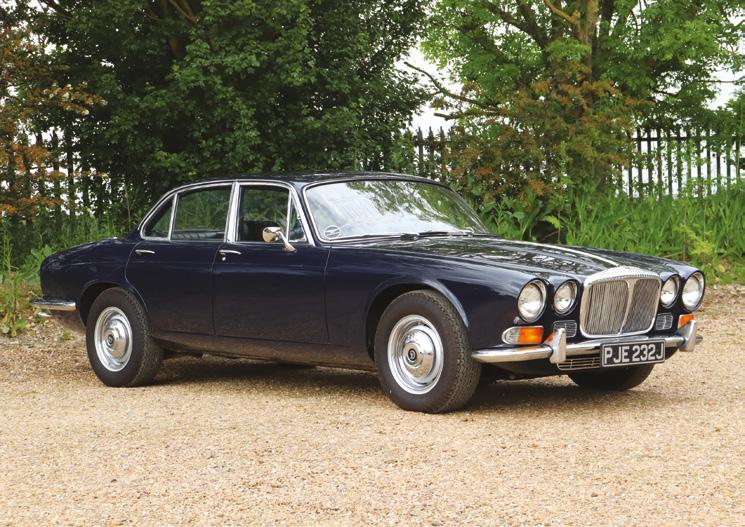
Manufactured on the 21st of December 1970, ‘PJE’ was dispatched on the 25th January, 1971 and supplied to its first owner, ‘Slater Donning Swann’, by Wallis & Son of Cambridge. Today, the Sovereign still presents in Dark Blue paintwork with a Black leather interior, as per the JDHT Certificate information on file. The vendor’s father actually sold ‘PJE’ brand new in 1971, when he was a director at Wallis & Son, who were, at the time, main distributors for Jaguar Daimler, Rover, Land Rover and Triumph, Lancia and Rolls-Royce.
Now displaying some 102,000 credible miles, in recent years, the Sovereign has benefitted from a glass-out restoration (c.2017), and done very little mileage since, with a large photographic record of the restoration process on file. The wheels have also been refurbished and shod with new tyres and the head gasket was done, along with a replacement alternator assembly, thermostat, hoses plugs and oil filters in July of 2022, with an invoice from Jagutek Ltd on file, for just shy of £3000.
‘PJE’ is offered with some original literature that includes a colour chart, sales brochure, poster and wiring diagrams. With a current MOT running into March of 2024, there is also a collection of old MOTs dating back to 1986 (at 66,473 miles). Additionally, there is the owner’s wallet, handbook, a collection of invoices from the c.2017 restoration work and the aforementioned JDHT Certificate.
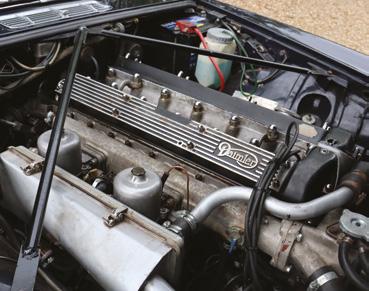
218 *All hammer prices are subject to a Buyer’s Premium of 12.5% plus VAT
131
1926 Standard V3 Coventry Tourer
Estimate: £12,000 - £14,000*
Reg No: BF 8900 MOT: Exempt
Chassis No: 57495
There are various explanations for the company name, from the cars being assembled from ‘standardised patterns and interchangeable parts’ to the founder, Reginald Walter Maudslay, proclaiming he ‘was determined to maintain the best possible standard’. Whatever, success came its way and in 1924 production reached 10,000 cars, earning it a market share, comparable to that of the Austin Motor Company. The models produced in the ‘20s were named after English towns - not just those local to the factory, such as Canley, Kenilworth, Warwick, Coventry, but some much further afield, eg Teignmouth, Falmouth and Exmouth. Their trademark being a distinctive shouldered radiator adorned with a Union Jack badge which they adopted in 1908.
This 1926 Standard V3 Coventry Tourer was exported to Australia, when new, for its first registration. As such, export vehicles, such as those going to Australia, were fitted with a fan. Modifications also included traffic indicators and two brake lights. There are some early photographs of the car time in Australia. The four-seater body is of the English touring style with a roof that retracts fully.
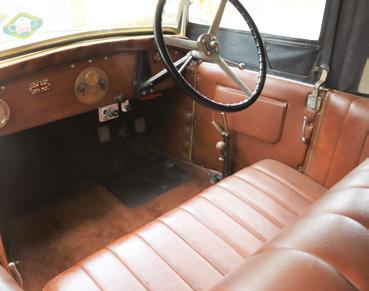
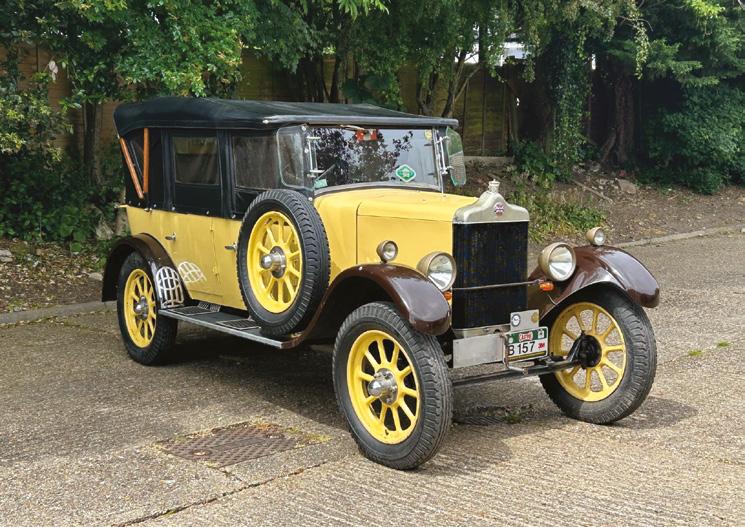
The Tourer was powered by the 11.4hp, 4 cylinder OHV engine with exposed pushrods and rockers and running a Zenith carburettor, Lucas Magneto ignition and a 6v generator. We believe this example was professionally restored for Australia’s Bi-Centenary Celebration Rally of 1988, whereafter it is thought to have participated and completed and completed the full distance.
Repatriated to the UK from Australia in 2019, Cranmore GT Limited of Wythall in the West Midlands carried out work to ‘recover from storage and then recommission’. The engine had not been running due to the magneto, so the magneto was tested, refurbished, rebuilding and after fitting, the timing was then re-set. There is an invoice on file for c.£700 from April 2022. A copy of owner’s manual and the previous magneto overhaul invoice are on file.
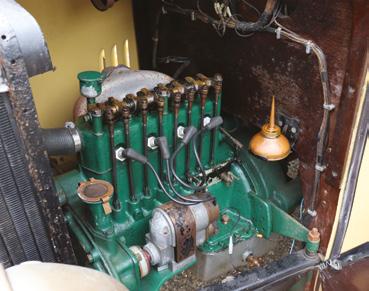
219 *All hammer prices are subject to a Buyer’s Premium of 12.5% plus VAT
132
1958 Bentley S1 Saloon
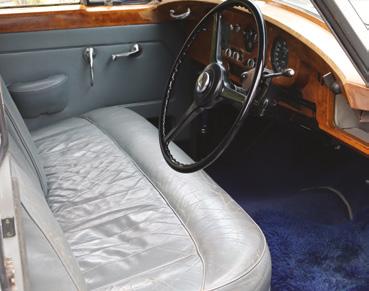
Estimate: £12,000 - £14,000*
Reg No: T.B.A MOT: October 2023
Chassis No: B265EK
The Bentley S1 was unveiled in April 1955. A very different car from its predecessors, it was longer and wider and based on a much stiffer chassis. Though the traditional body-on-chassis construction facilitated the manufacture of special-bodied versions, most were delivered with the standard offering produced by Pressed Steel Ltd, featuring alloy doors, bonnet and boot lid.
Powered by the final iteration of the company’s venerable 4.9-litre straight six engine featuring revised cylinder-head porting, power was quoted at 178bhp. As standard, the unit drove through a four-speed automatic gearbox with steering column control. Suspension was independent at the front by wishbones and coil springs and employed a leaf-spring mounted live axle at the rear. Braking was by drums all round. A total of 3,107 examples were produced between 1955 and 1959
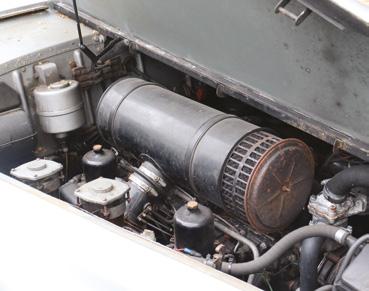
In current ownership since 2016 ‘B265EK’ has been part of a fleet of classic Bentleys used for chauffeur hire in the Cambridgeshire area. Finished in Silver complemented to a Grey leather interior the Bentley is offered with a history file, V5c document and a current MOT certificate into October 2023.
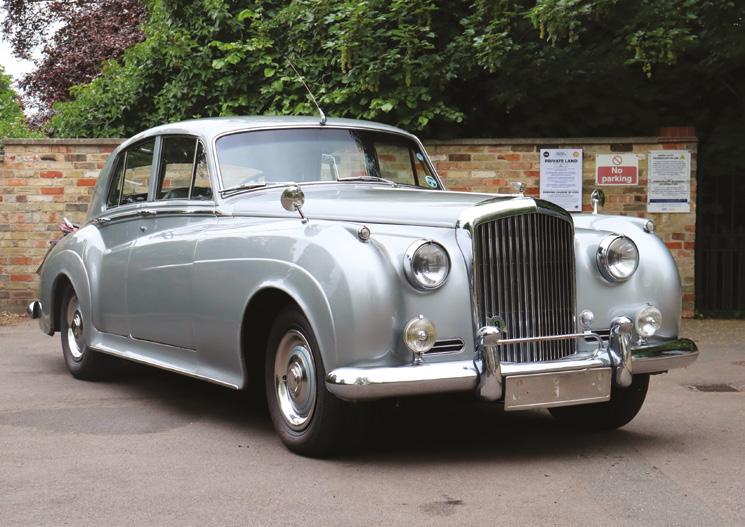
220 *All hammer prices are subject to a Buyer’s Premium of 12.5% plus VAT
133
1989 Ford Sierra XR4X4
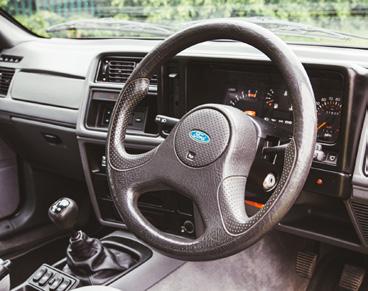

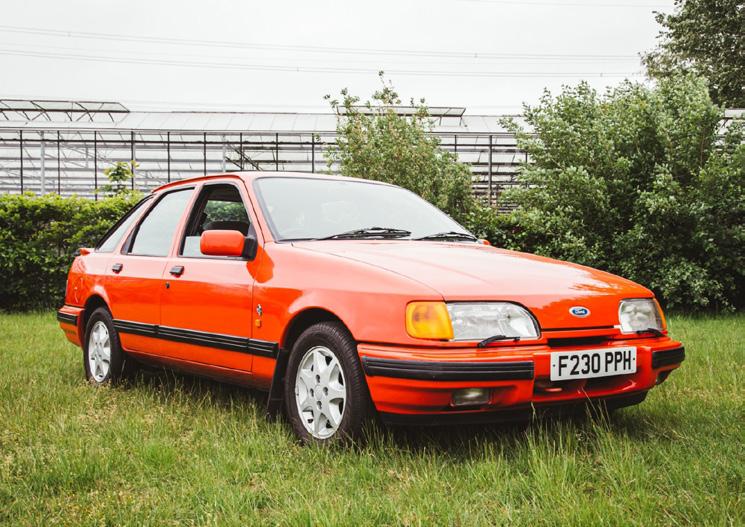
Estimate: £10,000 - £15,000*
Reg No: F230 PPH MOT: March 2024
Chassis No: WF0AXXGBBAKU34200
Introduced at the 1985 Geneva Motor Show, the XR4x4 was a four-wheel drive version of Ford’s existing high-performance Sierra XR4i hatchback. Featuring two viscous couplings, the newcomer’s Formula Fergusoninspired 4WD system retained a distinct rearwards bias (34:66 front to rear). Thus, the Ford remained notably fun-to-drive despite the additional grip and traction on offer. Initially powered by a 2.8 litre Cologne V6 engine utilising Bosch K-Jetronic mechanical fuel injection allied to fivespeed manual transmission, the model gained a more efficient 2.9 litre V6 complete with electronic fuel injection in 1989. Weighing just 1290kg, the larger capacity XR4x4 was reputedly capable of 0-60mph in 8.6 seconds and 129mph. Hailed by Autocar magazine as Ford’s answer to the Audi ur-quattro, the 4WD Sierra was facelifted alongside the rest of the range during 1987 and in many ways can be seen as a forebear of the various RS Cosworth 4x4 models. Although, a deservedly strong seller in period, the website howmanyleft.com suggest that just 1,384 examples are still extant (with most of those being off the road).
Finished in striking Red with Black accents and Grey upholstery, this particular example is fitted with the later 2.9 litre V6 engine. The vendor tells us that: ‘The interior is original and in good to fair condition, including its sunroof with retractable visor, apart from the addition of an aftermarket modern stereo and mobile phone microphone this family spec sports car is just as it left the factory’. He goes on to say that: The exterior of the car is in a useable condition but there are areas of bodywork that would need attention to make this 80s super saloon a true show winner. The vehicle currently shows 21,839 miles to its the odometer. Although, this figure cannot be guaranteed as genuine it is substantiated to some degree by the accompanying MOT history. This is a rare opportunity to experience one of the best and rarest Fast Fords out there today!’
221 *All
prices are subject to a Buyer’s Premium of 12.5% plus VAT
hammer
134
222 Notes
223
Notes
Bidder Registration Form (PLEASE
COMPLETE IN BLOCK CAPITALS)
H&H Classics, The Motor House, Lyncastle Road, Warrington, Cheshire, WA4 4SN, United Kingdom | HandH.co.uk | sales@HandH.co.uk | +44 (0)1925 210035
Debit / Credit Card Details
Auction Date
Paddle No. (official use only)
Personal Details
Title Name
Surname
Address
Town / City
Country Postcode
Contact Telephone No.
Mobile No.
Email
I hereby give consent for H&H Classics to hold my personal data and send me auction updates and preview catalogues. I may withdraw consent at any time by contacting sales@HandH.co.uk
Bank Name
Account No.
Sort Code
Card No.
Valid From Expiry Date
Issue No.
Billing Address
Town / City
Security Code
Country Postcode
Identification
Identification Type 1
Identification Type 2
Please provide a minimum of two forms of identification: Passport, Drivers License or Bank Card (photocopies or scans only)
I have read and understood the terms and conditions printed in this catalogue. I agree that they are incorporated into this contract and I agree to be bound by them. I also understand that I must pay H&H Classics Ltd a Buyer’s Premium equal to 12.5% of the Hammer Price plus VAT.
Date Bidders Signature
Telephone / Commission Bidders Form (PLEASE
COMPLETE IN BLOCK CAPITALS)
H&H Classics, The Motor House, Lyncastle Road, Warrington, Cheshire, WA4 4SN, United Kingdom | HandH.co.uk | sales@HandH.co.uk | +44 (0)1925 210035
Debit / Credit Card Details
Auction Date
Paddle No. (official use only)
Personal Details
Title Name
Surname Address
Town / City
Country Postcode
Contact Telephone No.
Mobile No.
Email
I have read and understood the terms and conditions printed in this catalogue. I agree that they are incorporated into this contract and I agree to be bound by them. I also understand that I must pay H&H Classics Ltd a Buyer’s Premium equal to 12.5% of the Hammer Price plus VAT.
Date Bidders Signature
Telephone / Commission Bids
Bank Name
Account No.
Sort Code
Card No.
Valid From Expiry Date
Issue No. Security Code
Billing Address
Town / City
Country Postcode
Identification
Identification Type 1
Identification Type 2
Please provide a minimum of two forms of identification: Passport, Drivers License or Bank Card (photocopies or scans only)
I hereby give consent for H&H Classics to hold my personal data and send me auction updates and preview catalogues. I may withdraw consent at any time by contacting sales@HandH.co.uk
H&H Classics are instructed to accept telephone / commission bids on the following lots. I understand that all the lots on offer are sold as collectors’ items and are not sold as operational means of transport. Please indicate if your bid is a telephone bid (Tel.) or commission bid (Com.) by ticking the relevant box on the table provided below.
Tel. Com. Lot No. Description
£ (Com. bids only)
2023 Classic Auction Calendar
March
15th March
Imperial War Museum, Duxford
Classic, Collector & Performance Motorcars
July
12th July
National Motorcycle Museum
Classic Motorcycles & Vintage Scooters
April
29th March
National Motorcycle Museum
Classic Motorcycles & Vintage Scooters
September
26th April
The Pavilion Gardens, Buxton
Classic, Collector & Performance Motorcars
June
14th June
Imperial War Museum, Duxford
Classic, Collector & Performance Motorcars
November
26th July
The Pavilion Gardens, Buxton
Classic, Collector & Performance Motorcars
20th September
Imperial War Museum, Duxford
Classic, Collector & Performance Motorcars
15th November
National Motorcycle Museum
Classic Motorcycles & Vintage Scooters
29th November
The Pavilion Gardens, Buxton
Classic, Collector & Performance Motorcars
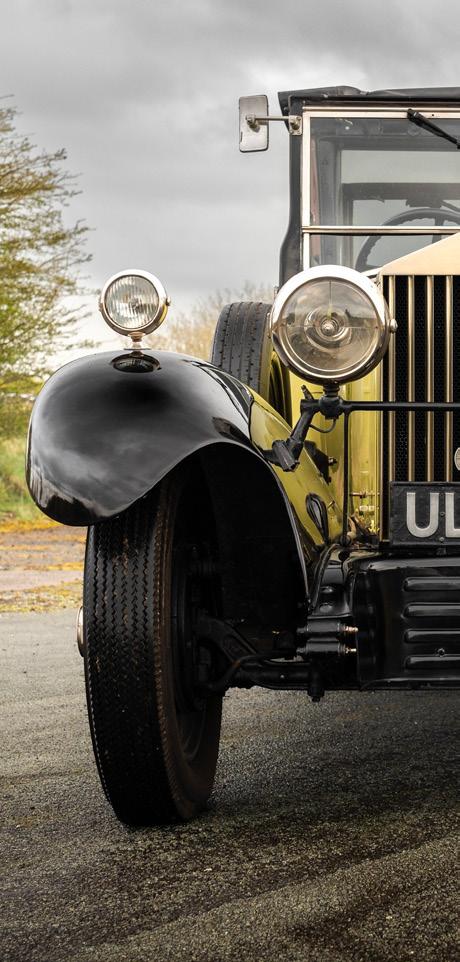
www.HandH.co.uk

Insure your classic vehicle the H&H way Get a quote today, visit HandH.co.uk/insurance At H&H we aim to make every aspect of buying a classic vehicle as straightforward as possible which is why we’re delighted to be able to introduce a new insurance quote and comparison service.
Terms and conditions
These conditions apply to all sales held by H&H Classics Limited in England and Wales to the exclusion of all other Terms and Conditions and no alteration or modification to these Conditions will be binding on H&H Classics Limited unless accepted in writing by them.
Your attention is specifically drawn to the “Notes for Intending Purchasers” published in the front of the catalogue.
DEFINITIONS
In these Terms and Conditions the following words and expressions shall unless the context otherwise requires have the following meanings:
Auctioneer means H&H Classics Limited whose Registered Office is at 8 Eastway, Sale, Cheshire UK M33 4DX; company number 02852199 and Auctioneer means its representative who actually conducts the sale.
Bidders Registration Form means the form to be completed by each bidder pursuant to Condition 12.5.
The Buyer is the only person whose bid is accepted by the Auctioneer to conclude the contract for the purchase of a Lot.
Buyer’s Commission shall have the meaning given in Condition 14.
Catalogue includes any advertisement, brochure, estimate, price list and other publication generated or published by or on behalf of the Auctioneer in relation to a sale.
Contract means the contract formed pursuant to these Conditions between any of the Seller, the Buyer and the Auctioneer.
Entry Form means the form to be completed by the Seller as to each separate Lot pursuant to Condition 1.1.
Estimated Value means the value given by the Seller in the Entry Form as the Estimated Value of the vehicle and if more than one value is given, the higher of those values.
Expenses in relation to a Lot means the Auctioneer’s charges and expenses for illustrations, special advertising, packing, freight, transport, storage and any other charges and expenses of that Lot (other than the commission) plus VAT on any of them.
The charges for uplifting an item, either sold or unsold, into storage, with charges, are as follows:
Motor Cars
Uplift - From £175
Storage - £10 per day for the first fourteen days or part thereof and £30 per week or part thereof thereafter (subject to change without notice).
Motorcycles
Uplift - From £100
Storage - £5 per day for the first fourteen days or part thereof and £12 per week or part thereof thereafter (subject to change without notice).
Bicycles
Uplift - £20
Storage - £3 per day for the first fourteen days or part thereof and £8 per week of part thereof thereafter (subject to change without notice).
Automobilia/Motobilia
Charges for these items are determined by size and weight:
‘A’ - the standard charge and will not be marked in the sales catalogue - £8 uplift and £1 per day storage (subject to change without notice).
‘B’ - larger items and marked * in the sales catalogue - £20 uplift, £2 per day storage (subject to change without notice).
‘C’ - the largest items marked ** in the sales catalogue - £50 uplift, £5 per day storage (subject to change without notice).
‘R’ - items needing to be ‘Referred’ for individual quotations marked ‘R’ in the sales catalogue (subject to change without notice).
Hammer Price means the price in £ sterling at which a Lot is knocked down by the Auctioneer to the Buyer at the fall of the hammer.
Lot means any item or items consigned with a view to its or their sale at auction.
Premises means the place at which the Auctioneer are conducting that particular sale.
Reserve means the minimum Hammer Price (if any) agreed between the Auctioneer and the Seller at which the Lot may be sold.
The Sale means the auction sale in respect of which the Lot is consigned for sale.
Sale Proceeds means the net amount payable by the Auctioneer to the Seller being the Hammer Price less the sum of the commission, the expenses, the entry fee (if not already paid) and the VAT chargeable on any of them.
Seller means the person who offers the Lot for sale whether or not he is the true owner.
Seller’s Commission means commission payable by the Seller pursuant to Condition 6.
Stated rates means the usual rates of Commission, Entry Fees and any other charges for the time being plus the VAT chargeable on any of them. The current rates are as follows:
Motor Cars
12.5% to the Buyer, 5% to the Seller (minimum £150 to both parties)
Entry Fee - £100 for a Standard Catalogue entry
£200 for a Premium Catalogue entry £400 for a Deluxe Catalogue entry
Motorcycles
15% to the Buyer, 10% to the Seller (minimum £50 to both parties)
Entry Fee - £50 for a Standard Catalogue entry £100 for a Premium Catalogue entry £150 for a Deluxe Catalogue entry
228
Registration Numbers
15% to the Buyer, 15% to the Seller (minimum £50 to both parties)
Entry fee - £50
Bicycles
15% to the Buyer (minimum of £10)
Seller’s charges available on application
Automobilia/Motobilia
15% to the Buyer (minimum of £5) Seller’s charges available on application
Total Amount Due means the Hammer Price in respect of the Lot sold plus the Buyer’s commission and additional charges and expenses due from a defaulting Buyer under these Conditions plus VAT chargeable on any of them expressed in £ sterling.
Payment can be made by bank transfer using our bank account details as follows:
Nat West, 23 Sankey Street, Warrington, Cheshire WA1
1XH
Account Name: H&H Classics Client Account
Account No: 58868984
Sort Code: 01-09-17
BIC: NWBKGB2L
IBAN: GB20NWBK01091758868984
Usual Charges means the total of the Commissions, Entry Fees and any other reasonable costs and expenses plus VAT payable thereon.
VAT means UK Value Added Tax at the prevailing rate from time to time.
Vehicles includes, where appropriate, incomplete vehicles.
CONDITIONS MAINLY CONCERNING SELLERS AND CONSIGNORS
1.1 An Entry Form in respect of each Lot must be completed fully and accurately, with an honest description of the Lot, signed and dated by the Seller and accompanied by the Entry Fee, when the Lot is entered. The Auctioneer may at any time ratify an incomplete form.
1.2 Any documentation pertaining to the Lot must be sent with the Entry Form to the Auctioneer’s office, or in any event delivered with the Lot to the Premises. The Contract between the Seller and the Auctioneer will be formed when the Auctioneer receives a signed Entry Form for the Lot, whether by hand, post, fax, email or by any other means, and whether or not the Entry Fee for that Lot has been paid, and whether or not the Form has been signed by the Auctioneer.
1.3 All relevant matters pertaining to the Lot such as a financial encumbrance, serious accident damage or other factors affecting value which are known to the Seller must be stated on the Entry Form. If a sale is lost because of the failure of the Seller to disclose to the Auctioneer all information which may reasonably be expected to affect the provenance, title, value or any other aspect of the Lot, the Auctioneer will charge and the Seller must pay the stated rates (both to Seller and Buyer) plus VAT.
1.4 If the Seller wishes to retain the registration number of a Lot, it is the Seller’s responsibility to notify the Auctioneer in writing on the Entry Form. It is the Seller’s responsibility to take all necessary steps to ensure that the current registration number is retained and a new number allocated prior to the Lot being sold. If the Seller does not do so, the Auctioneer shall not be responsible for any loss or damage whatsoever and howsoever arising out of the Seller’s loss of the right to the registration number following the sale of the Lot.
2.1 The Auctioneer shall have absolute discretion whether or not to accept any Lot for sale and shall be entitled to select the auction place, date, catalogue placement and photographs for the Lot.
2.2 The Seller gives the Auctioneer full and absolute right to photograph and illustrate any Lot placed in its hands for sale, and to use such photographs and illustrations as are provided by the Seller at any time at its absolute discretion (whether or not in connection with the Sale), with indemnity against copyright infringement.
2.3 The Seller is wholly responsible for the factual accuracy of, and for any judgments or opinions expressed in, the catalogue description of each Lot entered by him, and for any error, misstatement or omission of information in that description. Whether the description has been prepared by the Auctioneer or the Seller, a copy of the typed text will be
provided to the Seller within a reasonable time prior to the Auction, and unless the Seller reacts with comments or changes prior to the Auction, the Auctioneer may treat that description as accepted by the Seller.
3.1 The Seller warrants to the Auctioneer and to the Buyer either that he is the true owner of the Lot or that he is duly authorised to sell the Lot by the true owner, and is able to transfer or procure transfer of good and marketable title to the Lot free from a third party claims or encumbrances.
3.2 In the event of an unsettled hire purchase, finance agreement or any other charge or lien affecting the Lot, the Auctioneer reserves the right to settle the amount due of such charges not exceeding the Sale Proceeds and if the Sale Proceeds are less than the charges outstanding the Seller will be responsible for the settlement of the balance forthwith. There will be a charge of £75 plus VAT for this service.
3.3 Each Lot, in the condition as described on the Entry Form, and with all keys, spare or extra items and documents shall be delivered to the Premises at the expense of the Seller. The Seller of a Lot not held by the Auctioneer at the Premises or under its control warrants and undertakes to the Auctioneer that the Lot will be made available and in a deliverable state at the time stated by the Auctioneer.
3.4 The Seller shall indemnify both the Auctioneer, its Employees and Agents, and the Buyer separately, against all payments, costs, expenses, demands, or any loss or damage whatsoever and wheresoever incurred or suffered by any of them in respect of any breach of these Conditions on the part of the Seller.
4.1 The Seller shall be entitled, prior to the sale to place a Reserve on any Lot, this being the minimum Hammer Price at which the Auctioneer is authorised to sell that Lot and to make its usual charges. A Reserve once placed by the Seller shall not be changed without the consent of the Auctioneer.
4.2 The Auctioneer may, at its option, sell the Lot at a Hammer Price below the Reserve but in any such case the Sale Proceeds to which the Seller is entitled shall be the same as if the sale had been at Reserve.
4.3 Where no Reserve has been placed on the Lot the Auctioneer shall in no way be liable should the Lot be
229
purchased for a price below the lowest estimated selling price. In any event, any written or oral estimate of likely selling price given by the Auctioneer is an expression of opinion only and may not be relied upon by the Seller nor give rise to any claim.
4.4 If a Reserve is placed by the Seller in a currency other than Pounds Sterling, such a Reserve shall be calculated and converted into Sterling at the spot rate of exchange quoted to the Auctioneer by the National Westminster Bank Plc at close of business on the last banking day prior to the date of the Sale. The certificate in writing of the Auctioneer as to such rate shall be conclusive.
4.5 Where a Reserve has been placed, only the Auctioneer may bid on that Lot on behalf of the Seller. Should the Seller buy in his own Lot, the Seller must pay to the Auctioneer its stated rates (both Seller and Buyer) before the Lot is removed.
5.1 The Seller may by notice to the Auctioneer withdraw the Lot from the Auction. If the Seller does so he shall be liable to pay the Auctioneer the stated rate of the Seller’s and Buyer’s commission calculated on the estimated value of the Lot that the Auctioneer would have received had the Lot been sold for the estimated value. For the purposes of this clause the estimated value shall be the higher of:-
(a) the Seller’s estimate of value as previously notified to the Auctioneer or if more than one figure the highest figure or if none;
(b) the value estimated in the catalogue or if more than one figure is given the highest figure, or if none,
(c) the Auctioneer’s reasonable estimate of its value;
(d) plus VAT on such fee in either case and expenses;
5.2 In the event that the Seller withdraws the Lot from the Auction the Seller shall arrange for the collection/removal of the Lot at his own expense within 2 working days after the date of withdrawal provided that the Seller may not collect the Lot unless or until any withdrawal fee payable under Conditions 5.1 shall have been paid in full and any storage charges have been met by the Seller.
6. The Seller authorises the Auctioneer to deduct from the Hammer Price commission at the Stated Rate subject to the
relevant minimum commission for each Lot, plus Expenses and VAT on both. The Seller acknowledges the Auctioneer’s right to charge and retain the Buyer’s Premium also in accordance with Condition 14.
7. The Seller of a Lot which is a road going means of transport warrants and undertakes to the Auctioneer that, as at the date of the Sale, either:
(a) the Lot will be VAT paid in the EU and registered in the UK, will be lawfully usable on the public road, complying with the provisions of current Road Traffic Legislation and all relevant regulations made thereunder and any statutory modifications thereof, and there is or will be in force an MOT Certificate required in relation to such use; or (alternatively)
(b) the Seller has notified the Auctioneer that the Lot does not or will not meet these requirements, and cannot legally be used on the road.
8. The Seller hereby agrees to indemnify the Auctioneer, its Agents and Employees against any and all claims, liability or damage and all related costs and expenses arising out of the proper execution by the Auctioneer of their obligations to the Seller under these Conditions, and in particular against any liability or claim which may be incurred by the Auctioneer as a result of any defect in the Lot, whether proving dangerous to human life or health or otherwise giving rise to a claim against the Auctioneer, or as a result of any default by the Seller or any breach of any of the warranties or undertakings herein by the Seller.
9.1 Where any Lot fails to sell, the Auctioneer shall notify the Seller accordingly. The Seller shall make arrangements either for the Auctioneer to re-offer that Lot for sale, or forthwith to collect the Lot and to pay the Expenses. If such arrangements are not made:
(a) by 1pm on the day following the date of the Sale, the Seller shall be responsible for the costs of any removal, storage and other expenses related to that Lot;
(b) within 3 months after formal notification by the Auctioneer to the Seller, the Auctioneer shall have the right (pursuant to the Torts (Interference with Goods) Act 1977 or any legislation that re-enacts or replaces it) to sell the Lot by private treaty or at public auction without reserve and
to deduct from the Hammer Price or price received any sum owing to the Auctioneer including (without limitation) removal, storage and insurance expenses, the Expenses of both auctions, Commission at the Stated Rate on the sale and all other reasonable expenses, before remitting the balance to the Seller; or if he cannot be traced, placing it in a bank account in the name of the Auctioneer on behalf of the Seller.
9.2 If the Seller later sells the Lot as a result of its exposure at the auction the Auctioneer will be entitled to their normal commission. In any event the Auctioneer will be entitled to try and effect a sale as the Seller’s agent within 14 days after the date of the auction (that time limit does not apply to a sale by the Seller). If the Auctioneer does so sell the Lot, they will also be entitled to their normal commission.
10.1 Where a Lot is sold, the Auctioneer shall initiate payment, by bank transfer, of the Sale Proceeds to the Seller 14 days after the Auctioneers have received in cleared funds the Total Amount Due from the Buyer. Should no bank details be provided by the seller, the Auctioneer will effect payment by sending its cheque, drawn in favour of the Seller, 14 days after receipt of cleared funds, by first class mail at the Seller’s risk.
10.2 If before the Total Amount Due is paid by the Buyer (whether or not because the Auctioneer has given credit terms to the Buyer) the Auctioneer pays to the Seller an amount equal to the net Sale Proceeds, title in the Lot shall pass from the Seller to the Auctioneer.
10.3 In the case of overseas Sellers, the Sale Proceeds will be paid to the Seller either in Sterling or in such other currency available to the Auctioneer as may have been agreed in writing between the Seller and the Auctioneer before the date of the Sale. The Auctioneer shall calculate the rate of exchange for the Sale Proceeds by reference to the spot rate of exchange quoted by the National Westminster Bank Plc at close of business on the date of the Sale, whichever is more favourable to the auctioneer.
10.4 If the Auctioneer receives notice of any dispute related to a sold Lot before the Sale Proceeds have been remitted to the Seller, the Auctioneer may withhold payment from the Seller until it thinks fit or until the Dispute is resolved, whichever is earlier.
230
10.5 The Auctioneer retains the right to withhold partial or total payment for any Lot if items committed to the Sale by the Seller and sold as part of the Lot, including any relevant documents, have not been delivered by the Seller.
10.6 The Seller shall maintain their insurance of the Lot until they are in receipt of the Sale Proceeds
11.1 If the Buyer fails to pay the Auctioneer the total Amount due within 21 days after the Sale, the Auctioneer will notify the Seller and take the Seller’s instructions as to the appropriate course of action. So far as in the Auctioneer’s opinion it is practicable, the Auctioneer will at the Seller’s expense assist the Seller to recover the Total Amount Due from the Buyer, but the Auctioneer shall be under no obligation to institute proceedings in its own name.
11.2 If circumstances outside the Auctioneer’s control do not permit the Auctioneer to take instructions from the Seller, the Seller hereby authorises the Auctioneer, at the Seller’s expense, to agree special terms for payment of the total Amount Due; to remove, store and insure the Lot sold; to settle claims made against the Buyer or the Seller on such terms as the Auctioneer shall in its absolute discretion think fit; to take such steps as are necessary to collect the monies due by the Buyer to the Seller; and if necessary to rescind the sale and refund money to the Buyer.
CONDITIONS MAINLY CONCERNING THE BUYER
12.1 Any motor vehicle is sold as a collector’s item and not as a means of transport. Buyers are specifically warned that any vehicle sold as such may well have had parts replaced and paint renewed or be made up of parts from other vehicles the condition of which may be difficult to establish. The Auctioneer has to rely on information as to the date, condition and authenticity provided by the Seller and does not provide its own description, and does not and cannot undertake its own inspection of vehicles or other Lot and it is the responsibility of the Buyer to ensure that the Lot conforms to the description in the catalogue. The Auctioneer cannot check or verify the authenticity of the chassis or VIN number under which a vehicle is offered, but relies on the Seller’s description. Buyers should take particular care to verify in advance the authenticity of a vehicle that is claimed to have important racing, rallying or ‘ex-works’ history as it was common in period for a competition vehicle of a single identity
to have more than one chassis, body or other mechanical components. This may have happened several times, both in a vehicle’s ‘works’ career and thereafter in private owner hands. Sometimes ‘works’ vehicles were fitted with different registration plates, so that a vehicle could meet a particular event’s start date deadline. These historical factors may lead to there being in existence multiple and competing claimants to the same vehicle identity.
12.2 The Buyer shall be the person making the highest bid at or over Reserve (if any) that is accepted by the Auctioneer, and the Contract shall be concluded at the fall of the hammer. The Auctioneer shall have the absolute discretion to settle any dispute related to bidding at the Sale. All sales are deemed not to be sales in the course of a business, unless notified to the contrary.
12.3 Every bidder shall be deemed to act as a principal unless the Auctioneer has, prior to the auction date, acknowledged (either by acceptance of the Bidder’s Registration Form which discloses the true principal, or otherwise in writing) that the bidder is acting as agent on behalf of a disclosed principal.
12.4 The Auctioneer may in its absolute discretion refuse to accept any bid, advance the bidding as it may decide, withdraw or divide any Lot, combine any two or more Lots, and in the case of dispute may put up any Lot for auction again.
12.5 A prospective bidder should register his intention to bid for a Lot by completing fully and signing a Bidder’s Registration Form prior to executing his bid. If this has not been completed before the fall of the hammer, the Buyer shall forthwith complete the Bidder’s Registration Form. The Bidder shall also provide photographic identification. Failure to do so shall not invalidate the sale, unless the Auctioneer, in its absolute discretion, so decides.
12.6 Any bid which fails to reach the Reserve may be submitted by the Auctioneer to the Seller and if the Seller accepts that bid, the Lot will be deemed to have been sold to the Buyer at the sum bid at the fall of the hammer and the normal Terms and Conditions will apply to that sale.
13.1 Where a Lot is illustrated by a photograph, in the case of a vehicle with a registration number visible, that number will not be transferred with the vehicle to the Buyer unless
the registration particulars appear in the written part of the description and the transfer has been authorised by the Seller. If the vehicle is sold to the Buyer before the formalities of the allocation of a different registration number to that vehicle are completed with the DVLA, the Buyer accepts that he will take all steps necessary to co-operate with either the Seller or the Auctioneer to have the number re-transferred to the Seller or as may be, and will take no steps to register the vehicle with the number in his name.
13.2 Whilst the interests of prospective Buyers are best served by personal attendance at the Sale, the Auctioneers will if so instructed execute bids on their behalf. Neither the Auctioneer nor its Employees or Agents will be responsible for any error or default in doing so or in failing altogether to do so. Where the Auctioneer executes bids on behalf of an absent bidder, each Lot will be bought as cheaply as is allowed by other bids and any relevant Reserve.
14. The Buyer shall pay to the Auctioneer in respect of each Lot the Buyer’s Commission calculated on the Hammer Price at the stated rates as set out above.
15. Where a Lot is described in the Catalogue or announced at the time of Sale as being subject to VAT on import, VAT will be payable in addition to the Hammer Price (which VAT may or may not be refundable by HM Customs & Excise on proof of export).
16.1 Upon the sale of a Lot, the Buyer shall:
16.2 Unless he has already done so, complete a Bidder’s Registration Form as in Condition 12.5 above;
16.3 Pay to the Auctioneer the total amount due, at latest by midday on the day after the Sale, notwithstanding that where the Buyer wishes to export the Lot, an export licence may be required which must be obtained by the Buyer at his own cost;
16.4 Accept that any payments received by the Auctioneer from a Buyer may be applied by the Auctioneer towards any sums owing from that Buyer to the Auctioneer on any account whatsoever, without regard to any directions of the Buyer or his agent, whether express or implied.
231
17.1 Until the total amount due has been received by the Auctioneer:
(a) title in a Lot shall not pass to the Buyer but the risk shall;
(b) no Lot may be taken away by or on behalf of the Buyer.
17.2 The Buyer shall be responsible for any removal, storage and insurance charges and any other Expenses on any Lot not paid for and taken away from the by 1pm on the day following the day of the sale.
17.3 If the Lot remains under the vendor’s control for any reason, either at their property or a third-party one, then the Buyer must remove it within ten days of the sale. Failure to do so will result in the Lot being uplifted to secure storage at the Buyer’s expense.
18.1 If a Buyer fails either to pay for or to take away any Lot, the Auctioneer may without further notice to the Buyer, at its discretion and without prejudice to any other rights or remedies it may have, exercise one or more of the following rights or remedies, as may be relevant, in relation to any and all remedies for non-payment that the Auctioneer may choose to exercise. The Buyer will pay to the Auctioneer all legal and other costs borne by it on a full indemnity basis.
18.2 To charge interest at a rate not exceeding 3% per month over Natwest Bank’s base rate on so much of the total amount due as remains unpaid after the date and time referred to in condition 16.3 for the first two months. After that period of time to charge interest at a rate not exceeding 1.75% per month over Natwest Bank’s base rate on so much of the total amount due as remains unpaid after the date and time referred to in condition 16.3.
18.3 To issue proceedings against the Buyer for payment of the total amount due and/or for damages for breach of contract. If the Seller decides to sell the Lot elsewhere, the Auctioneer may proceed against the Buyer for the Commission which it would have earned both from the Seller and the Buyer together with VAT on both had the Buyer paid for the Lot in accordance with these Conditions.
18.5 To resell the Lot or cause it to be resold by public or private sale, such that any deficiency in the total amount due resulting from such resale (after giving credit for any payment) together with the full costs incurred in connection with the Lots shall be paid to the Auctioneer by the Buyer; any surplus in excess of the Sale Proceeds of that resale shall belong to the Seller.
18.6 To store the Lot at the sole expense of the Buyer and to release the Lot only after payment in full of the total amount due, together with the accrued cost of the removal, storage and insurance and all other expenses incurred in connection with the Lot.
18.7 To retain that or any other Lot sold to the Buyer at the same or any other auction and to release the same only after payment of the total amount due.
18.8 To apply by way of set-off any Sale Proceeds of any Lot then due or at any time thereafter becoming due to the Buyer towards settlement of the total amount due and expenses and the Auctioneer shall be entitled to a lien on any property of the Buyer which is in the Auctioneer’s possession for any purpose.
18.9 To reject or ignore any bids made by or on behalf of the defaulting Buyer at any future sales or insist upon a cash deposit before accepting any bids in future.
19.1 All Lots are offered as seen with all faults and defects without any guarantee or warranty attaching thereto as to condition, roadworthiness or otherwise and with all faults and defects whether apparent upon examination or not.
19.2 In any event, neither the Seller nor the Auctioneer shall be liable for any indirect or consequential loss whatsoever, and the maximum liability of the Auctioneer together with its Employees and Agents, in the event of any claim against them arising from the sale of any Lot shall be limited to the Hammer Price plus Buyer’s Premium in respect of that Lot.
GENERAL CONDITIONS
21. The Auctioneer will not accept any liability for damage sustained to a Lot that is attributable to members of the public or non-Auctioneer operatives during the Sale or any removable items left within lots during the same period. Any claims for damage and / or lost items must be submitted to the Auctioneer in writing no later than 3 working days after the date of the Sale and include a valid quote for repair or replacement and digital photographs where applicable.
22. The Auctioneer shall be under no liability for any injury, damage or loss sustained by any person while on the Auctioneers premises (including any premises where a sale may be conducted or where a Lot, or a part of a Lot, may be on view from time to time) except for death or personal injury caused by the negligence of the Auctioneers or its employees and agents in the course of their duties to the Auctioneers.
23. The Auctioneer shall have the right, at its sole discretion, without assigning any reason, to refuse any person admission to its Premises or attendance at any of its Sales, or to view any Lot.
24. The Auctioneer shall keep and use any data relating to the Buyer and the Seller in accordance with the provisions of all relevant data protection legislation. The Buyer and the Seller consent to such data being kept and used for appropriate purposes, including informing the Buyer and the Seller of any offers or other matters of interest from time to time.
25. The copyright in all written matter and illustrations relating to Lots shall remain at all times the absolute property of the Auctioneer, and any person wishing to use such materials, or any part of them, shall require the prior written consent of the Auctioneer.
26. If any Condition or part of a condition in these Terms shall be held to be invalid or unenforceable, the validity or enforceability of the remaining Conditions will not thereby be affected.
18.4 To rescind the sale of that or any other Lots sold to the same Buyer at this or any other Sale, in respect of which title has not passed.
20. The Auctioneer in all respects acts and will be treated as agent for the Seller (except where the Auctioneer is expressly stated to be selling as principal), and is not responsible for any default by the Seller or the Buyer to the other party.
27. These Conditions shall be governed by and construed in accordance with English Law. All transactions to which these Conditions apply and all matters connected therewith shall also be governed by English Law. Each of the Auctioneer, the Seller, the Buyer and any bidder hereby submits to nonexclusive jurisdiction of the courts of England and Wales.
232
All packages are fully bespoke with options including: • Dry store • Fabric car cover • Trickle charger
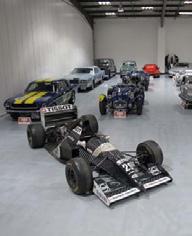
• State-of-the-art Airchamber with battery conditioner Plus many more!
Full insurance included as standard up to £250,000 (extendable on request)


Conveniently located near M6 Lymm interchange within easy reach of Manchester and Liverpool With 30 years experience in caring for classic and collector motorcars, we have the storage solution to suit your needs
• Tyre check
• Fluid level check
• Axle stands
• Valeting
• MOT arrangement
Motorcar
Motorcycle Storage
per week Trust your classic or collector motorcar storage to H&H Classics HandH.co.uk | sales@HandH.co.uk | +44 (0)1925 210035
Classic
Storage from £25 per week |
from £15
Speak to us at the next H&H sale about the services we can provide, including:
• UK and European door to door enclosed car transport
• Secure, high quality indoor vehicle storage & HMRC approved bonded storage
• Worldwide shipping and airfreight
• Documentation, customs clearance, registration and all associated services
Speak to us at the next H&H sale about the services we can provide, including:
Or contact us at:
• UK and European door to door enclosed car transport
• Secure, high quality indoor vehicle storage & HMRC approved bonded storage
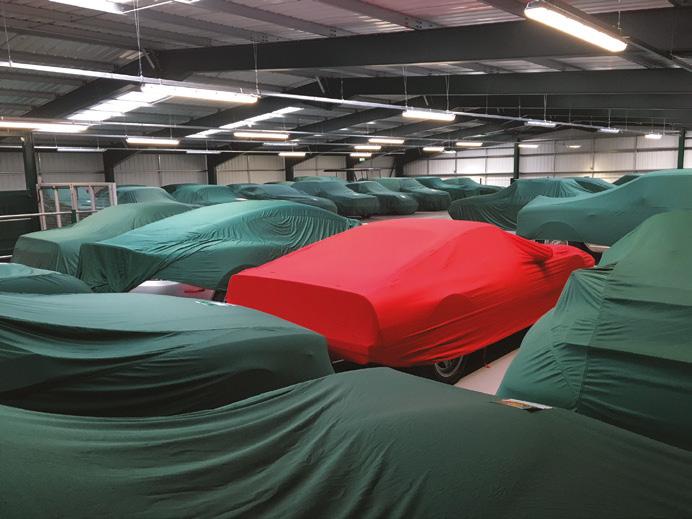

E.M. ROGERS
• Worldwide shipping and airfreight
• Documentation, customs clearance, registration and all associated services
www.emrogerstransport.com carstore@emrogers.co.uk
Or contact us at: www.emrogerstransport.com

Tel: 01604 755511
E.M. Rogers
carstore@emrogers.co.uk
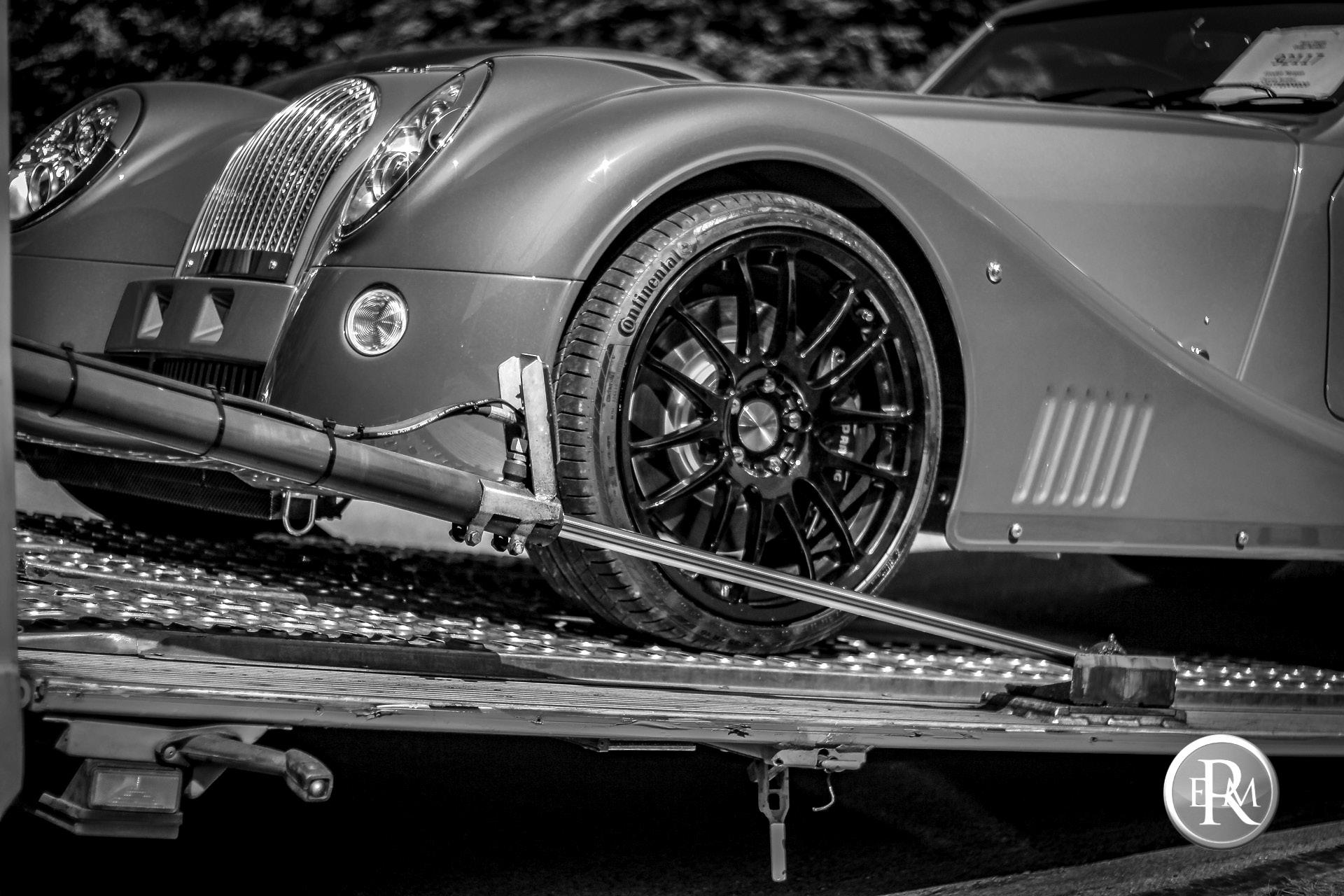
Tel: 01604 755511
are proud partners of H&H Classics Limited
E.M. Rogers
are proud partners of H&H Classics Limited




Entries Open for our Auction of Classic Motorcycles & Vintage Scooters 12 th July 2023 | National Motorcycle Museum, Solihull Sold in our March 2023 NMM Auction 1936 Indian 4 Sold for £65,550* HandH.co.uk | sales@HandH.co.uk | +44 (0)1925 210035 *All hammer prices are subject to the following Buyer’s Premium | Motorcycles 15% plus VAT


HandH.co.uk | sales@HandH.co.uk | +44 (0)1925 210035 Entries Open for our Auction of Classic, Collector & Performance Motorcars 20 th September 2023 | Imperial War Museum, Duxford Sold in our March 2023 IWM Auction 1937 Lagonda LG45 Tourer Sold for £195,667* *All hammer prices are subject to the following Buyer’s Premium | Motorcars 12.5% plus VAT
Previously sold with H&H Online Auctions
1969/2011 Jaguar D-Type Recreation by Revival Motorsport

Sold for £74,250* in April 2022
Rolling timed auctions from H&H - Trusted Auctioneers Since 1993
Find out more at www.HandH.co.uk/online-auctions
H&H Online Auctions
| 5% plus VAT
*All hammer prices are subject to the following Buyer’s Premium












Complimentary valuation of your classic car or motorcycle by one of our specialist team Fill out the form on the reverse of this flyer, or speak to one of our specialists Get a Valuation
Valuation Form
Return to one of our specialists in person, scan and email to sales@HandH.co.uk or post to: The Motor House, Lyncastle Road, Warrington, Cheshire WA4 4SN. Valuation also available online at HandH.co.uk
Title: Name: Surname:
Contact Telephone No: Postcode:
Email:
Make & Model:
Registration Number: Current Mileage: Year of Manufacture:
Circle your vehicle category: Motorcar Motorcycle Scooter Registration Number Other/Don’t know
Circle your preferred Auction Style: Classic Auction Online Auction
Description:
Motorcars in today’s sale
83 2017 Alfa Romeo 4C
126 1934 Alvis Silver Eagle Special
121 1936 Alvis Speed 20 SD Vanden Plas ‘Sunshine Coupe’
7 1948 Alvis TA14 Drophead Coupe
93 1924 American LaFrance Speedster
31 1993 Asquith London Taxi
116 1955 Aston Martin DB2/4 Mk1
81 1977 Aston Martin V8 ‘S’
6 1933 Austin 10 Saloon
23 1950 Austin A90 Atlantic Convertible
84 1979 Austin Morris Mini 1275 GT Rally car
43 1957 Austin-Healey 100/6
21 1966 Austin-Healey 3000 MKIII
101 2001 Bentley Arnage Red Label
105 1999 Bentley Azure
8 2005 Bentley Continental Flying Spur
56 2004 Bentley Continental GT
22 1982 Bentley Corniche Convertible
130 1950 Bentley MKVI Sports Saloon
127 1954 Bentley R-Type
104 1957 Bentley S1 James Young Coupe
32 1958 Bentley S1 Saloon
97 1956 Bentley S1 Saloon
133 1958 Bentley S1 Saloon
41 1956 Bentley S1 Standard Steel Saloon
34 1962 Bentley S2
108 1960 Bentley S2 Continental H.J. Mulliner Coupe
76 2002 BMW Alpina B10 3.3
50 2003 BMW M3 Convertible
40 1963 Bristol 407
46 1941 Buick Straight-8 ‘Fireball’ Special Sedan
20 1941 Buick Super Convertible-Coupe
39 1939 Cadillac Series 90 V-16 Seven-Passenger Sedan
68 2004 Caterham Seven 1.6
61 1985 Caterham Super Seven 1700 Super Sprint
62 1994 Chevrolet Corvette C4
51 1973 Chevrolet Corvette Stingray Convertible
115 1969 Chevrolet El Camino
85 1990 Citroen 2CV6 Dolly
25 2000 Daihatsu Fourtrak Independent
131 1971 Daimler 4.2 Sovereign
66 1976 Datsun 280 Z
58 1977 Ferrari 308 GTB ‘Vetroresina’
65 1979 Ferrari 400 GT
79 2007 Ferrari 612 Scaglietti
74 2006 Ferrari F430 Spider
52 1986 Ford Escort RS Turbo
4 1914 Ford Model T Roadster
73 2001 Ford Puma S1600 ‘Works’ Rally Car
94 1989 Ford Thunderbird
80 2007 Mercedes-Benz CL600
10 1998 Mercedes-Benz SL 500
86 1954 MG TF 1500
118 1940 MG VA Tickford
17 1978 Mini Pick-Up 1000
24 1990 Mitsubishi Shogun
98 1937 Morris 8 Tourer
78 1967 Morris Mini Cooper S 1275
36 1951 Morris Z-Type Van
106 1930 Packard 733 Standard Eight Roadster
3 1988 Peugeot 205 CTi
99 1952 Peugeot D3A Van
82 2005 Porsche 911 Carrera 2
60 2008 Porsche 911 Carrera 2S Cabriolet
67 1986 Porsche 911 Carrera 3.2 Supersport
54 2006 Porsche Cayman S
70 2007 Porsche Cayman S
15 1931 Riley Nine Fabric Tourer
120 1923 Rolls-Royce 20hp Coupe with dickey seat
89 1928 Rolls-Royce Phantom I Shooting Brake
103 1925 Rolls-Royce Phantom I Three-Position Drophead Coupe
124 1985 Rolls-Royce Silver Spirit
27 1936 Rover 10hp Six Light Saloon
18 1935 Singer Nine Le Mans ‘Longtail’
100 2003 Smart Crossblade
132 1926 Standard V3 Coventry Tourer
13 1924 Standard V3 Kineton Tourer
55 2004 Subaru Impreza WRX Turbo
42 1964 Sunbeam Rapier Series IV
102 1976 TRAC SS100
9 1972 Triumph Stag
28 1974 Triumph Stag
48 1977 Triumph Stag
95 1972 Triumph Stag
45 1963 Triumph TR4
26 1970 Triumph TR6
19 1980 Triumph TR7 Convertible
75 1999 TVR Cerbera 450
12 2003 Volkswagen Beetle 1600 ‘Sedan Unificado’
30 1975 Volkswagen Type 2 (T1) Fleetline Camper Van
Registration Plates
1 Registration Number ‘11 OYD’
2 Registration Number ‘87 BL’
Lot No. Lot No. Lot No.
Super Coupe 134 1989 Ford Sierra XR4X4 87 1948 Ford V8 Custom 16 1962 Heinkel Trojan 200 112 1939 Hupmobile Senior Six Series E Sedan 91 1967 Jaguar E-Type 4.2 2+2 Coupe 44 1969 Jaguar E-Type 4.2 Fixed Head Coupe 96 1964 Jaguar E-Type 4.2 Fixed Head Coupe 128 1970 Jaguar E-Type 4.2 Litre Roadster 113 1971 Jaguar E-Type 4.2 Roadster 117 1970 Jaguar E-Type 4.2 Roadster 122 1970 Jaguar E-Type Roadster 35 1971 Jaguar E-Type V12 Coupe 14 1964 Jaguar MkII 3.8 litre Saloon 90 1936 Jaguar SS100 2.5 Litre Two-Seater Sports 109 1977 Jaguar XJ-C 4.2 107 1988 Jaguar XJ-S 3.6-Litre Coupé 33 1989 Jaguar XJ-S V12 Convertible 49 1990 Jaguar XJ-S V12 Convertible 11 1993 Jaguar XJ12 6 Litre 5 1999 Jaguar XK8 Convertible 47 1997 Jaguar XK8 Convertible 71 1999 Jaguar XKR Convertible 63 1999 Jaguar XKR Coupe 72 1978 Kougar Sport Jaguar 38 1930 Lagonda 2 Litre Low Chassis Speed Model Tourer 92 1932 Lagonda 3 Litre Tourer 129 1933 Lagonda M45 Tourer 119 1938 Lagonda V12 Sports Saloon 29 1981 Lancia Beta 2000 Spyder 111 1915 Lancia Theta Hydraplane Runabout 88 1997 Land Rover Defender 110 Wolf ‘Remus’ 125 c.1954 Lea-Francis ‘Tojeiro’ 59 2006 LMP Engineering Can Am M1C 69 1974 Lotus Elan +2 130/5 77 1972 Lotus Elan Sprint Drophead Coupe 57 2008 Lotus Europa S/SE Spec 110 1930 Marquette 36S Sports Coupe
2001 Maserati 3200 GT
1970 Maserati Indy
1989 Mercedes-Benz 560 SL
2000 Mercedes-Benz C240 Sport
Mercedes-Benz C32 AMG Saloon
64
37
123
114
53 2002


sales@HandH.co.uk | 01925 210035 | www.HandH.co.uk Trusted Motorcar Auctioneers Since 1993 Find us on social media

 Colette McKay, Managing Director
Colette McKay, Managing Director



























































































































































































































































































































































 Entered from the Guinness Collection
Entered from the Guinness Collection





































































































































































































































































































































